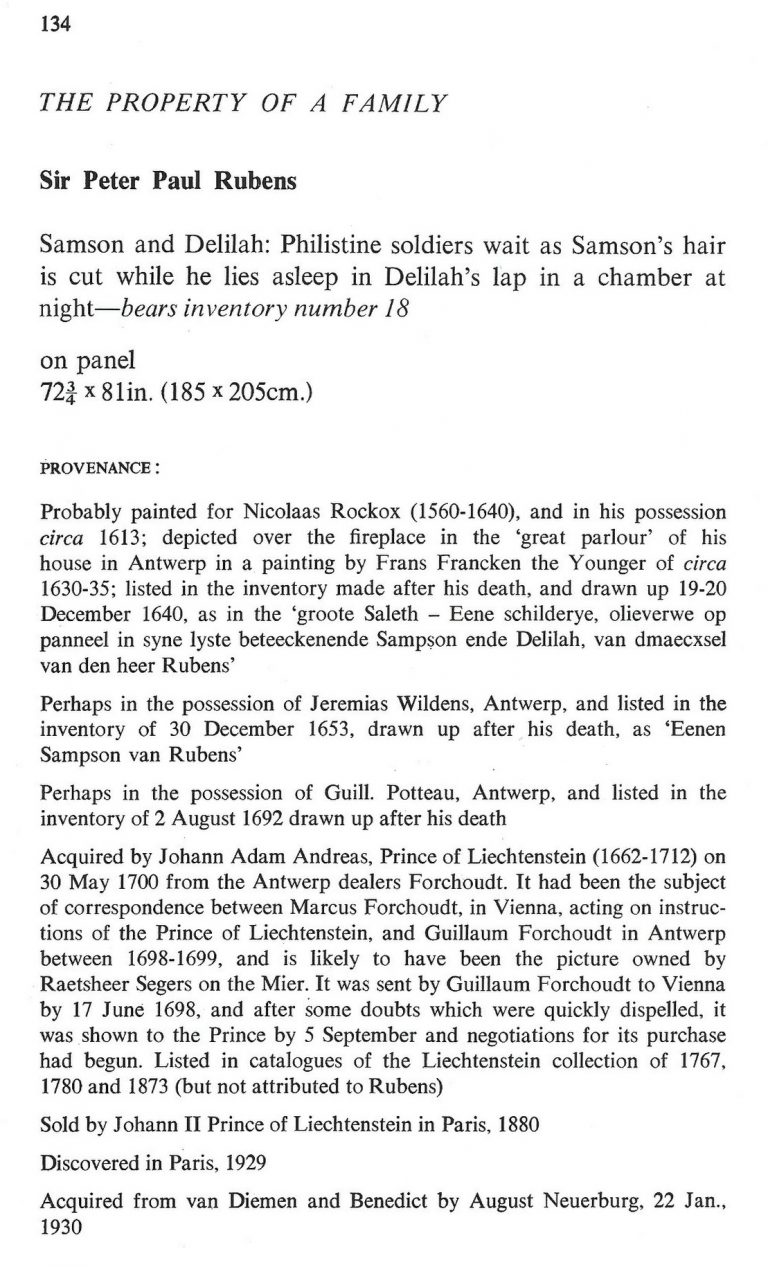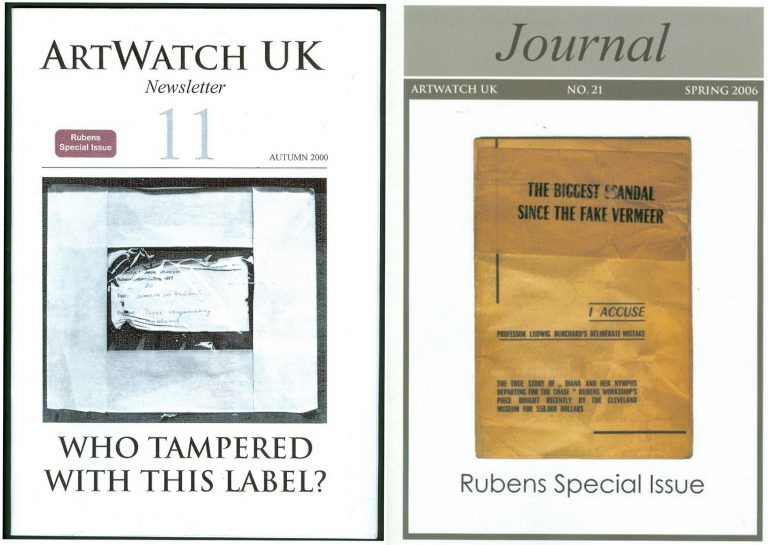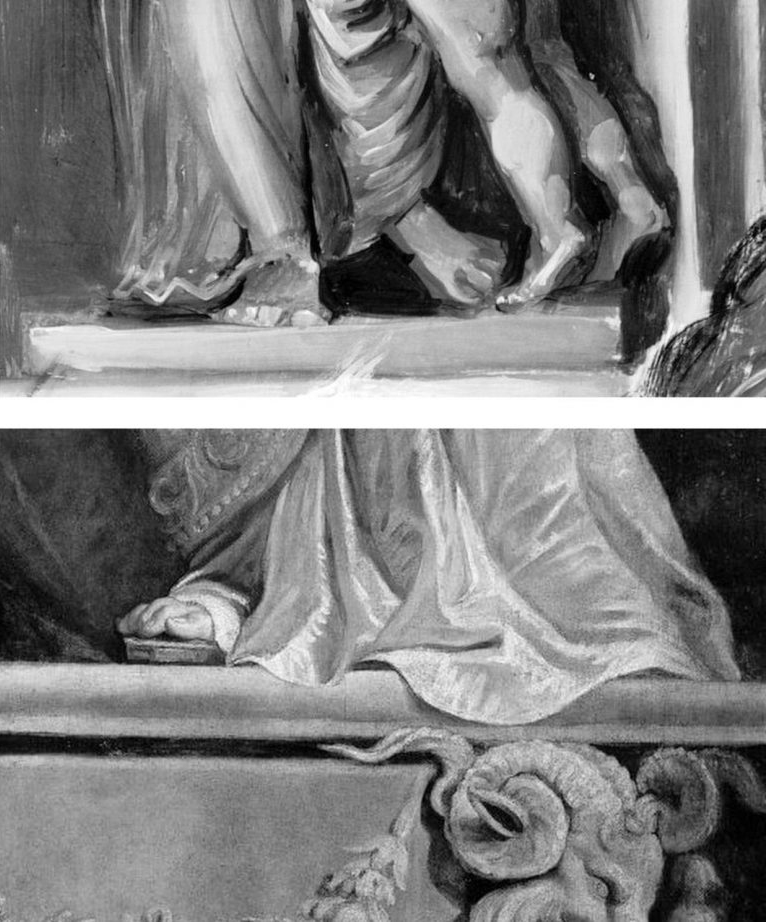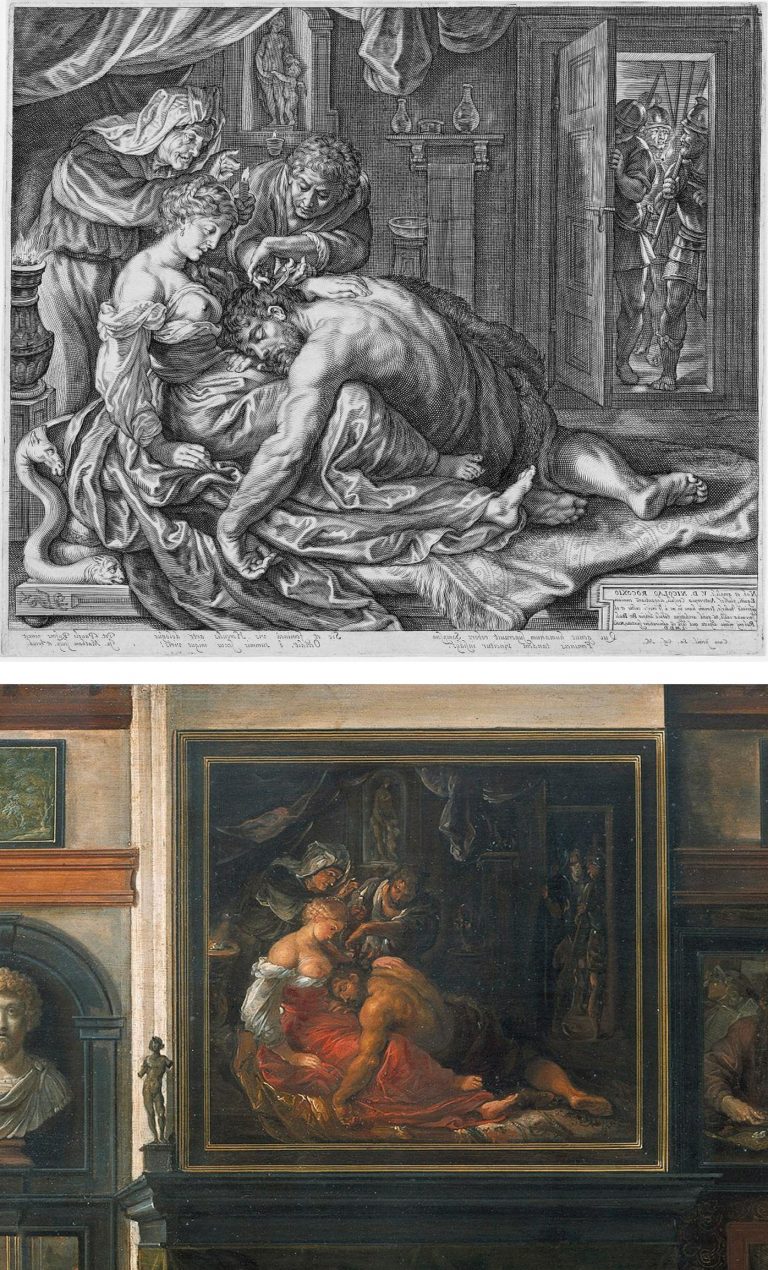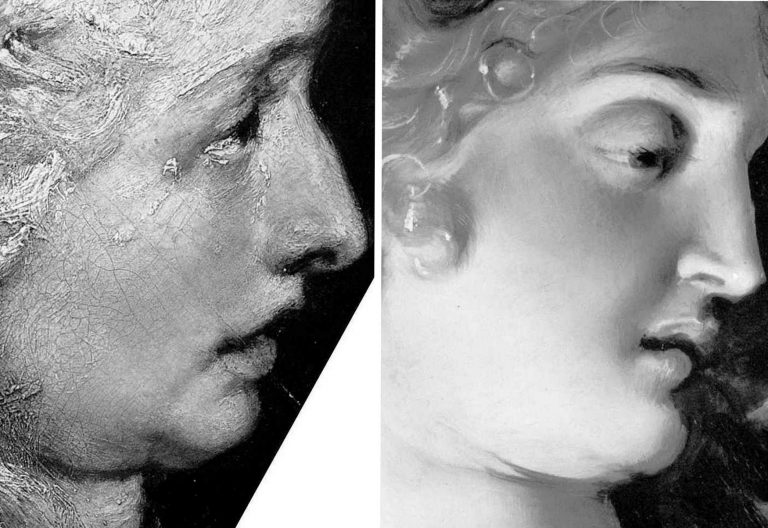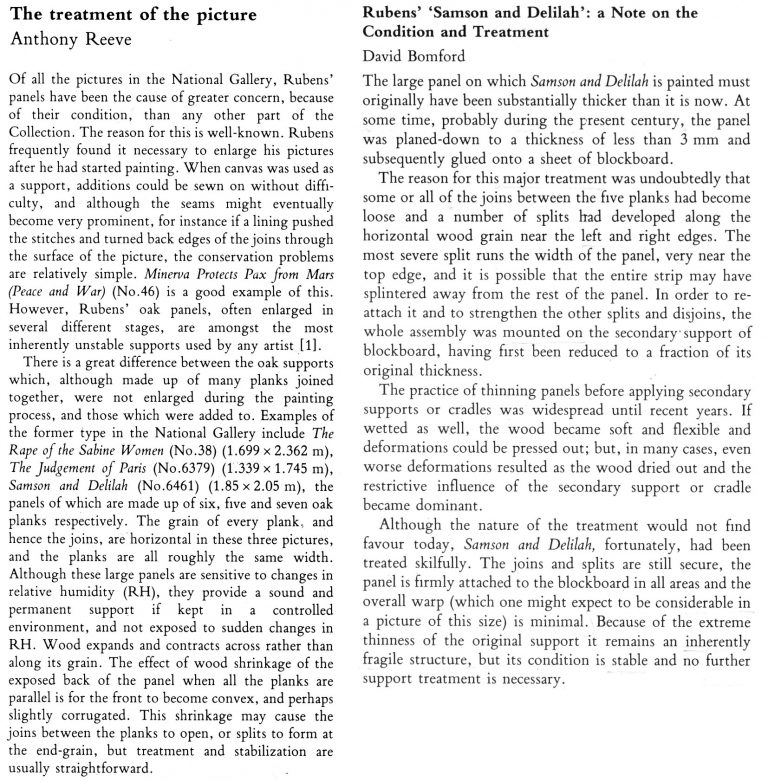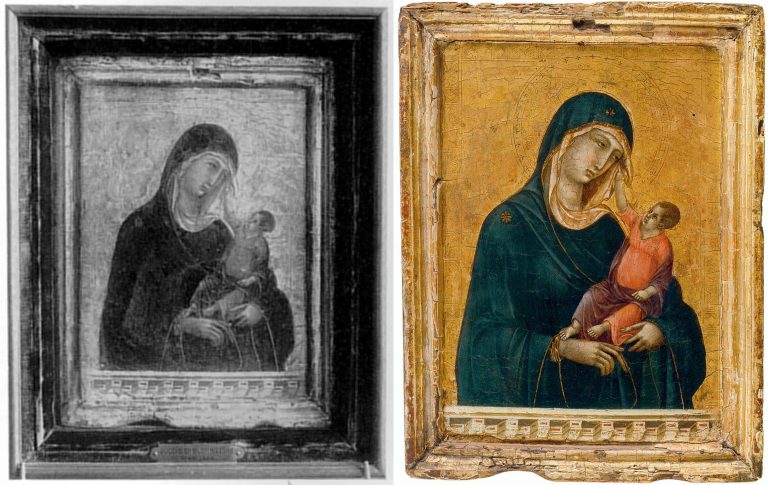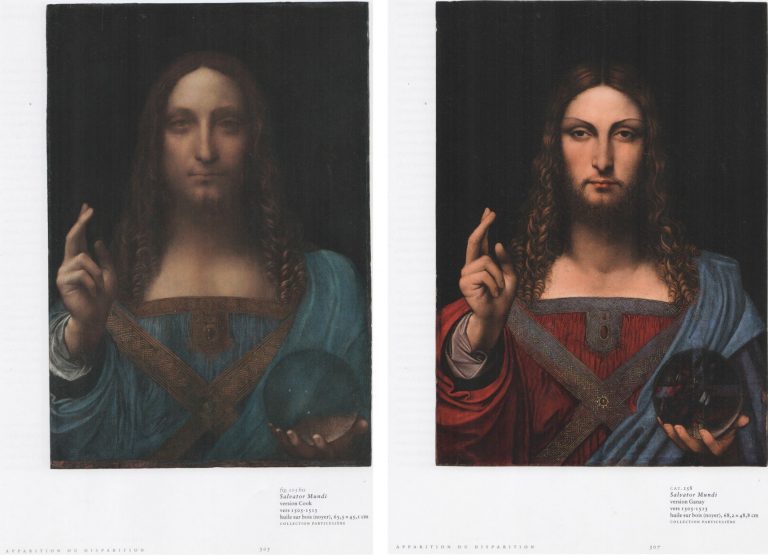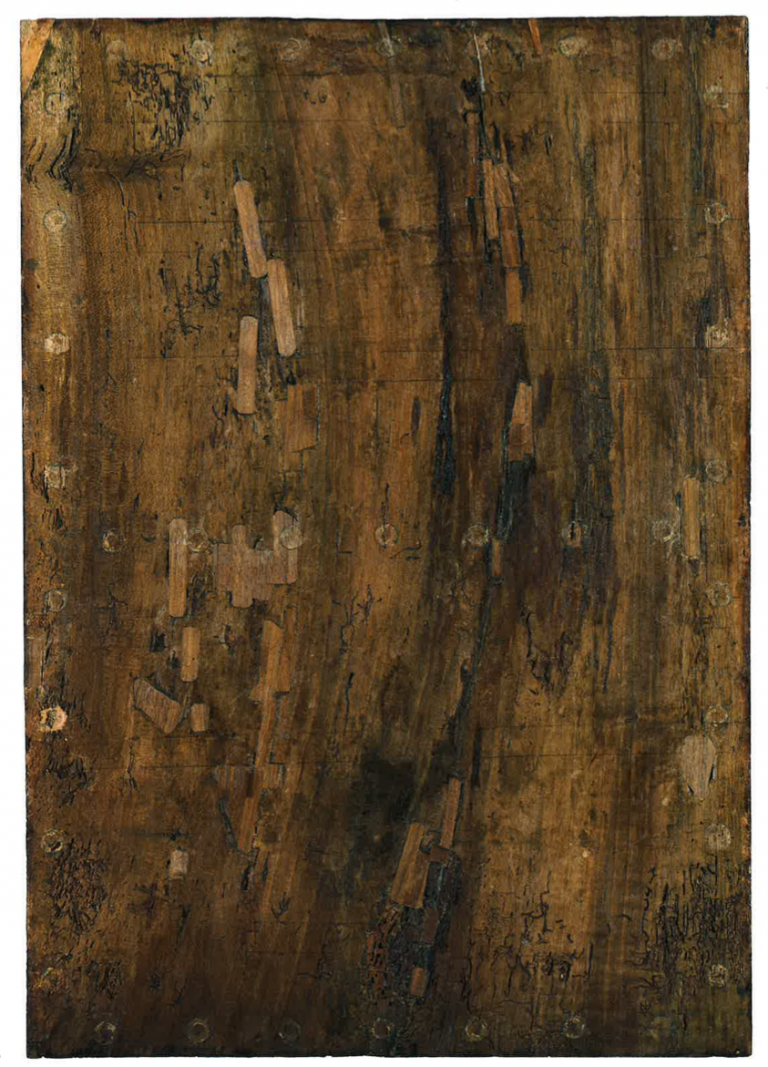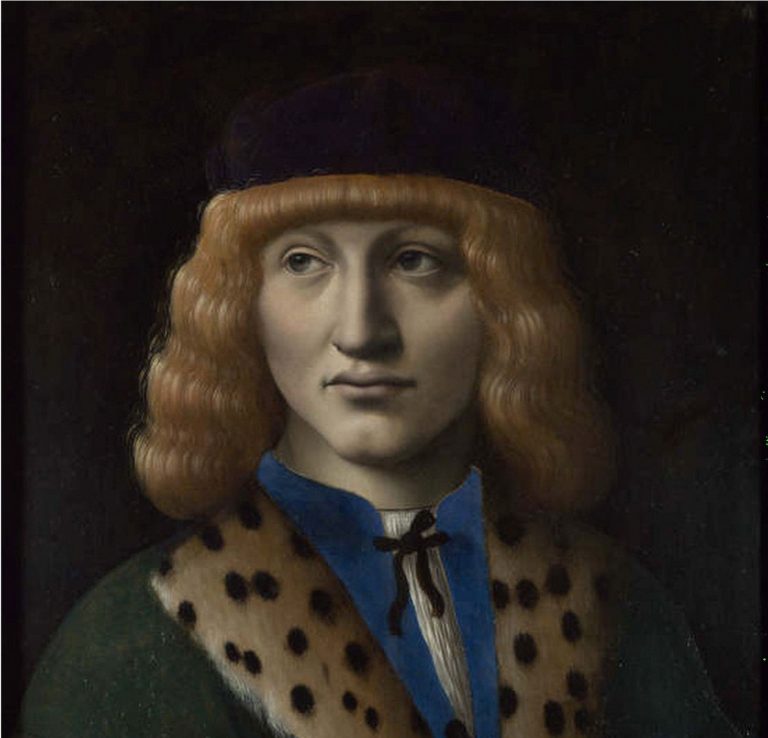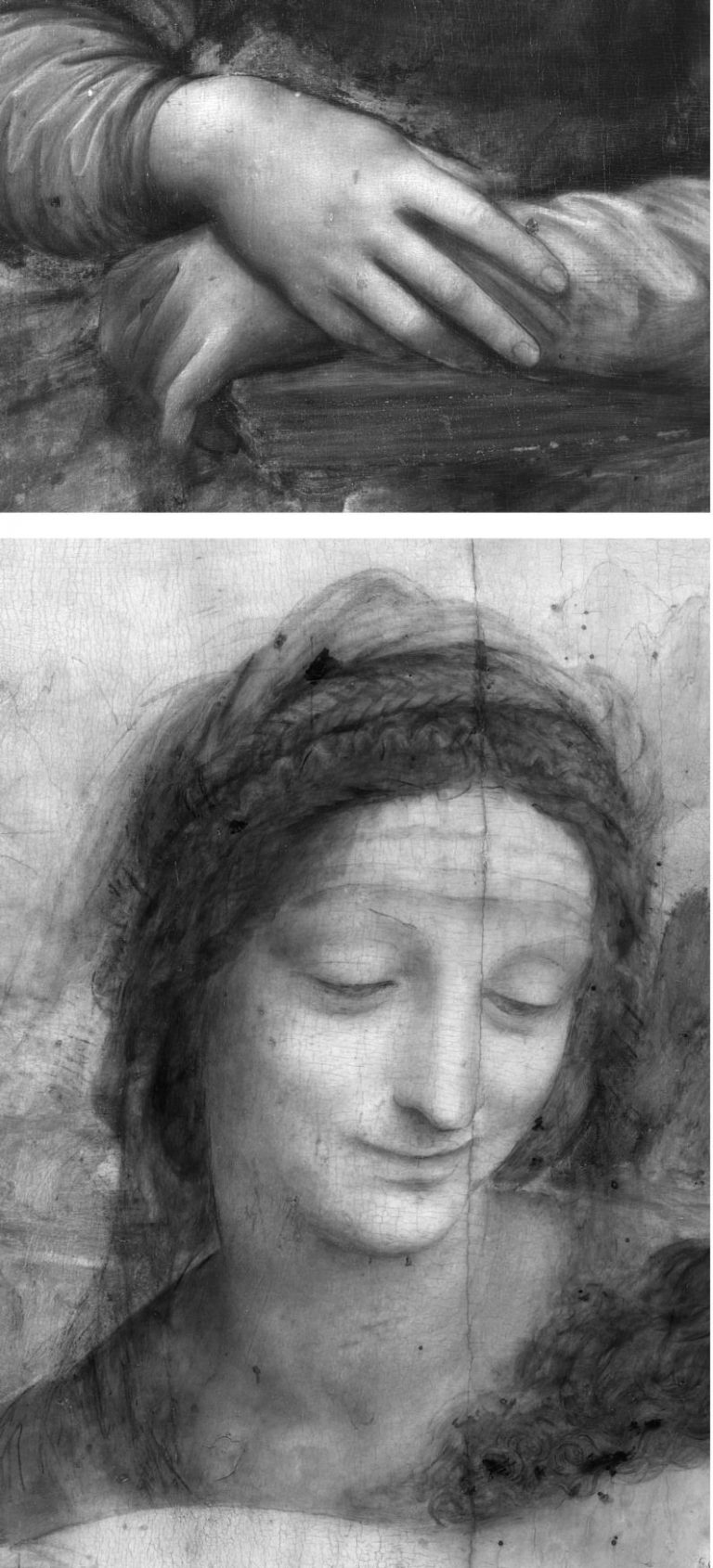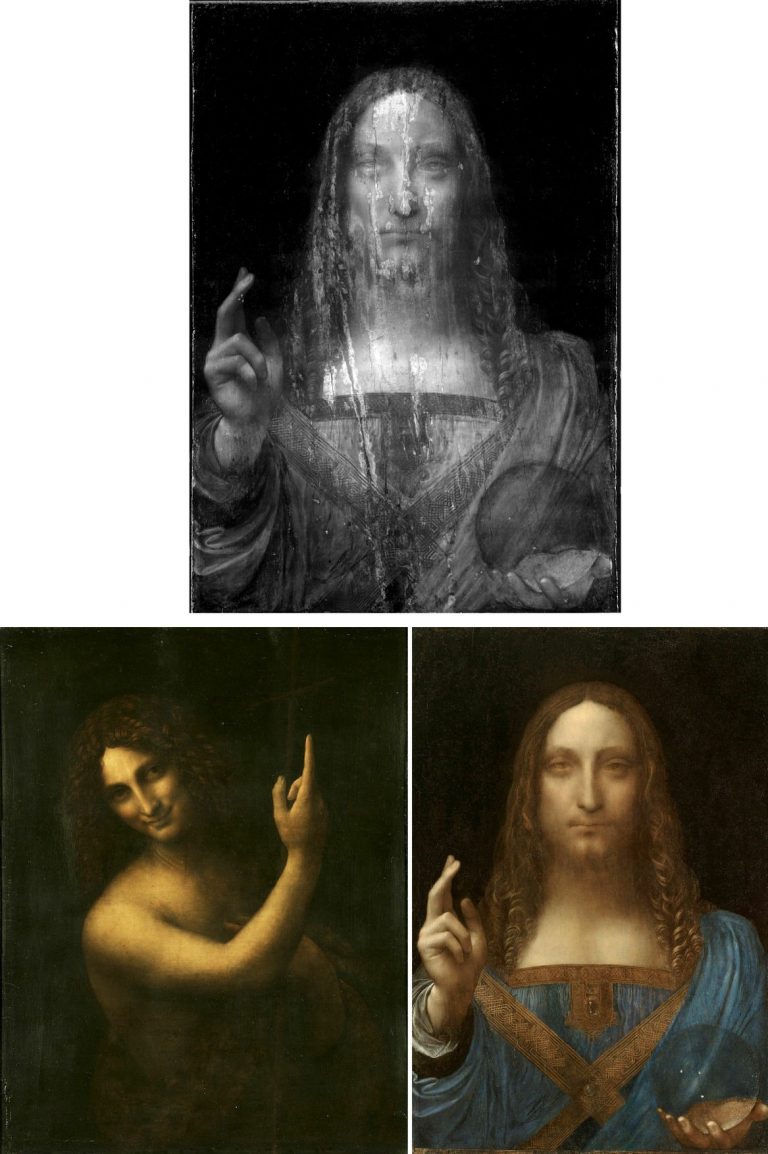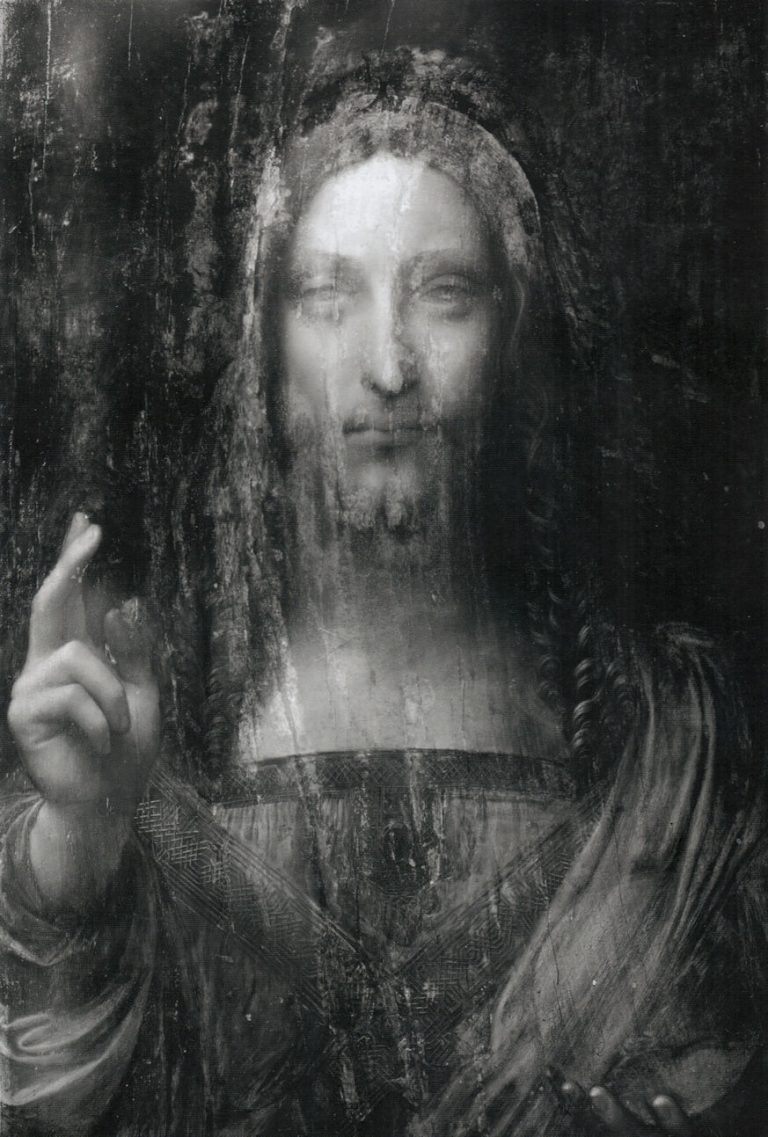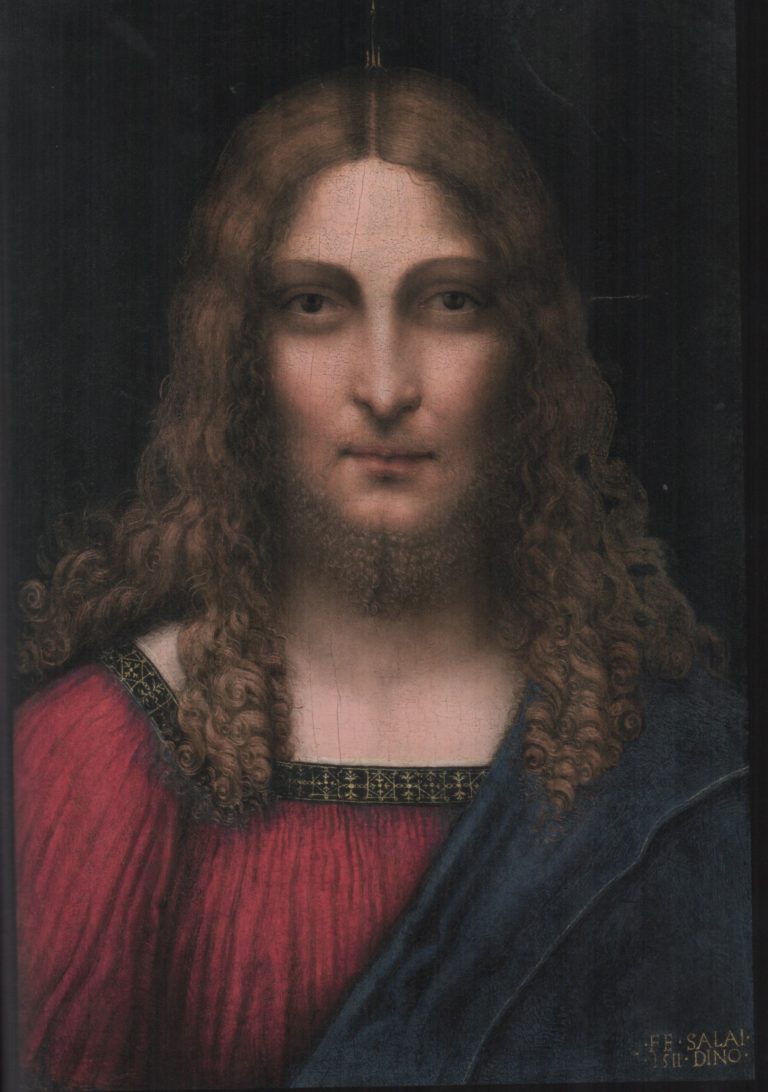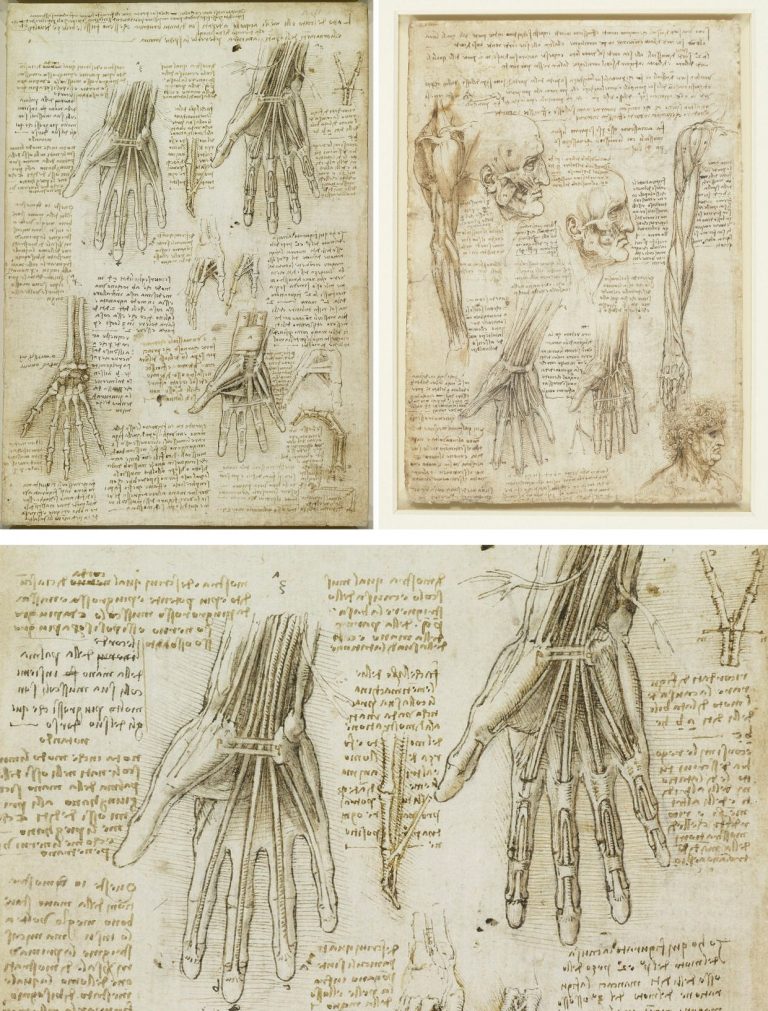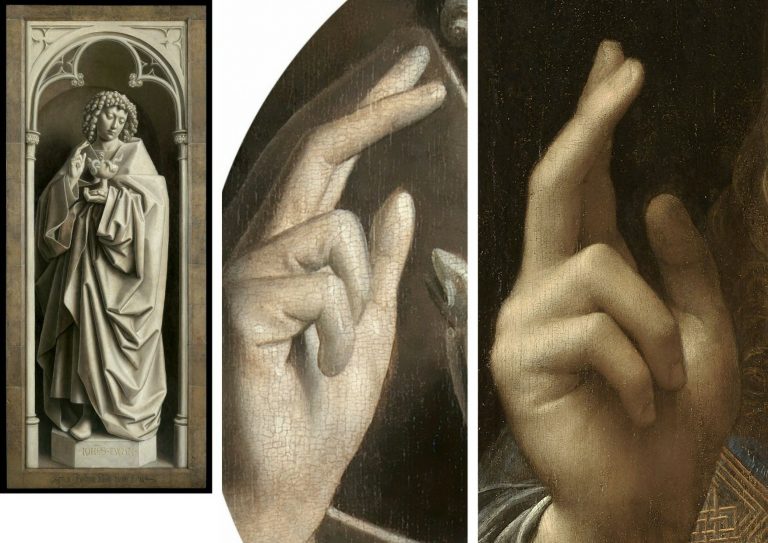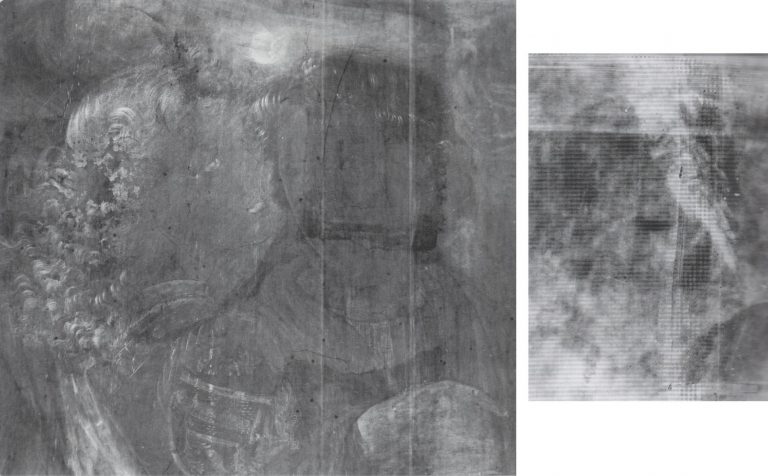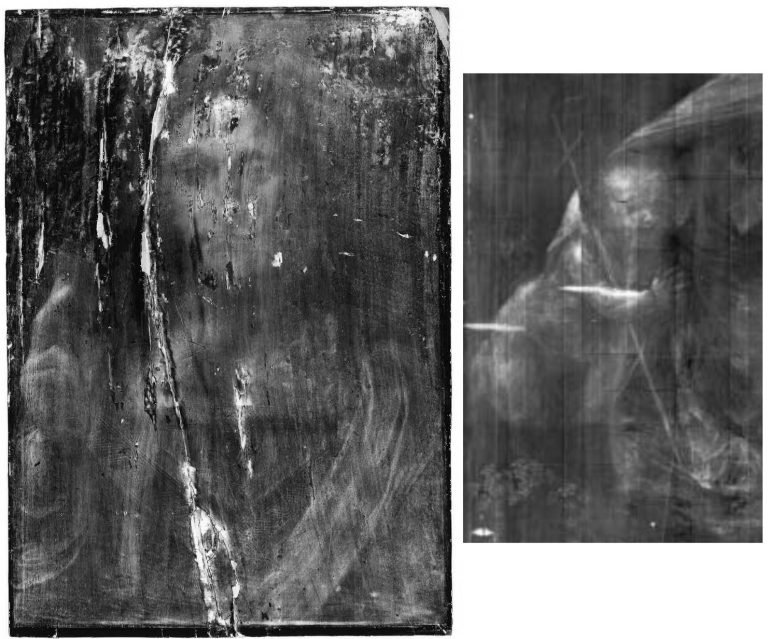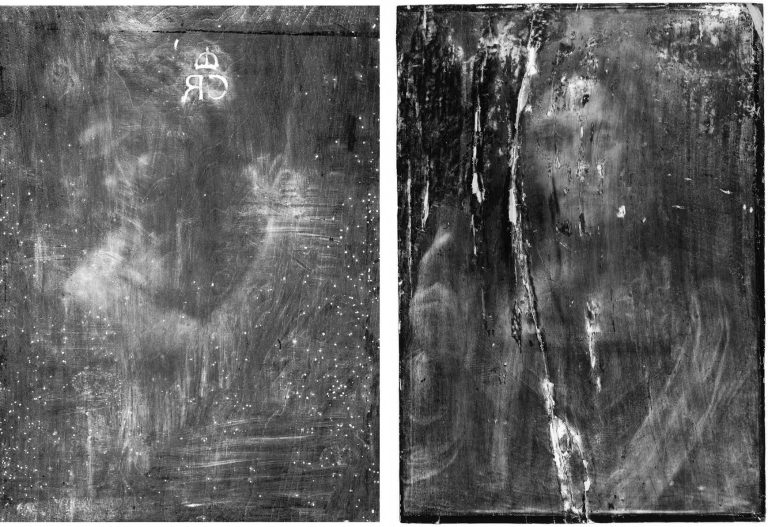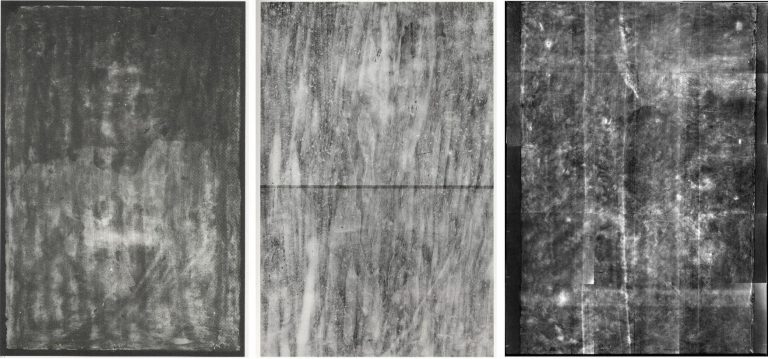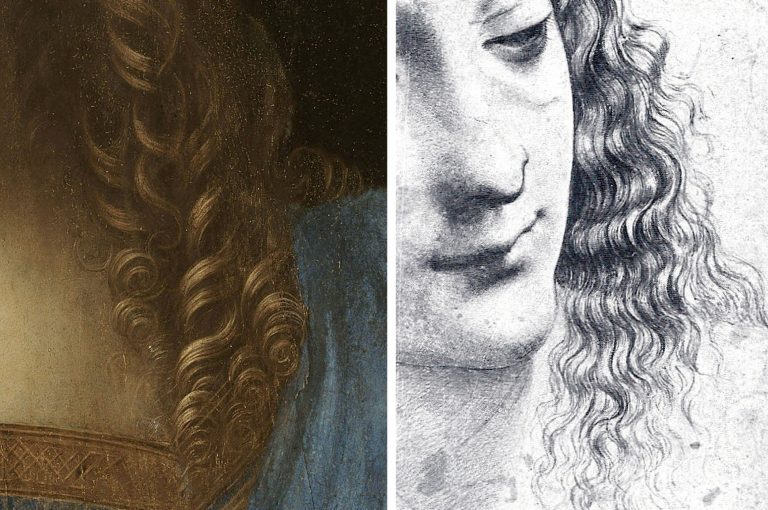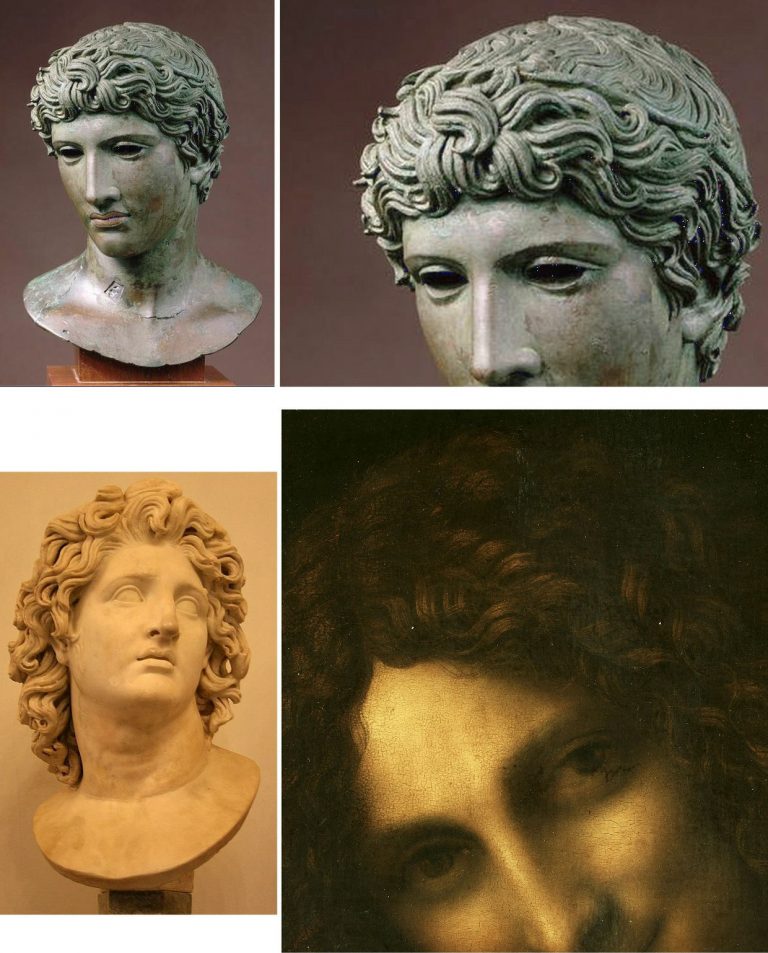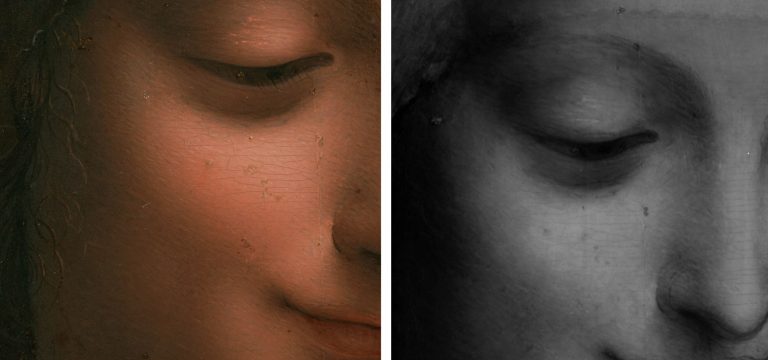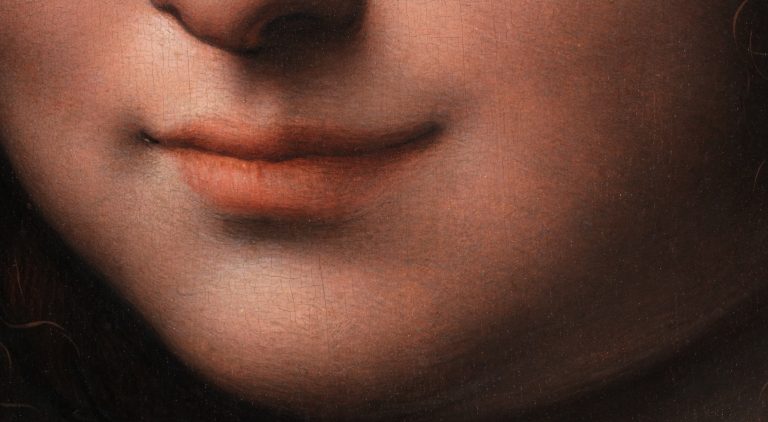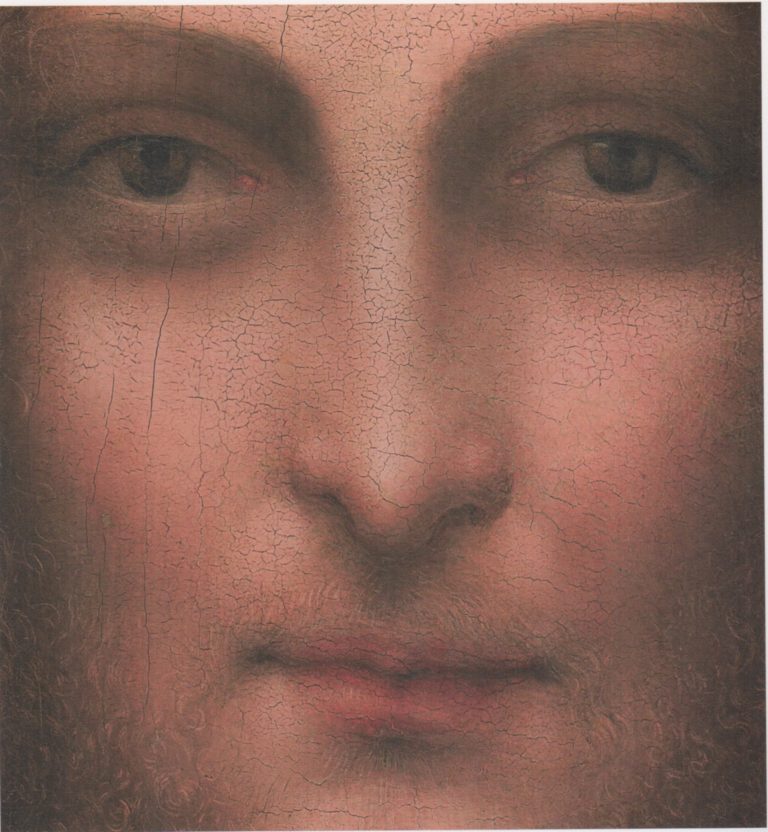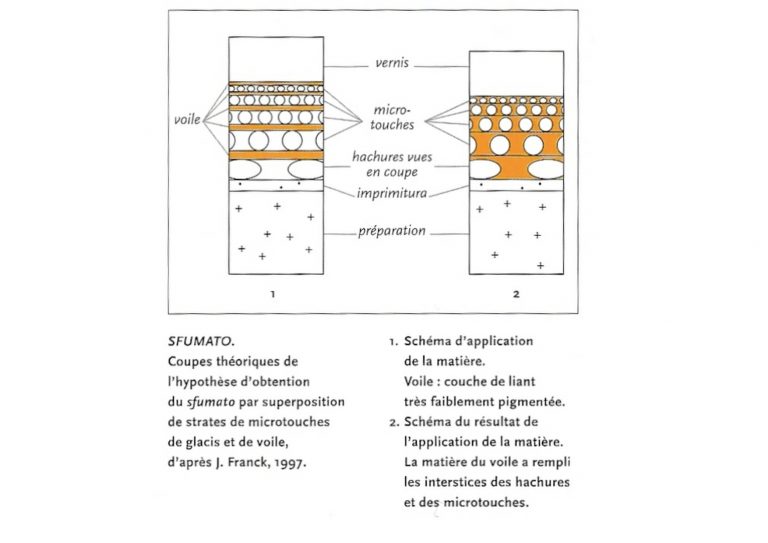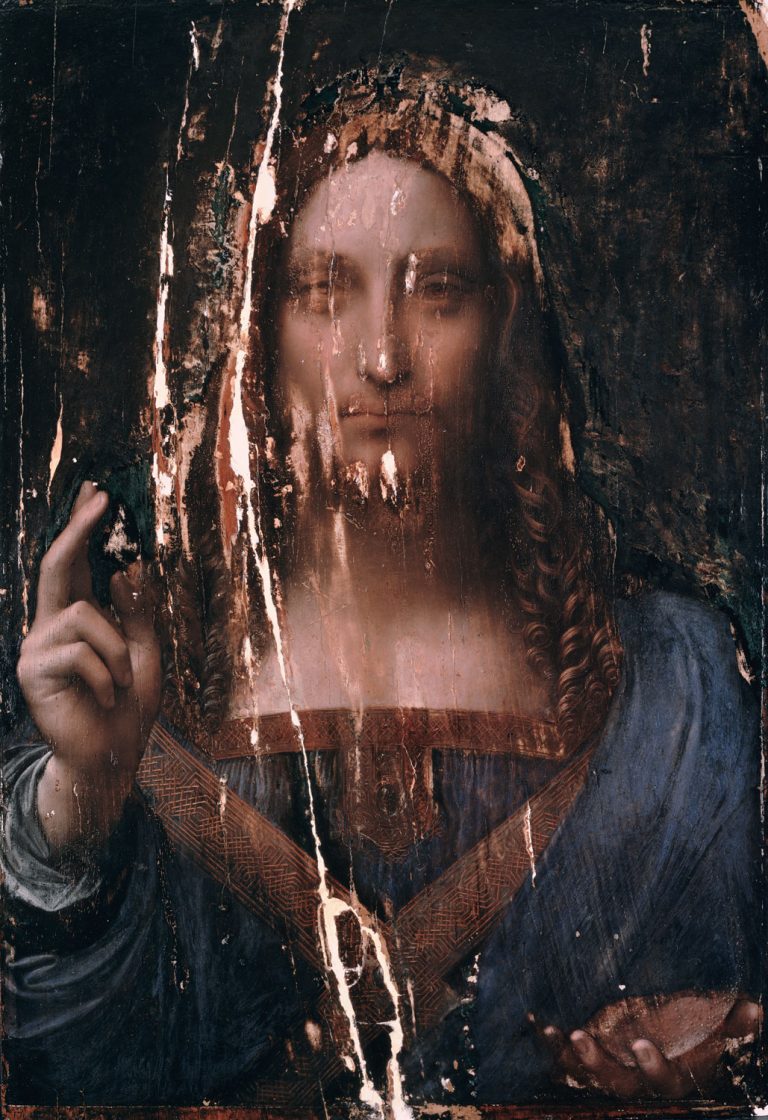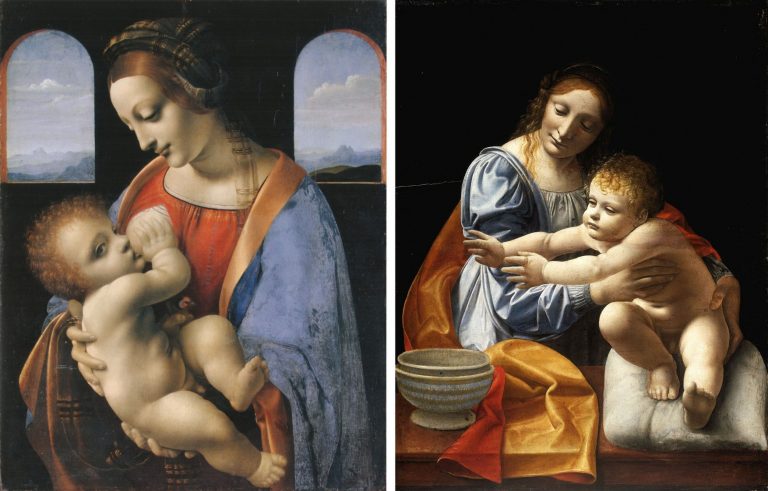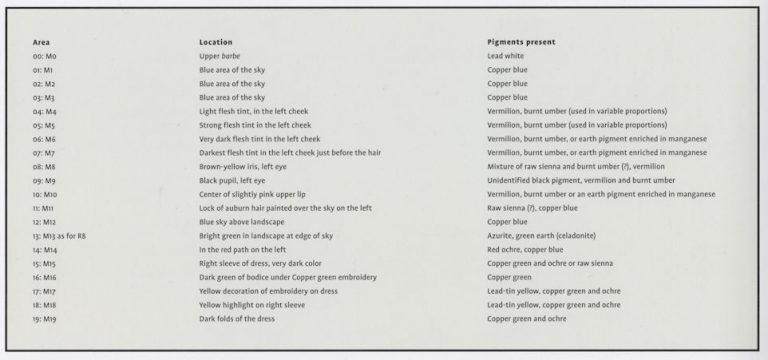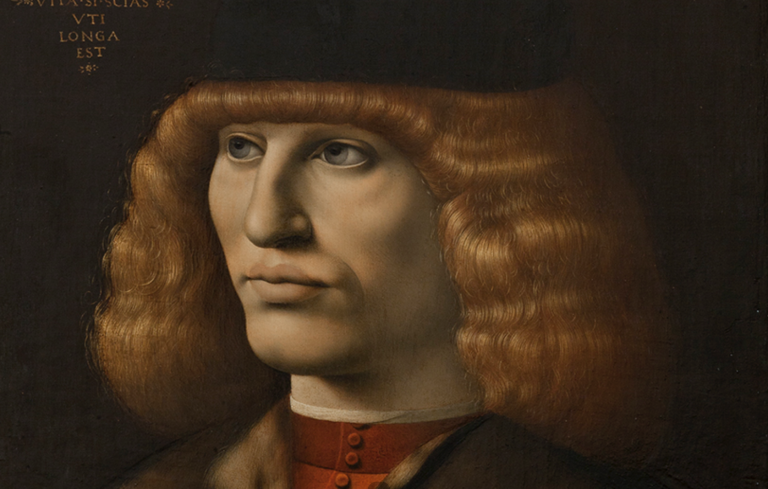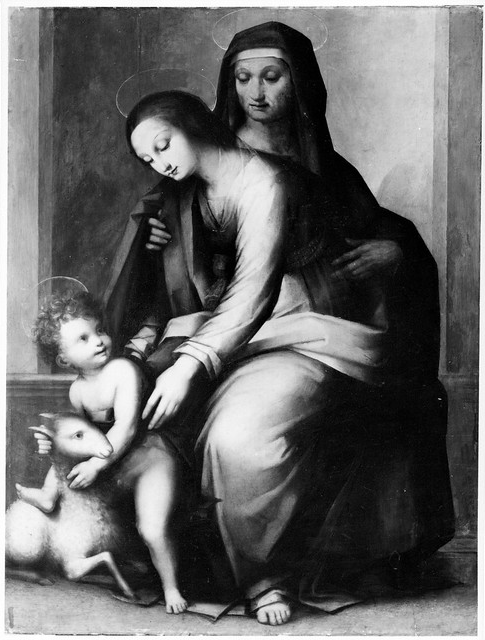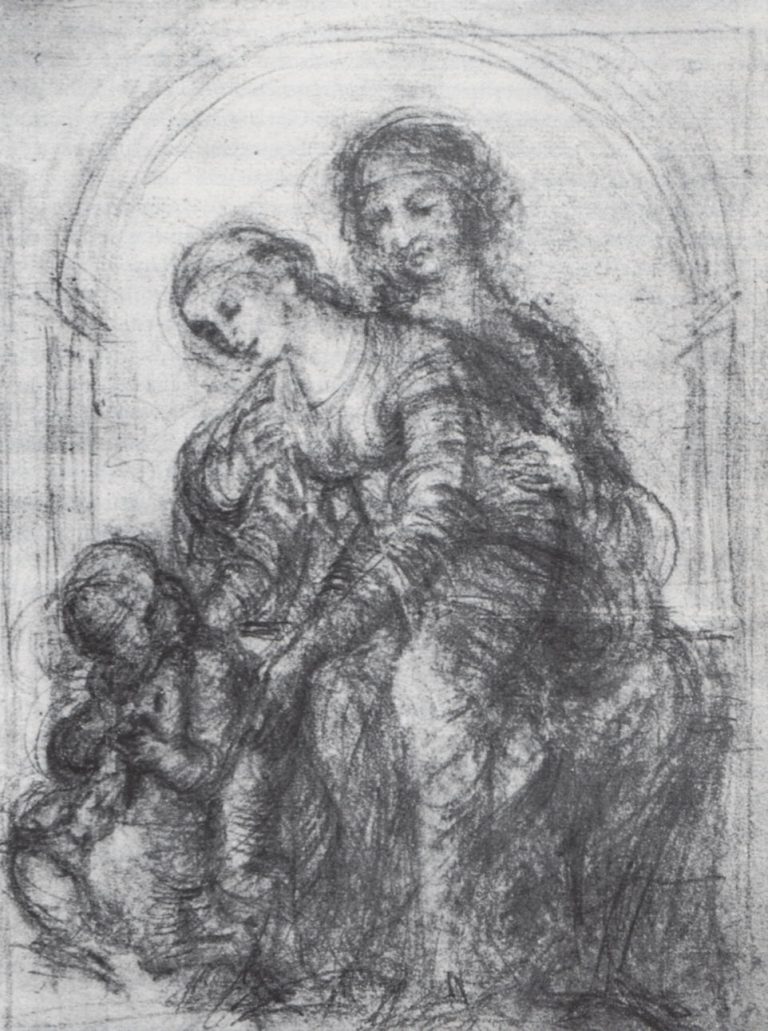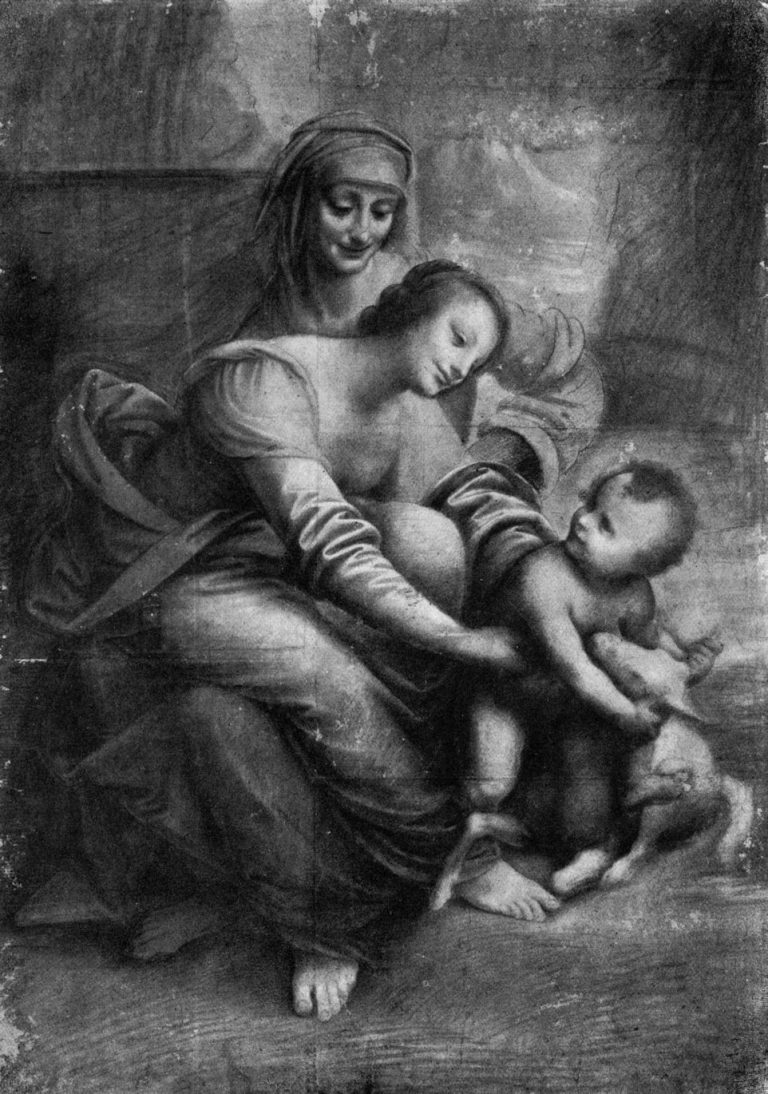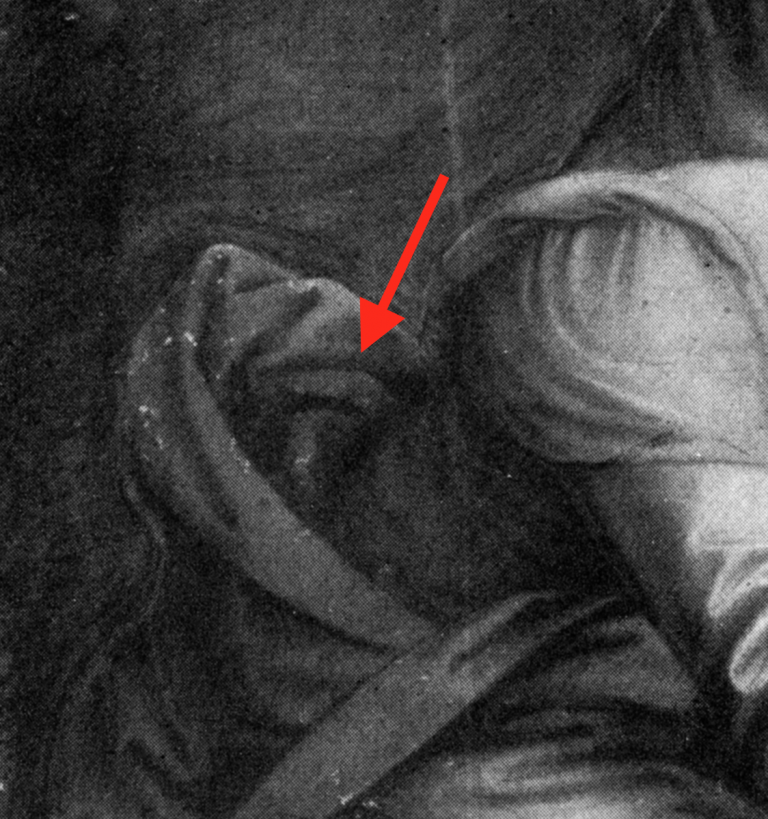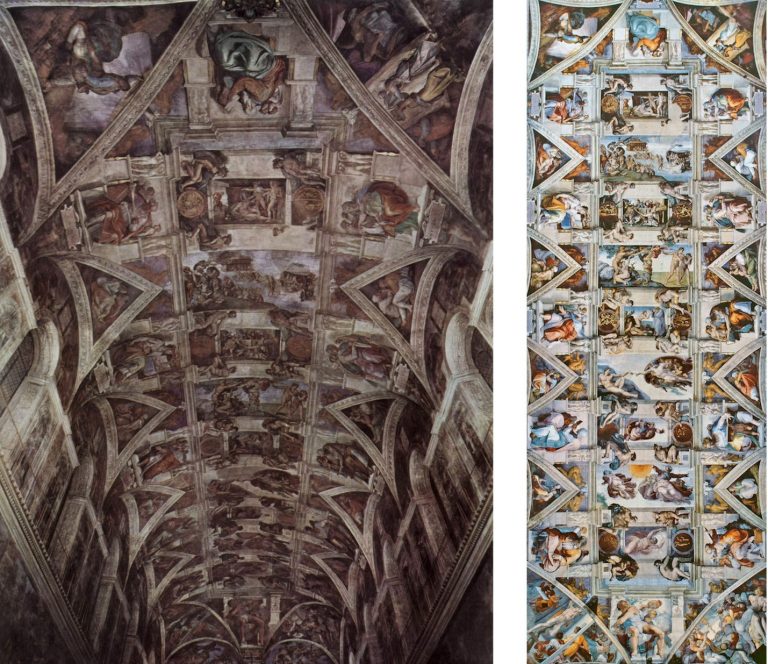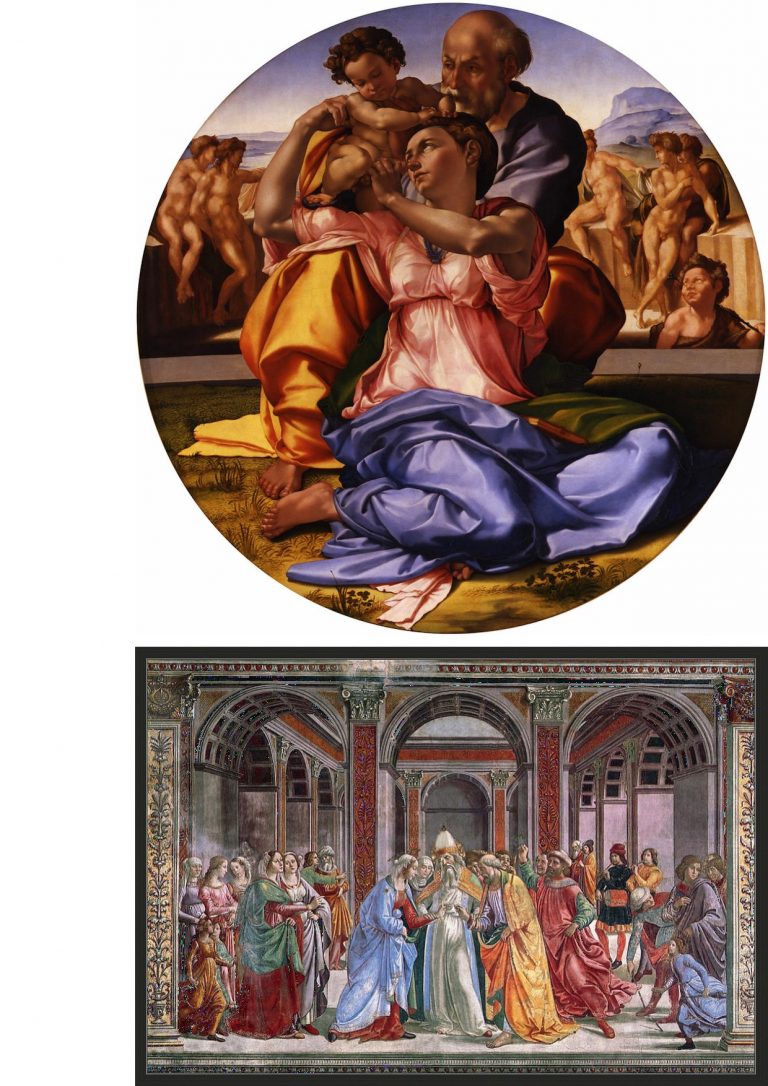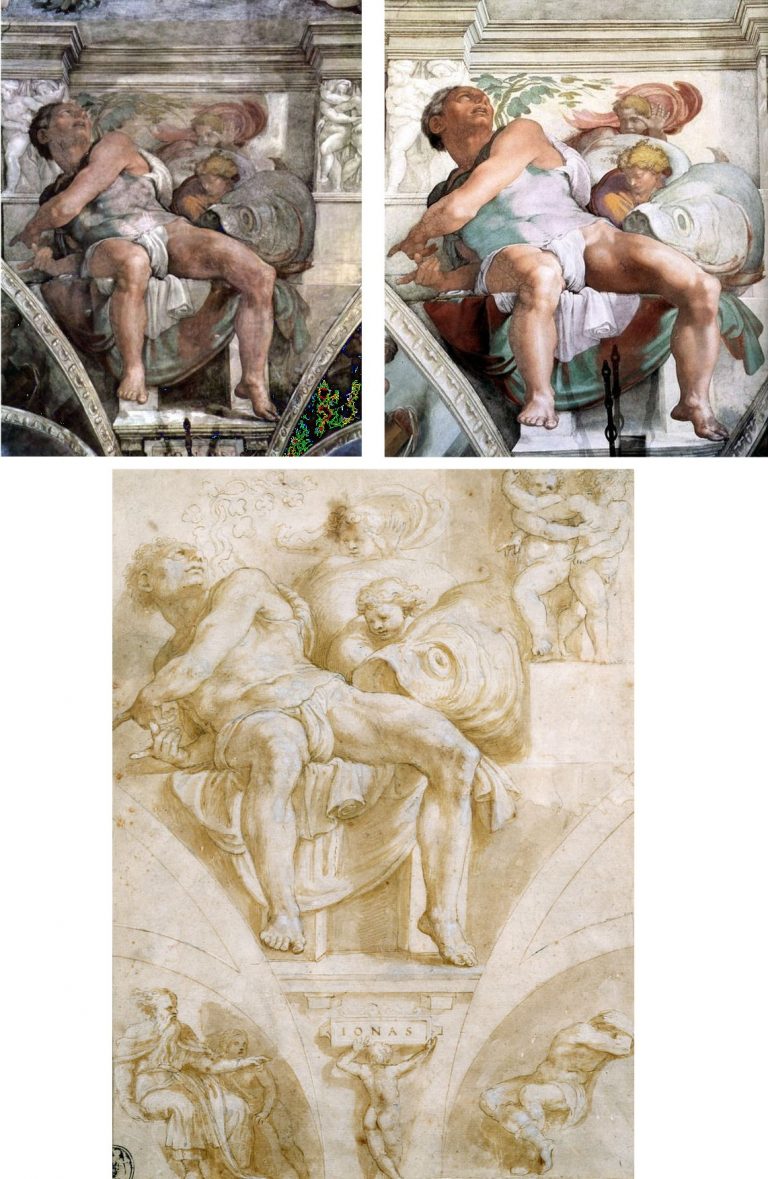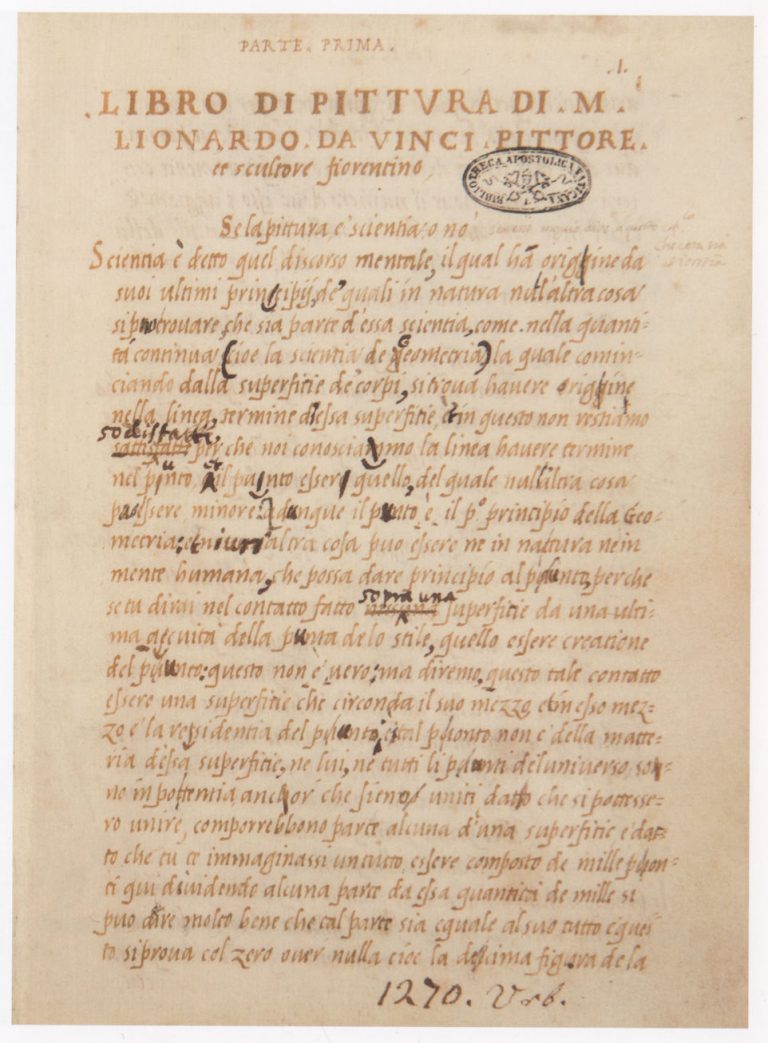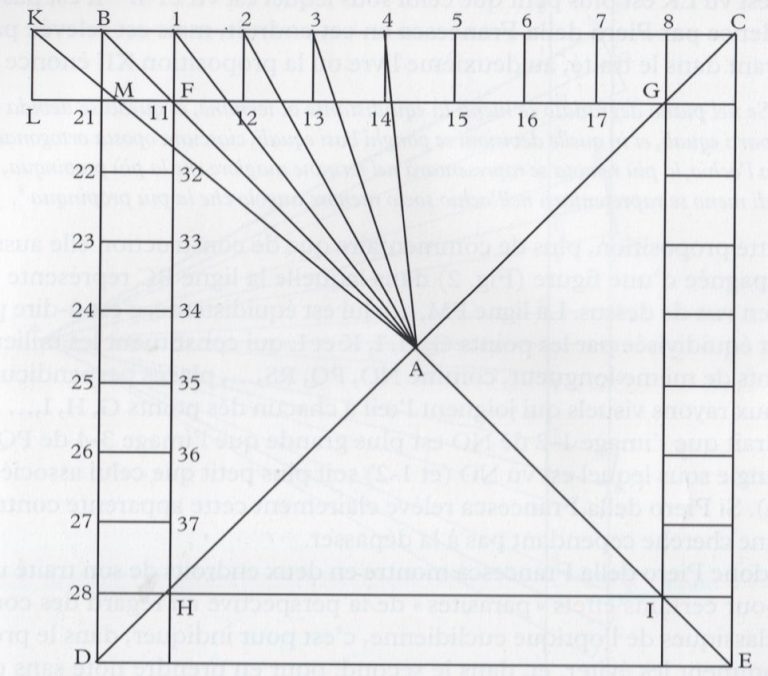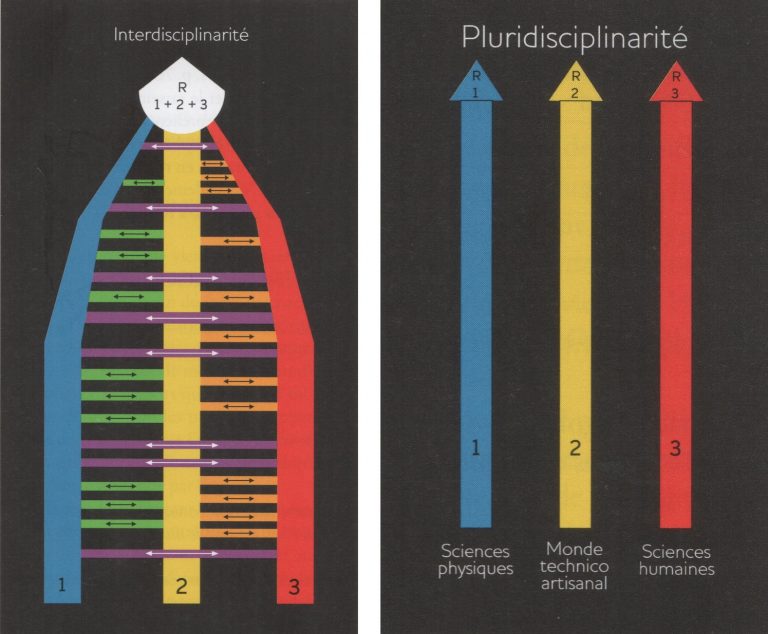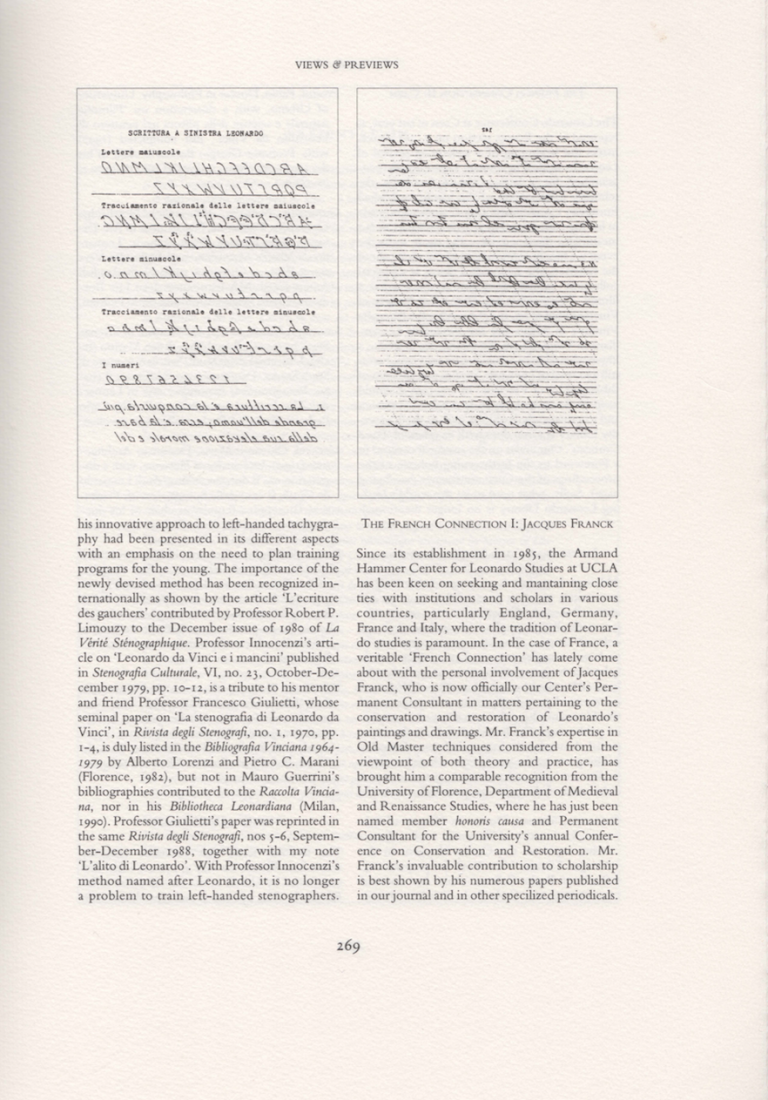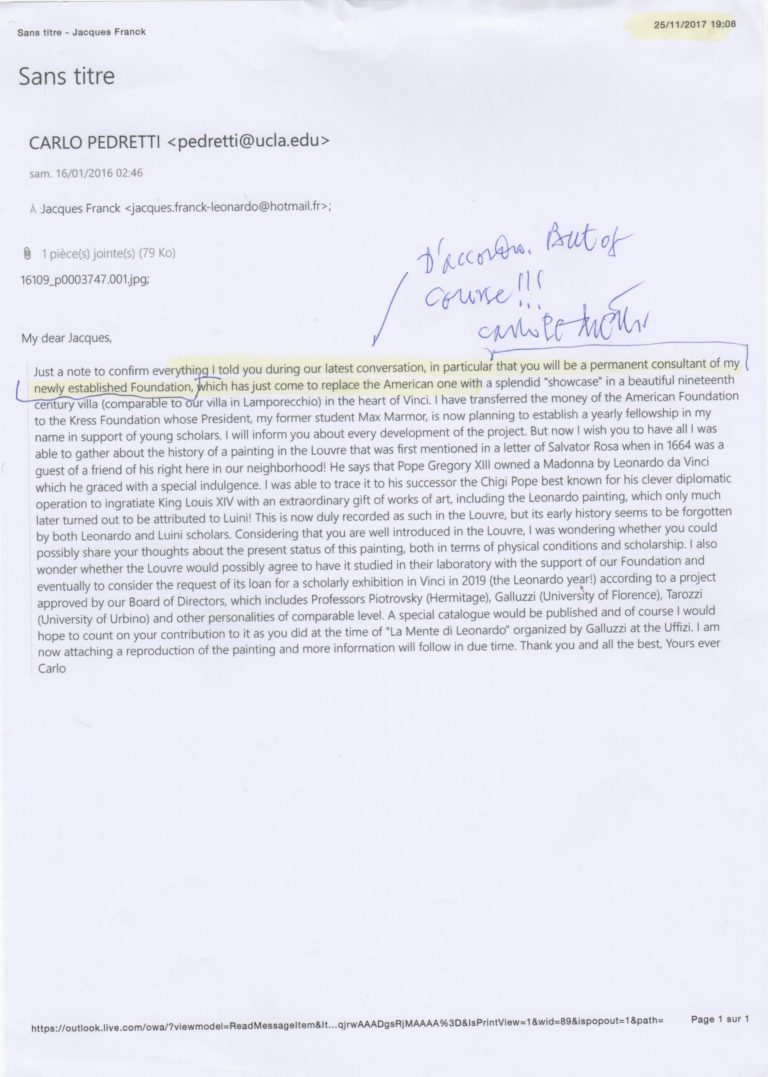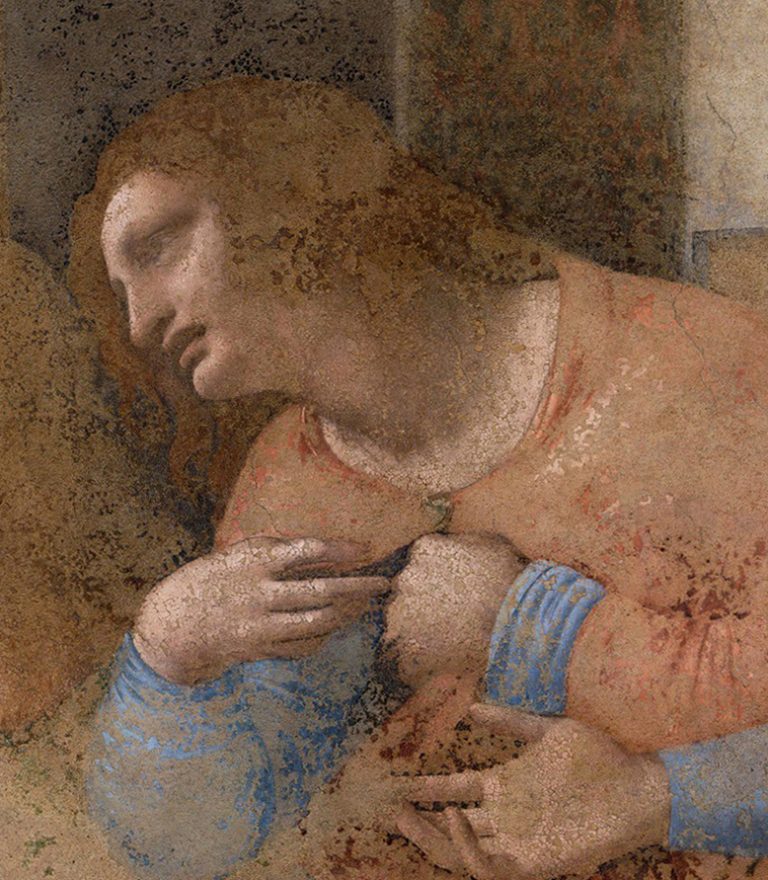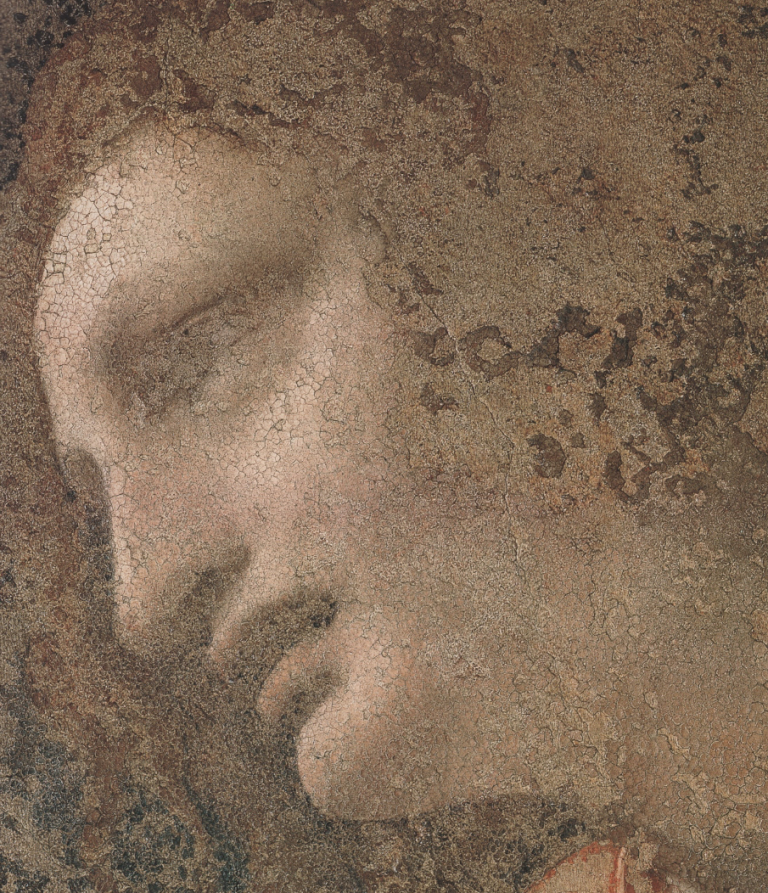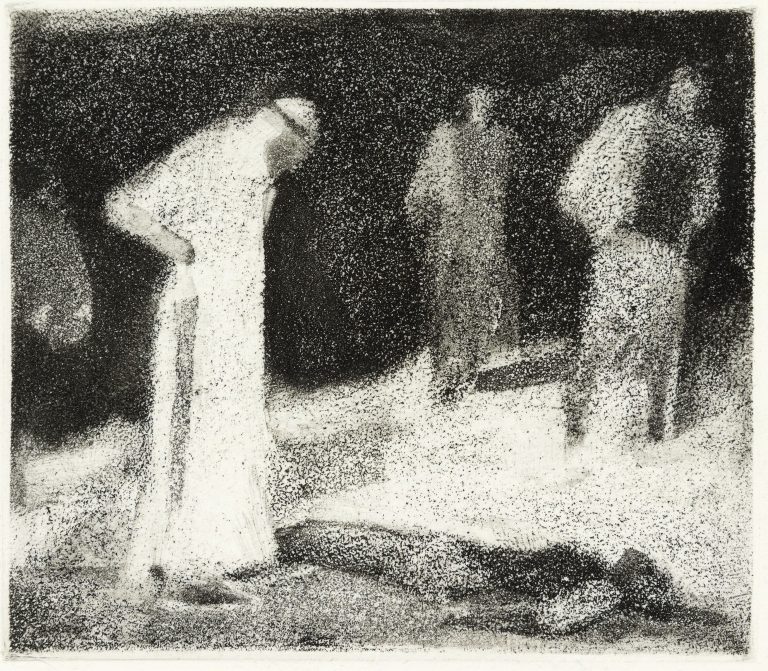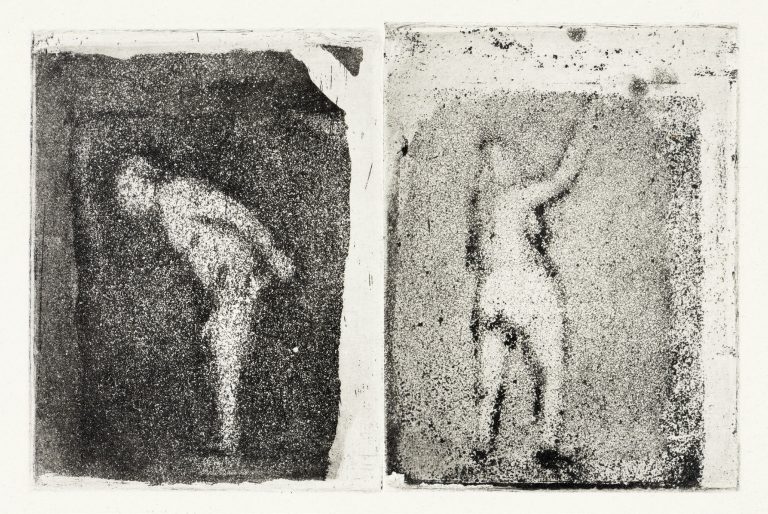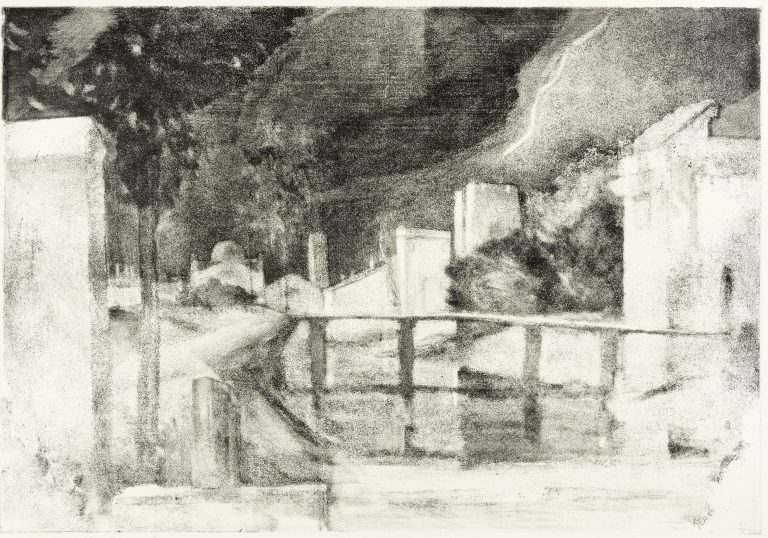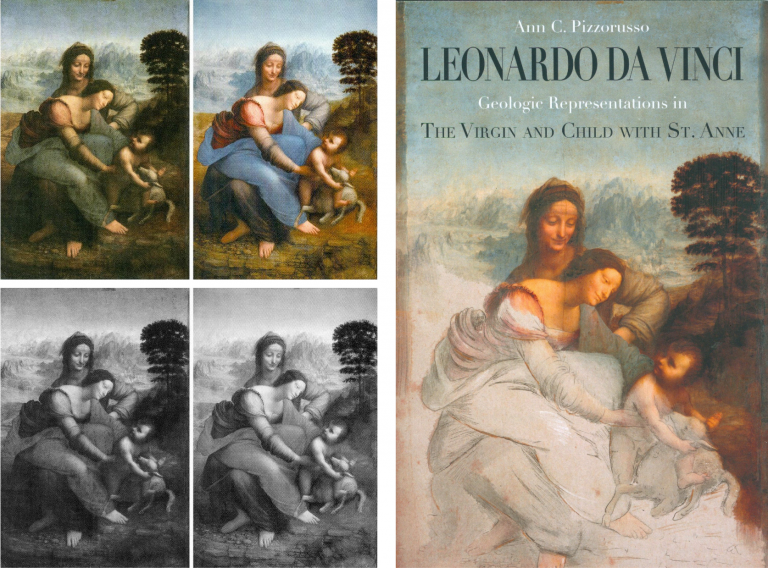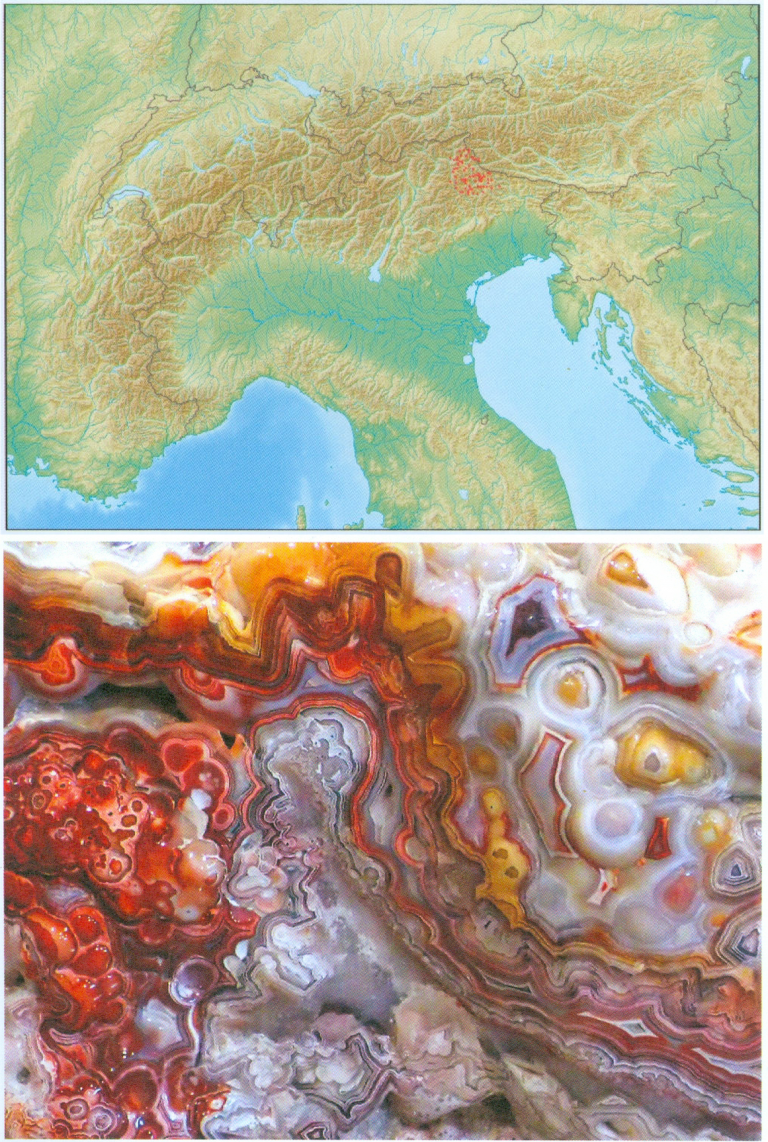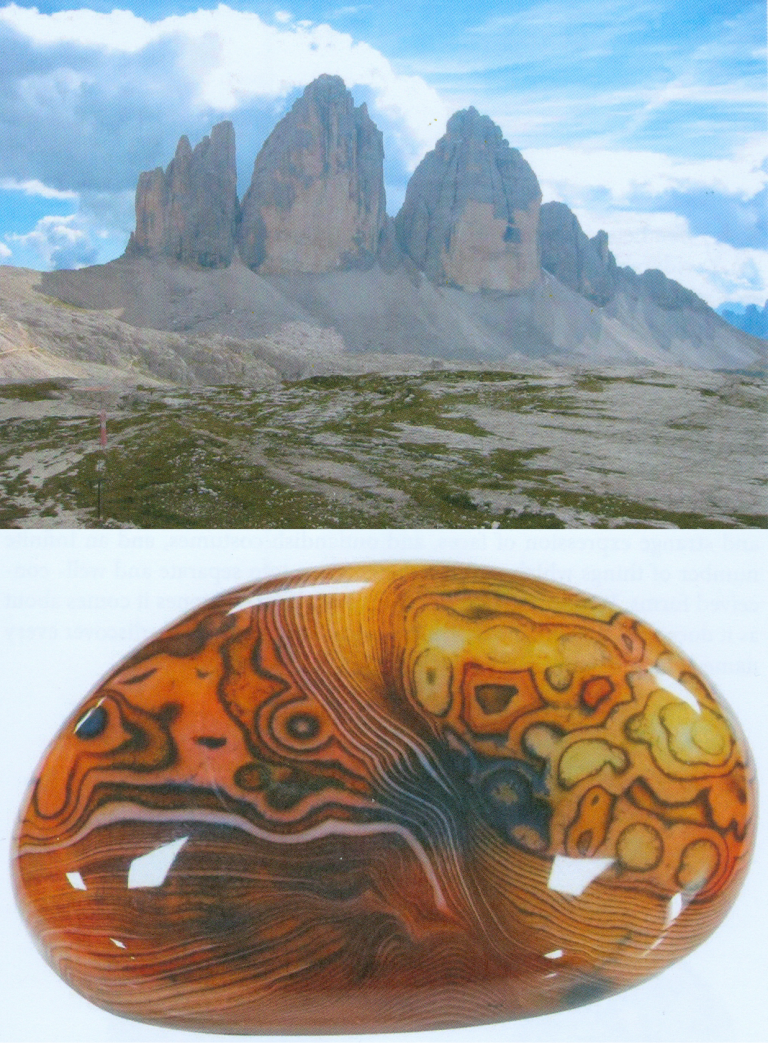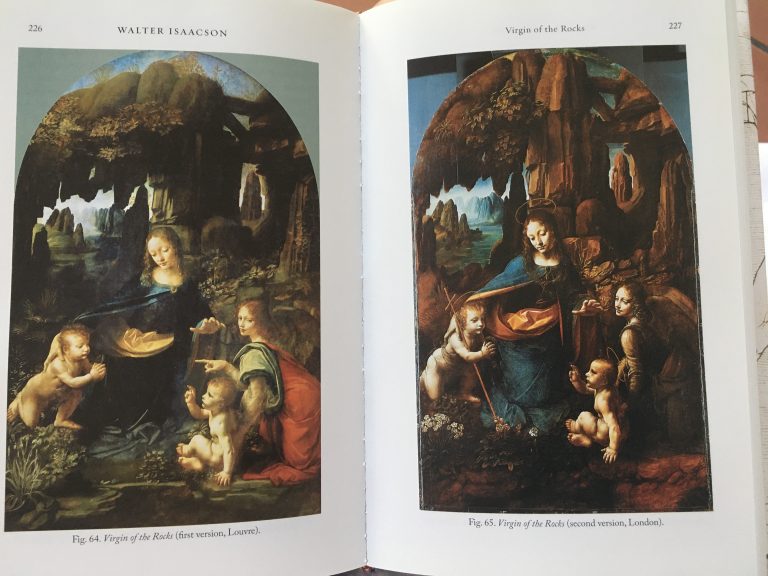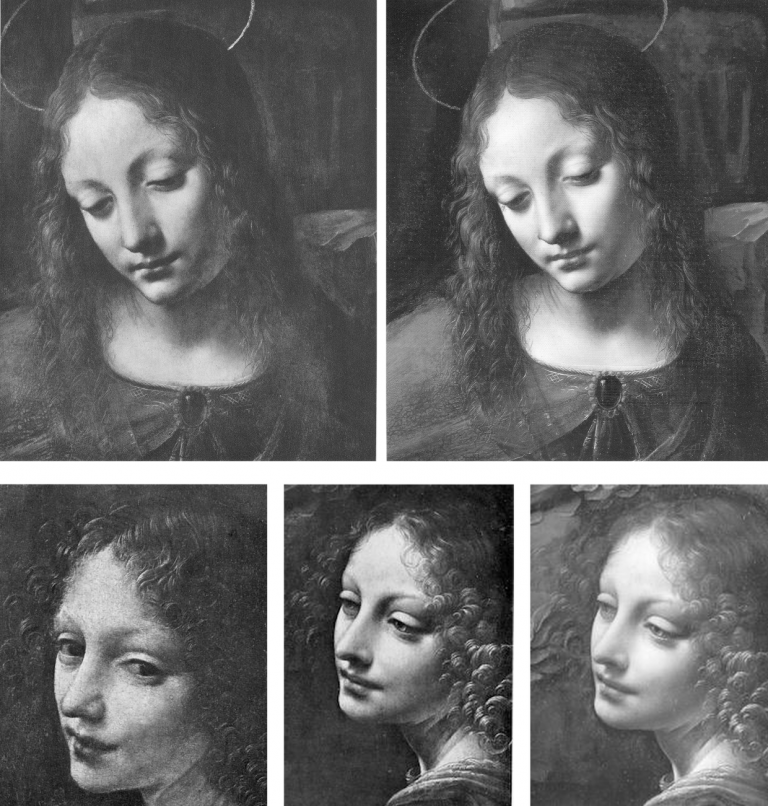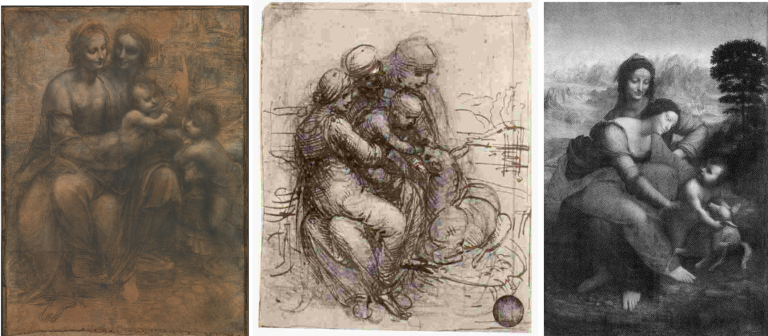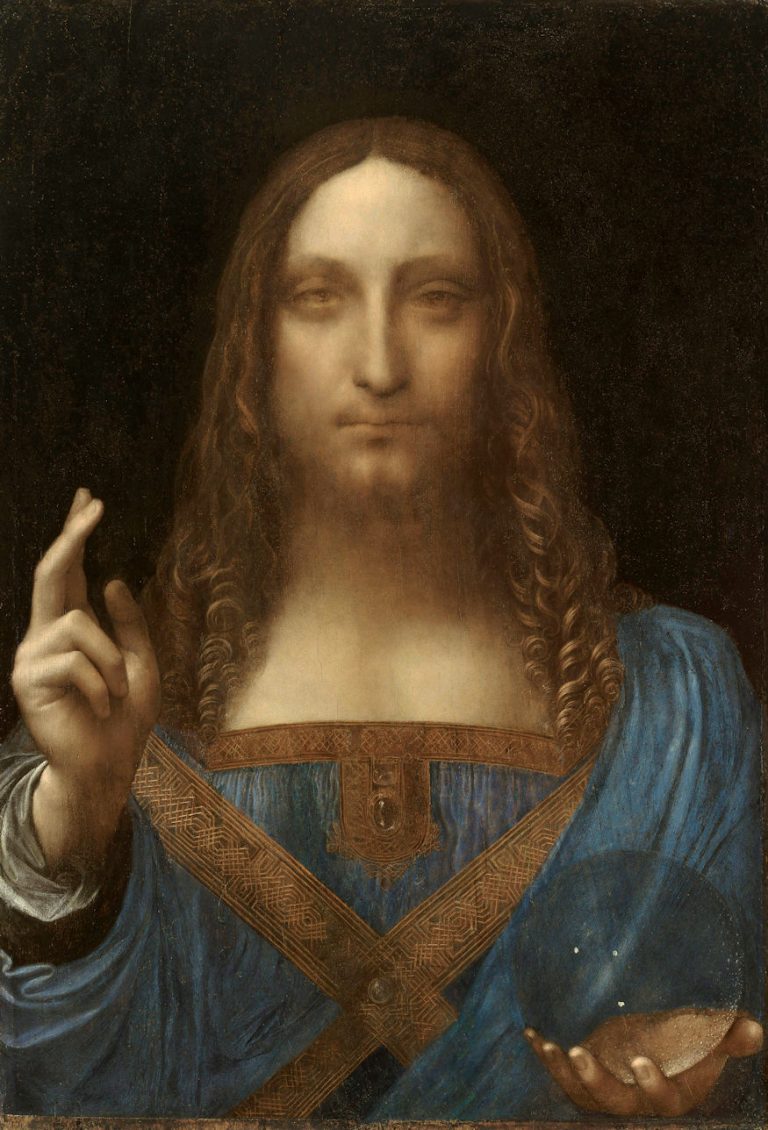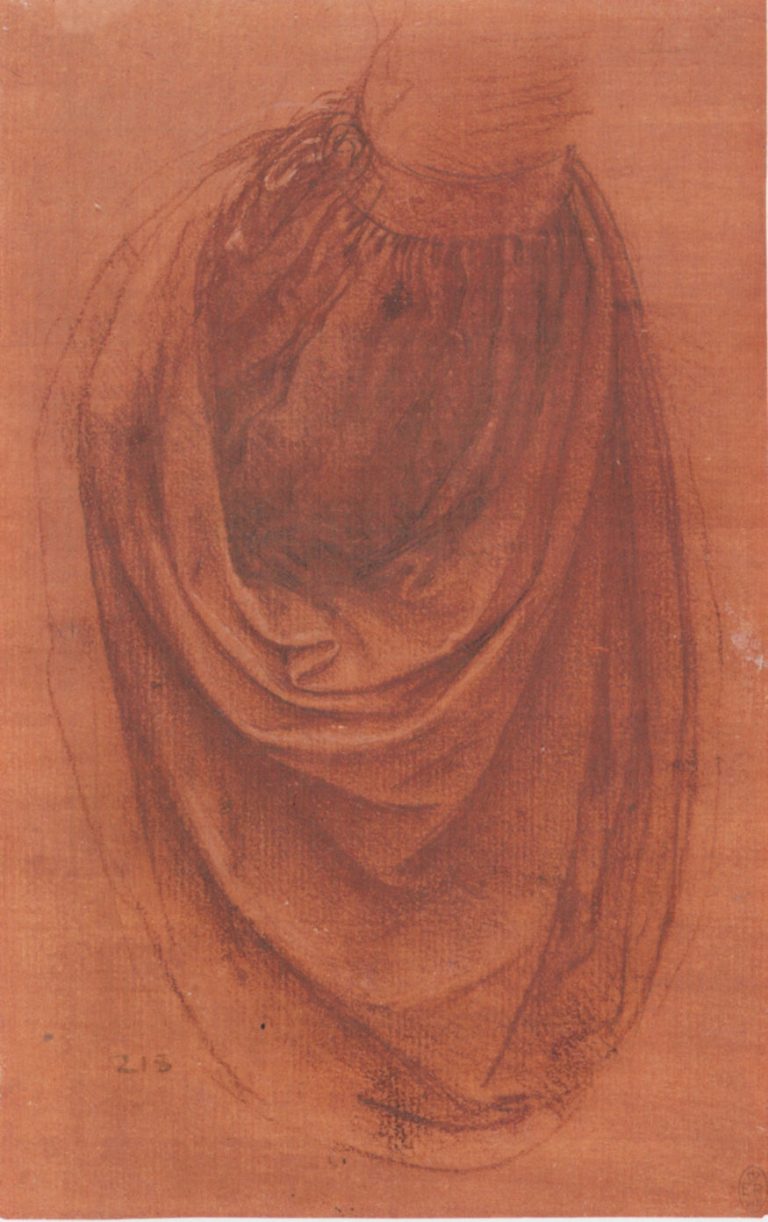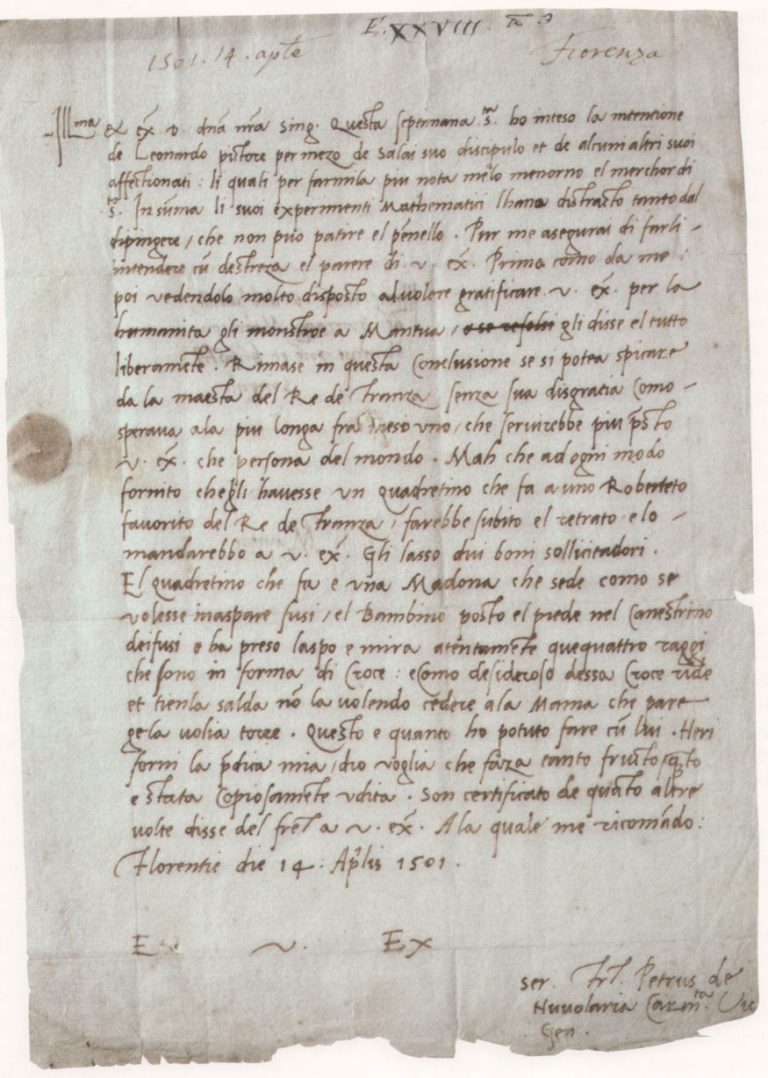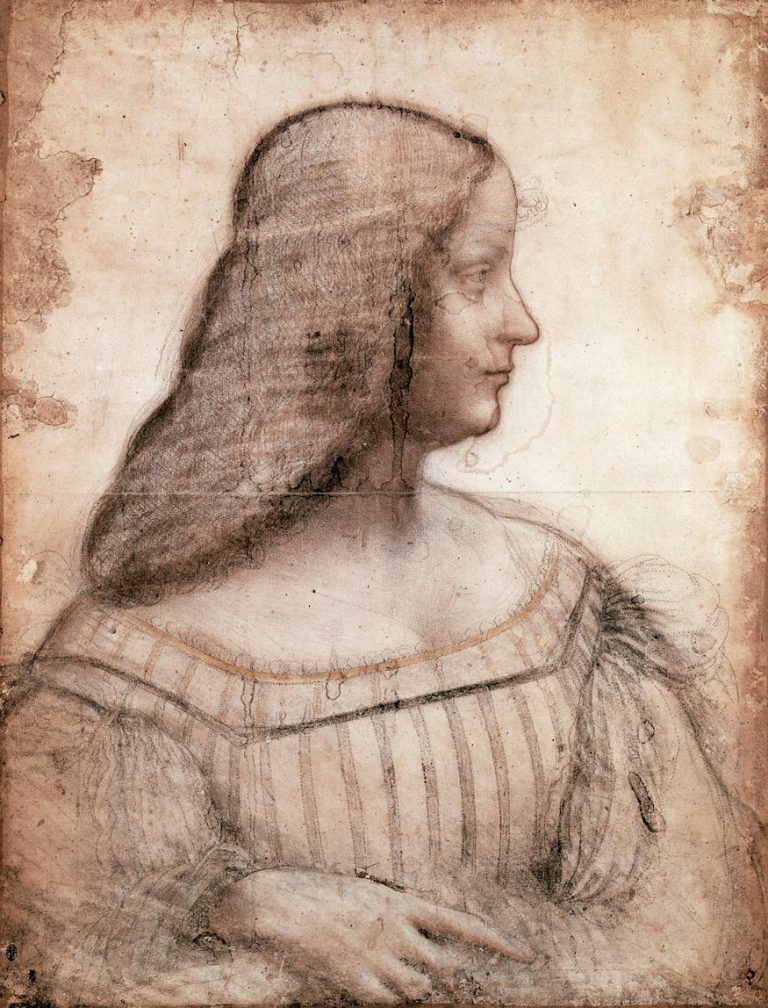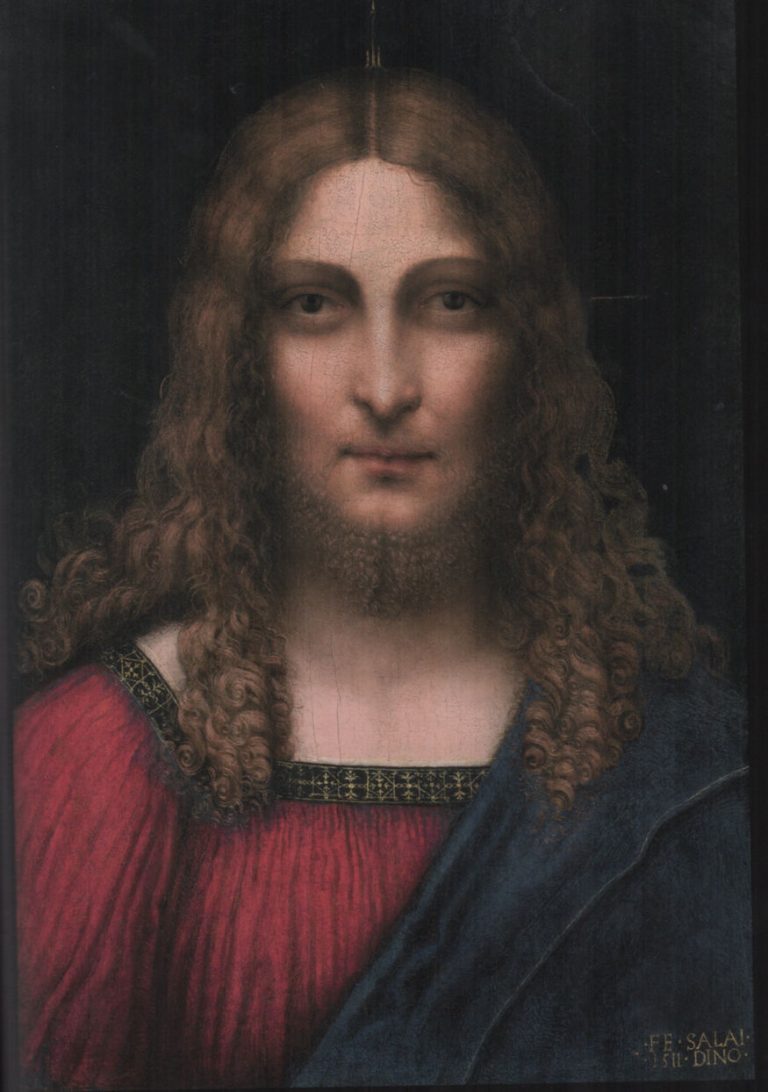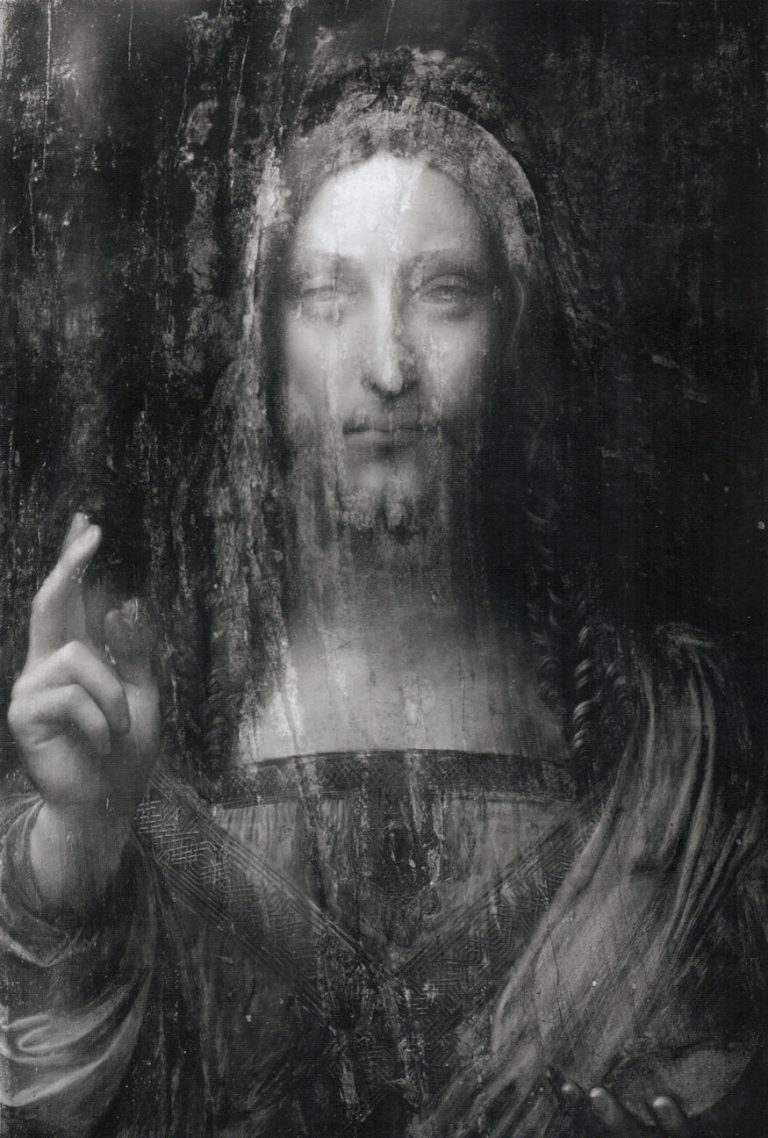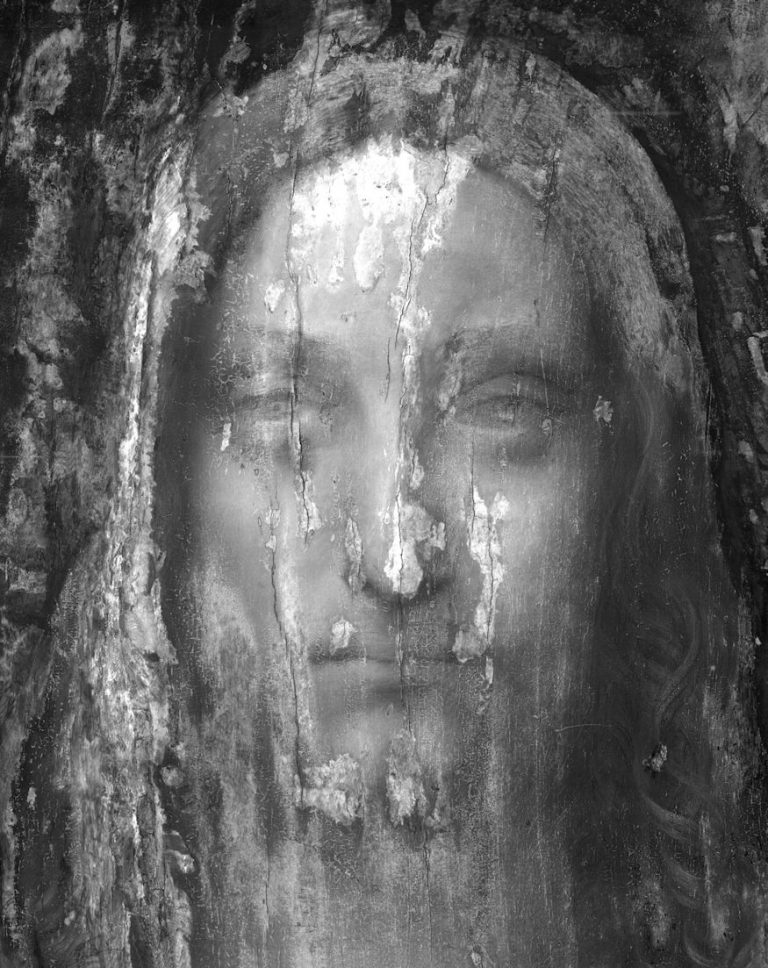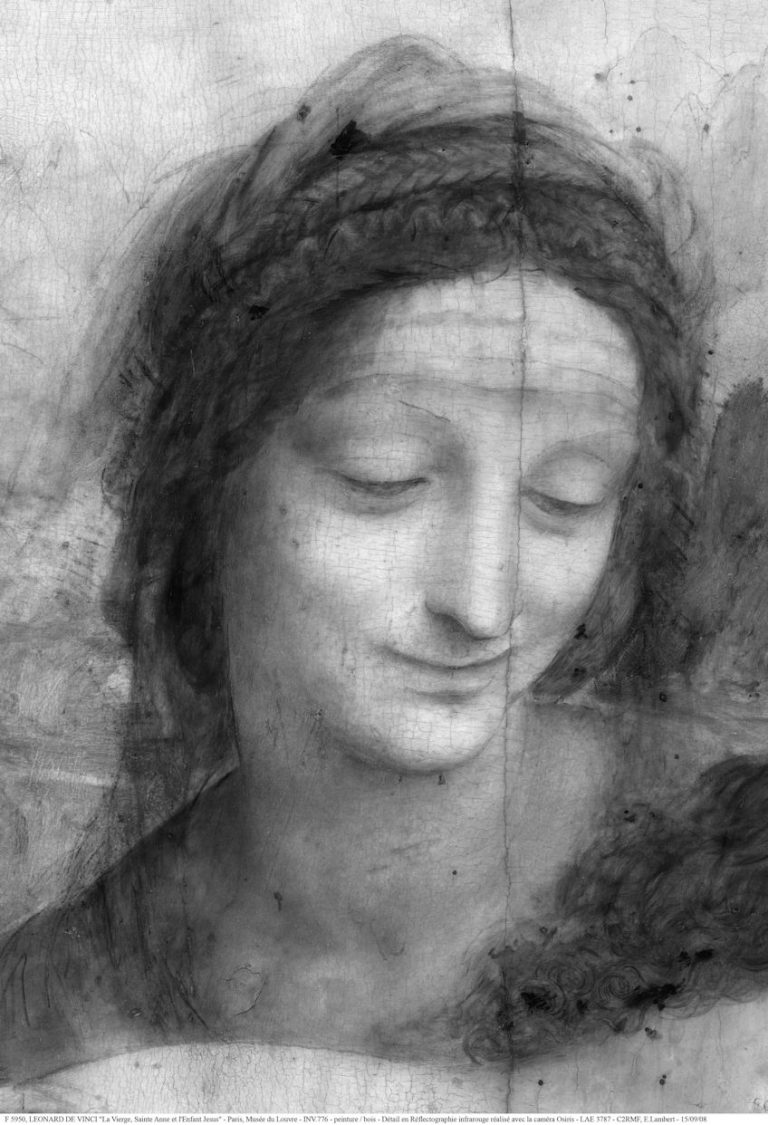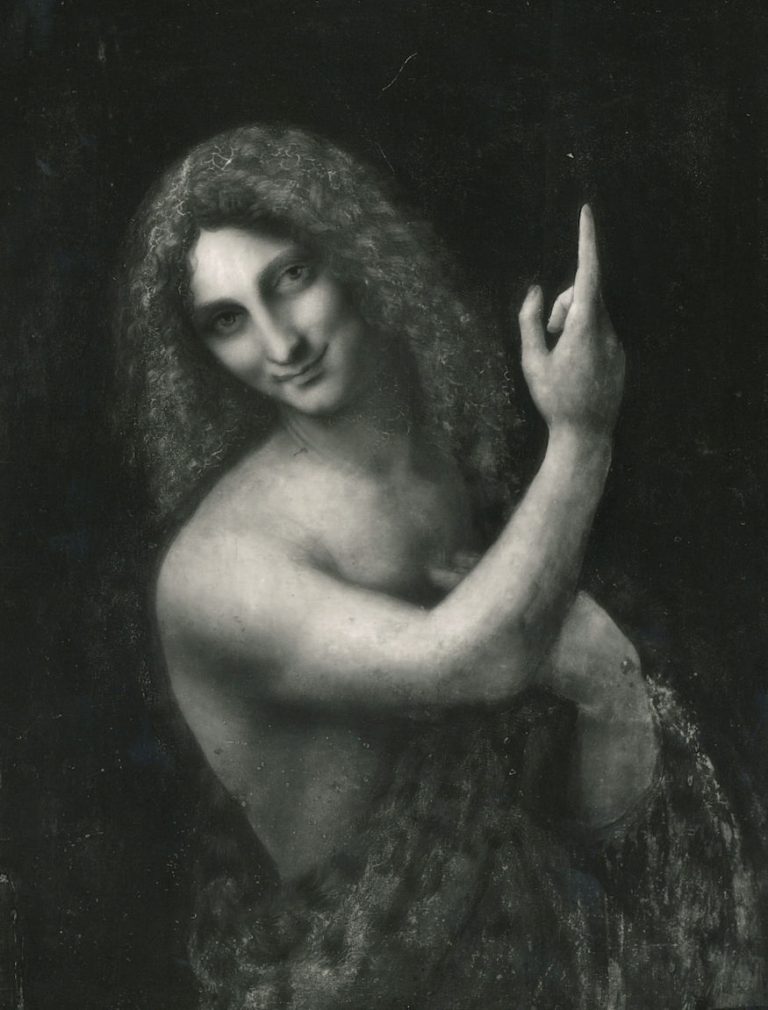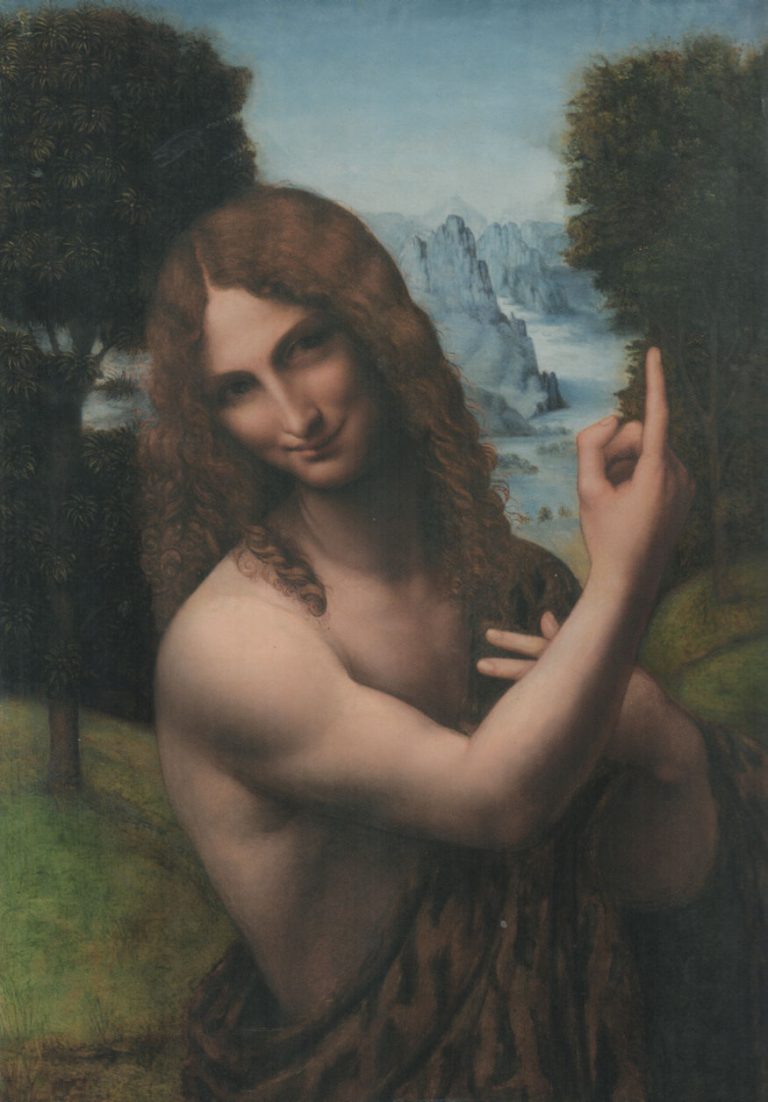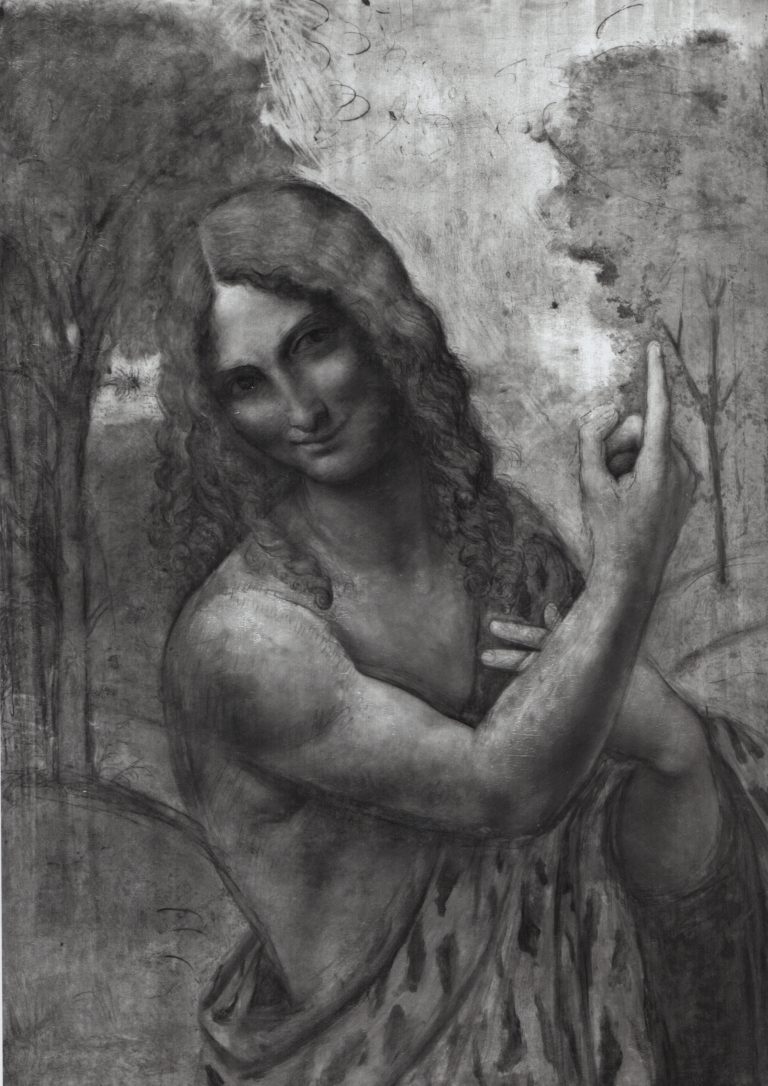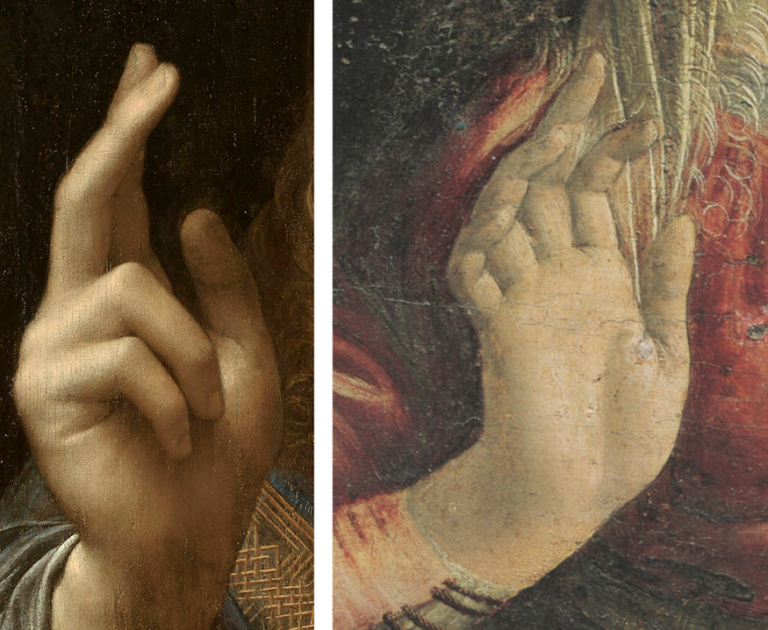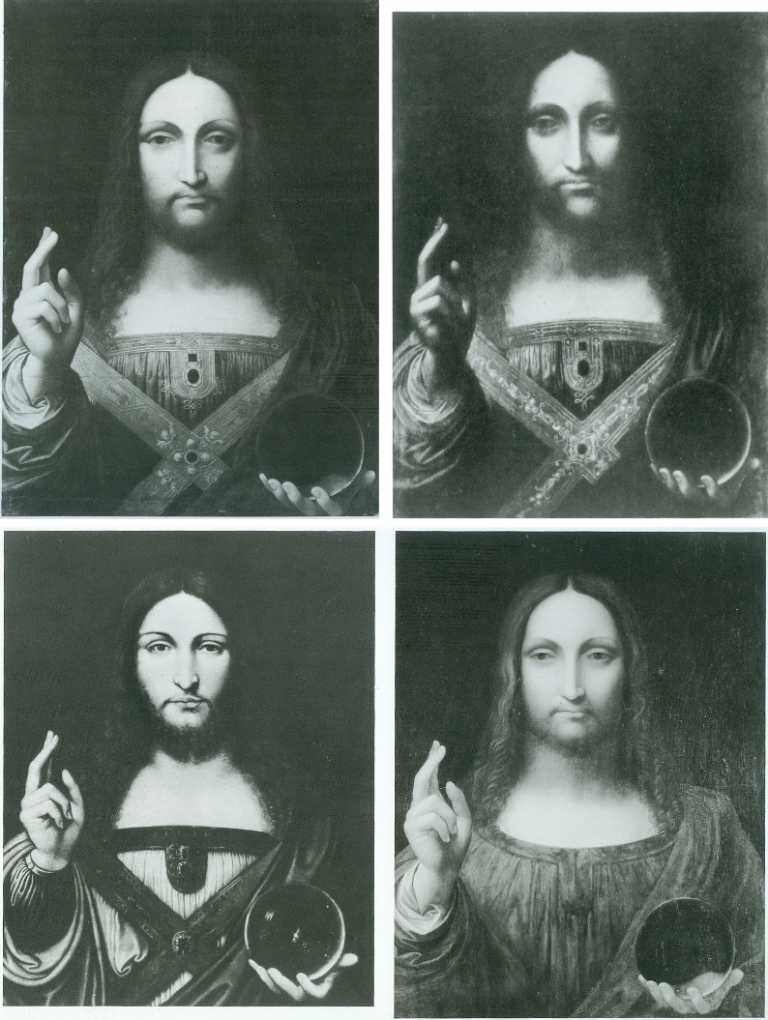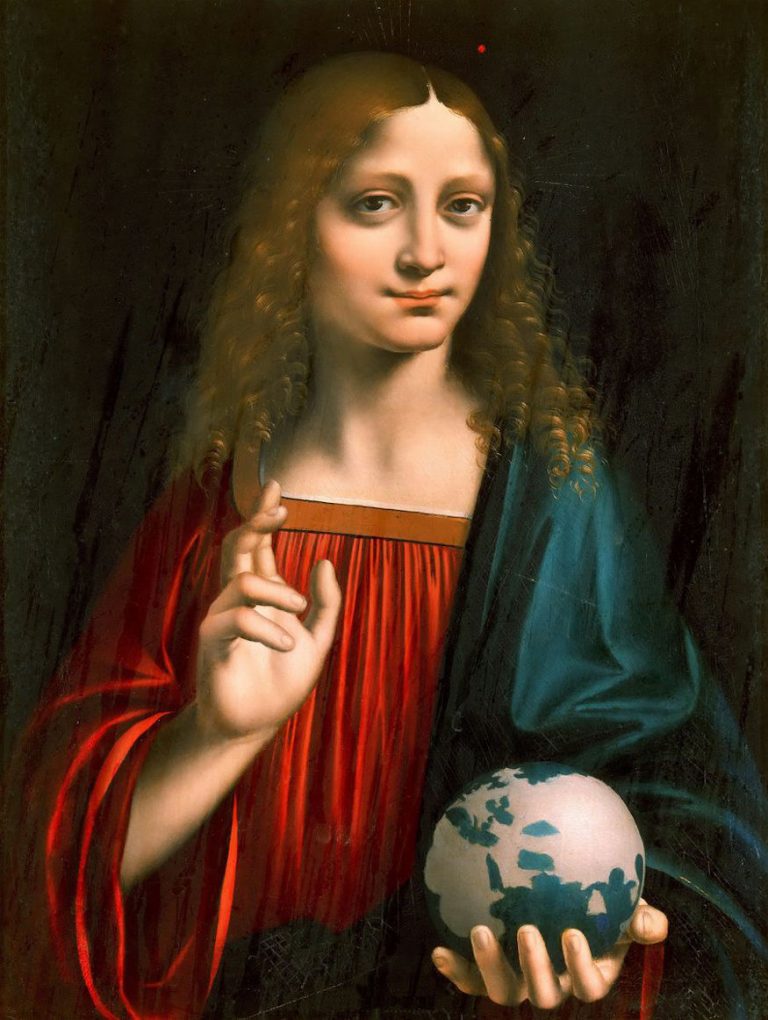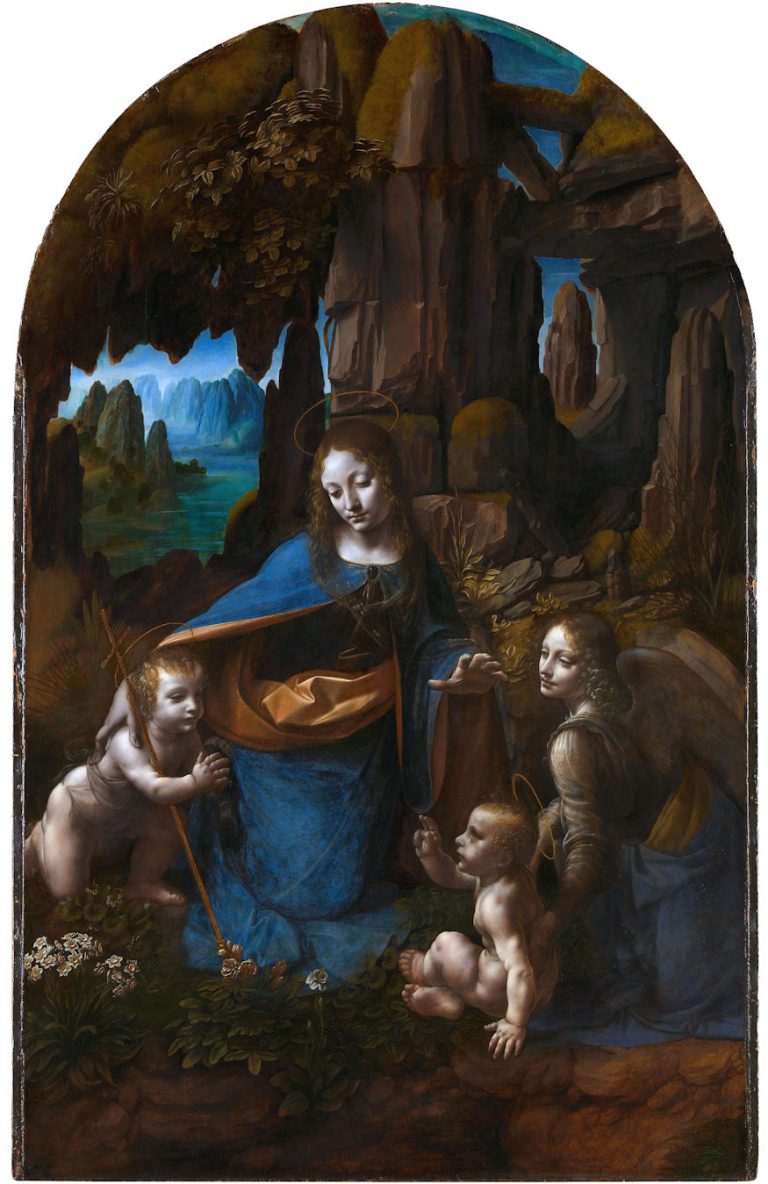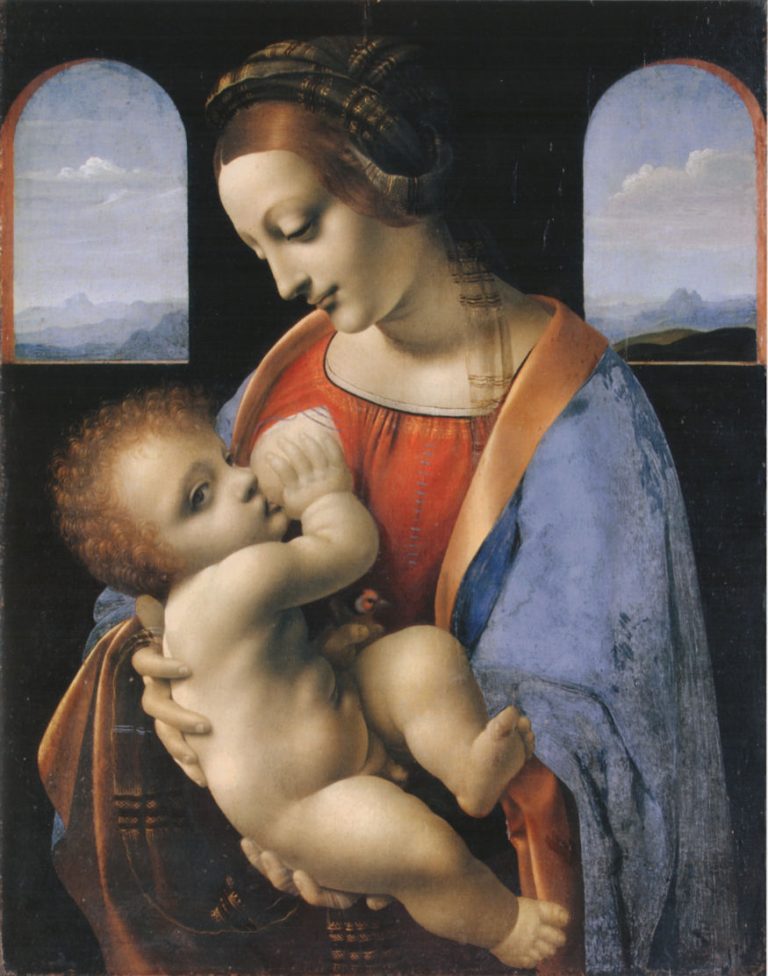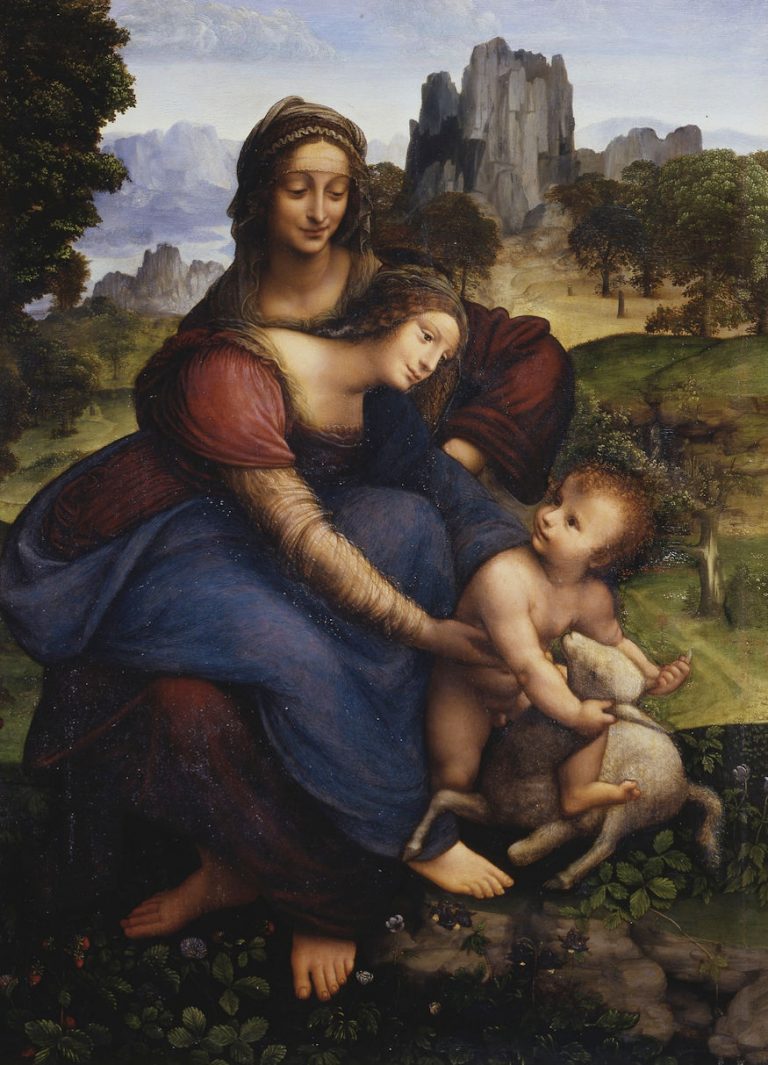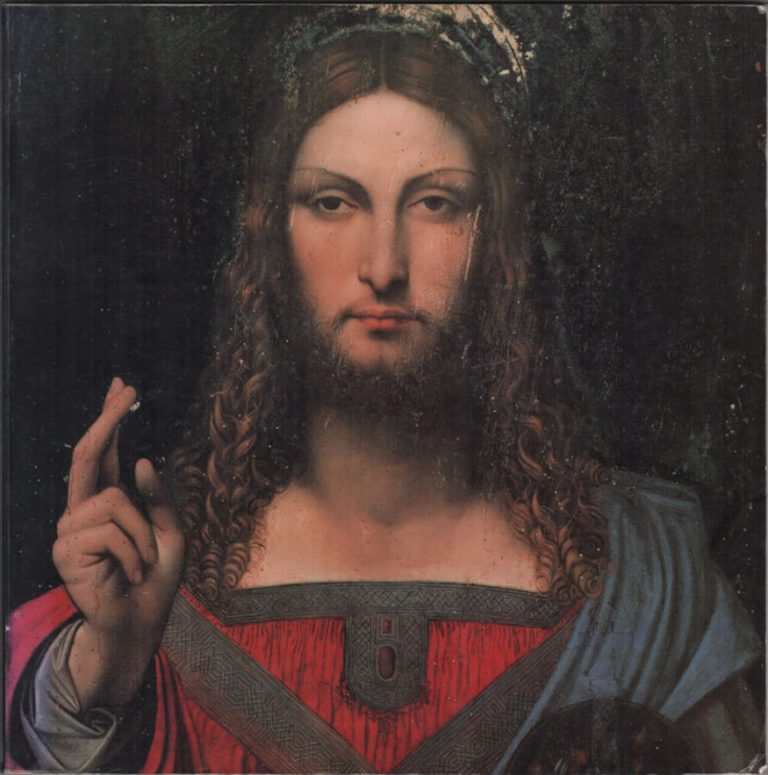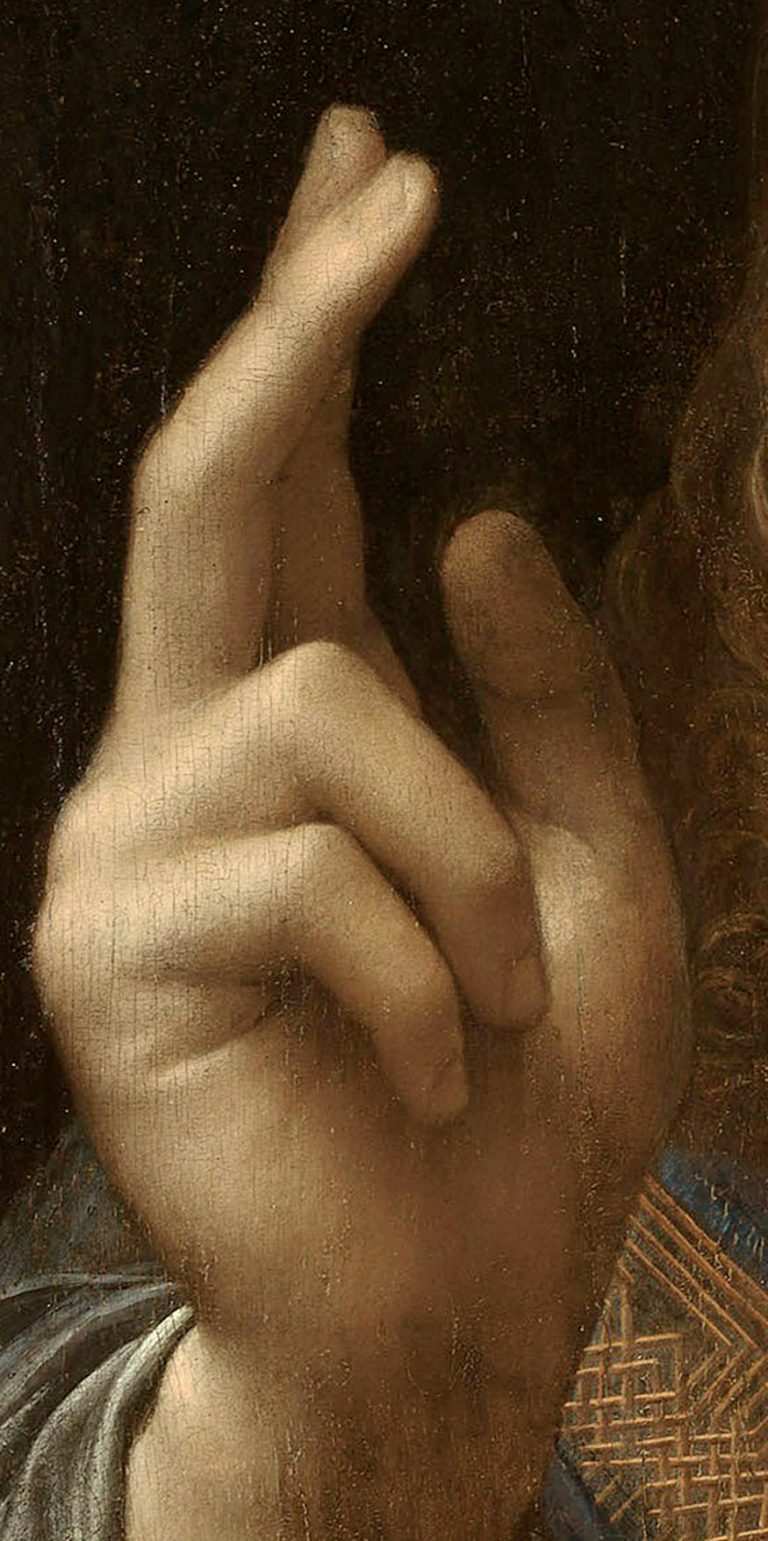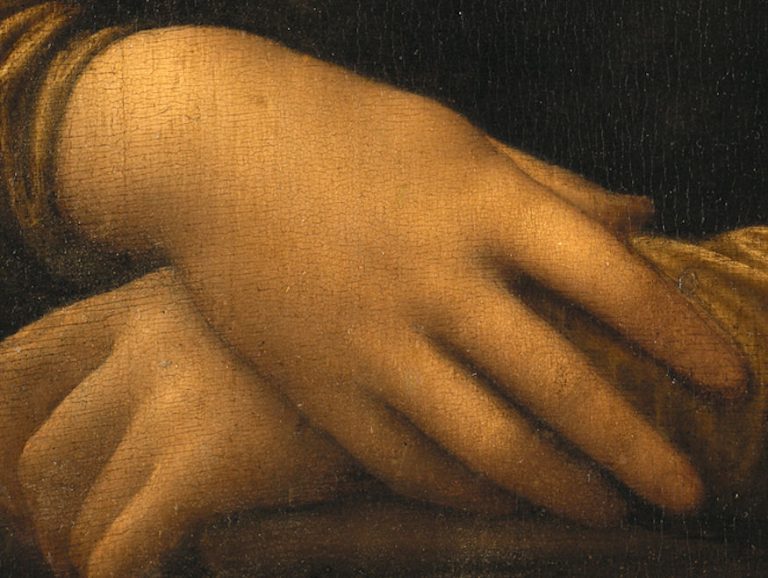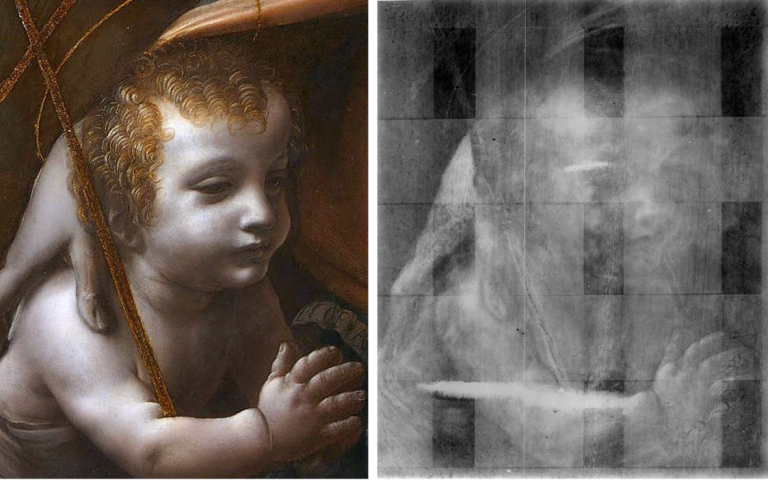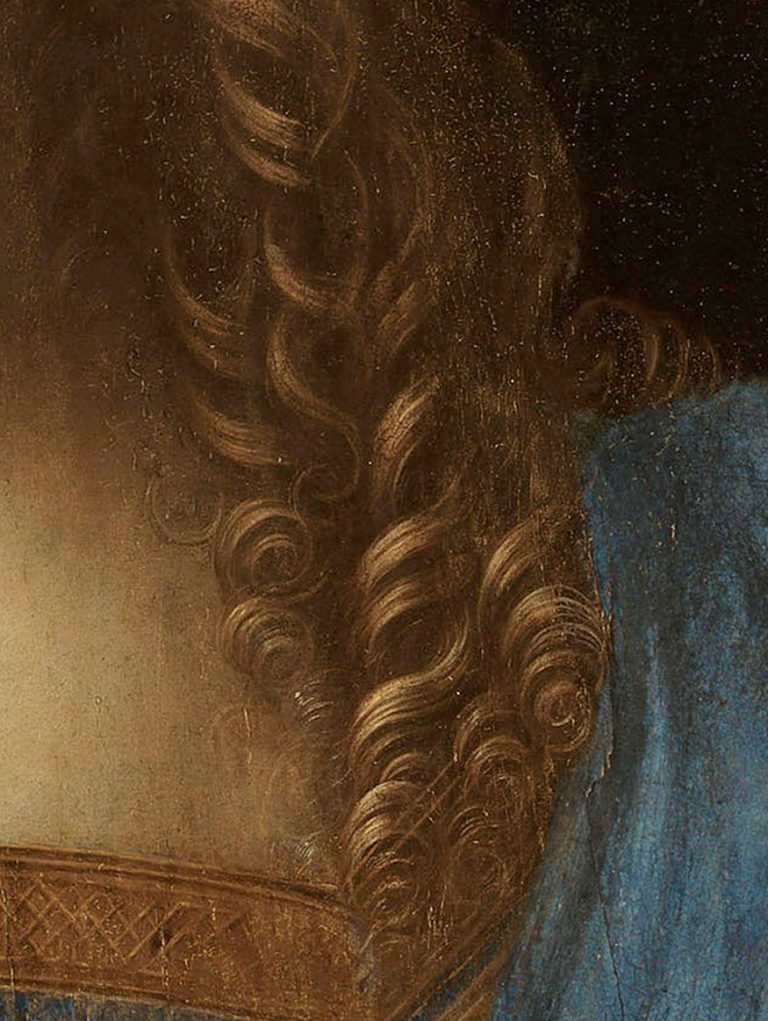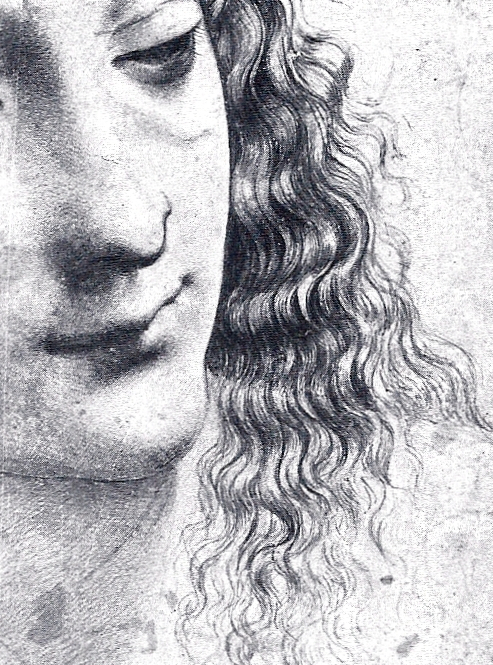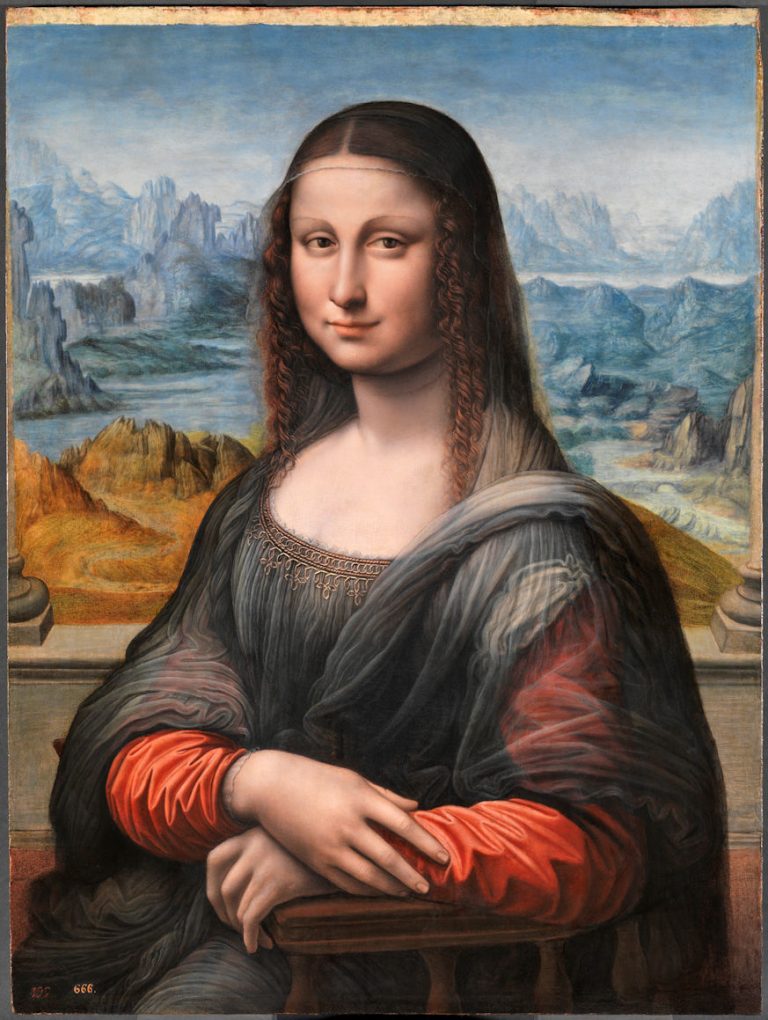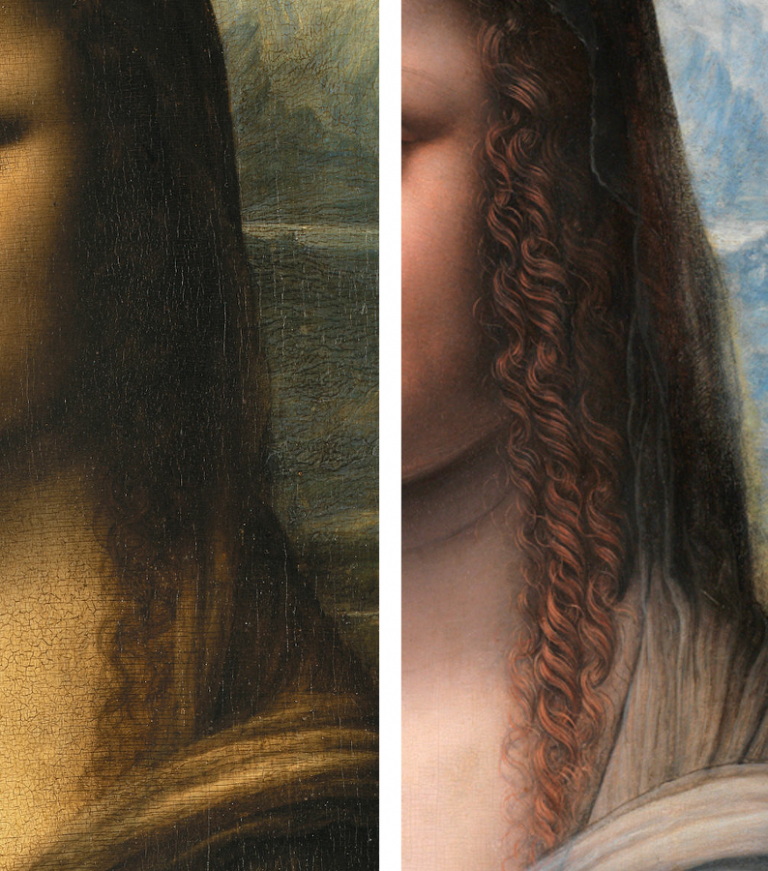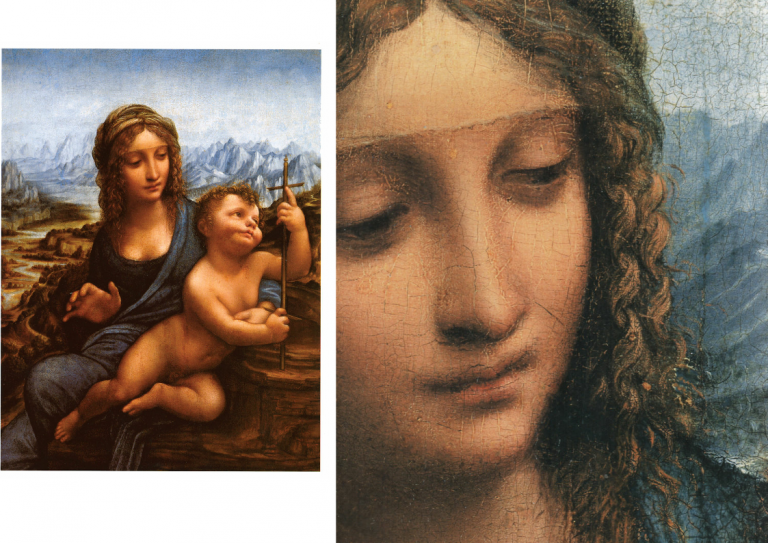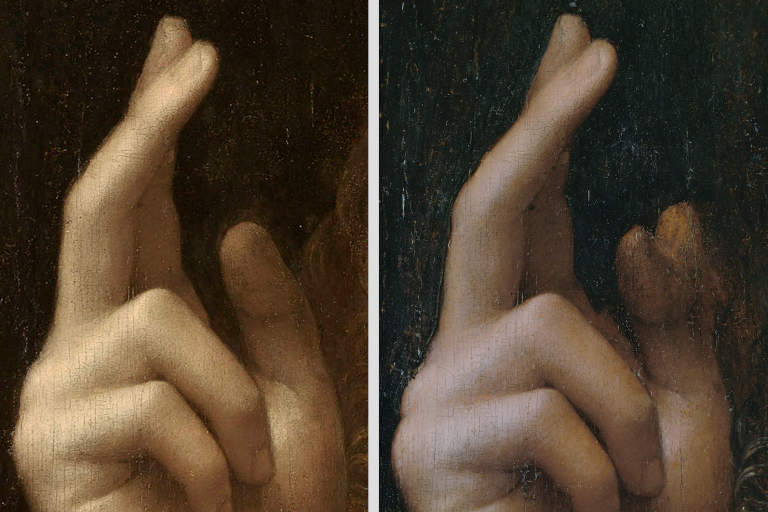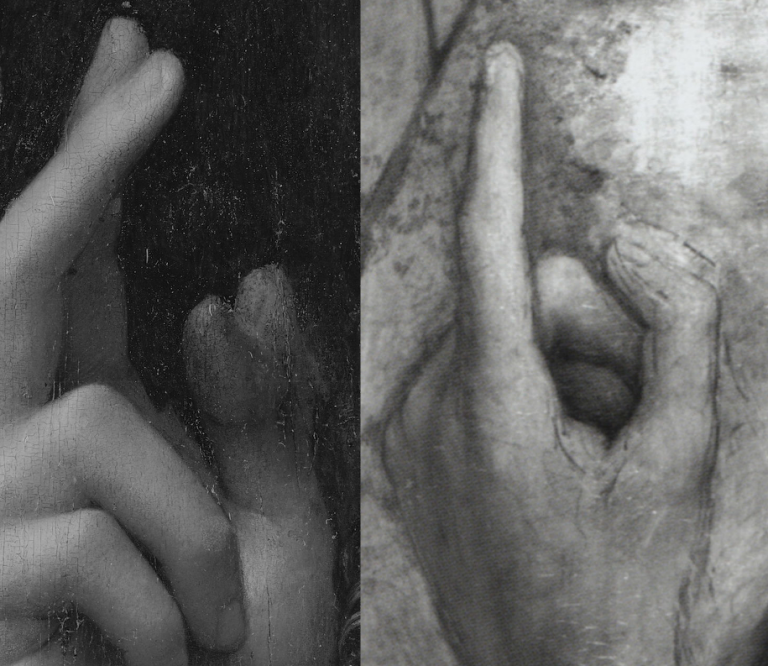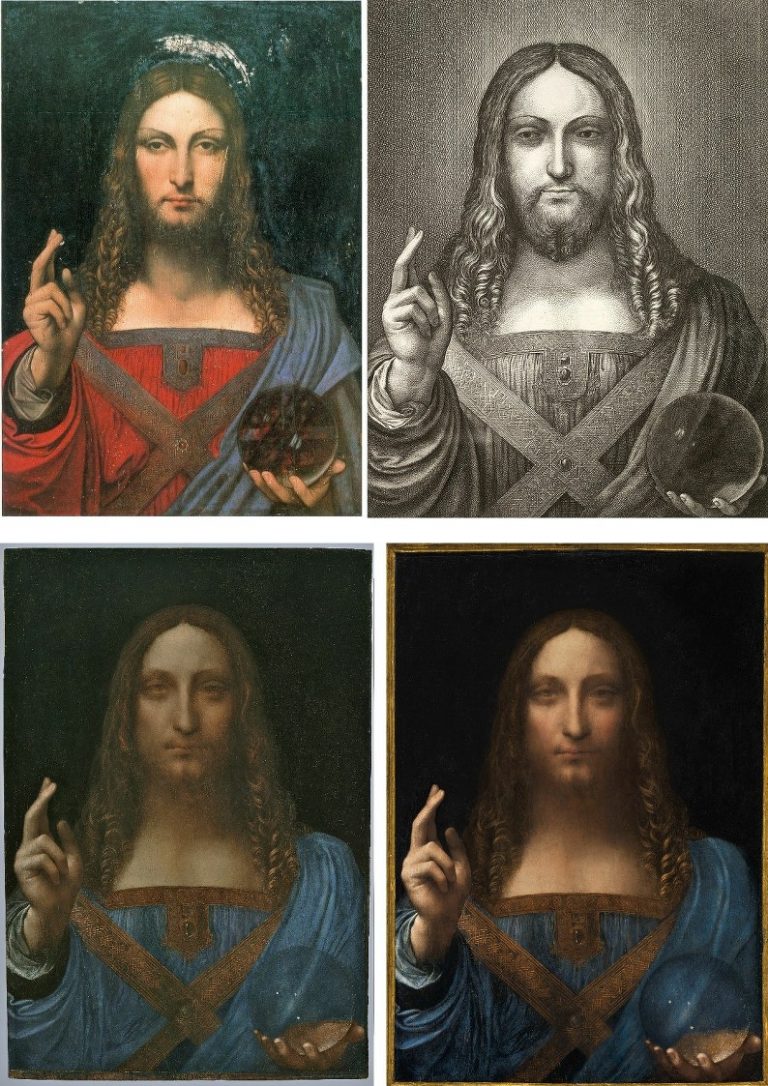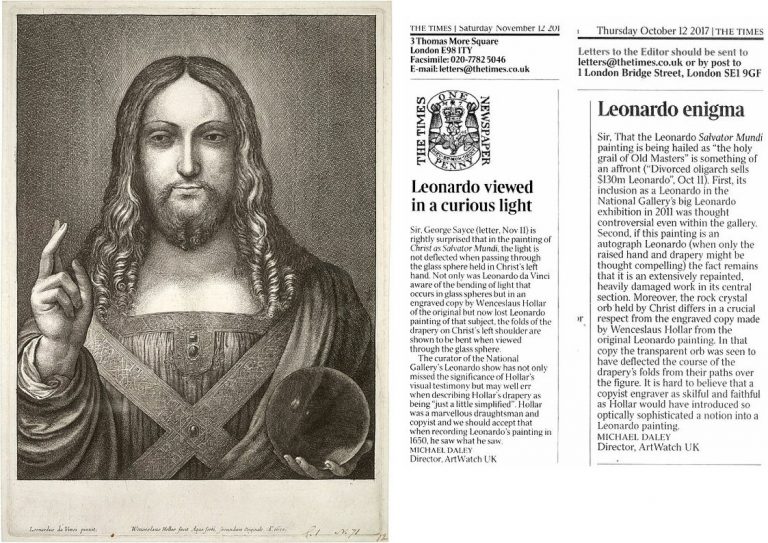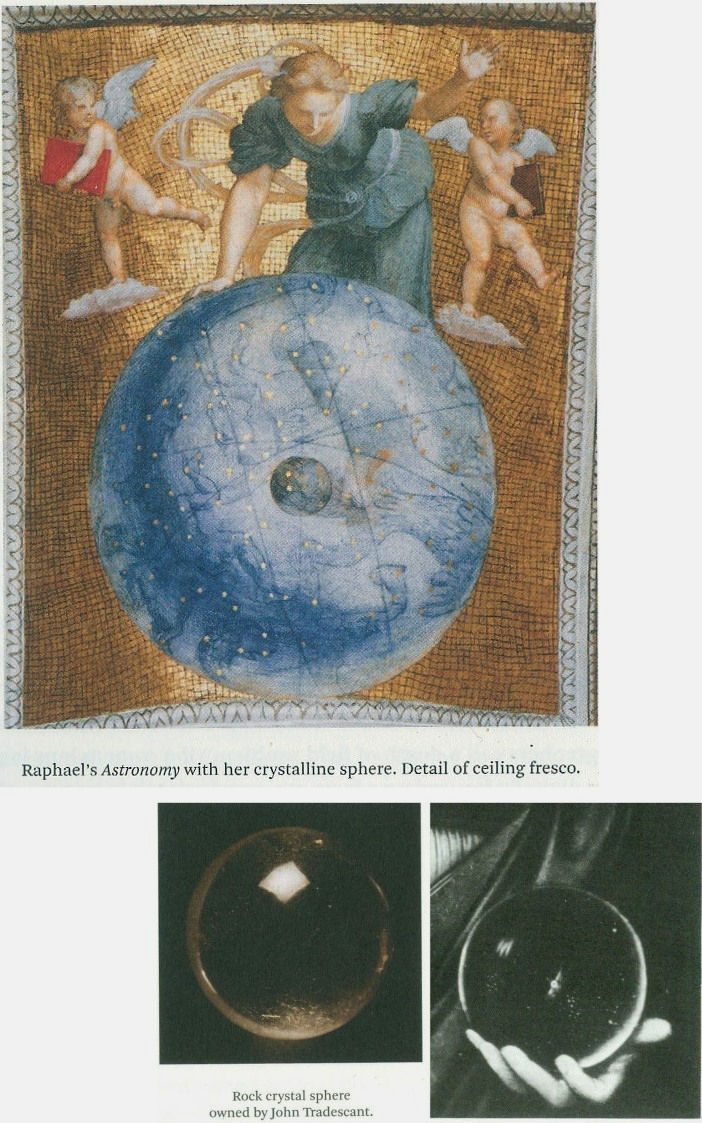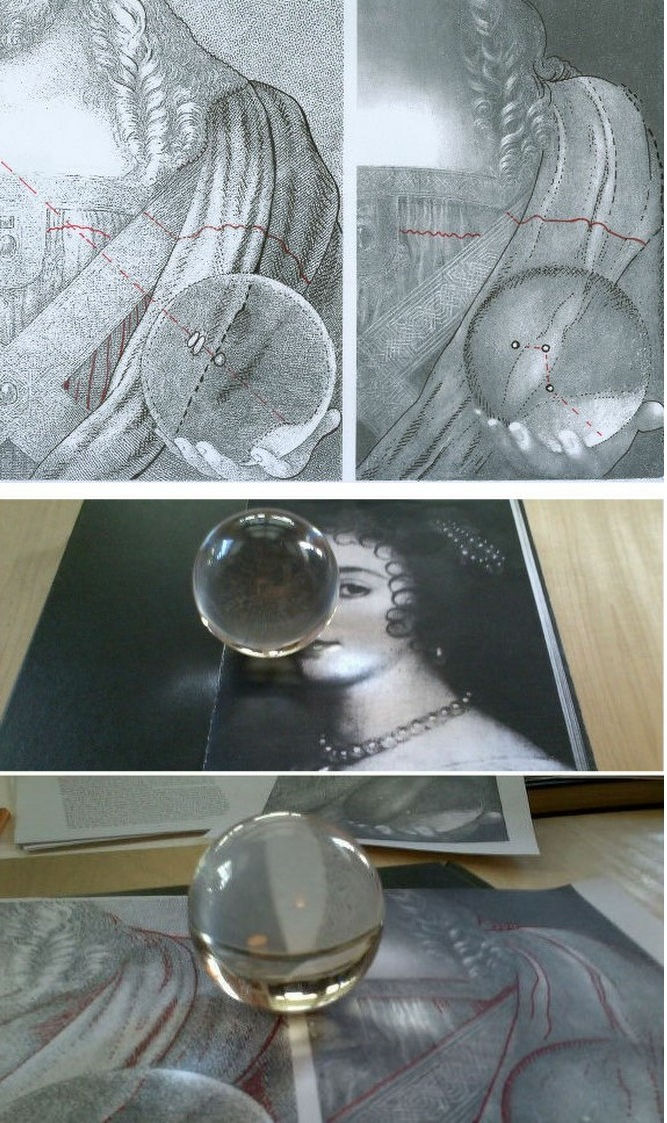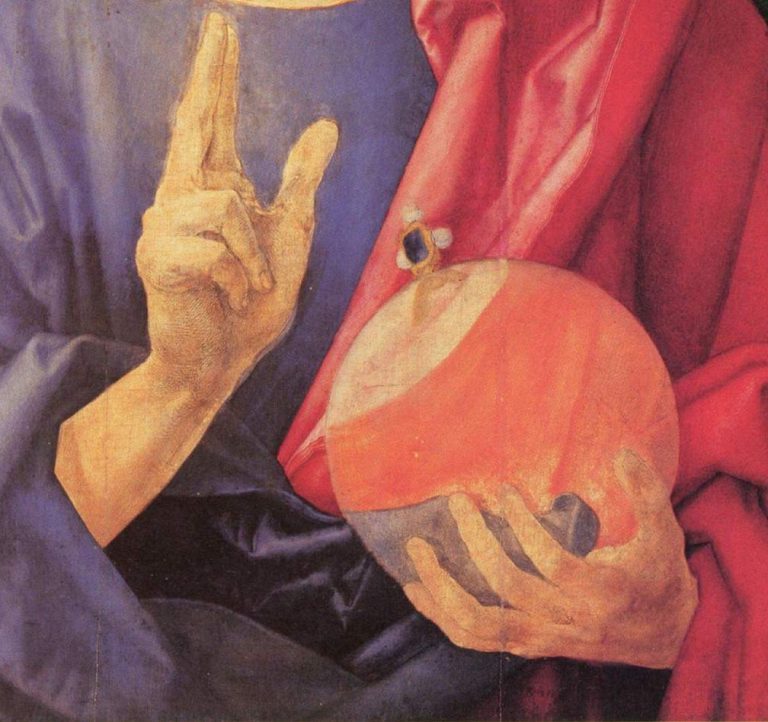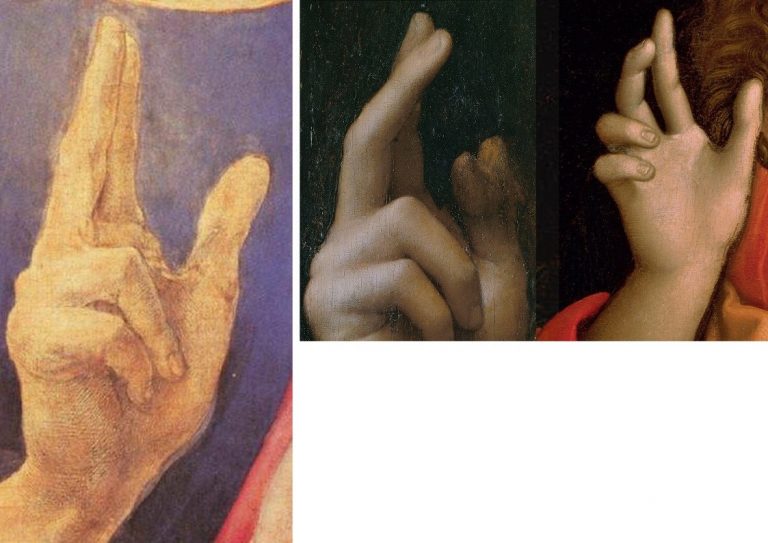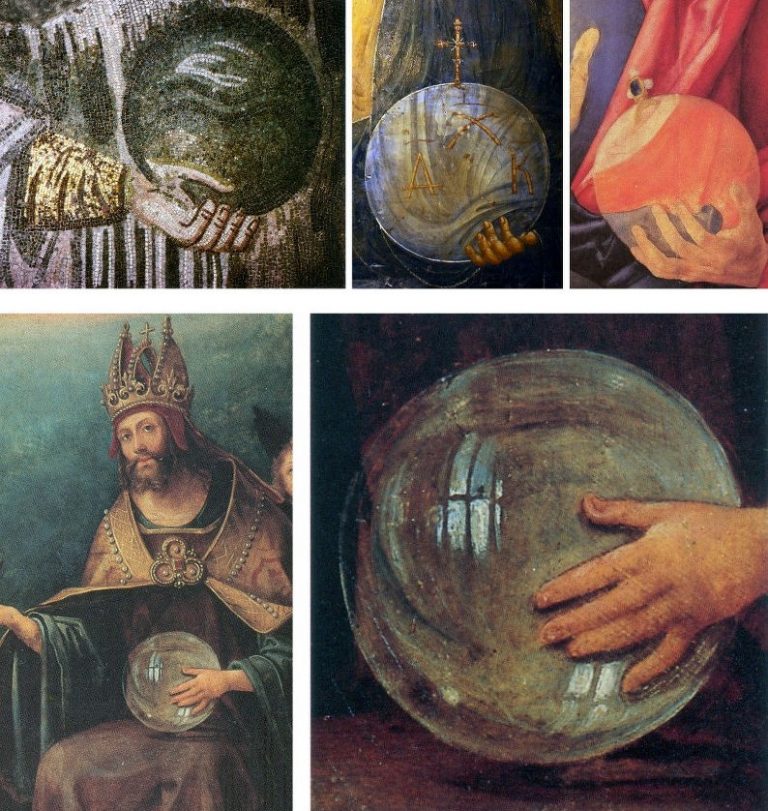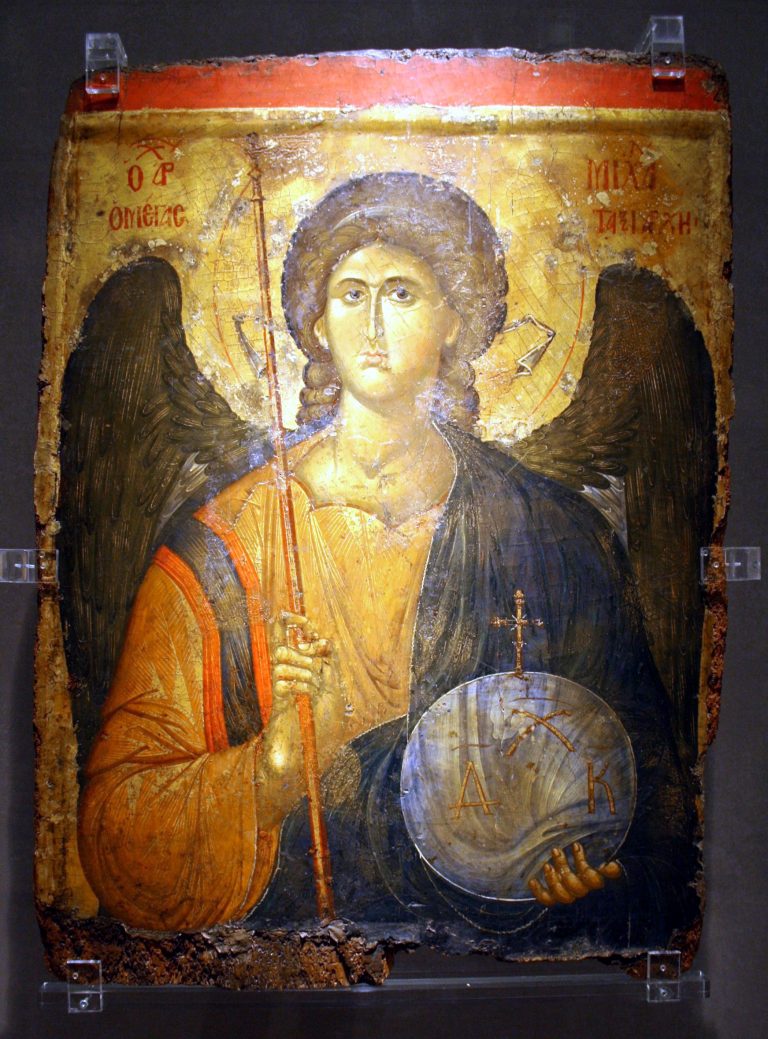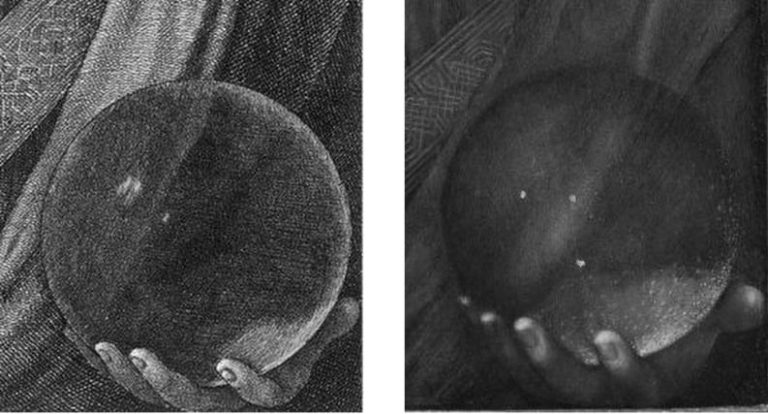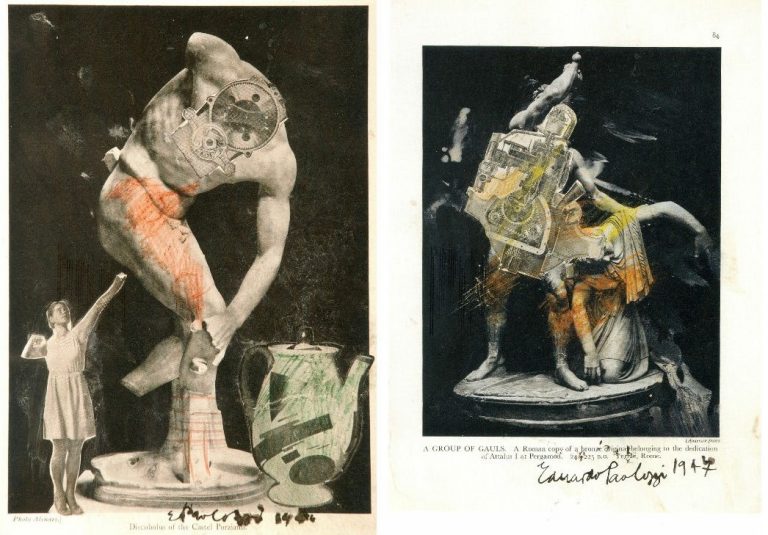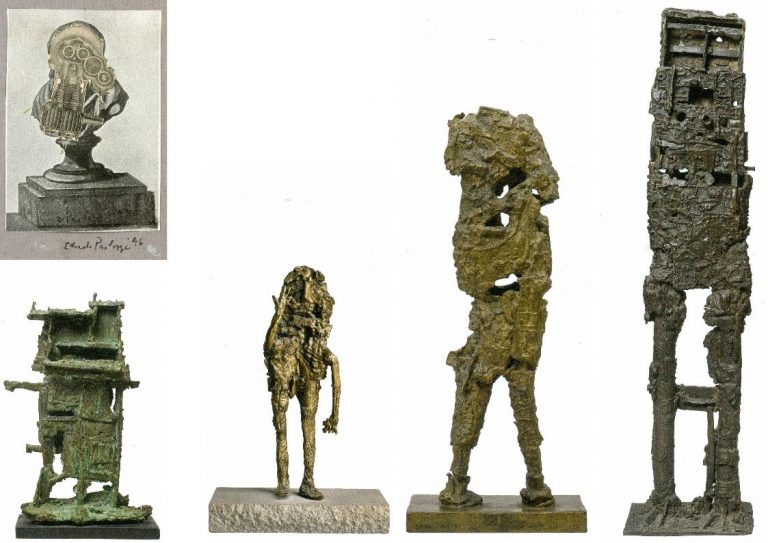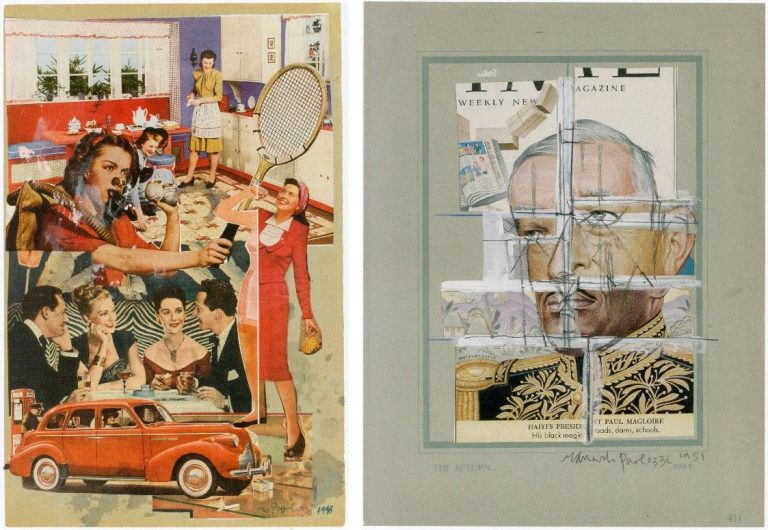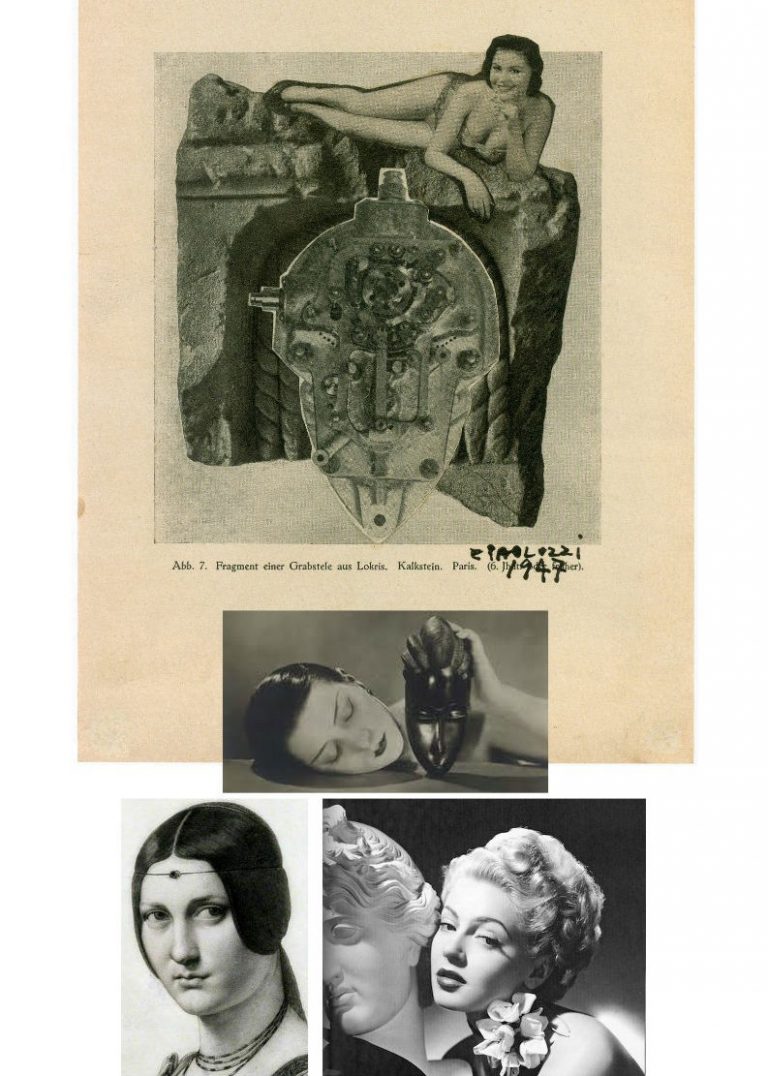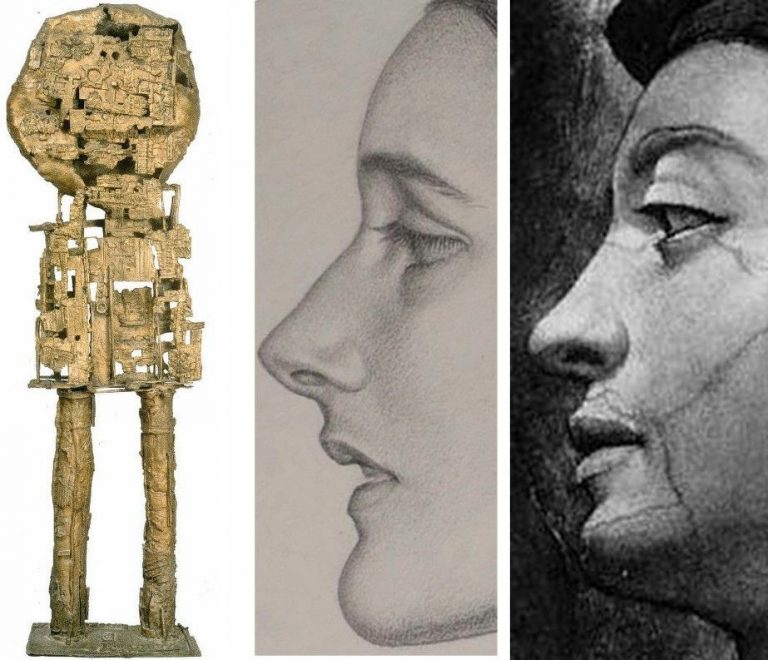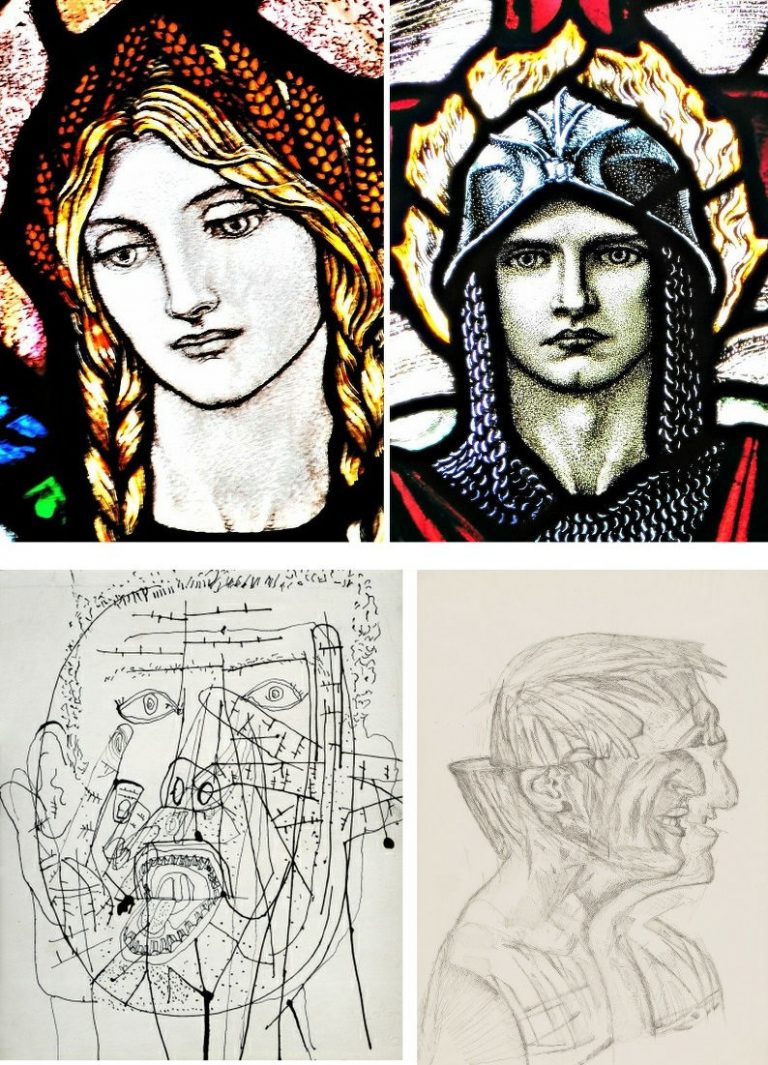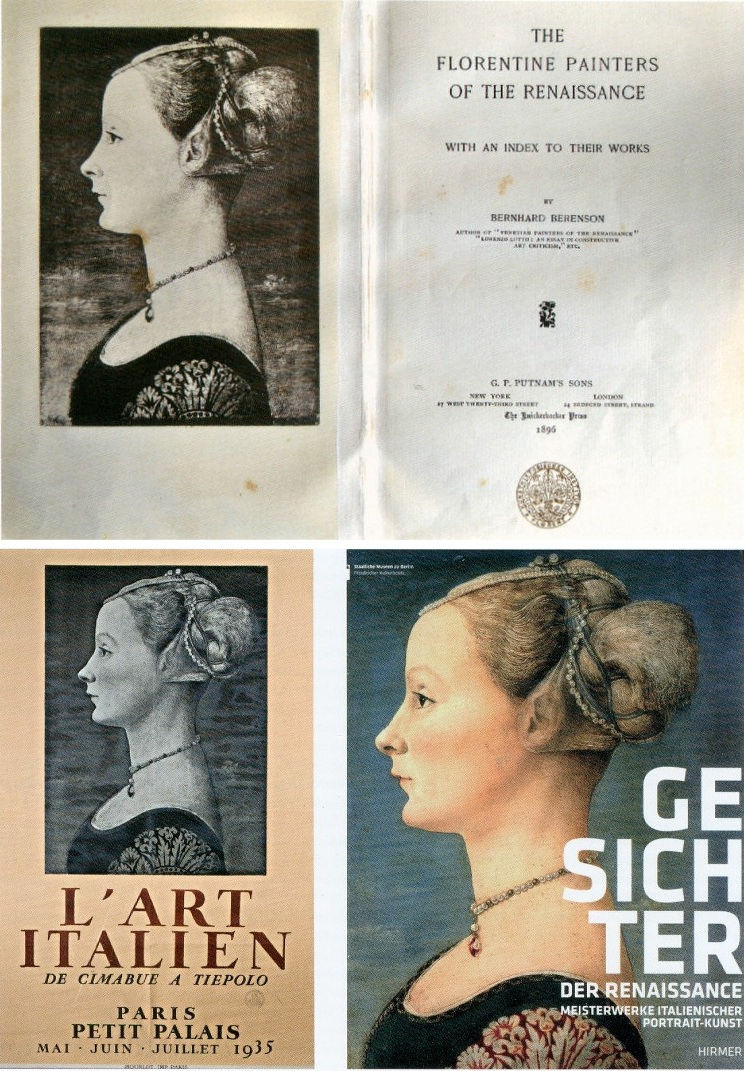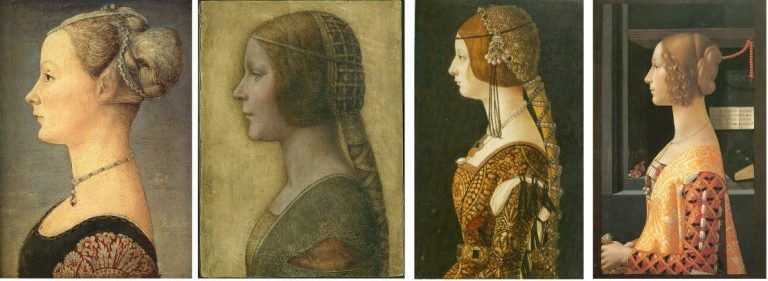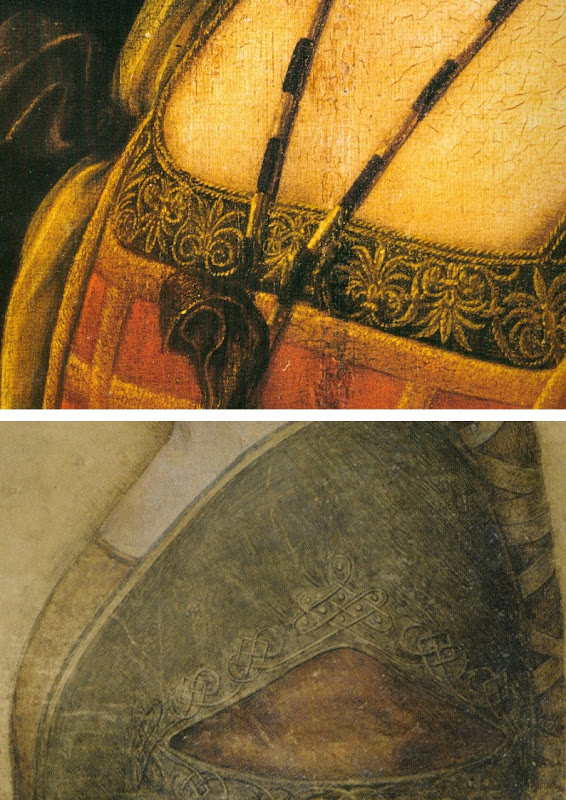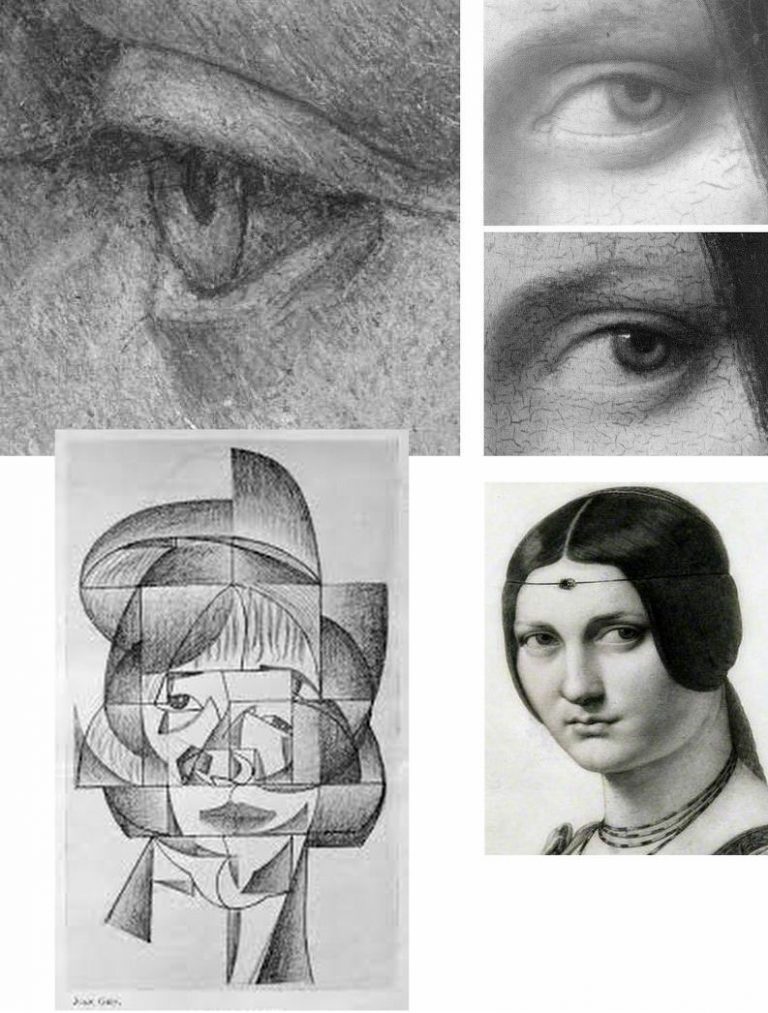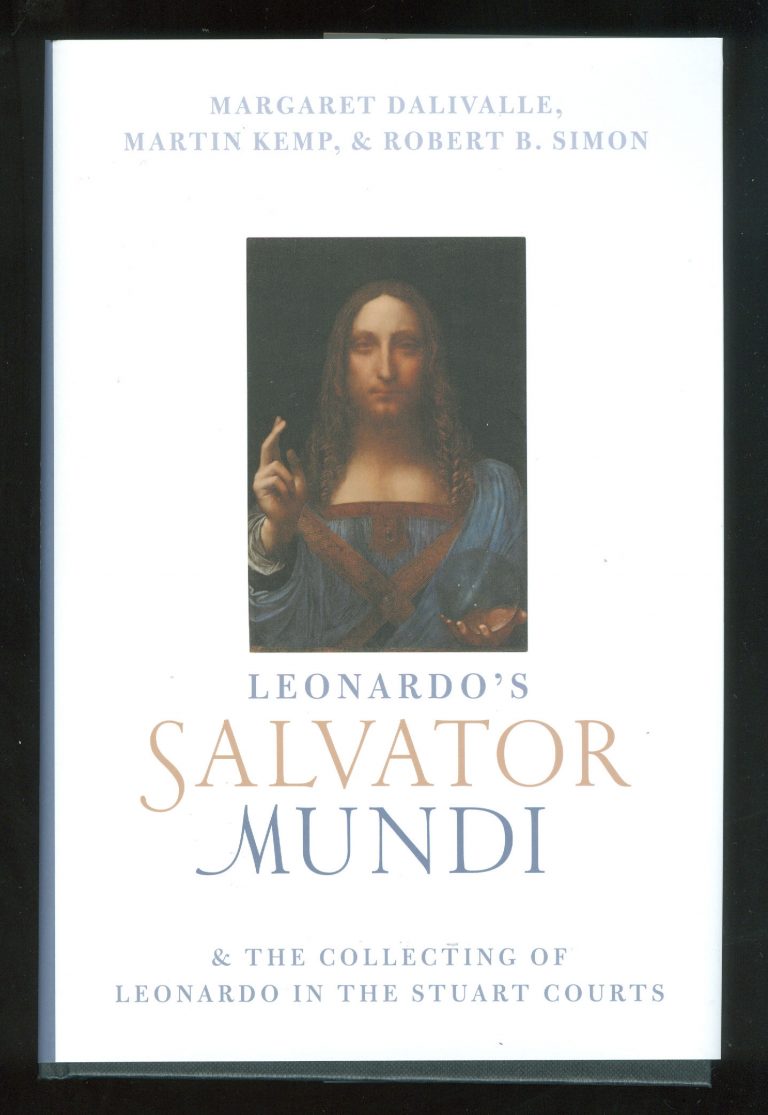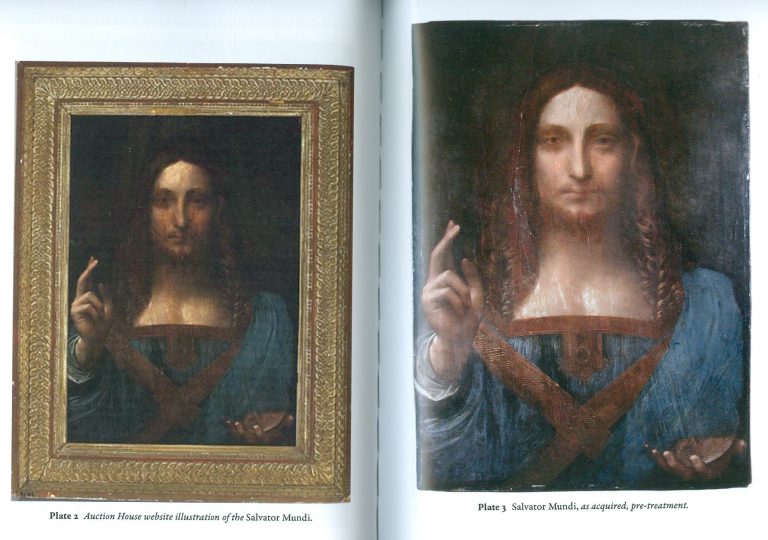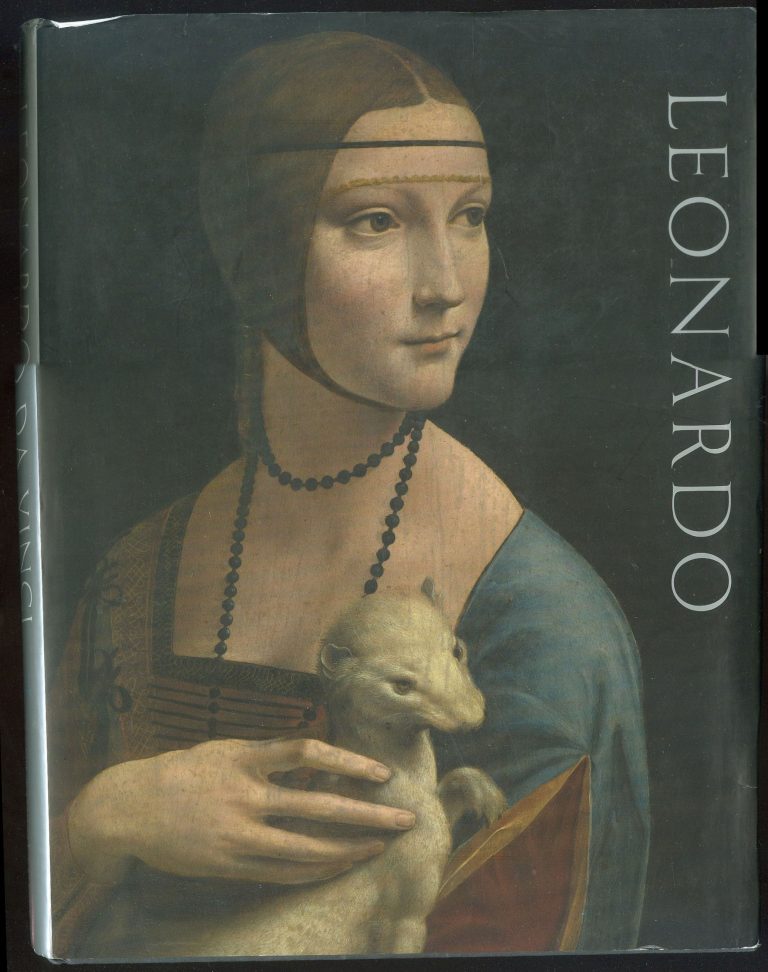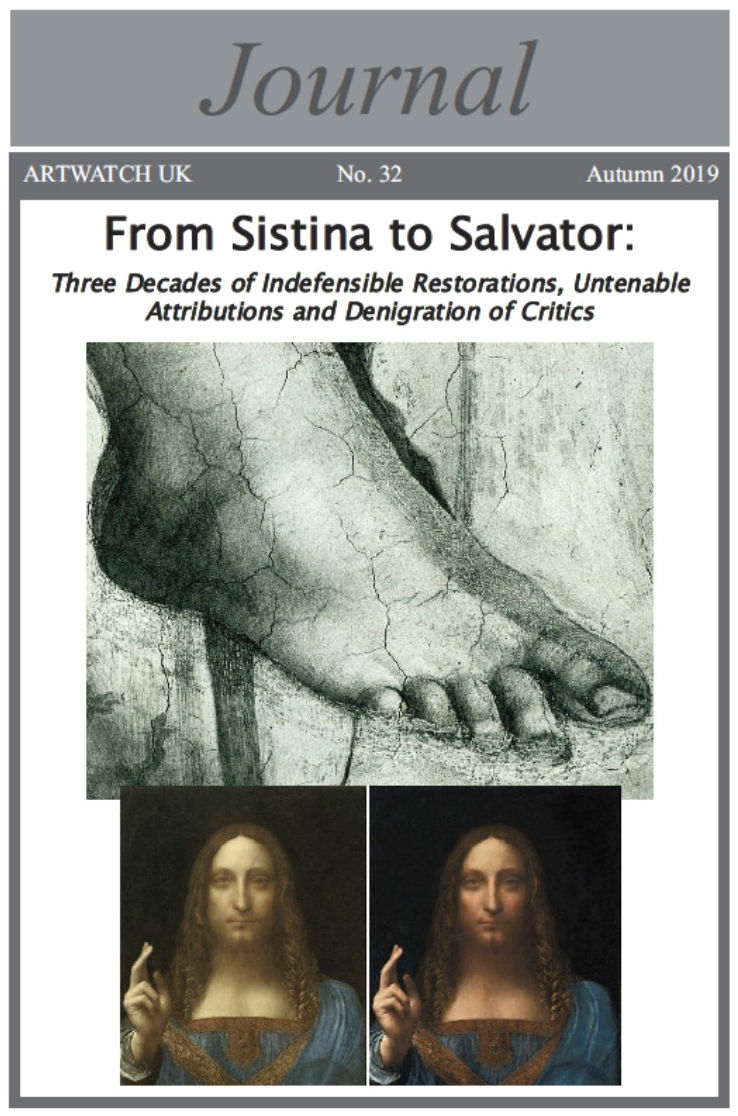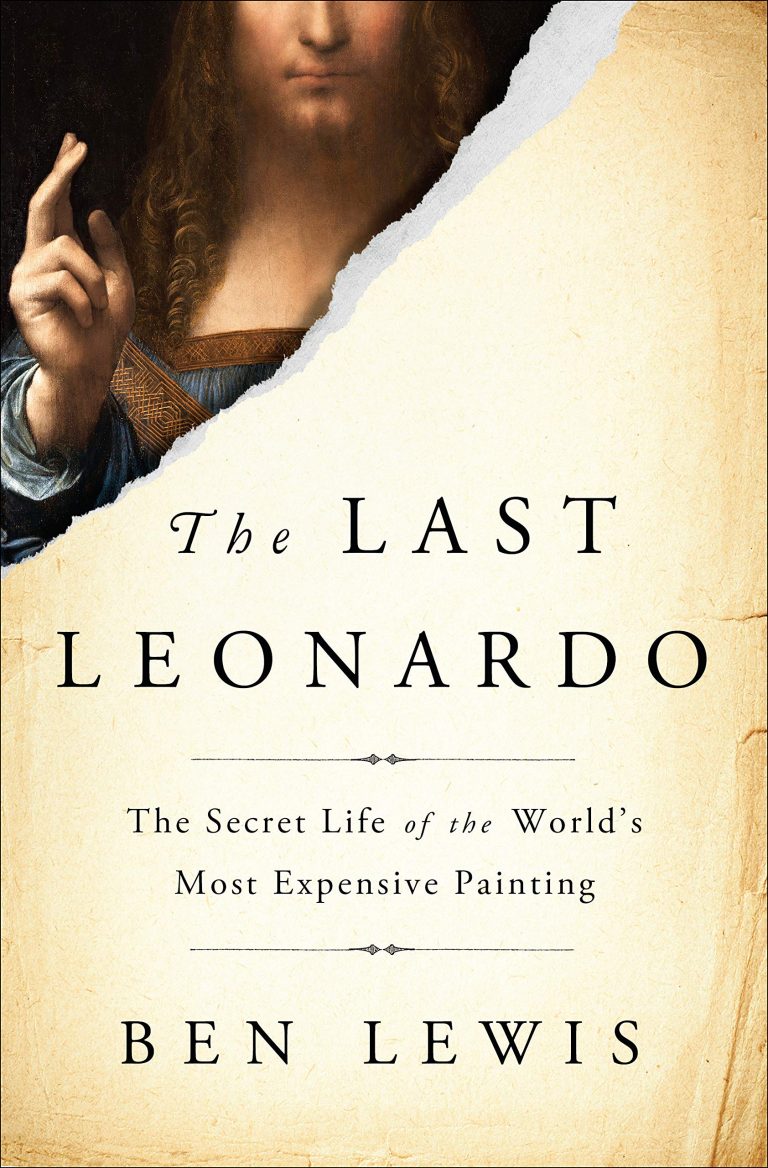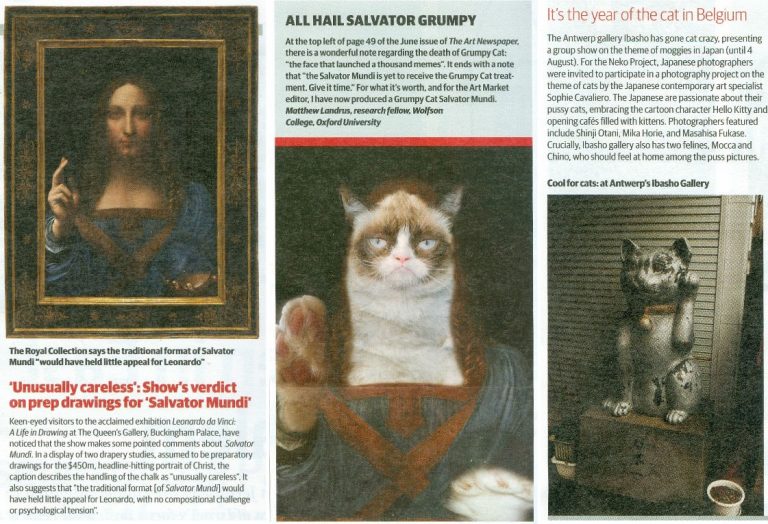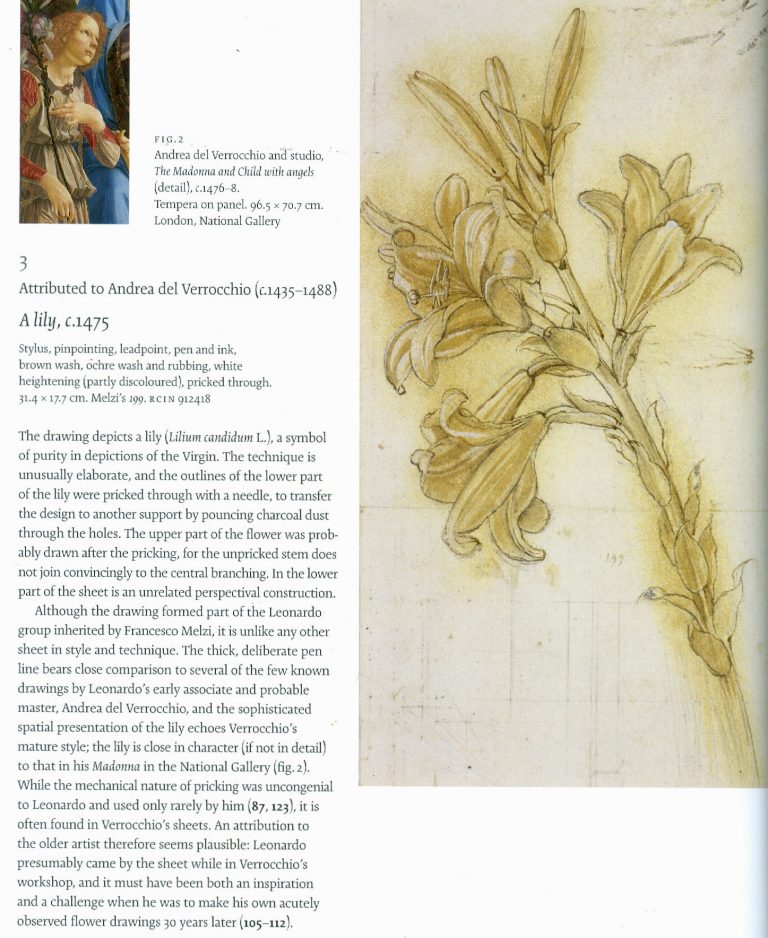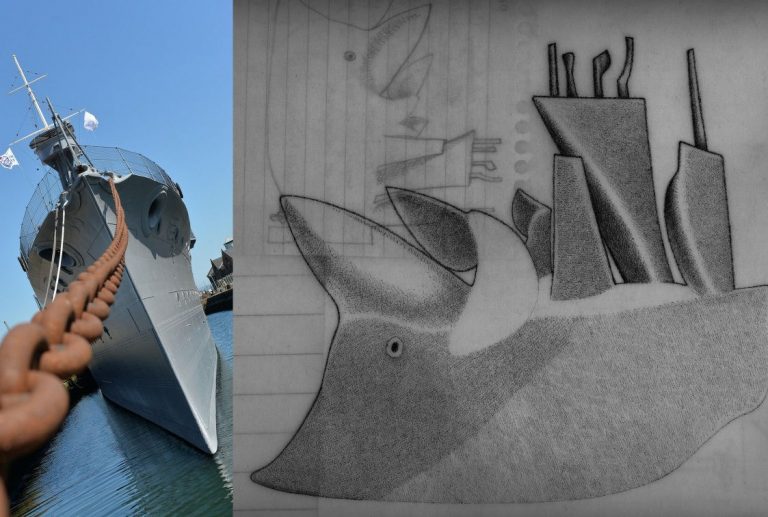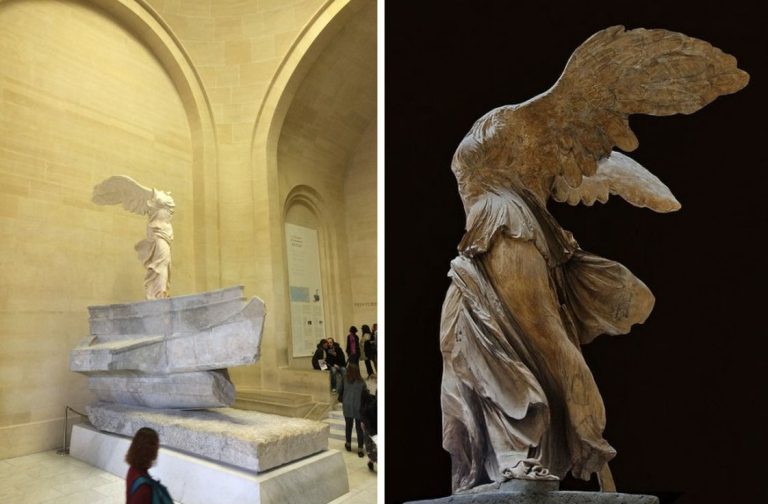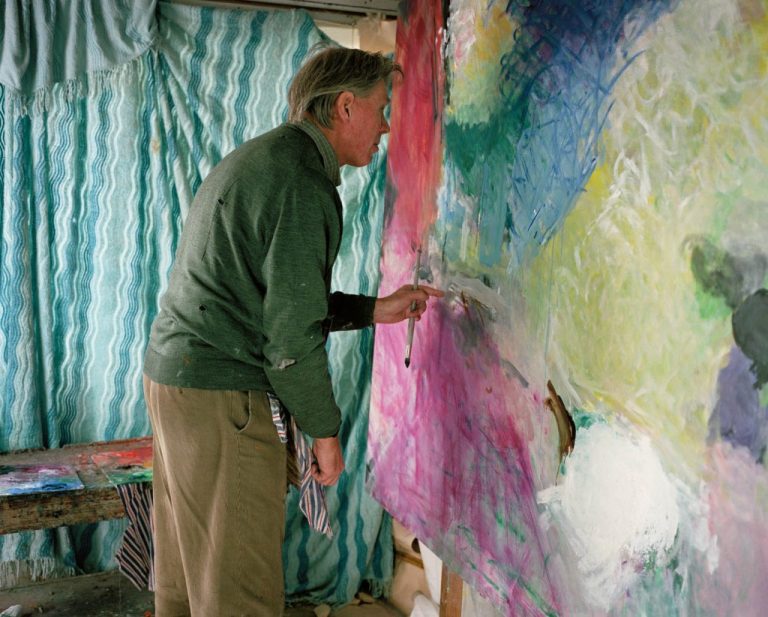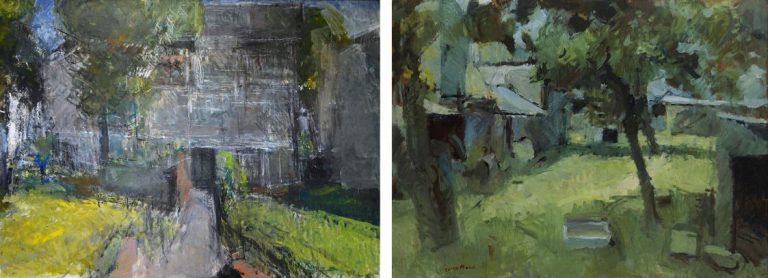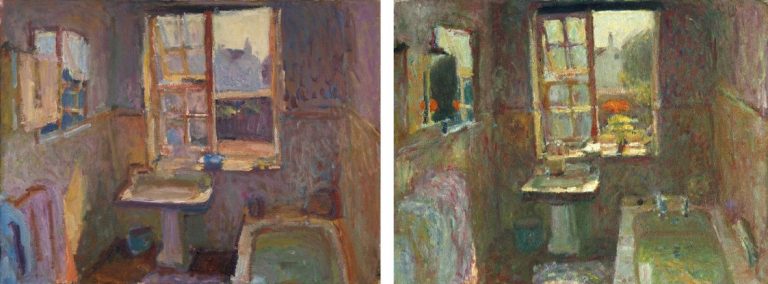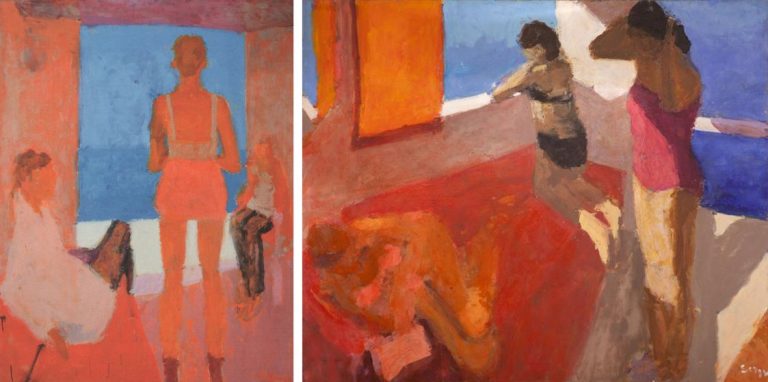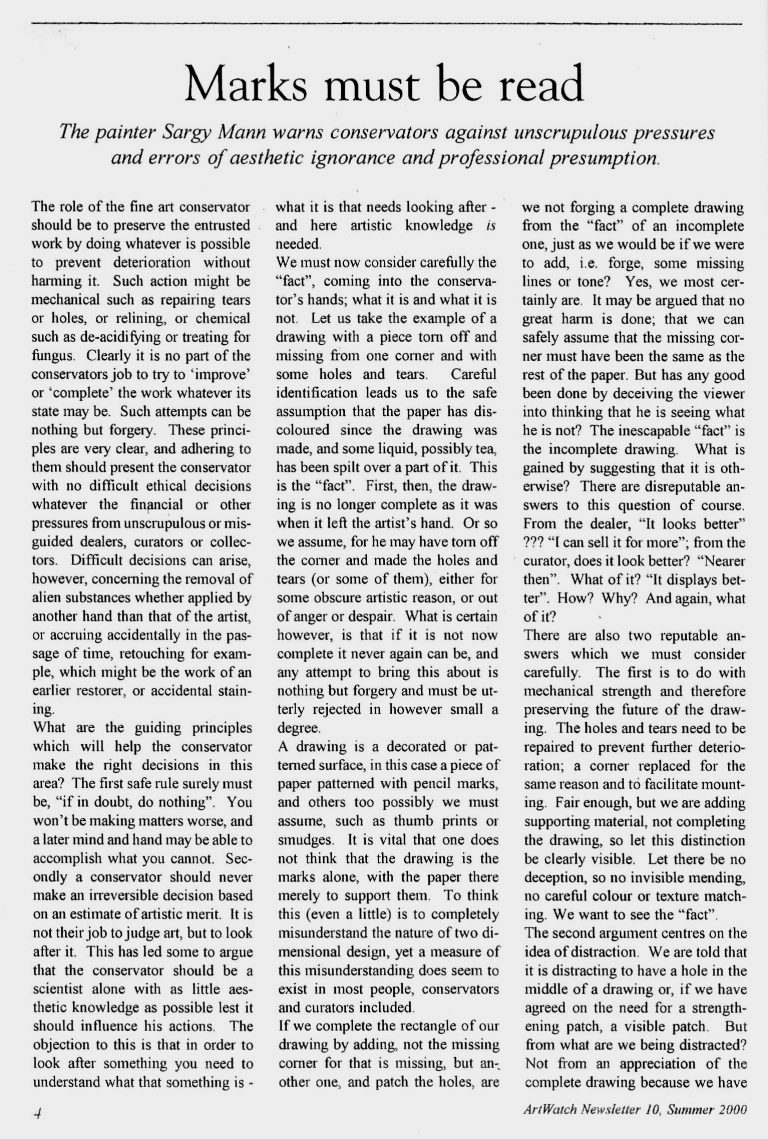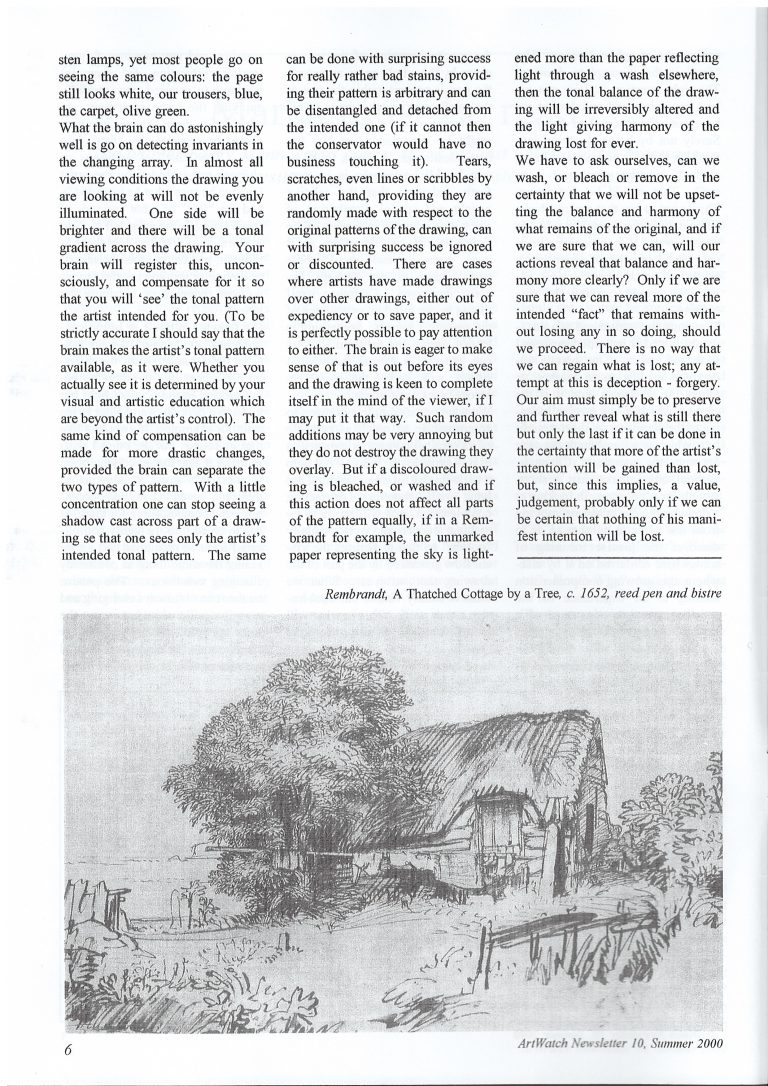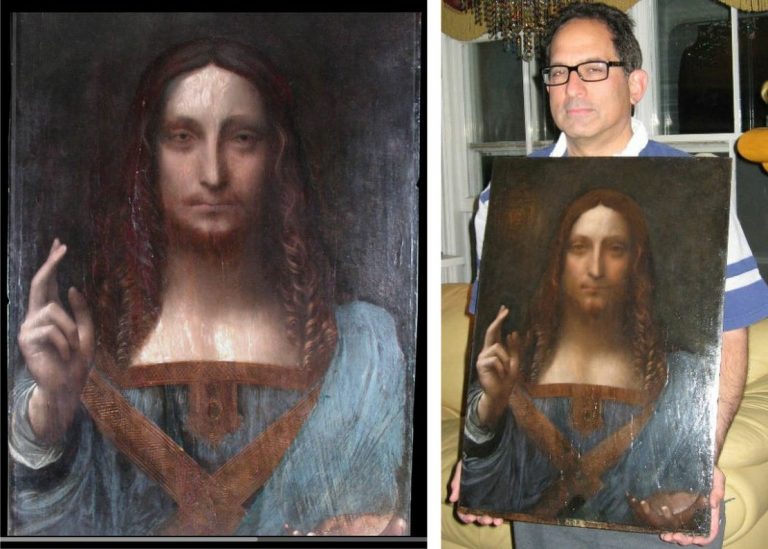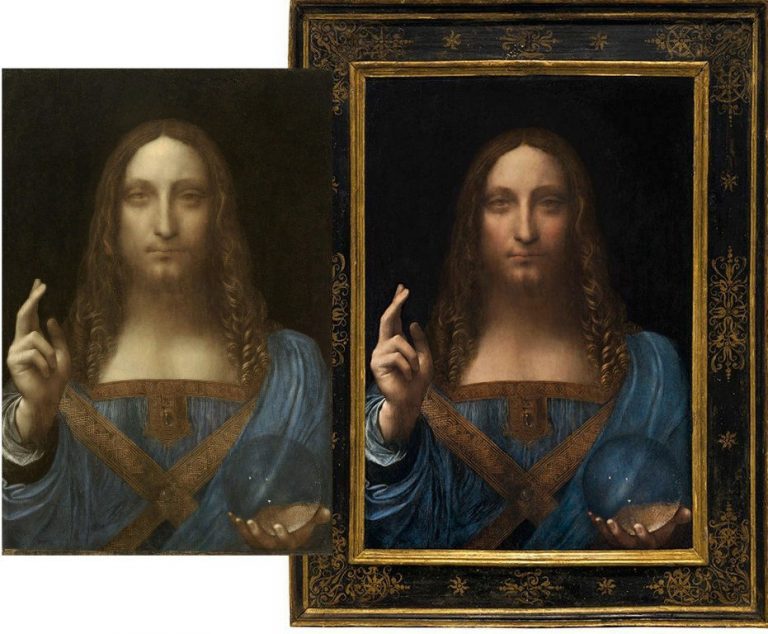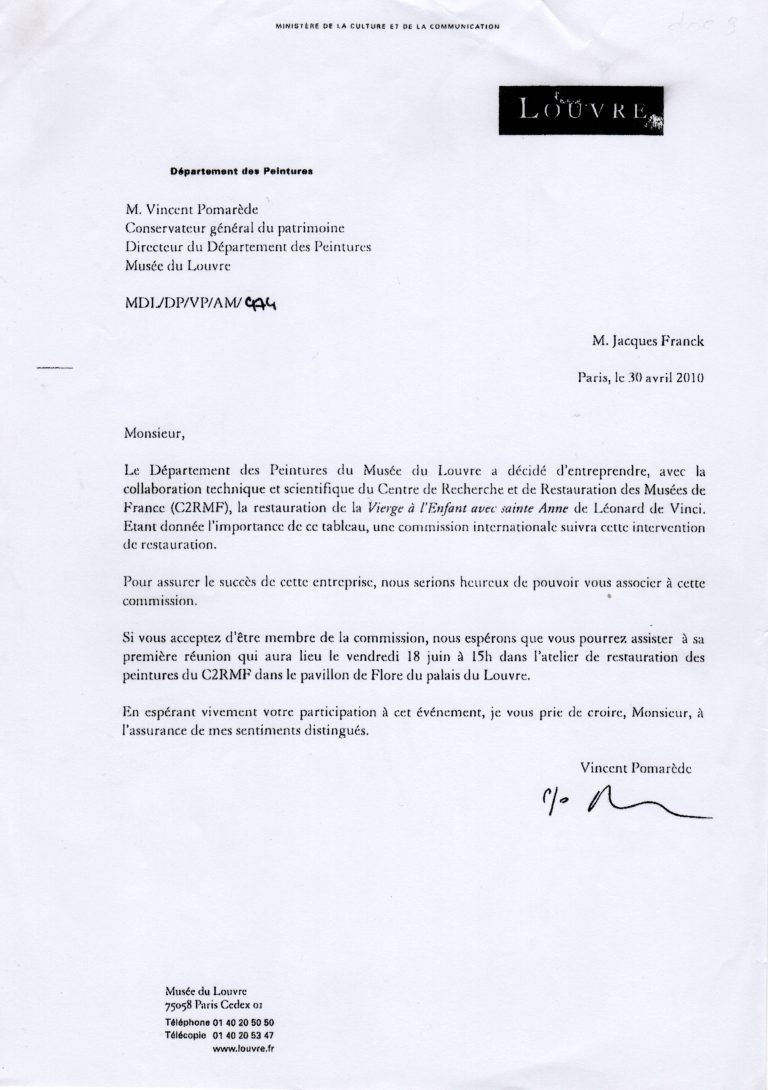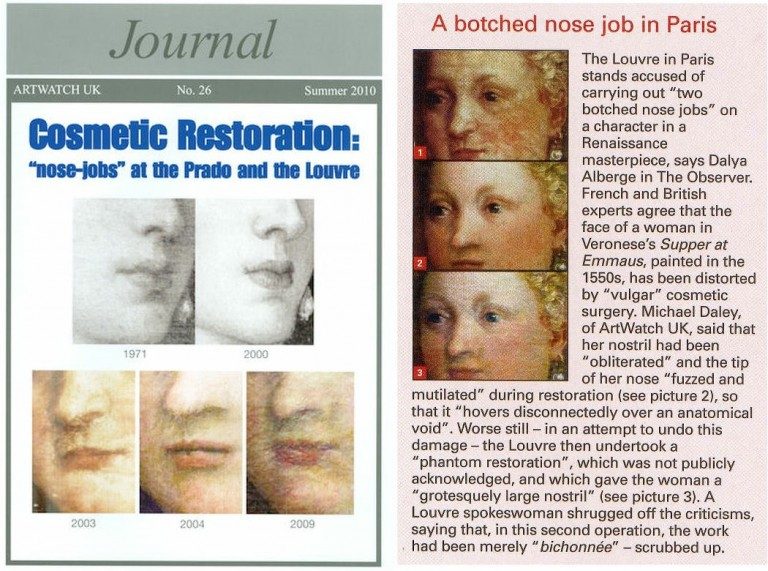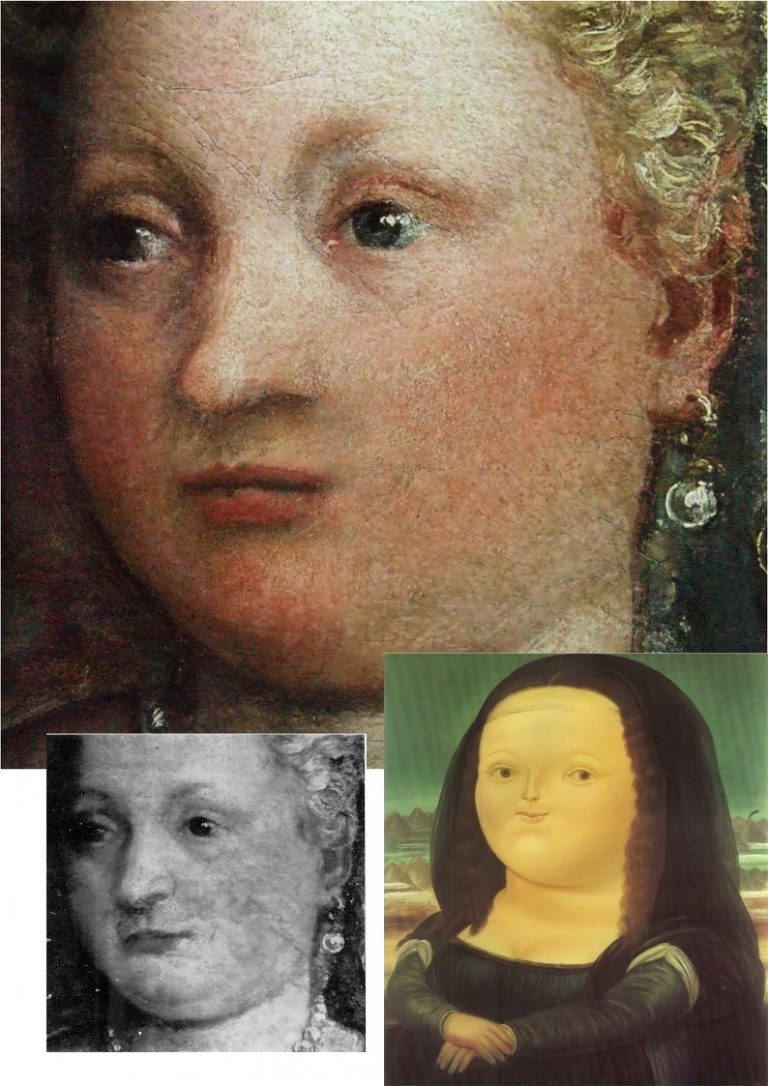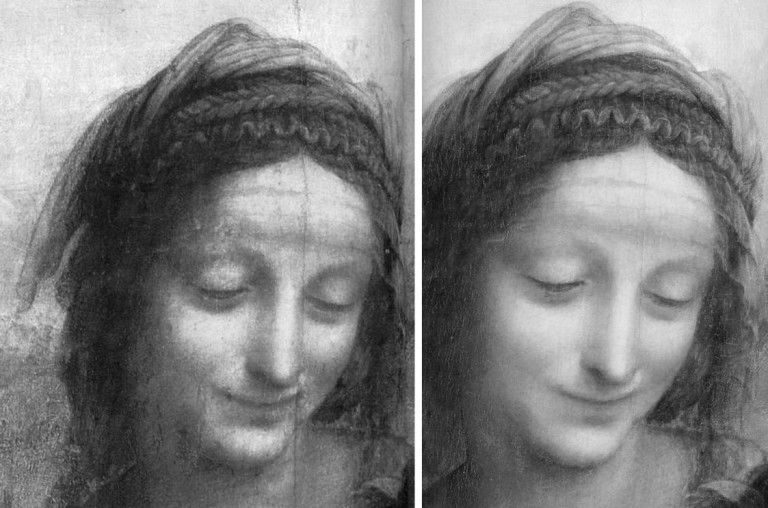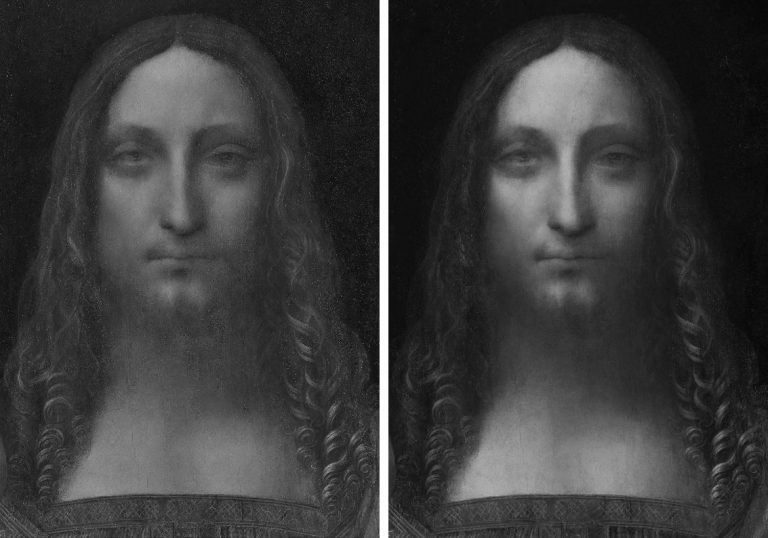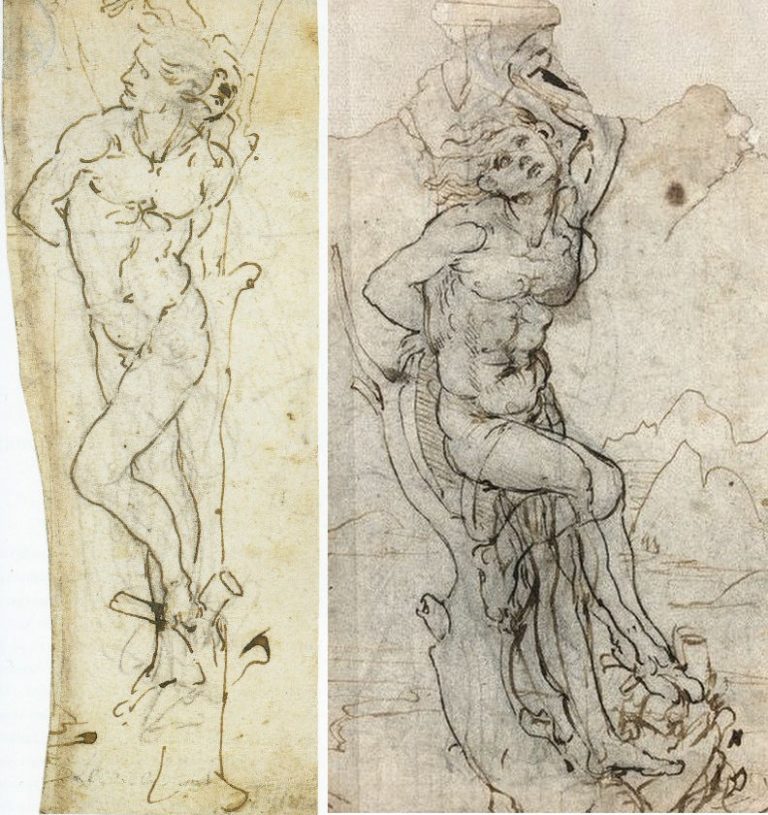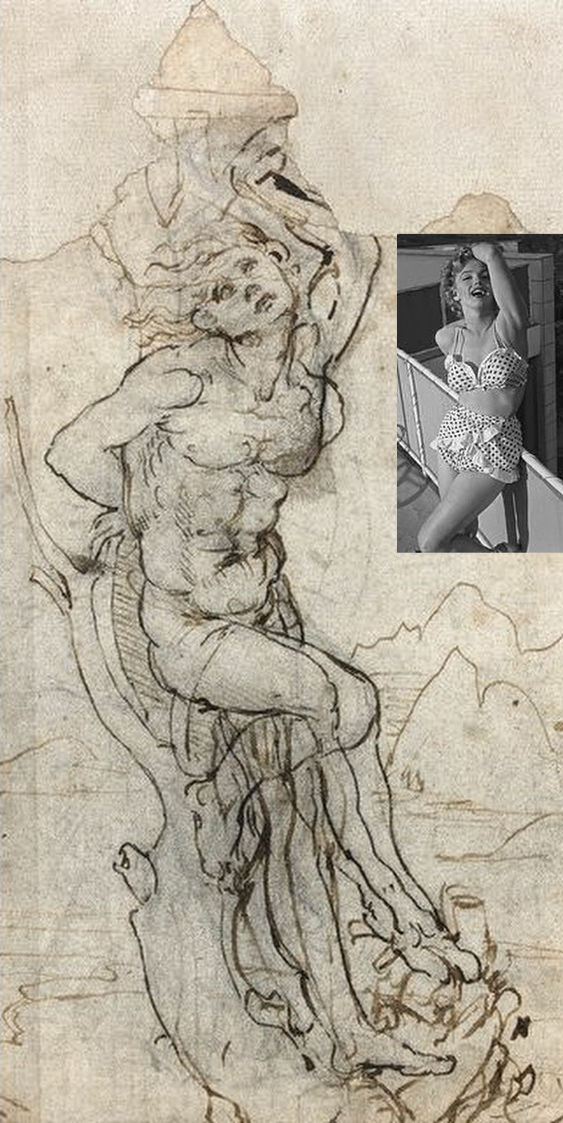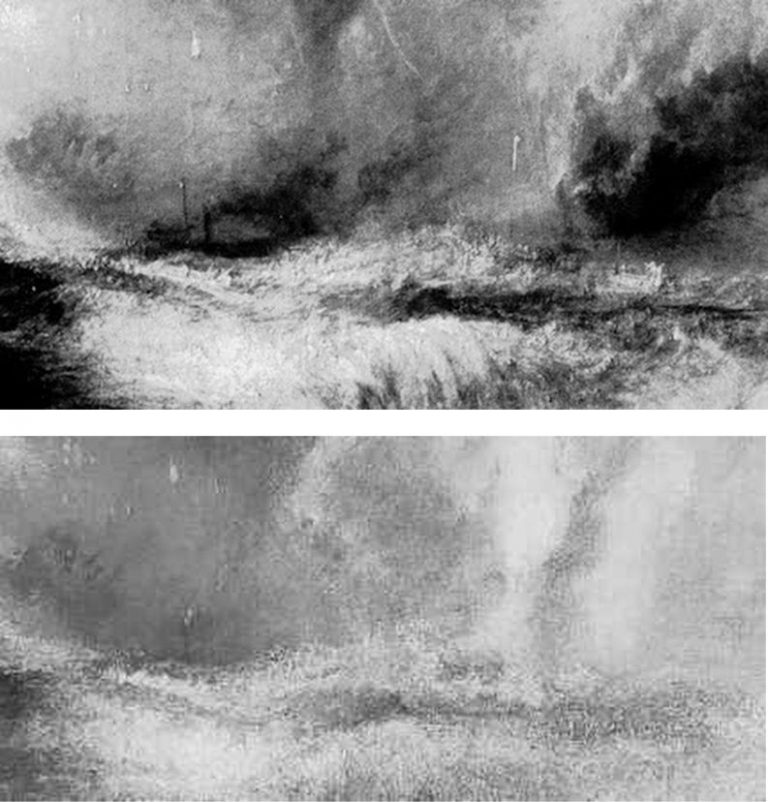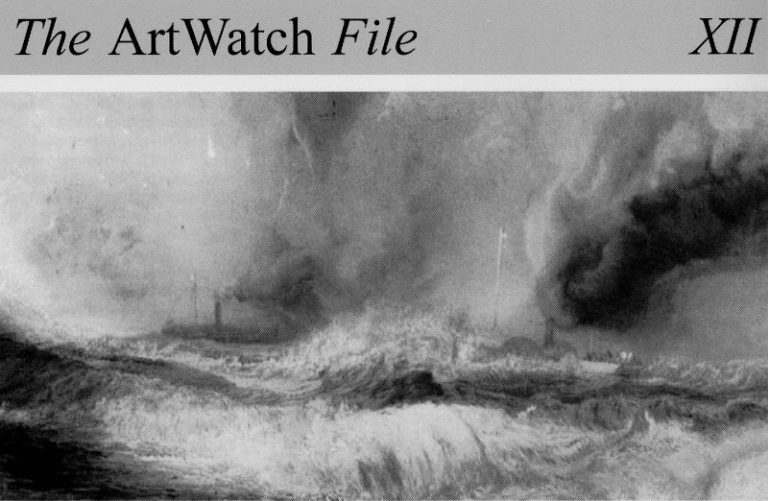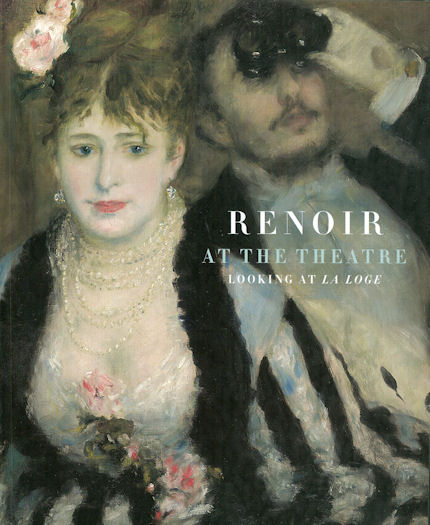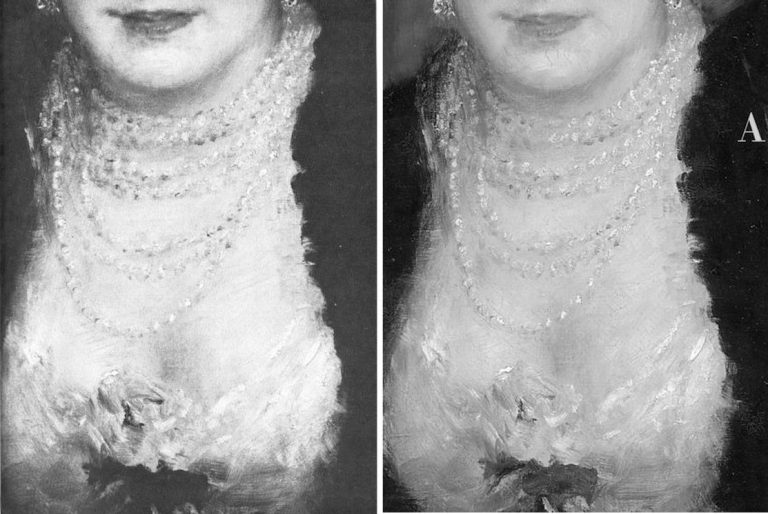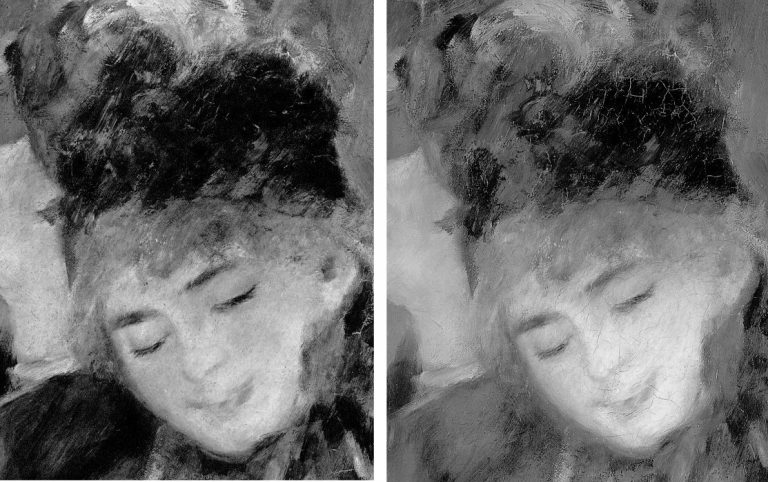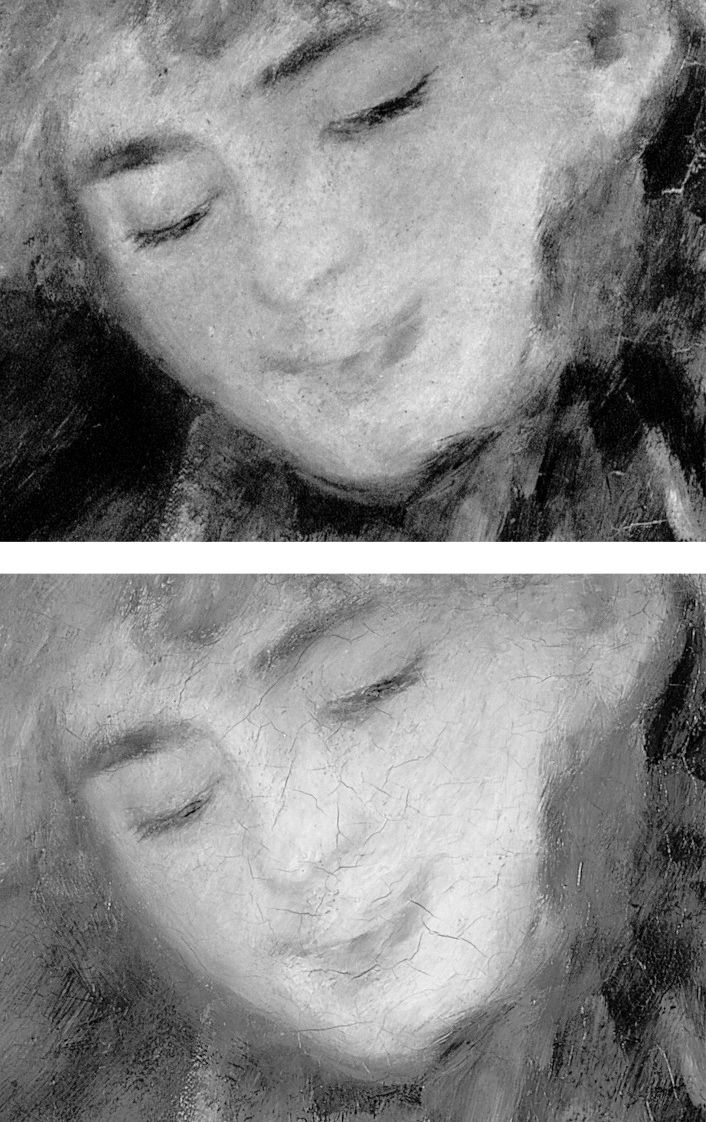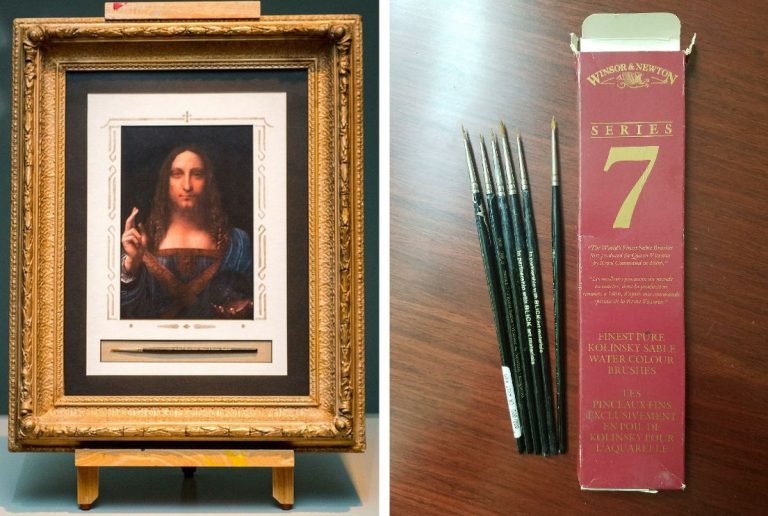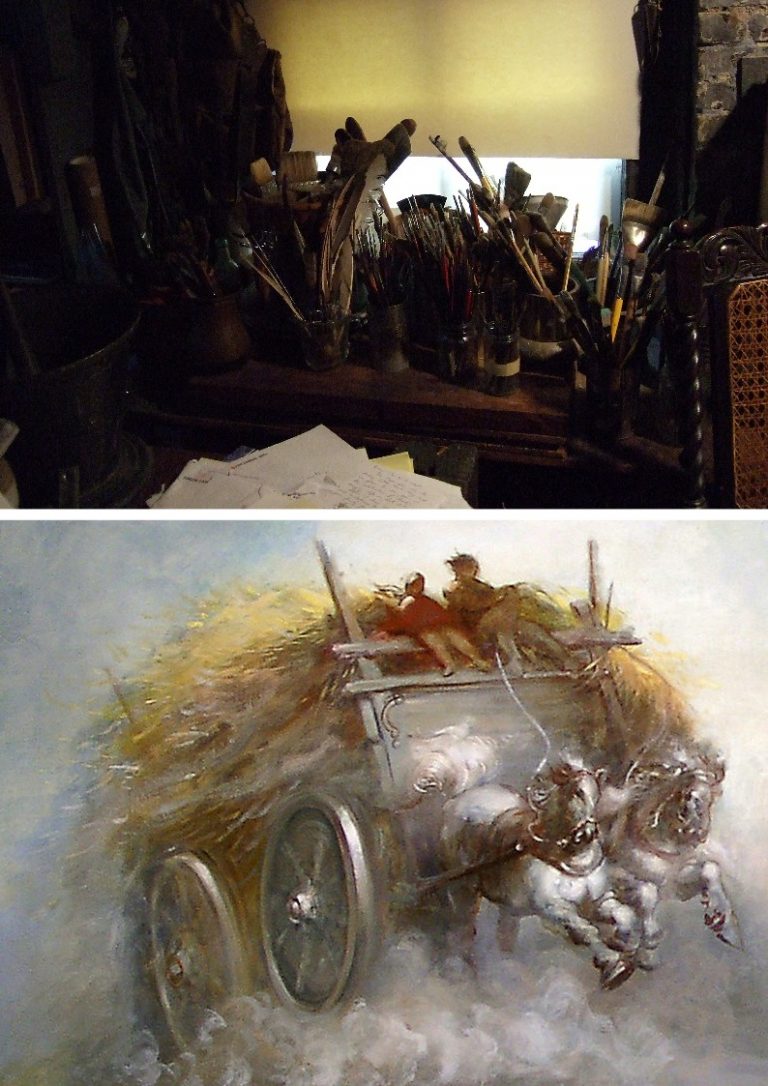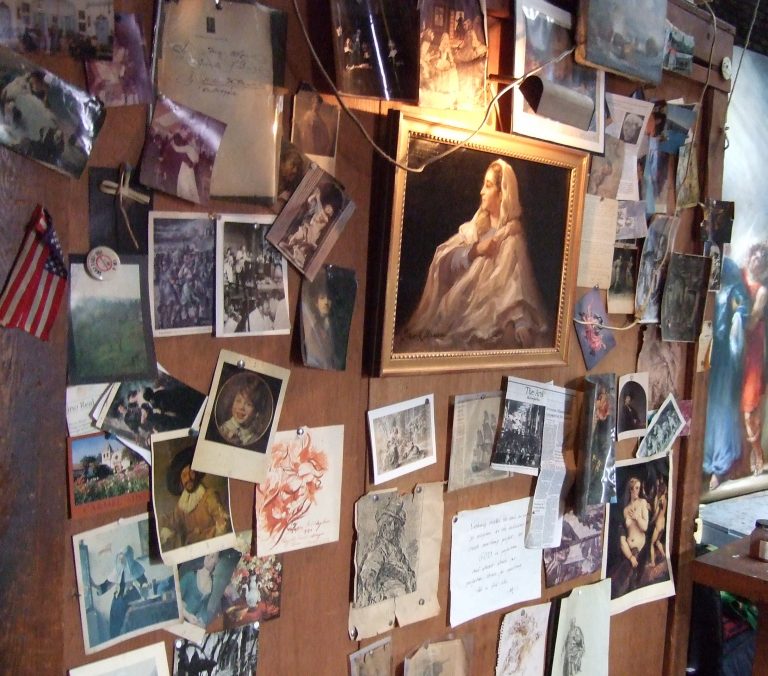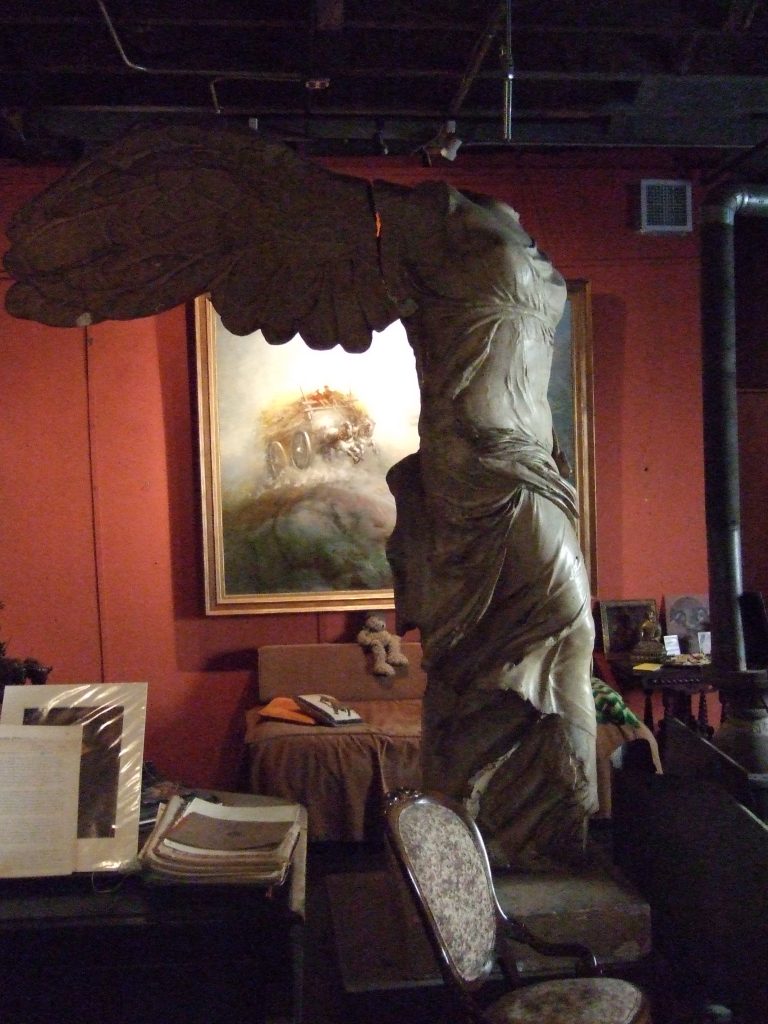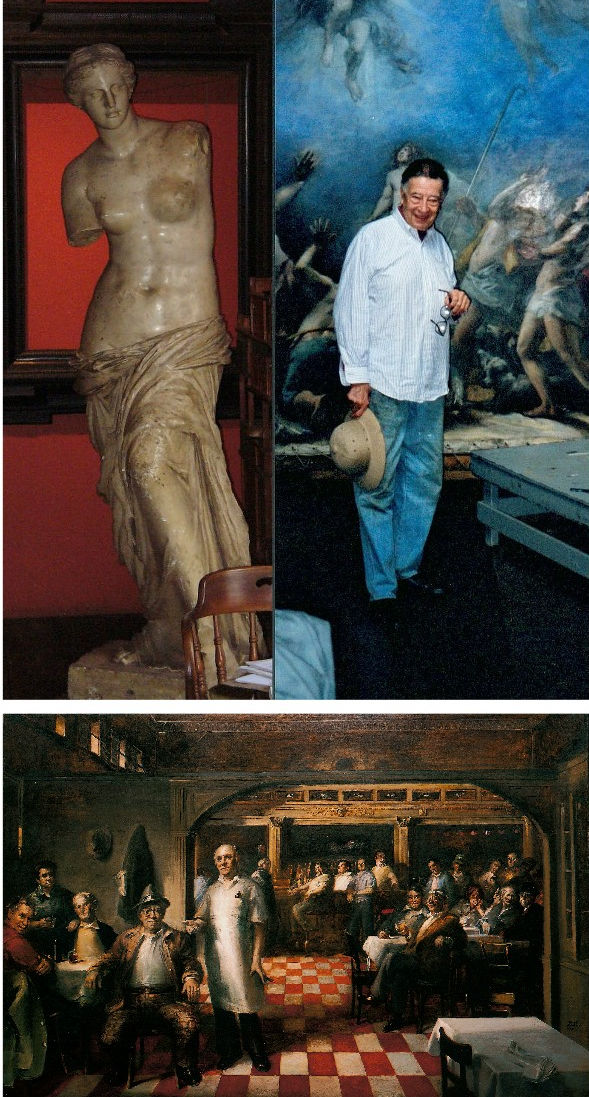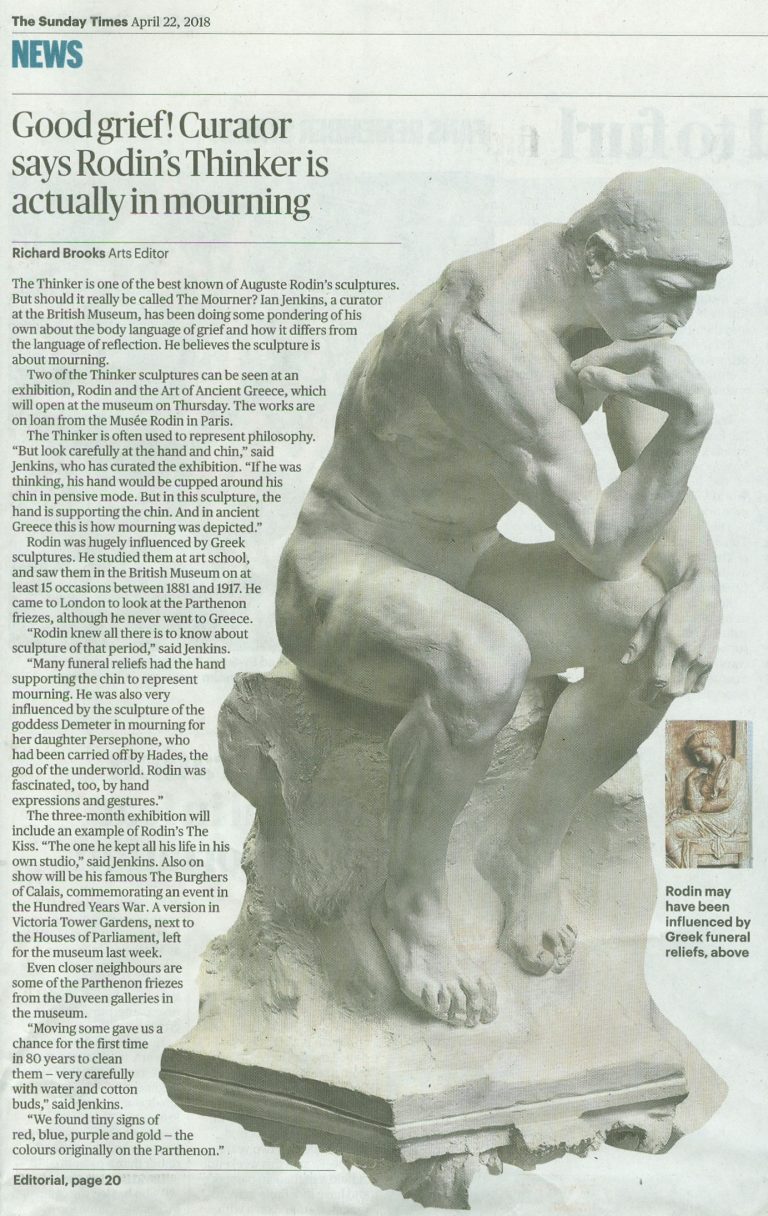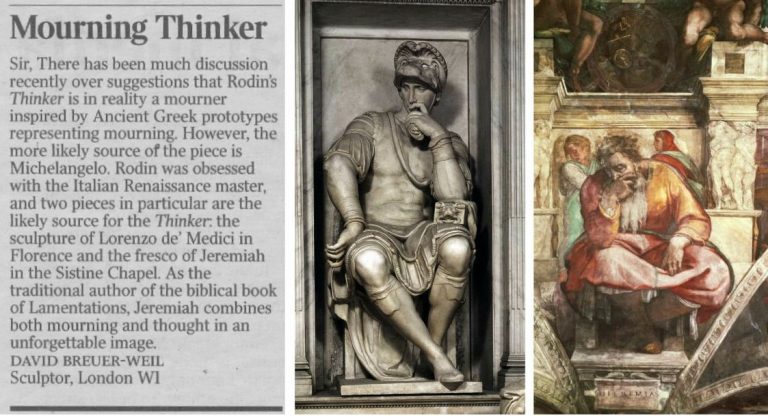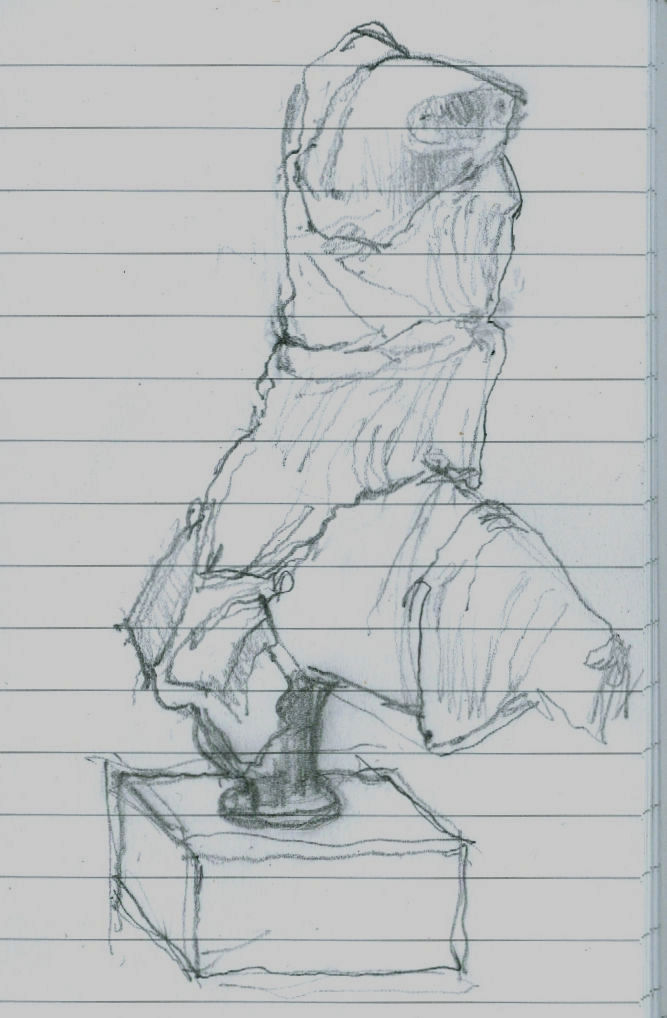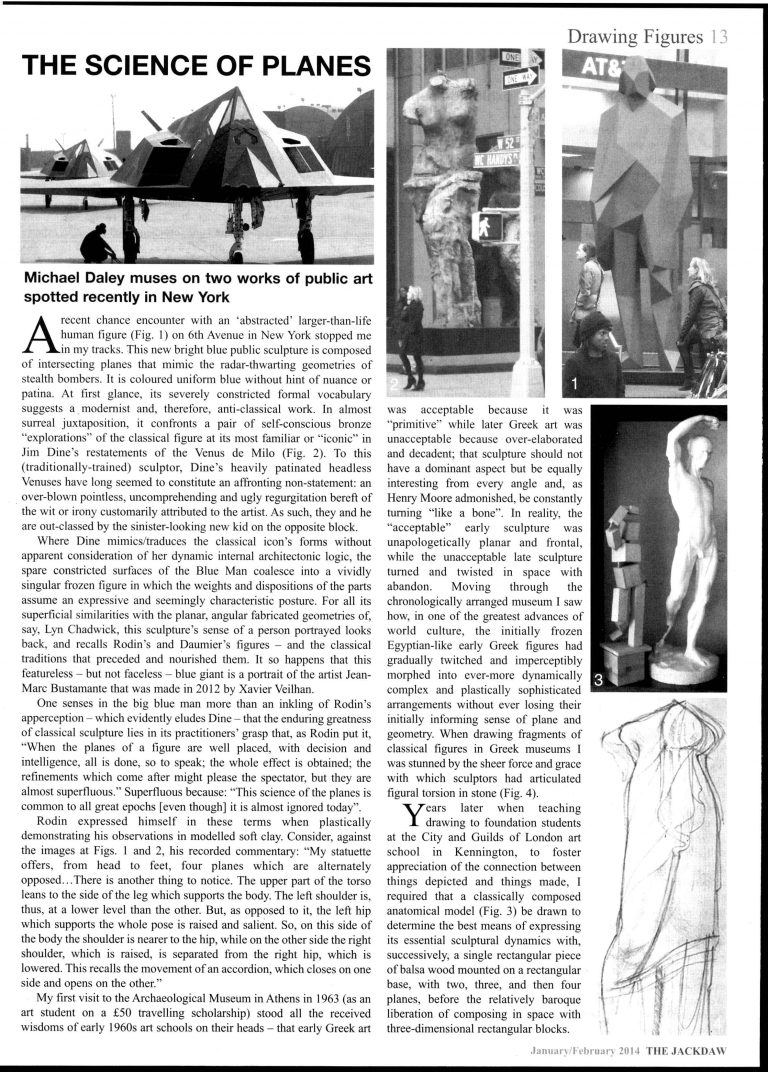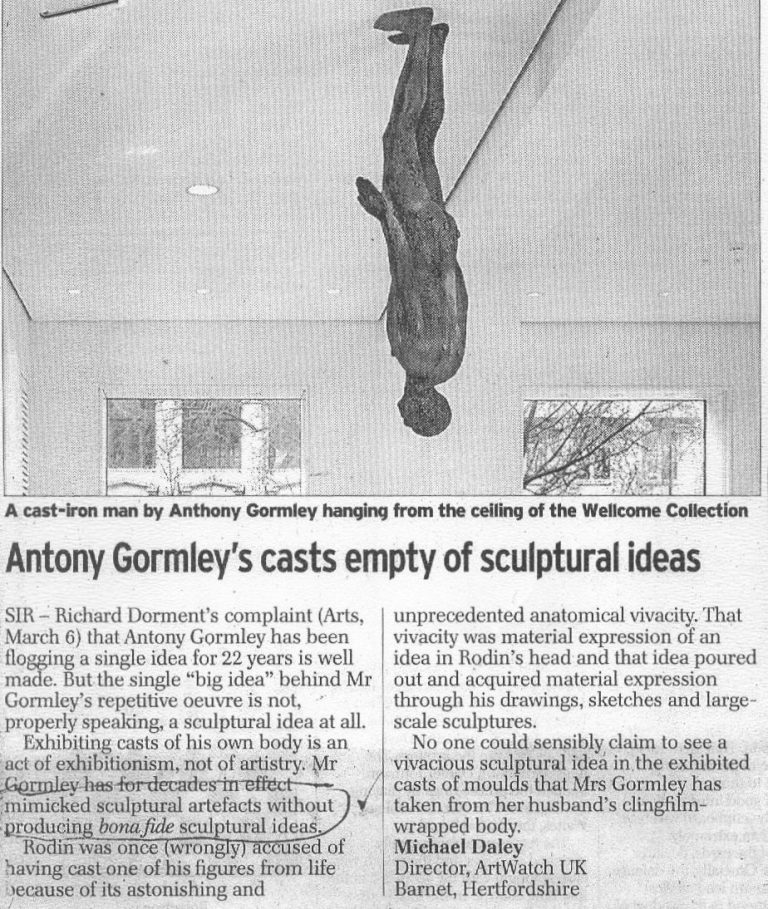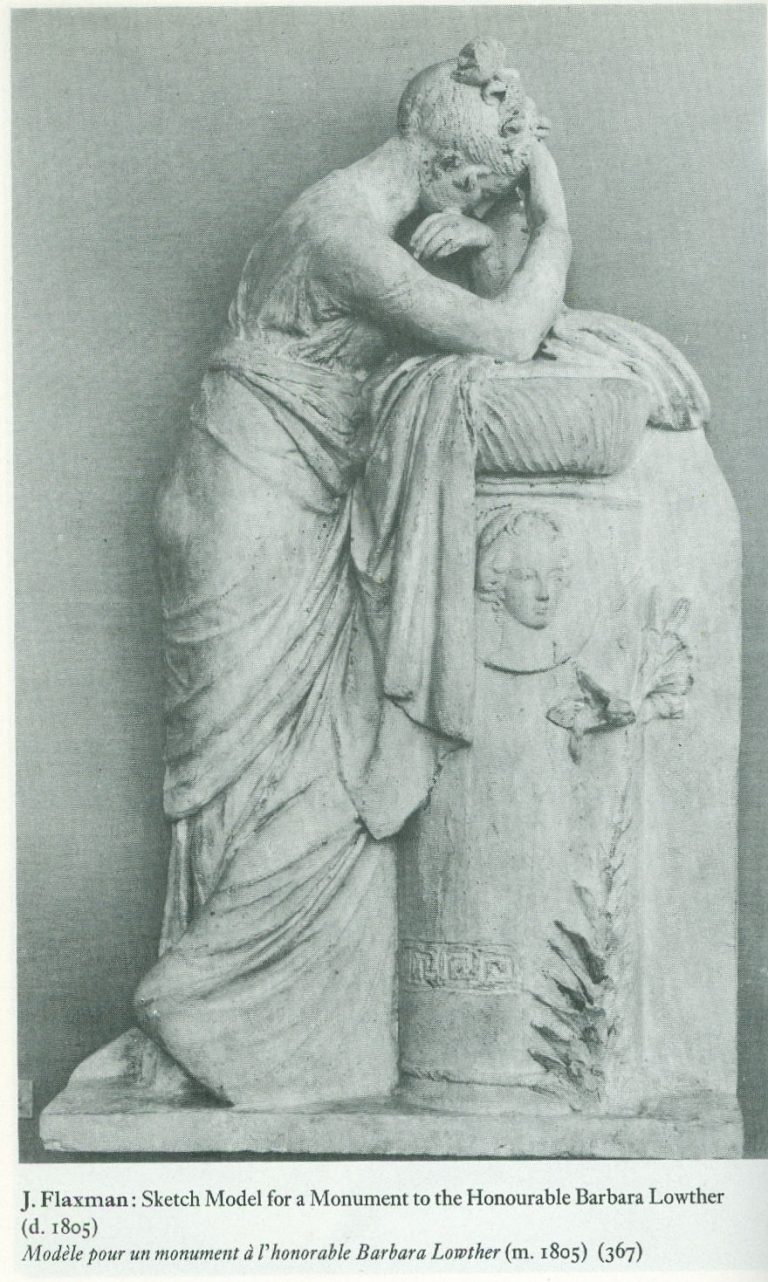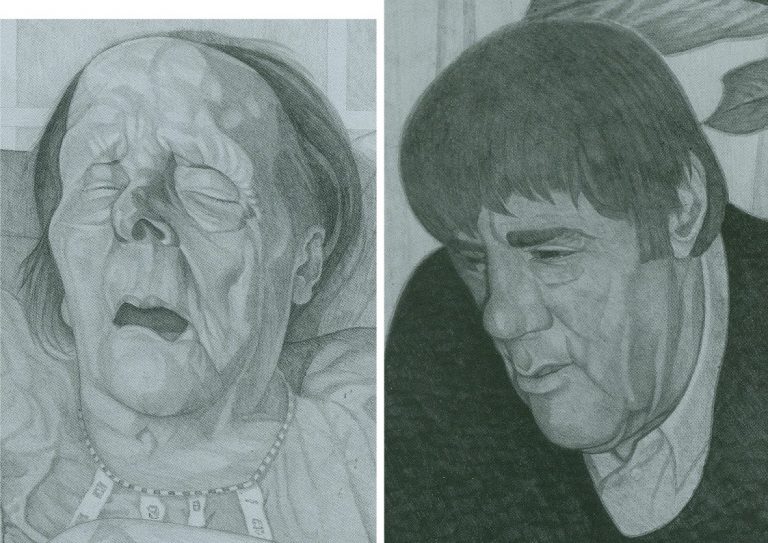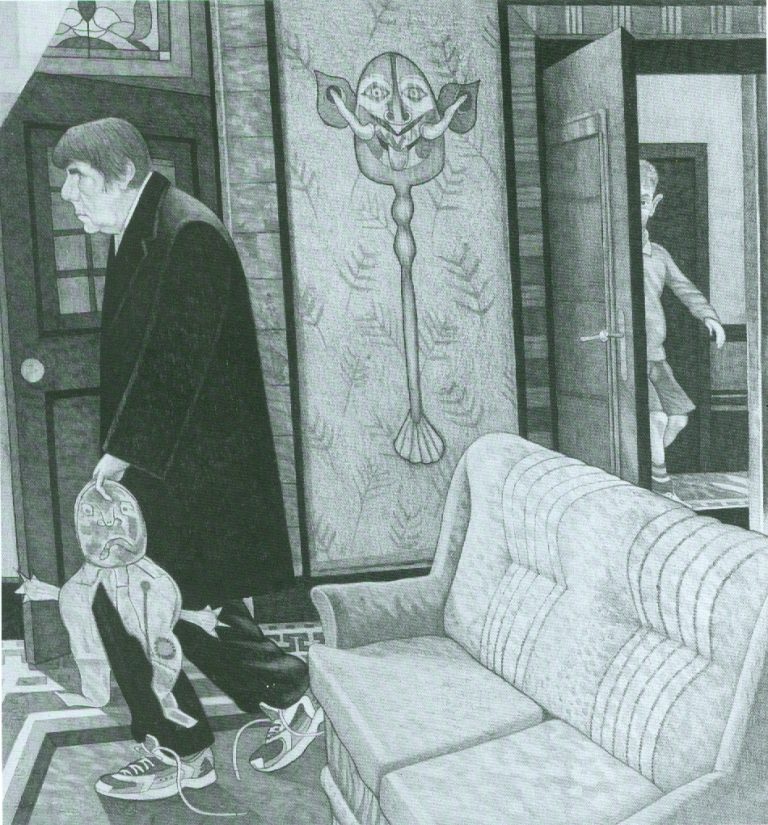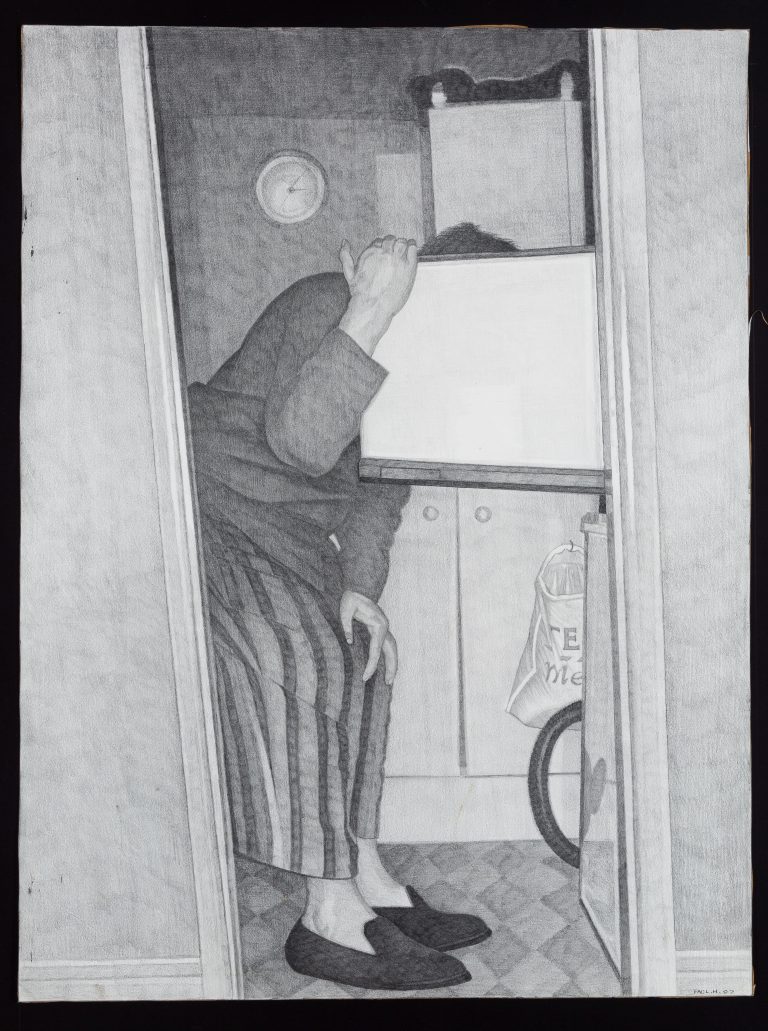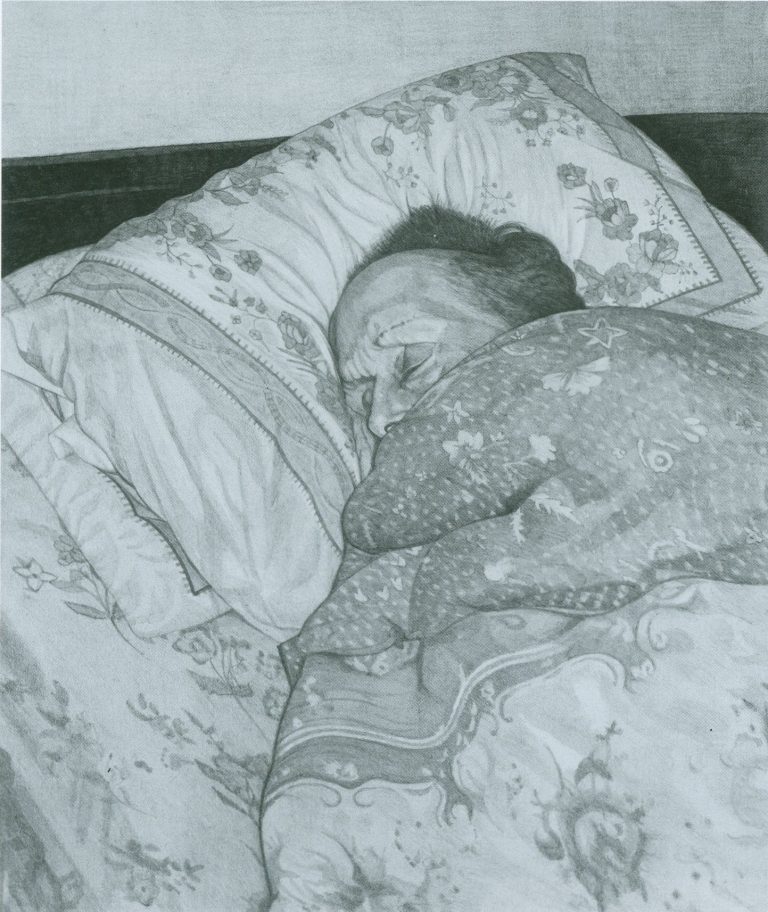To Criticise a Critic
An examination of certain pre-emptive scholarly/art market establishment strikes against a pending book that rejects the Rubens ascription of the National Gallery’s contested Samson and Delilah.
Michael Daley writes: Those who challenge art establishment scholars or institutions can suffer swift repudiation and denigration in lieu of frank and open debate, as I discovered when supporting Prof James Beck’s criticisms of the Sistine Chapel Ceiling restoration in the late 1980s. In the 1996 edition of the Beck/Daley Art Restoration – The Culture, The Business, And The Scandal, in a chapter headed “The Establishment Counter-attacks”, I noted:
“When criticized in this area, institutions react institutionally, which is to say, by deploying self-protecting mechanisms common to all establishments. The best and most favoured response is no response, implying that the criticism is inconsequential and deserves to be ignored. In those instances where a response is unavoidable, it is thought best to be made by proxy… When a direct defence is necessary, its tone becomes all important. By tradition, the tone ranges from amused disdain, through supercilious dismissiveness to outright disparagement and attempts to discredit personal or professional credentials.”
It seems little has changed and that responses to the imminent arrival of Euphrosyne Doxiadis’s book on the National Gallery’s supposed Rubens Samson and Delilah (NG6461 – The Fake National Gallery Rubens) have run true to institutional templates. As a case in point, take this even-handed Artnet account: “Is This Rubens Real? Inside the ‘Samson and Delilah’ Debate” by Jo Lawson-Tancred.
Lawson-Tancred reports an anonymous National Gallery spokesman’s claims that the picture “has long been accepted by Rubens scholars” and that the Gallery finds no cause to update its initial technical examination of the painting [as had been reported in its 1983 Technical Bulletin] and whose “findings remain valid.” The first part is true – Rubens scholars had so accepted the attribution. However, the insistence that the report on the then recently acquired, exhibited, and restored £2.53mn picture requires no updating disregards subsequent findings on this and other Rubens paintings.
To be precise, the Gallery claimed in 1983: “At some time, probably during the present century, the panel was planed-down to a thickness of 3mm and subsequently glued onto a sheet of blockboard”. As Doxiadis and we have established the picture had emerged as a panel in 1929 – albeit ascribed to Honthorst. Crucially, it had remained a panel when sent to Christie’s, London, for sale in 1980 as an autograph Rubens – indeed it was precisely so described in Christie’s 1980 catalogue (see Fig. 1 below.) The picture’s physical state as a panel had been disclosed to Doxiadis by a Belgian banker who had wished to buy the picture for the Rockox House museum in 1977 and who again held it in Antwerp for its owner in 1980 before sending it on her behalf to Christie’s, London. Beyond any question, it was still an intact panel at that date.
WHERE’S THE BEEF?
Fig. 1, above: Christie’s 1980 sale catalogue entry on the Rubens-attributed Samson and Delilah panel. Note how the entry comprises a daisy-chain of “probablys” and “possiblys” – and also its parenthetical disclosure that, throughout its claimed long stay in the Liechtenstein Collection, this Samson and Delilah had not been judged a Rubens.
Given that we informed the National Gallery a quarter of a century ago of the picture’s confirmed physical status as a bowed and cradled panel in good shape in 1980, its 1983 technical account has long needed correction because the planing had not taken place before 1980, let alone in the 19th century. And yet, that manifestly unfounded suggestion that the planing might have occurred before the 20th century had been endorsed by Joyce Plesters, the Gallery’s Head of Science in the 1983 Technical Bulletin: “Unfortunately, as David Bomford has described, the back of the panel had been planed down to a thickness of only about 3mm and then the whole set into blockboard before the picture was acquired by the National Gallery…” In truth, it had not been set into the blockboard, but rather, as Bomford had correctly reported, and Doxiadis would later discover, it had been glued onto a blockboard sheet larger than itself and fitted into a new purpose made frame.
On the combined records of 1929 and 1980 that Doxiadis and we had uncovered – and as on Christie’s own published catalogue description – it followed that the planing could only have occurred after the picture was sold to the Gallery for its then world record Rubens price of £2.53million in 1980. Our concerns were compounded when informed (by the National Gallery’s then director, Neil MacGregor) that the Gallery had not followed its own procedure of preparing written curatorial and restoration reports on the picture’s desirability and condition to assist the trustees when they examined the picture (which had been loaned to the Gallery ahead of the sale – see below) to consider an authorisation of the purchase.
AN APPEAL TO AUTHORITY
In view of Doxiadis’s recently reported disclosures on the picture’s physical condition in 1980 (Dalya Alberge “Fresh doubt cast on authenticity of Rubens painting in the National Gallery,” ) Lawson-Tancred might have questioned or challenged the National Gallery’s abiding stance. Instead, she reported:
“…despite the marginal but adamant voices of researchers like Doxiadis, top scholars in the field support Samson and Delilah’s authenticity unequivocally. Chief among these is Nils Büttner, chairman of the Centrum Rubenianum in Antwerp, who is working on the Corpus Rubenianum, the definitive catalogue raisonné for the Flemish Baroque painter. He has previously described the doubts about Samson and Delilah’s provenance as “conspiracy theories.” However, Lawson-Tancred also noted that “Büttner [had] declined to comment on Doxiadis’s book”. While Büttner, presumably, has not yet read the unpublished book, his assertions received immediate support from players in the art trade:
“Büttner’s position is backed by his peers like Adam Busiakiewicz, a lecturer and consultant on Old Master paintings for Sotheby’s. He pointed out to the Telegraph that Doxiadis is not a scholar of the period and has mostly published on Greco-Roman antiquities previously. Though she ‘had a hunch the quality of the picture wasn’t good enough’, he said, ‘I think there are some misunderstandings about the painting.’”
On misunderstandings, Busiakiewicz (who seems also to be employed by the art market “sleeper-hunter” and former Philip Mould assistant, Bendor Grosvenor, on the latter’s “Art History News” blog site), paraded just such in his reported burst of professional condescension to Doxiadis:
“Busiakiewicz explained that a comparison between Samson and Delilah and other paintings by Rubens are complicated, especially when they were made decades apart. ‘He’s an artist that changed his style throughout his career,’ he said. ‘Art historians who specialize in paintings like Rubens’ can track these changes.’ It is for this reason that the National Gallery painting has been connected to Rubens’s interest in the work of Caravaggio and other Renaissance masters whose work he had, at that time, recently encountered while traveling in Italy.”
While it is widely known that Rubens underwent changes of manner in his later paintings, Busiakiewicz failed to acknowledge (or appreciate?) that Doxiadis, we, and other critics of the attribution, such as Dr Kasia Pisarek, have for decades pointed out and demonstrated that the Samson and Delilah is glaringly unlike the bona fide Rubens paintings made precisely in that brief period when the artist had just returned from Italy.
Specifically, we had reminded readers in November 2021 that:
“In a pioneering 1992 report, the scholar/painter Euphrosyne Doxiadis and the painters Stephen Harvey and Siân Hopkinson, conducted a focussed survey of six Rubens paintings of 1609 and 1610 and demonstrated that “All these display a consistency and quality of style which is not shared by the Samson and Delilah”. That report – “Delilah cut off Samson’s hair, but who cut off his toes? The case against the National Gallery’s ‘Rubens’ Samson and Delilah” – was placed in the National Gallery’s Samson and Delilah dossiers and is published on the dedicated In Rubens Name website.”
WHITHER THE PANEL’S BACK
Above, Fig. 2: The covers of two ArtWatch UK journals given over to detailed accounts of the Samson and Delilah problems and shortcomings.
In issue 21 Kasia Pisarek wrote: “The Corpus Rubenianum project is based on the archive left by the late Dr Ludwig Burchard. Should it perhaps follow it less closely? Dr Burchard was an active Rubens attributionist in Berlin before the Second World War and in London afterwards. Several paintings formerly attributed to Rubens’s school or studio or even to another artist (such as Samson and Delilah), were reinstated by Burchard as by the master. I traced many of his attributions – he was not infallible in his judgement and changed his mind. Surprisingly, over sixty pictures* attributed to Rubens were later downgraded (in Corpus Rubenianum) to studio works, copies or imitations.” Pisarek adds: “they were, however, mostly portraits of small or medium dimensions.”
If a major work like Samson and Delilah might be considered something of an exception, Doxiadis supplies a possible explanation – Burchard was a relative of one of the owners of the dealing firm that had brought the supposed Honthorst to the marketplace.
*On the subsequent completion of her PhD thesis – Rubens and Connoisseurship: Problems of Attribution and Rediscovery in British and American Collections – Dr Pisarek remarked: “I traced many paintings attributed by Ludwig Burchard… At least seventy-five works he certified authentic were subsequently downgraded to studio works, copies, and imitations in the volumes of the Corpus Rubenianum, and the list is not complete… can we trust Burchard’s old rediscovery and attribution of the London Samson and Delilah?)
In issue No.11 we had written: “On December 17th 1998 Dr Jaffe [David Jaffé, then Senior Curator at the National Gallery] writes: ‘Sotheby’s auctioned Rubens Deluge as ‘oil on oak panel’ when, in fact, it was on a marouflaged panel’.” But how is this known? It was so, Jaffé discloses, “according to the condition report made in 1996-97 when the picture was loaned the National Gallery…” But no such condition report was made when the Samson and Delilah was loaned to the National Gallery by Christies ahead of the sale. That condition report on the Deluge had been prepared by the National Gallery’s timber specialist restorer, Anthony Reeve. As recently as 1982 Reeve had reported in the National Gallery’s Technical Bulletin (see Fig. 7) that the Samson and Delilah was “one of only three well-made straightforward Rubens panels in the collection” – which panels, he elaborated, required stable humidity because otherwise “The effect of wood shrinkage on the exposed backs of the panel…is for the front to become convex, and perhaps slightly corrugated”. Had the Samson and Delilah been planed-down and glued to blockboard at that date there would have been no possibility of its back being subjected to environmental hazards. It might be thought inconceivable that the National Gallery should have lost recollection of Reeve’s testimony by the following year and when writing in the same publication. As the National Gallery’s senior picture restorer Reeve was held after his death by Neil MacGregor to be the “supreme practitioner of his generation.”
There are yet further confirmations of the panel’s still-then exposed back. Doxiadis had obtained a Belgian condition report on the Samson and Delilah which began: “On arrival on 4 March 1980, about 14.30 hours the painting mentioned above (panel, 185 x 205 cms) was in good shape…” Doxiadis’s account squared with testimony supplied to ArtWatch by the art critic Brian Sewell (an ex-Christie’s man who took pride in having there identified an oil sketch as the modello for the Rubens Samson and Delilah), namely: that the panel had not been mounted on blockboard; that the back of the panel had been painted in a darkish matt colour and was criss-crossed with supporting bars of wood; that because Christie’s customary stencil number was made with dark paint it had been superimposed over a patch of white paint Christie’s had applied to the panel’s back.
Presumably Busiakiewicz has yet to access the 1992 Doxiadis/Harvey/Hopkinson report. For the record, the document I found in the National Gallery’s Samson and Delilah dossiers was a copy of the picture’s 1929 certificate of authenticity written by the great but subsequently discredited Rubens specialist Ludwig Burchard who had observed: “The picture is in a remarkably good state of preservation with even the back of the panel in its original condition”.
A CRITICAL FORMATION ASSEMBLES…
Where Busiakiewicz patronises Doxiadis on an allegedly insufficient familiarity with the Samson and Delilah literature, Nils Büttner has been joined in that disparagement by Bert Watteeuw, the director of the Antwerp Rubens House. As John Smith reports in the EuroWeekly:
“The latest suggestion that this is a 20th-century copy comes from Greek art historian Euphrosyne Doxiadis in her new book The Fake Rubens although this accusation finds little support from one of Belgium’s top Rubens experts Bert Watteeuw. Not only does he pour scorn on her status as a genuine expert, suggesting that anyone of any standard would have already checked with his Antwerp Rubens House and other specialist houses about the painting. In addition, he also said: ‘the provenance of this painting is very well known throughout the 17th, 18th and 19th centuries. A provenance that can be trusted is always crucial’…”
This implied claim of a trustworthy Rubens provenance was a brazen sleight of hand: what John Smith was not to know is that, as shown above, the provenance concerned at no point confirmed the painting as being by Rubens’ hand. Being thus kept in the dark, poor Smith could only but conclude: “Whilst the National Gallery has kept a dignified silence on the matter of the painting, it is no doubt delighted that one of the great Rubens scholars has come out publicly to dismiss the fake claim by Doxiadis which Watteeuw considers is purely invented to promote her book.”
Delighted as the National Gallery might be and while its Trappist silence might do yet further service as an institutionally imperative damage limitation exercise, it remains an untenable stance because, as one very distinguished former National Gallery trustee at the time of the Samson and Delilah purchase told Doxiadis, “the truth will come out – it always does”. As for Watteeuw, for a Rubens scholar at the supposed top of his professional tree to resort to professionally unfounded claims and personally directed abuse is as counterproductive as it is contemptible.
Moreover, in this regard, Watteeuw might be considered a serial offender: when apprised of negative AI findings on the Samson and Delilah panel he told another journalist, Colin Clapson (‘Fake Rubens in London’s National Gallery? This painting is genuine” counters Rubens House director Bert Watteeuw”) that Doxiadis’s soon-to-be-published book is “Complete nonsense and not based on facts. To begin with, I do not know this art historian and that is a sign. Most researchers on Rubens have passed by our Rubens House and the Rubenianium, the Rubens Library, in the search of sources and information,’ says Bert Watteeuw, the director of the Antwerp Rubens House. ‘Moreover, Doxiadis has an agenda of her own: to promote her book and that seems to be working well. In such cases conspiracies à la Dan Brown are more interesting than science.’ Whilst attacking its critic, Watteeuw gifts the National Gallery a clean bill of scholarly probity on its protracted silence: “‘The painting ‘Samson and Delilah’ in London is a genuine Rubens, a masterpiece. It is logical that the National Gallery does not want to comment or discuss its authenticity,’ he says.”
DISALLOWED TESTIMONY
In view of the above it might seem that among Rubens establishment scholars generally and for the National Gallery itself, nothing can be allowed to count as evidence against the challenged panel’s Rubens ascription. For example, in 2021, the brushwork of the Samson and Delilah was compared with that found in no fewer than 148 uncontested Rubens paintings. As Dalya Alberge noted in the Guardian (“Was famed Samson and Delilah really painted by Rubens? No, says AI”), “Its report concludes: ‘The AI System evaluates Samson and Delilah not to be an original artwork by Rubens with a probability of 91.78%.’ In contrast, the scientists’ analysis of another National Gallery Rubens – A View of Het Steen in the Early Morning – came out with a probability of 98.76% in favour of the artist.”
Such disinterested testimony is dismissed by the affronted – and perhaps professionally discomfited – scholarly grandees: “Watteeuw also dismisses AI research dating from a few years ago. ‘When that appeared, we engaged in extensive behind-the-scenes dialogue with that Swiss firm that had carried it out. AI can only work if you train it with an artist’s entire oeuvre. That was not the case at that time.’” (Watteeuw was here echoing Bendor Grosvenor’s mis-characterisation of the Swiss firm: “It is simply not possible to determine whether a painting is by Rubens by relying on poor quality images [sic] of not much more than half of his oeuvre…”) First, there is once again, as with Doxiadis, an implicit professional slur on the firm in question. Second, there is yet further evidence that logic is underemployed by many art establishment players: if, given the very great distinctiveness of Rubens’ style and painterly applications, you can find no visual correspondences when comparing the Samson and Delilah’s brushwork with a single one of 148 secure Rubens paintings, why would you be likely to find such correspondences in another batch of equally secure Rubens paintings? At this point, calling for yet more extensive AI tests on a vast oeuvre – and one with ever-shifting boundaries – is procrastination, the obliging sister of obdurate institutional silence.
CAN’T SEE – OR WON’T SEE?
Professor James Beck once remarked that too many of his peers “look with their ears” and that it is “only the artists who can see things clearly”. It so happens that all the principal critics of the Samson and Delilah picture – Doxiadis/Harvey/Hopkinson/Daley/Pisarek – happen to have trained as artists, as Beck himself had done. Doxiadis noticed what no Rubens scholar, so far as we know, had noticed: that while Rubens painted with round brushes, the shadowy author of the Samson and Delilah had deployed flat brushes.
Above, Fig. 3: Top, detail of the National Gallery’s Samson and Delilah; above, detail of Rubens’ The Raising of the Cross, Antwerp Cathedral. Where the former is claimed to be a lost picture Rubens painted in 1609-10, the latter was indisputably made by Rubens between 1610-11. Such pronounced differences in brushwork are inconceivable as that of two autograph paintings made at the same moment in Rubens’ oeuvre. Who, looking at this photo-comparison, could believe that Rubens had flitted between the ugly angular Cubist faceted feet in the Samson and Delilah statue (– try counting the toes and note the Art Deco zigzagging hem), and the superb plastic fluency, grace and anatomical fidelity seen throughout the Raising of the Cross?
Above, Fig. 4: Two copies of the lost original Rubens Samson and Delilah – Top, Jacob Matham’s c. 1613 engraving (here reversed); bottom, Frans Francken II, a detail of his oil on copper depiction of the Grand Salon in Nicolaas Rockox’s House, made between 1615 and before 1640. Neither copy shows the cropped right foot found on the National Gallery picture. No one has cited a similarly cropped limb in any finished Rubens painting.
Above, Fig. 5: The National Gallery’s supposed Rubens Samson and Delilah painting.
Above, Fig. 6: Left, a detail (from the left wing) of Rubens’ 1609-1610 The Raising of the Cross, Antwerp Cathedral. Right, a detail of the National Gallery’s Samson and Delilah which Christopher Brown (David Jaffe’s predecessor as Senior Curator at the National Gallery) dates at “c.1609” and Jaffé puts “about 1610”. Among the National Gallery picture’s countless visual disqualifications, we would cite: the thinness of the paint; the absence of a 17th century craquelure; the irresolute profile; the cinematic lighting of the head; and, the anatomical and perspectival travestying of Delilah’s nose/mouth/chin configuration.
For many more disqualifying photo-comparisons, see Abigail Buchanan’s “The National Gallery ‘masterpiece’ that’s probably a fake”.
TANGLED DOCUMENTARY WEBS…
Such clinching visual evidence, however, leaves Adam Busiakiewicz unmoved and unpersuaded. He tells the Daily Telegraph that the National Gallery Samson and Delilah could be in no one but Rubens’ hand – viz: “‘It is a really stonking great picture,’ he says. ‘The textures, the sumptuous drapery, the muscular back – no one except Rubens could have painted that.’” Each to his own art critical estimations, perhaps, but what happened to the Samson and Delilah when in the National Gallery’s restoration studios is – or should be – a matter of scrupulously recorded and reported facts. We are now faced by a major art institution that cannot/will not give a proper and credible account of its own actions; that effectively denies, even, the historical record of its own doings. Consider the recorded facts: (1) it is a matter of record that this painting emerged in 1929 as a sound panel and that it remained so in 1977 (when exhibited in Antwerp); (2) it is known that in 1980 the picture was a panel when it was dispatched to London; when it arrived in London; and, when it was sold in London to the National Gallery; (3) it is known that when in London and on exhibition at the National Gallery it remained a panel in 1982 (- see Fig. 7 below). However, it is also known that the following year the National Gallery claimed – after the picture had been restored at the Gallery – that it was not now a panel at all – and, indeed, that it had not been a panel for a very long time and possibly, even, into the 19th century or beyond. This extraordinary denial of the picture’s own documented historical record might seem inexplicable in a major national institution, but it is by no means unprecedented – and nor, for that matter, is the Gallery’s effective outsourcing of its own defence to obligingly helpful scholarly proxies.
Not the least consequence of misleading institutionally-official accounts is the corruption of subsequent scholarship and the making of monkeys out of good faith and technically trusting patrons. In part-defence against widespread and prolonged criticisms of its notoriously over-energetic techno-adventurist restorations, the National Gallery ran a series of didactic, so-called “Making and Meaning” exhibitions. One such in 1996-97 was Rubens’s Landscapes. It was organised jointly by the Gallery’s then senior curator, Christopher Brown, and by its senior restorer, Anthony Reeve. The exhibition was sponsored by Esso UK plc and its chairman and chief executive, K.H. Taylor, expressed pleasure in being associated with “the quality of research and scholarship that are the Gallery’s hallmarks”. In turn, the then National Gallery director, Neil MacGregor, expressed gratitude to Esso for its generosity, for year after year, in enabling the Gallery to “present to the public recent research on how and why the pictures were made”. In a section on the rigorously high standards of professional panel making in 17th century Antwerp it was noted that panels were marked with their makers’ monograms and that the panel back of Rubens’s “Chapeau de Paille” portrait bore Antwerp’s coat of arms and the carved initials of its maker, Michiel Vriendt. However, with the Samson and Delilah no such assurance was offered. Instead, the reader seemingly learns – with a nod to the contrary testimony of Reeve and Bomford/Plesters (see Fig. 7 below) that “A particularly fine panel made for Rubens by an Antwerp panelmaker is that for the Samson and Delilah, painted about 1609 for Nicolaas Rockox…” But then, after a section reprising Reeve’s own 1982 Technical Bulletin account of the risks posed to such fine panels by fluctuations in humidity, comes an abrupt claim that “The Samson and Delilah was planed down to a thickness of about three millimetres and set into [sic] a new blockboard panel before it was acquired by the National Gallery in 1980 and so no trace of a panelmaker’s mark can be found…”
Now, in Fig. 7 above we see two incompatible accounts that were made and published just a year apart in successive National Gallery Technical Bulletins. Which of the contrary pair might be taken by the public and future scholars to be the more reliable and trustworthy record? Reeve’s account had preceded that of Bomford/Plesters – he had seen and reported what he saw and knew. Brown must therefore have found himself in the unenviable position of having to choose between Reeve’s earlier account and the later contrary one of Bomford/Plesters. That is, he had either to accept that the picture came into the Gallery after it had been planed down by some unknown party at an indeterminate date and that Reeve had imagined and chronicled an entirely fictional panel comprised of “six [sic] horizontal oak planks, carefully planed and jointed”, or, recognising that Reeve of all people was unlikely to have confounded a new sheet of blockboard with an early 17th century Flemish oak panel and extol its technical virtues even among Rubens’s panels, or… what? What could Brown say of the Bomford/Plesters account when he was aware that the picture’s own dossiers contained the already widely press-reported and potentially explosive 1992 Doxiadis/Harvey/Hopkinson report precisely challenging the Bomford/Plesters account? Could he go down the middle and say that while the picture had come into the gallery as a panel in good shape – as Reeve had testified – when subsequently taken into restoration, it had been planed down and glued onto (not “into”) a new sheet of blockboard – and do so without offering any explanation for such a radical and inescapably material and historical evidence-erasing procedure? In the event, Brown did neither. Rather, he fudged a technically-incoherent mongrel account even though he and Reeve were the exhibition’s joint authors. That is, on the one hand he spoke of the Samson and Delilah having been a “particularly fine panel made for Rubens by an Antwerp panelmaker” and then, leaving a gaping, mystifying narrative hole in his own account, jumped to “The Samson and Delilah panel was planed down to… etc. etc.” This was a curatorial equivalent of the old comic book cop-out gag “With one bound, Jack was free”. It is not easy to conclude other than that it had seemed institutionally imperative to dissemble rather than clarify.
8 March 2025.
Good buy Duccio?
In Part I* of III, Michael Daley introduces the [$45-50m.] purchase of a panel attributed to the father of the Siennese school of painting (*As published in the November/December 2008 issue of the Jackdaw).
Spending pots of money on works of art is rarely without risk. The Metropolitan Museum’s 2004 decision to pay between $45-$50m (- in a blind “treaty” sale conducted by Christie’s) for the “Stoclet” Duccio Madonna and Child, already seems a source of anxiety. That the acquisition breached the Met’s own “due process” requirements was initially flaunted. It is no more. Our own researches suggest (– as will be discussed in Part II) that the attribution may prove unsound.
Four years after the Met’s Board authorised payment (- after the event ) for this Duccio, the architects of the acquisition, Philippe de Montebello, who is retiring after thirty-one years as Director, and Keith Christiansen, the Museum’s curator of European Painting, now seem to be saying: “The Duccio remains a great acquisition – but it was his responsibility more than mine”.
Above, the “Met Duccio” as it appears today (right) and as it appeared in 1904 (left) when it had recently emerged without provenance – that is: it was said to have been bought by a Russian collector from an antiques shop.
Christiansen gave detailed account of his role in Danny Danziger’s 2007 book Museum ~ Behind the scenes at the Metropolitan Museum of Art:
“…Nicholas Hall of Christie’s, with whom I have been friends for many years, phoned me up and said, ‘I would like you to have lunch with me; there is something I’d like to show you.’ During the meal he slipped me a transparency, and I looked at it.
It was a painting that had not been seen by any of the major Duccio specialists for fifty years; it had been in the hands of the Stoclet family and out of circulation. ‘Fantastic, how about the price?’ I asked. He told me. ‘OK,’ I said, ‘I will deal with that later.’ And then we finished our lunch.
…I waited for the director to come back from his vacation. And then I went into his office and said, ‘I am duty bound to show you this,’ and then I showed him the transparency. I casually said to him, ‘You know, Philippe, you deserve this picture. Tom Hoving had his Juan de Pareja [a stunning portrait by Velazquez, bought in 1970 for $5.5m], Rorimer had his Rembrandt [the majestic double portrait Aristotle with a Bust of Homer, bought in 1961 for $2.3m.]; I don’t see why you shouldn’t have this towards the end of your career’…”
De Montebello told Calvin Tomkins in the New Yorker (July 2005):
“I was just smitten by the transparency, as anyone would be, and I decided we had to go and look at this picture… It’s the single most important purchase during my twenty-eight years as director. It’s my Juan Parega, it’s my Aristotle with the bust of Homer… There was not an ounce of doubt in my mind about it… Technically I was not authorized to make an offer. I just took a chance that my trustees would go along.”
Christiansen had lauded this decisiveness in the New York Times on November 10 2004: “When I showed it to him, it took him about 30 seconds to say, ‘We really have to have this.’” But in a prefatory note to the Metropolitan Museum’s Summer 2008 Art Bulletin (which is given over to Christiansen’s: “Duccio and the Origins of Western Painting”), de Montebello now downplays his own role:
“…I wish simply to correct the misleading impression that in making an acquisition of this importance and expense, it was my response to the picture’s quality and art historical significance and my confidence in that response that was the determinative factor… recommending so large an expenditure to our Acquisitions Committee required more than just my response… It required that this response be reinforced by the assurance that comes from the trust I have learned to place in the curators and conservators in this great institution… As I held the picture in my hands, enraptured by its wonderful quality… I was treated all the while to Keith’s impassioned scholarship… it was particularly Keith’s precise and learned assessment of the picture that allowed me to consider the acquisition an imperative.”
In his own Bulletin foreword, Christiansen again admits this was a work known to scholars only by photographs; that it had very recently been withdrawn from a (comparative) exhibition on Duccio and his followers – despite being in the catalogue; that it had never undergone any modern scientific analysis; and, that in the normal course of events, it would have been sent to the Museum for examination and eventual presentation before the Acquisitions Committee, composed of members of the Board of trustees. He then tells how he and the Met’s restorer, Dorothy Mahon, travelled with the Director to Christie’s, London:
“We spent about two hours with the picture before calling the Christie’s representatives back into the room. I imagined that we were now about to embark on drawn-out discussions and negotiations, with intense pressure from other institutions. This assumption proved dead wrong. The Director seized the initiative and stated that he was prepared to make an offer for the painting. I don’t know who was more taken aback, the Christie’s representatives or Dorothy and I… On the return flight I noticed that the Director was bent over a list of what seemed to be various funds that might be applied to the purchase of the picture. ‘You must have worked out the mechanics for this even before we left to examine the picture,’ I observed. ‘Oh yes, this trip was to confirm that the picture was as extraordinary as it already seemed to me, and if it was, I had determined we were going to get it.’ Trustees still needed to be consulted and further funds identified, and weeks were to pass before a final deed of sale was signed. But the key step had been taken…”
Indeed it had.
Coming next in Part II: “BUYER BEWARE”
Further Thoughts II: The less and less Leonardo ex-Cook collection Salvator Mundi
Jacques Franck here concludes his three-part demolition of the once attributed but now deposed, $450m New York/Russian/Saudi Leonardo da Vinci Salvator Mundi picture’s supposed stylistic, artistic and technical credentials.
Jacques Franck writes: Many events have occurred since the publication here of my August 2020 essay on the “New York Salvator Mundi” and it seems timely to update and close the subject in the light of recently emerged technical data on the controversial painting. To grasp the present situation, a reprise of recent key events is necessary.
Above, Fig. 1: Workshop of Leonardo da Vinci (Salai with the assistance of. G. A. Boltraffio?), Christ as Salvator Mundi (“the Cook version of Salvator Mundi“), c. 1506/1508-1513, oil on walnut, 65.5 x 45.1 cm (Private Collection), as seen in 2011-12.
The Louvre’s junked book: a contradiction that does not exist
It cannot be doubted that months before the Louvre’s major Leonardo da Vinci exhibition opened in Paris in Autumn 2019 the museum still believed that the Salvator Mundi was an autograph work of Leonardo. This is testified by the fact that the initial version of the Louvre’s Leonardo exhibition catalogue was printed with the (former New York, now Saudi) painting labelled as an indisputably true da Vinci picture. Shortly afterwards, that first version of the catalogue was suppressed and a new version was printed with a radically revised attribution. In it, the work – which itself was not included in the exhibition – was simply reproduced and listed as “Fig. 103 bis. Salvator Mundi version Cook” (meaning a “studio work” with a status analogous to that of another well-known Leonardo studio Salvator Mundi, called the “Ganay version”) (Fig. 2 below). Whatever reasons precipitated this sudden change, the new designation definitively constituted the Museum’s then – and still – estimation of the former New York and now “Saudi Salvator Mundi”. At this stage, that judgement is, of course, irreversible.
Above, Fig. 2: Left, Léonard de Vinci, exhibition catalogue, Louvre éditions, Paris, 2019, p. 305 (Cook Salvator Mundi); right, Léonard de Vinci, exhibition catalogue, Louvre éditions, Paris, 2019, p. 307 (Ganay Salvator Mundi).
The Disappeared Louvre Technical Book – aka the “would-be-decisive-scientific-examination-of-short-lived-appearance” of December 2019
Above, Fig. 3: Left, Vincent Delieuvin, Myriam Eveno, Élisabeth Ravaud, Léonard de Vinci, Salvator Mundi, Louvre éditions – Hazan, Paris 2019, (as published in The Art Newspaper); right, a page taken from Vincent Delieuvin, Élisabeth Ravaud, Léonard de Vinci. Le Salvator Mundi, Louvre éditions – Hazan, Paris, 2019.
Above, Fig. 4: Workshop of Leonardo da Vinci, the Cook version of Salvator Mundi, back of the wood panel.
Quite strangely, a 46-page booklet titled “Léonard de Vinci. Le Salvator Mundi” was published jointly by the Louvre and its laboratory (C2RMF) six weeks after the exhibition’s 24 October 2019 opening at the Louvre (Fig. 3, above). On no official announcement or evident sanction, the booklet is said to have made a very brief and accidental appearance in the Museum’s bookshop in December 2019. Its authors, Vincent Delieuvin (Leonardo curator at the Louvre), Myriam Eveno and Élisabeth Ravaud (Louvre’s laboratory C2RMF scientists), had considered and contended that the New York Salvator Mundi is an authentic Leonardo. Thus, their historical and scientific essays radically opposed the picture’s studio attribution as stated in the official exhibition catalogue. Unsurprisingly, the dissenting publication was swiftly withdrawn and the museum itself neither recognized the book’s existence nor its embarrassing contents.
With the reasons for the booklet’s leak still remaining obscure, it would be risky indeed to accept a theory in circulation whereby the pro-Leonardo version of the catalogue had been printed together with the scientific booklet in the event of the Salvator Mundi being exhibited, while another entire catalogue, in which the picture was downgraded, had also been printed simultaneously on the possibility that a loan of the picture might be refused. Such a scenario does not accord with the fact that the junked booklet was printed in December 2019 – which is to say, after the exhibition had opened – while both versions of the exhibition catalogue, one of which was abandoned, had been printed two months earlier in October. Such a theory would thus suggest that Louvre Museum staffs’ scientific investigations are determined not by matters of hard material evidence and duly considered professional judgements but, rather, according to political expediencies such as whether or not a loan request might be granted. Who could believe such a tale? Science is science and it is certainly not a discipline with one rule for one political eventuality and one rule for another. Museum laboratory researchers certainly do not draft contrary and rival test results from a single investigation so that they might comply with an institution’s future stance. Moreover, while the phantom book’s existence was known to the small circle of the Leonardo specialists after its short-lived bookshop appearance, for a long time, nobody was fully apprised of its actual contents (bar rare circulating scanned pages).
The problematic ‘‘Mona Lisa‘s male alter ego’’
While the Salvator Mundi‘s standing was not intended to remain unresolved indefinitely, its intrinsic mystery deepened with certain revelations disclosed in an April 2021 French documentary film “The Saviour For Sale. The Story of Salvator Mundi” by Antoine Vitkine on the picture’s various stages of upgrading as a retrieved Leonardo masterpiece which culminated in November 2017 when sold as such at Christie’s, New York, for $450m. Besides the sensational episodes of the work’s thriller-like route to financial success, the film addressed the long-expected loan to the Louvre and the consequent stumbling negotiations between the museum and the Salvator Mundi‘s owner, the Saudi prince Mohammad bin Salman, nicknamed MBS. Thus, we first learn that in June 2018 the panel painting was sent to the Louvre to be examined at length closely in the Museum’s laboratory and that the results of this survey, confirming the Leonardo attribution, are those recorded and discussed in the withdrawn booklet (Fig. 3 above); but then, that shortly before the blockbuster’s inauguration, the Louvre invited several Leonardo specialists to examine the painting before finalizing a loan process with MBS. At that date in 2019, the scholars’ opinion was not as favourable as that of the C2RMF scientists in 2018 and the work was downgraded to being by Leonardo in part only. The film also reports that MBS (quite understandably) resisted his property’s lowered artistic status and made clear that unless the Salvator Mundi was exhibited next to the Mona Lisa (thereby underscoring its originally claimed status when promoted by Christie’s as a “Male Mona Lisa” ahead of its November 2017 sale) the loan would be refused. Misinterpreting this imbroglio, certain parties today claim that the 2019 downgrading had prompted the Prince’s exorbitant clause. In any event, the subsequent insistence that the Salvator Mundi be shown in the exhibition as the ‘‘Mona Lisa‘s male alter ego’’, side by side, was one the Louvre could not accept for security reasons quite aside from the work’s recently lowered artistic status.
The revelations of the Vitkine film precipitated an art world earthquake: the long-running suspense from the moment the Louvre requested the loan from the owner shortly after the November 2017 New York sale, until the very day of the Leonardo exhibition opening in Paris, two years later, had been the consequence of a tumultuous negotiation over the artistic status and attribution of the painting that terminated in a late and drastic 2019 reappraisal. The unexpected downgrading by the museum that holds the most important collection of Leonardo masterpieces in the world, including the legendary Mona Lisa, constituted the strongest possible reversal and disavowal to the accrued federation of parties that had fervently and assiduously promoted the work as a Leonardo for over a decade.
Needless to say, the recent leaking of the contents of the withdrawn booklet – “the book that doesn’t exist” as many have called it – by Leonardo upgrade partisans has considerably increased the saga’s fog of ambiguity and even restored hope among the True Leonardo Believers that their icon may yet be crowned as an autograph work of the master. Nevertheless, given that the Salvator Mundi picture concerned cannot be both a true Leonardo and a studio work, the staggering contradiction between the Louvre’s present (and official attribution, as advised by leading specialists) and the C2RMF’s earlier scientific investigation of 2018, has yet to be resolved. For that reason, checking the internal scientific consistency of the “no book” now seems both essential and urgent.
Like many Leonardo scholars I have been supplied a PDF of the book “for information”, so to speak. Since, with its now international circulation, the book’s contents are no longer a guarded secret and given that many of its issues are at the heart of my own researches there are no reasons for me not to make public my observations on the mystery book’s contents and postulates. The task is made easier because the C2RMF 2018 investigation has been supplemented by other earlier and institutionally separate investigations conducted over a number of years before and after the 2017 New York sale, notably in the USA.
The assorted technical analyses of the Cook version of Salvator Mundi
The phantom Louvre booklet displays two essays: Vincent Delieuvin’s historical account of the undocumented creation of a Salvator Mundi by Leonardo (hereafter referred to as Delieuvin, 2019); and a detailed technical report by Myriam Eveno and Élisabeth Ravaud, both C2RMF scientists (hereafter referred to as Eveno and Ravaud, 2019). I shall mainly review this latter essay (albeit with some forays into Delieuvin’s piece) because its material addresses the factual aspects of the picture – that is, its physical structure and the specific components used for its execution. When necessary, I shall also refer to an American scientific investigation whose last stage was published on 20 April 2020 in Heritage Science by Nica Gutman Rieppi, Beth A. Price, Ken Sutherland, Andrew P. Lins, Richard Newman, Pen Wang, Tin Wang and Thomas J. Tague Jr. (hereafter, Rieppi, Price, Sutherland et al., 2020) [1]. Some of the latter’s work was delivered by Dianne Modestini in 2014 [2].
Delieuvin’s optimistic tone contrasts with the tests themselves, which are far from conclusive, as we shall see (“The decisive contribution of the scientific examination”, Delieuvin, 2019, p. 14, my translation – unless specified, all translations are mine). My astonishment was pronounced when, having noticed the poorly significant elements actually observed by Eveno and Ravaud, I encountered the conclusion: “[In our opinion] the examination of the Salvator Mundi seems to demonstrate that Leonardo has executed the work indeed” (Eveno and Ravaud, p. 38). That latter statement was audacious: although the scientific investigation of paintings is inescapable as a rational means to understand both their structures and techniques – and as such, is of crucial assistance to art historians – it can never prove whether a painting is by one hand or another, here being that of Leonardo.
From misinterpreted observations to rushed conclusions (why the C2RMF’s 2018 scientific investigation was not to be made public)
Let us now consider a number of points which explicitly reveal why the two questionable Louvre essays, which bear conclusions extrapolated from shaky grounds, were – rightly – not meant to be published by the Louvre.
I: Panel preparation
Above, Fig. 5 [after Rieppi, Price, Sutherland, et al., 2020, Fig. 2]: Workshop of Leonardo da Vinci, the Cook version of Salvator Mundi, a cross section sample from shadow in flesh, visible light, showing: (1) glue size, (2) ground, (3) imprimitura, (4) paint layers.
Above, Fig. 6: Ambrogio de’ Predis (?), Portrait of a Man aged 20 (“The Archinto Portrait”), 1494, oil on walnut, 54.4 x 38.4 cm (panel), London, National Gallery.
Unlike most Leonardos (aside from the Belle Ferronnière and Saint John the Baptist), the (NY/Saudi) Salvator Mundi was painted on a walnut panel prepared with a white ground applied over the wood, which had first been coated with an unpigmented size layer (Rieppi, Price, Sutherland et al. 2020, p. 9, fig. 2) (Figs. 4 and 5, above). The traditional calcium sulphate gesso is, however, mainly encountered in numerous Leonardos like the Adoration of the Magi, the Louvre version of The Virgin of the Rocks or the Saint Anne. With those, the white ground layer was followed by a thinner off-white priming layer called imprimitura; both layers contain a lead white pigment presumably bound in oil, while a small amount of a lead-tin yellow was found in the thinner second layer. These ground layers also contain glass particles of variable dimensions (consistent with manganese-containing soda-lime glass) of a type commonly encountered in Italian paintings (Rieppi, Price, Sutherland et al., 2020, p. 10-12).
Eveno and Ravaud admit that the panel preparation (with the ground layers laid directly over the sized wood) of the then New York picture is unusual for Leonardo. Against that, they contend that it is found also in works like the Lady with an Ermine, the Belle Ferronnière and the Mona Lisa (Eveno and Ravaud, 2019, p. 37). While this preparatory configuration is an established fact concerning the (now) Saudi Salvator Mundi, as testified by the cross-sections published under Modestini’s direction, to my knowledge no samples (except one in the Lady with an Ermine in 1960, which is yet to be re-examined in the light of modern-day scientific methods) have been taken from the above-mentioned Leonardos. As a result, this technique of preparation is simply presumed in their case despite the researches published by the same C2RMF team in 2014 [3]. Additionally, from the latter publication we learn that this same panel preparation (ground layers of lead white applied on a walnut wood board) has been identified in Leonardo’s circle’s panel paintings, notably in the Portrait of Bernardo di Salla by Giovanni Francesco Caroto (Louvre), in a Salvator Mundi privately owned (Leonardo school) and, quite interestingly, in the Archinto Portrait attributed – notably – to either Ambrogio de ‘Predis or Marco d’Oggiono (both Leonardo’s main assistants) kept in the National Gallery in London (Ravaud and Eveno, 2014, p. 135 sq.) (Fig. 6, above). In other words, no striking evidence exists that might prove that the panel preparation in the Salvator Mundi is clearly and uniquely specific to Leonardo’s own usage, or indeed confirms that, thanks to this technical feature – as stated by the two C2RMF scientists – the possibility of its being a studio work can be automatically rejected.
Furthermore, and as if in lieu of any technical confirmation, the authors hold the preparation’s peculiarity (never observed in any of Leonardo’s own works) as strong evidence per se, on the grounds that “it accords well with Leonardo’s inventive mind, who constantly experiments new recipes, as testified by the great variety of the preparatory processes [he] employed throughout his career” (Eveno and Ravaud, 2019, p. 37). And this hypothesis is offered despite the fact that the addition of grained and powdered glass particles to the two ground layers is itself another peculiarity, never encountered in Leonardo paintings either (idem) while, conversely, it has been identified in the priming layer (called imprimitura) laid over the gesso preparation in works by such artists as Lorenzo Costa, Perugino, Vincenzo Foppa, and, regularly from 1501 onwards, by Michelangelo (idem) (see infra, Fig. 12, right, backscattered electron [SEM-BSE] image).
Above, Fig. 7: top, Raphael, The Madonna and Child with Saint John the Baptist and Saint Nicholas of Bari (“The Ansidei Madonna”), dated 1505, oil on poplar, 245 x 157 cm (painted area 216.8 x 147.6 cm), London, National Gallery; above, The Ansidei Madonna, a cross-section from the grey paint of the architecture in which particles of glass are visible in the pale yellow imprimitura.
Given that this observation is strange to Leonardo’s known practice and corresponds much more to that of other painters, including Raphael (not cited in Eveno’s and Ravaud’s 2019 essay) (Fig. 7, above) – and, presumably, to their circles – one wonders how the two C2RMF researchers came to take it as a distinctive sign of his technique. Moreover, they are further at risk when positing themselves firmly on a specific role of the glass in the ground layers: “its use, even in the preparation, appears to us as being a distinctive characteristic of Leonardo’s quest for transparency” (Eveno and Ravaud, 2019 p. 38). It is true that the use of glass in paintings may be a means to improve the translucency of the paint layer, according to specific conditions, in which the refraction index of the glass and the layers where it will be introduced. In fact, the ground layers are not the level in the paint film where Leonardo would need transparency, but are where he might want to secure the proper drying of the paint, hence the American researchers’ acknowledging statement: “Glass may alternatively have been used for aesthetic effect by enhancing the translucency of the paint, but in the case of the Salvator Mundi, the glass in the lower ground and imprimitura layers more likely functioned as a siccative since these layers are not visible in the final painting image. It is also possible that the glass was added to adjust the handling and textural properties of the panel preparation materials” (Rieppi, Price, Sutherland et al., 2020, p. 13) [4].
II: The underdrawing and the partial use of the infrared reflectograms
Infrared reflectography helps to detect underdrawings in paintings: infrared rays traverse the paint surface and reveal the underlying lines and wash techniques used to draw and sketch out the overall composition when they are constituted, in particular, of carbonaceous materials such as charcoal, bone black, or soot (lampblack) containing inks. Once again, Delieuvin expresses astounding optimistic views regarding the underdrawing found in the Cook Salvator Mundi: “Infrared reflectography has revealed a very thin and imperceptible underdrawing which much resembles that of the Mona Lisa and of the Saint John the Baptist in the Louvre” (Delieuvin, 2019, p. 14). This is not exactly what can be understood from Eveno’s and Ravaud’s report in the same book: “[Infrared examination has revealed] some rare thin lines absorbing infrared rays, therefore of an a priori carbonaceous nature. They delimit in particular the left eye’s iris. One notices the presence of a double contour line on a well-preserved fragment of the upper lip, although no spolvero dots can be distinguished. The other lines of the composition’s implementation have seemingly been executed in the course of the painting process” (Eveno and Ravaud, 2019, p. 31).
Above, Fig. 8: top, Leonardo, The Mona Lisa, oil on poplar, 77 x 53 cm, c. 1501-1517, Paris, musée du Louvre, detail of hands (infrared reflectogram hereafter referred to as IRR); below, Leonardo, The Virgin and Child with Saint Anne (“The Saint Anne”), 1501-1517, oil on poplar, 168.4 x 113 cm, Paris, musée du Louvre, detail of Saint Anne (IRR). In Lisa’s proper right hand, delicate contour lines have been traced to define further a now imperceptible drawing transferred from a cartoon. Thanks to tiny spolvero dots appearing on some contour lines, the use of a pricked cartoon to transfer the composition is identified in the Louvre Sainte Anne distinctly, in particular in the Saint’s proper left eyelid. The scarce and very small fragments of underdrawing in the New York Salvator Mundi are not decisive towards Leonardo’s authorship given that they don’t compare the typology of the artist’s original underdrawings. Besides, the artistic level of the painting does not match that seen in visible light in the above masterpieces.
These observations are, of course, far too slight to help one figure out whether or not the Salvator Mundi‘s underdrawing compares directly with those of the late Leonardos, like the one faintly discernible, and so, just partly, in the Mona Lisa, or the one in the Louvre Saint Anne, which, conversely, is far more substantial and legible (Fig. 8, above). As already mentioned, while an excessive interpretation is drawn by Delieuvin from a barely significant item of technical information, what really matters in the infrared tests of the painting – and is therefore of far greater importance – is blatantly ignored by the three authors of the “no book”. There is a clear reason to this: the C2RMF’s infrared image is that of the restored picture, in which what is of interest does not show because the infrared rays’ deep penetration through the paint layer is stopped by the modern materials used by Modestini to reconstitute the background visually (Fig. 9, below). Fortunately, another image does exist (Fig. 10, below): it was made in 2007, before what subsists of the dark background was restored, heavily in my opinion, thus masking what is so essential in the infrared tests of the Saudi painting, that is the thick emphatic black contours of Christ’s head, shoulders and face. This crucial visual document is missing in both the withdrawn Louvre/C2RMF 2019 book and in the excellent American survey of April 2020. The significance of that image had been published in my interview in Beaux-Arts Magazine in January 2018 and for that reason, it has been known to all the parties involved closely in the Salvator Mundi‘s scientific expertise. Nonetheless, this very image does not appear either, in full at least, in Dianne Modestini’s own post-cleaning essay of 2014 on the controversial work [5]. Some details, however, especially the so fascinating one of Christ’s head, are reproduced. As the reader knows from my “Further thoughts I” posted here last year, the infrared reflectogram (IRR) of the Salvator Mundi’s background free of any inpainting reveals the amazing analogy that exists between the thick black contours of Christ’s head (a sketching-out technique never practiced by Leonardo) and those observed in a signed and dated Head of Christ, painted in 1511 by the Master’s favourite pupil and collaborator, Gian Giacomo Caprotti, called Salai (see “Further Thoughts I”, Figs. 7-11) [6]. To date, my discovery has not been commented on by those it concerns most, i. e., the various adepts at the Leonardo attribution, but it will not be kept in the background for ever.
Above, Figs. 9 A, B, and C: [A] top, workshop of Leonardo da Vinci (Salai with the assistance of G. A. Boltraffio?), the Cook version of Salvator Mundi (IIR scan with restored background concealing the sketching out contours of Christ’s head, face, neck and shoulders); [B] below left, Leonardo, Saint John the Baptist (before the last cleaning), oil on wood, c. 1510-1517, Paris, musée du Louvre; [C] below right, The Cook version of Salvator Mundi in visible light (as in Fig. 1 above). The problem with the Modestini heavily retouched background is revealed in a clear-cut fashion when the restored stage (here, that of 2011-12, when exhibited at the National Gallery, and not yet that of 2017 when sold at Christie’s, New York) is compared visually with Leonardo’s Saint John the Baptist in the Louvre. In the latter, there is no distinct separation between light and shade. No background exists, so to speak, just an invasive obscure space within which the figure of St. John is defined thanks to the lighted zones and the transitional shading, thus resulting in an impalpable image in strict accordance with Leonardo’s quest for spatial unity between the forms and their environment, a process in which that duality is subdued extensively. In technical terms, therefore, the shadows in the background and in the foreground of the Louvre picture appear to be of the same value and “mysterious” quality. That is not the case in the Saudi Salvator Mundi: Christ’s figure is far more defined than that of St. John and clearly stands against a dark background, the shapes still have boundaries and do not float within an obscure, indefinable space like in the Louvre picture: it is an unsubtle characteristic corresponding much more to the studio’s aesthetic options observed during Leonardo’s Milanese periods of 1482-1499 and 1506/08 -1513 and for a long time after his death.
Above, Fig. 10: Workshop of Leonardo da Vinci (Salai with the assistance of G. A. Boltraffio?), the Cook version of Salvator Mundi (IIR scan, 2007), before restoration, showing the heavy outlines of the underlying sketching out – unlike Leonardo’s own practice – of Christ’s head, face, neck and shoulders.
Above, Fig. 11: Gian Giacomo Caprotti, called “Salai”, Head of Christ, oil on wood, signed and dated 1511, 53 x 37.5 cm, Milan, Pinacoteca Ambrosiana.
III: The blessing hand
The blessing hand is another flagrant case of extrapolated interpretation by the authors of the junked book: the elements now observed by both the C2RMF scientific team and the American one cast definitive doubt over Leonardo’s presumed contribution to the work’s execution. Still following his own line very quietly, Delieuvin seems to consider that what science reveals on that hand’s making is nothing to worry about: “Thanks to infrared reflectography, important pentimenti [autograph revisions made during the painting process] are discovered in the former Cook collection Salvator Mundi. In the proper right arm one can understand that the upper part of the blessing hand has been painted over a black background, thus proving that Leonardo had not planned it at the beginning of the execution. It seems that the artist had started working on a different composition, with no blessing arm, possibly like in Salai’s [Head of Christ] in the Ambrosiana” (Delieuvin, 2019, p. 14), (Figs. 11, 12 and 13.)
Above, Fig. 12 [after Rieppi, Price, Sutherland et al., 2020, Fig. 3]: Workshop of Leonardo da Vinci (Salai with the assistance of G. A. Boltraffio?), the Cook version of Salvator Mundi, cross-section sample from flesh highlight showing, left: (1) ground, (2) imprimitura, (3) black background paint layer, (4) flesh highlight paint layers. The backscattered electron (SEM-BSE) image – right – shows coarse glass particles in layers 1-4. The black background paint layer underlying the flesh highlight is clearly visible here: it does not correspond to any recorded Leonardo practice.
Above, Fig. 13: left, Workshop of Leonardo da Vinci (Salai with the assistance of G. A. Boltraffio?), the Cook version of Salvator Mundi, detail: IRR scan image showing the black background seen through the translucent flesh paint of Christ’s right proper hand (along green dotted line); right, the proper right hand, after restoration and in visible light.
That, of course, is not the interpretation that should be drawn from this extraordinary discovery in order to respect both technical and historical accuracy: a pentimento, a word meaning “repentance” or “regret” in Italian, is an action, while being an adjustment or correction, that is consistent with the composition as it was conceived by the artist at the outset. From this standpoint, Delieuvin is right in considering that the initial composition of the Cook Salvator Mundi was identical to that of Salai’s Head of Christ in the Ambrosiana: it is the more certain as the black background was, if not finished, largely painted around the Saviour’s head and down his proper right shoulder when the blessing hand was added (as shown on the infrared documents and the cross-section sample reproduced here (Figs. 10, 12 and 13, above). We are therefore faced with a change stricto sensu, because, in chronological terms the pentimento is executed during the painting sessions inherent of the initial creation, thus within one and the same artistic logic of forms that were born together, whereas a change – or transformation – of composition and iconography is not: it radically modifies the initial composition’s outward appearance and can occur at any time, whether early or late, after that composition was left as it first was. In many cases, it may well be an autograph move and, consequently, not necessarily the sign of a late, apocryphal addition, yet in that of the controversial Salvator Mundi, its authenticity can be doubted insofar as the blessing hand’s gesture, anatomy and perspective are so wrong that Leonardo’s authorship seems improbable. What cannot be established, however, is the moment when the change took place, despite the C2RMF’s attempt to prove (on unconvincing grounds) that it is in Leonardo’s hand and soon followed the abandoned original idea (Eveno and Ravaud, 2019, p. 32). Also, it is worth of note that, interestingly, while Christ’s tunic and proper left sleeve are drawn carefully in the Windsor studies RL 12524 and 12525 (see “Further thoughts I”, figs. 2 and 3), no hand was conceived by Leonardo, whether sketchily or not on the latter sheets, or even traced on a separate one. The hand holding the orb has not been projected either. It strengthens my feeling that those projects were meant for the studio as a guideline for the figure’s clothing alone, and so without reaching a stage including the hands, thus suggesting that the assistants were left on their own for the execution of the whole painting (hence the stiffness observed in most parts of the drapery work and the weak, ill-depicted anatomy of the hands).
Above, Fig. 14: top, left, Leonardo, The bones, muscles and tendons of the hand, c. 1510-1511, pen and ink with wash, over black chalk, 28.8 x 20.2 cm, Windsor Castle, Royal Library, RL 19009r; top right and, above, detail, Leonardo, The muscles of the face and arm, and the nerves and veins of the hand, c. 1510-1511, pen and ink with wash, over black chalk, 28.8 x 20 cm, Windsor Castle, Royal Library, RL 19012v.
At this stage, it seems helpful to provide historical elements demonstrating Leonardo’s incredibly deep knowledge of the human hand, of its anatomy and functioning. As the reader will see, acknowledging the mass of work and the so pertinent observations contained in the artist’s research on this issue alone, is the best way to realize that the Cook Salvator Mundi’s blessing hand does not accord with Leonardo’s anatomical concepts and depictions: “The principal movements of the hand are 10; that is, forwards, backwards, to right and to left, in a circular motion, up or down, to close and to open, and to spread the fingers or to press them together” (Codex Atlanticus, folio 124v (45v-a), Richter, § 353, c. 1515- 1516). And again: “[Of the motions of the fingers] The movements of the fingers principally consist in extending and bending them. This extension and bending vary in manner; that is, sometimes, they bend altogether at the first joint; sometimes they bend, or extend, halfway, at the 2nd joint; and sometimes they bend in their whole length and in all the three joints at once. If the 2 first joints are hindered from bending, then the 3rd joint can be bent with greater ease than before; it can never bend of itself, if the other joints are free, unless all three joints are bent. Besides all these movements there are 4 other principal motions of which 2 are up and down, the two others from side to side; and each of these is effected by a single tendon. From these there follow an infinite number of other movements always effected by two tendons; one tendon ceasing to act, the other takes up the movement. The tendons are made thick inside the fingers and thin outside; and the tendons inside are attached to every joint but outside they are not” (Codex Atlanticus, folio 273a recto (99 v-a), Richter, §354, c. 1510).
As one can see, Leonardo’s disquisition on finger movements rules out anything other than bending along a plane for each finger and provides no rotary option for any of them. To perfect the Master’s own demonstration, I have reproduced here (Fig. 14, above) two magnificent drawings of the anatomy of the hand kept in the Royal Library at Windsor Castle: beyond any discussion they prove that the artist who painted Christ’s blessing hand with something like a broken raised finger (it rotates clockwise, thus suggesting such a traumatic pathology) in the Cook Salvator Mundi cannot be the one who drew the genius sheets in Windsor. But why then such a hand? Although it is difficult to answer that question, I have long suspected that its overall concept and shape does not have an origin in Leonardo’s bottega and that its pattern, more precisely that of the “broken finger”, seems to correspond to an archaic style, thus medieval, and possibly to a Northern school artist. Whether right or not, this presumption is somehow confirmed by the right proper hand of Saint John the Evangelist in Jan van Eyck’s polyptych of the Mystic Lamb (1432), a grisaille painting at the back of a shutter of the work, where appears the same anomalous raised finger as seen in the Cook Salvator Mundi and in its numerous variants (Fig. 15, below). Neither Leonardo nor any of his close collaborators ever saw the Ghent altarpiece but this hand could well be a prototype copied from model-books by travelling artists who had circulated in Europe throughout the 15th century and had brought it to Italy at some unspecified moment. At the time the Cook Salvator Mundi was painted (c. 1510?), Leonardo was far too skilled an anatomist and an innovator to have taken any notice of such a model, but it might have been imitated while modernized by a less brilliant artist like Salai, who had spent his life in the Master’s orbit and never created anything of his own. Once again, this issue cannot be considered supportive of the Leonardo attribution. Moreover, as we shall now see, other disqualifying archaisms exist in the painting.
Above, Fig. 15: left, and centre, Jan van Eyck, The Ghent Altarpiece (The Adoration of the Mystic Lamb),1432, oil on wood panels, 3.4 m x 4.6m, Ghent, St Bavo’s Cathedral, showing Saint John the Evangelist, 148. 7 x 55. 3 cm, and in detail, the blessing hand; right, the restored hand in the Workshop of Leonardo da Vinci (Salai with the assistance of G. A. Boltraffio?), the Cook version of Salvator Mundi. In truth, Van Eyck’s raised middle finger is less twisted, and hence less faulty, than that in the Saudi Salvator Mundi, but its perspective is nevertheless wrong: the nail should not show so much and be in full profile instead, if at all. Also, the lower part of the finger tip should be seen more from underneath.
IV: (A) X-ray testimony, (B) Christ’s curls
Another case in point is the typology of the X-radiograph image of the panel painting, which is also described in a tendentious manner that would leave no doubt about the work’s authenticity: “The X-radiograph of the picture displays the same ghostly image as is seen in the Saint Anne, the Mona Lisa and Saint John-the-Baptist, which is a typical feature of Leonardo’s works after 1500” (Eveno and Ravaud, 2019, p. 38).
(A) – Once again, the reader is supplied with no contextual information that would otherwise disclose its arbitrariness. To my knowledge, no systematic and critical survey has been undertaken until now on the X-ray images of the Leonardos of that period with regard to X-rays of the studio’s productions, which exercise proves highly instructive (see below). Besides, the X-ray images of Leonardo’s own paintings, whatever the period of their creation, show a great variety of aspects depending, firstly, on the nature of the preparation, and secondly, on the particular technique used in the coloured layers of the paint film, and this is most especially the case in the flesh sections. For example, from roughly 1500 onwards Leonardo uses less and less lead white in the flesh paints of his figures, which abstemiousness results in the pictures’ ghostly looking radiographs whose aspect is very different from those of earlier works like the Lady with an Ermine (c. 1490) or the Belle Ferronnière (c. 1495). In the latter, the use of lead white was substantial. However, in Leonardo’s case such matters should not be simplified according to his oeuvre’s chronology : unexpectedly, one can see a marked similarity between the blurred, practically illegible X-radiograph of the head of Leonardo’s Angel in the Baptism of Christ (1472-1475) and that of Saint Anne in the Louvre’s Virgin and Child with Saint Anne painted thirty years later (c. 1501-1517), (Fig. 16, below).
Above, Fig. 16: left, Verrocchio and Leonardo, The Baptism of Christ, before 1470/ 1472 -1476 (?), tempera and oil on poplar, 177 x 151 cm, Florence, Galleria degli Uffizi, X-radiograph of Leonardo’s Angel’s head (painted in oils); right, Leonardo, The Virgin and Child with Saint Anne, oil on poplar, 168 x 130 cm, Paris, musée du Louvre, X-radiograph of Saint Anne’s head.
Above, Fig. 17: left, Workshop of Leonardo da Vinci (Salai with the assistance of G. A. Boltraffio?), the Cook version of Salvator Mundi, X-radiograph; right, Leonardo and studio (including G.A. Boltraffio), The Virgin of the Rocks, c. 1493-1499 (?)/1506-1508, oil on poplar, London, National Gallery, 189.5 x 120 cm, X-radiograph of the Infant Saint John.
Above, Fig. 18: left, Leonardo, Saint John the Baptist, c. 1510-1517, oil on walnut p, 69 x 57 cm, Paris, musée du Louvre, X-radiograph; right, Workshop of Leonardo da Vinci (Salai with the assistance of G. A. Boltraffio?), the Cook version of Salvator Mundi, X-radiograph. In the X-radiograph of the Louvre Saint John the Baptist, one’s eye can grasp but few elements of the composition as seen in visible light (the pointing hand is illegible and the Saint’s austere garment doesn’t show at all), whereas Salvator Mundi’s X-ray image is much more consistent with the work’s aspect in visible light.
As just suggested, unless it were to be studied in the future by a cross-disciplinary team closely and rationally, this X-ray issue remains unclear and susceptible to misinterpretation. For myself, I have noticed through years of examination of the X-radiographs of Leonardo’s original paintings in the Louvre that none of them displays an image entirely consistent with that seen in direct light: when one or more details of the work can be identified on the radiograph without problem, the rest is not. In other words, the relating compositions are at best partly legible, not more. This is not the case with the Cook Salvator Mundi, whose X-ray image is misty indeed, yet reasonably consistent with what the painting looks like in day light, a legible aspect due to a very regular and even distribution of lead white over the whole composition, used for shaping and modelling in a conventional, unimaginative fashion. This resembles the use of lead white encountered in what is considered to be Boltraffio’s brush in the London National Gallery’s Virgin of the Rocks (Fig. 17, above). In contrast, in Leonardo’s X-rayed brushwork the use of lead white appears both spontaneous and random, with no lead white where one would otherwise expect it. To me this is exactly where stands the subtle, yet distinct border between the Master and his assistant(s) (Fig. 18, above).
Adding a touch of complexity to this appeal for caution with regard to the interpretation of X-ray documents close to Leonardo and his circle, the noteworthy fact stands that, in terms of typology, the X-radiographs of Salai’s Head of Christ and that of the Ganay version of Salvator Mundi are not legible at all and, in some ways, resemble the X-radiograph of the Louvre Saint Anne (Fig. 19, below).
Above, Fig. 19: left, Gian Giacomo Caprotti, called “Salai”, Head of Christ, Milan, Pinacoteca Ambrosiana, X-radiograph; centre, Workshop of Leonardo da Vinci, the Ganay version of Salvator Mundi, oil on walnut, 68. 2 x 48.2 cm, Private Collection, X-radiograph; right, Leonardo, The Virgin and Child with Saint Anne, Paris, musée du Louvre, X-radiograph.
Above, Fig. 20: details, left, Leonardo, Portrait of Ginevra de’ Benci, c. 1474-1475, tempera and oil on poplar, 38.8 x 36.7 cm, Washington, National Gallery of Art, detail of hair; centre, Workshop of Leonardo da Vinci (Salai with the assistance of G. A. Boltraffio?), the Cook version of Salvator Mundi, detail of hair; right, Verrocchio and Leonardo, The Baptism of Christ, Florence, tempera and oil on poplar, c. 1468 – 1470/ 1472 – 1475 (?), 177 x 151cm, Uffizi Gallery, detail of Leonardo’s Angel’s hair.
(B) – The book’s authors’ espousal of Christ’s ringlets – which they compare to Leonardo’s superb hair in the Louvre Saint John the Baptist – is also disconcerting for many reasons. “The curls falling on [Christ’s] proper left shoulder are rendered lavishly (…) Their technique is reminiscent of those of Saint John-the-Baptist in the Louvre.” (Delieuvin, 2019 p. 16) “The hair is partly damaged and the best-preserved zones are the curls falling on the proper left side of Christ’s face (…) The very fine execution of these curls is remarkable and is reminiscent of [Leonardo’s] Saint John the Baptist’s magnificent curls” (Eveno and Ravaud, 2019 p. 34 -36).
The curls in question are certainly painted with extreme delicacy but are they really reminiscent of the Saint’s hair in the Louvre Saint John? Not really, in my opinion, for the style of these ringlets, not only does not resemble the hair executed by Leonardo in his late period, it is nowhere seen in any of his paintings except, perhaps, for a slight resemblance to the permed ringlets in the Portrait of Ginevra de Benci, which picture, however, dates to c. 1475 (Fig. 20). Such a period rules out the possibility that Leonardo would have gone back to his early Florentine style, as best perceived in his Angel in the Baptism of Christ, to paint the Cook Salvator Mundi’s ringlets of c. 1505-1510. The latter’s otherwise systematic and careful treatment (in the fine passages) induces my feeling that Boltraffio’s brush is not strange to their precious chiselling (Fig. 21, below), which, oddly, resembles an earlier style in the treatment of hair, such as that executed in a somehow close technique in Antonello’s Ecce Homo of 1475 in Piacenza, as at Fig. 22, below.
Above, Fig. 21: left, Workshop of Leonardo da Vinci (Salai with the assistance of G. A. Boltraffio?), the Cook version of Salvator Mundi, detail of hair; right, G. A. Boltraffio, Study for the heads of a Madonna and Child, silverpoint on paper, 29. 7 x 22 cm, Chatsworth, Duke of Devonshire and Trustees of the Chatsworth Settlement, detail of Madonna’s hair.
Above, Fig. 22: left, Antonello da Messina, Ecce Homo, 1475, oil on wood (oak?), 48.5 x 38 cm (painted area 43 x 32. 4 cm), Piacenza, Collegio Alberoni; centre, Antonello da Messina, Ecce Homo, detail of hair; right, detail of hair from the Cook version of Salvator Mundi. The painting technique employed in Salvator Mundi’s hair by Leonardo’s assistants c. 1510 is close to that of curly hairs executed by Antonello thirty-five years earlier.
Above, Fig. 23: top left and right, Herculaneum, Campania (Southern Italy), Head of a Youth (“The Benevento Head”), 50 BC, hollow-cast bronze with red copper veneer and inlaying, H. 33cm, Paris, musée du Louvre; below left, Alexander the Great as Helios, marble, Roman copy after an Hellenistic original from 300-200 BC, H. 58. 3 cm, Rome, Musei Capitolini. Below right: Leonardo, Saint John the Baptist, musée du Louvre, detail of hair.
In truth, the overall conception of Saint John the Baptist’s hair is far stronger and more masterly than that in the Salvator Mundi: its interweaving of the locks in complex snake-like waves is of a breath-taking beauty, and its originality, nowhere else then seen in Western art, testifies unquestionably to Leonardo’s close study of the Antique. Effectively, among many examples that could prove my point, The Benevento Head (c. 50 BC, Louvre) – as above at Fig. 23, top – or Alexander the Great as Helios in Rome (a marble copy apparently executed under the reign of emperor Hadrian) as above at Fig. 23, below left, both give an idea of the artist’s concerns with the Hellenistic and Roman sources determining his late style, although their perfect assimilation results in a formula entirely detached from any plagiarism. It is therefore evident that the somehow late Gothic touch that still survives in the Salvator Mundi’s well-arranged curls is symptomatic of a Leonardo imitator from his close circle.
Above, Fig. 24: top, Workshop of Leonardo da Vinci (Salai with the assistance of G. A. Boltraffio?), the Cook version of Salvator Mundi, detail of hair viewed under optical microscope; above, Leonardo, Saint John the Baptist, Paris, musée du Louvre, detail of hair viewed under optical microscope.
Finally, one wonders why Eveno and Ravaud have taken the trouble to compare some selected but unfortunately too small details of the paint’s crazing network viewed under an optical microscope in the curls in both pictures (Fig. 24, above), thus trying to prove that Leonardo’s brush is identically discernible in the Salvator Mundi’s hair and in that of the Louvre Saint John. Too many unsafe parameters are involved here to make one comfortable with such a demonstration, and, additionally, it can be suspected that a studio work to which contributed, as I believe, Leonardo’s closest assistants, contains many materials employed by the Master also which, in his own works and in a studio item, would have aged through time practically in the same way. The authors’ position would be of greater interest if cross-section samples taken from both paintings might have demonstrated that the compared details’ layer structures and pigment compositions were reasonably analogous, which, apparently, is not the case.
V: Flesh paint
Above, Fig. 25: left, Workshop of Leonardo da Vinci (Salai?) “The Prado Mona Lisa”, c. 1501-1510, oil on walnut, 76. 3 x 57 cm, Madrid, Museo Nacional del Prado; right, Workshop of Leonardo da Vinci (Salai?), The Virgin and Child with Saint Anne (“The Hammer Saint Anne”), c. 1508-1513, oil on poplar, 178. 5 x 115. 3 cm, Los Angeles, University of California, Hammer Museum, Willits J. Hole Art Collection.
Neither essay deals as it should with the important issue of the flesh technique used in the Cook Salvator Mundi as one might especially expect. Delieuvin does not address the subject directly. He (unfavourably) likens the flesh rendering in the Ganay version of Salvator Mundi (Fig. 2, right) to that observed in two other studio paintings (The Prado Mona Lisa and the Hammer Saint Anne in Los Angeles, Fig. 25, above) so as to suggest that no match exists between the flesh paint in the latter works and in the Saudi painting: “The rosy flesh tints [in the Ganay version], made of thin red hatches, are similarly encountered in the Prado Mona Lisa and in the Saint Anne in Los Angeles (…) With regard to Leonardo’s original works, nowhere is found in them the elaborate sfumato effect and the soft transitions from light to shade giving the paint materials a vibrant looking aspect” (Delieuvin, 2019, p.18). In fact, with regard to technique, no sound comparison can be made between the flesh paint in the Hammer Saint Anne and that in the Prado Mona Lisa unless one understands, which Delieuvin regrettably does not, that it is one and the same process in different stages (Figs. 26, 27 and 29).
Above, Fig. 26: left, Workshop of Leonardo da Vinci, “The Hammer Saint Anne”, detail of flesh paint in Saint Anne’s face showing thin parallel hatching (initial stage of the “complex blending” technique), right, Workshop of Leonardo da Vinci, “The Hammer Saint Anne”, IRR of detail in Fig. 26, left, showing underlying thin parallel hatching (initial stage of the “complex blending” technique, whose full development can be observed in the Prado Mona Lisa, Fig. 27, below).
Above, Fig. 27: Workshop of Leonardo da Vinci, “The Prado Mona Lisa”, detail showing intermingled tiny brushstrokes of the advanced, yet unfinished, soft-focus modelling of the flesh using the “complex blending” technique. That process’ initial stage always uses hatches (see Fig. 29, below); the overall fuzzy effect is due to an impalpable coating of translucent paint laid by the artist, after each painting session, over the dried network of brushstrokes (tiny hatches and dots).
Nor is the C2RMF’s scientific investigation explicit about what is essential in the painting process of the Cook Salvator Mundi: the chronology and typology of the successive technical gestures that served for the artist’s creation. “The flesh sections have been built up in several stages. A rosy to dark beige underlayer is laid over the white ground preparation. Composed of lead white and ochres it substantially contains red [pigment] grains of vermilion as is revealed by mercury mapping and microscope examination. The superficial very thin layers strengthen the initial modelling [while] thin whitish glazes [sic] increase the clarity of the highlights [7]. Conversely, the shadows are deepened thanks to dark thin layers containing a substantial quantity of black [pigment] grains (…) but containing also a substantial quantity of [pigment] grains of vermilion. The relationship between shadow and vermilion shows in particular through mercury mapping in the well-preserved right hand. Calcium mapping shows this element’s significant concentration in the shaded flesh sections, thus suggesting that bone black was employed by the artist” (Eveno and Ravaud, 2019, p. 36).
Once more it is very astonishing that the data provided here by Eveno and Ravaud have been considered decisive enough to attribute the Cook Salvator Mundi to Leonardo: all the pigments (and their specific tone), whether mineral (natural and artificial) or organic (natural and synthetic), mentioned in the quoted paragraph have been used by artists in the flesh paints in variable ways at all times since the Renaissance to our day. Despite the real interest of their pigment identification, no novelty emerges from that survey: any academically trained painter well knows that the flesh paint results from a traditional mixture of white, with a quantity of vermilion and some ochre, with a slight touch of black, the which mixture produces a beige hue that is first laid over the ground preparation and modelled so that the basic volume is rendered.
Above, Fig. 28: Gian Giacomo Caprotti, called “Salai”, Head of Christ, Milan, Pinacoteca Ambrosiana, detail of the very subtle warm pink modelling in Christ’s face, susceptible to contain vermilion pigment as traditionally employed in flesh paints by Italian artists of the Renaissance like Leonardo and his studio (compare the flesh tints in the Prado Mona Lisa at Fig. 27 above).
When this underlayer is dry, the shading can be executed carefully using either a wide range of terras or, instead, given that the handling of these mineral pigments is somehow uneasy, a mixture of vermilion (mercury sulphide) and bone black, giving superb browns (according to the proportion of each colour): that mixture being more stable and very reliable in terms of handling, notably when highly diluted. For sure, the same or very similar pigment composition – by no means specific to Leonardo – would be detected in many paintings of his studio (to limit such an eventual research to that scope of Italian Renaissance paintings), and very probably in Salai’s Head of Christ of 1511 (Fig. 28, above), in which much of the volume is very finely modelled with vermilion red and possibly black containing warm browns. In this respect mercury or calcium mappings are not meaningful exercises unless extended to a number of studio paintings for comparison, which is not the case here. And even if it were so, the problem is less one of pigment identification (and in which proportions) in the Cook Salvator Mundi than how they have been handled during the successive stages of its creation so that the work might be ascribed to Leonardo – or not. Laboratory tests, however useful they are for dating, cannot stand in lieu of the indispensable visual assessment of the work’s intrinsic qualities as a work of art so as to support a plausible and unproblematic attribution to Leonardo
Above, Fig. 29: Theoretical cross-section showing Leonardo’s “complex blending” sfumato process. Diagram after Ségolène Bergeon Langle and Pierre Curie’s 2 vol. dictionary of art terms and techniques Peinture & Dessin, Principes d’analyse scientifique, Centre des Monuments Nationaux/ C2RMF ed., Paris, 2009, vol 1, p. 55.: 1 (bottom to top) : ground preparation, imprimitura, large hatches, medium size and thin hatches, interspersed layers of thin veils of translucent paint, micro-dots, 2 diagram of the end result: the interstices of the hatches and the micro-dots have been filled in by the paint materials of the veils (see fig. 27, above). The authors’diagram was established after my own ones published many times from 1997 onwards.
Above, Fig. 30: Workshop of Leonardo da Vinci (Salai with assistance of G. A. Boltraffio?), the Cook version of Salvator Mundi, photograph in visible light (2006) before the Modestini restoration. This well-known reproduction of the Cook Salvator Mundi as it stands without the Modestini’s restoration inpainting displays a pinkish-brownish acid tone and a sfumato treatment departing from Leonardo’s paradoxical effects of simultaneous haziness and preciseness of the form.
To revert to Delieuvin’s brief analysis of the painting process: his imprecision merits further comment. The Louvre curator mentions the fine hatching observed in Saint Anne’s face in the Hammer Saint Anne in Los Angeles and in the Prado Mona Lisa as if the technique used for the flesh modelling in both paintings was fully completed in each case, thus likely to be compared. This interpretation’s inadequacy and ambiguity calls for precision (Figs. 25, 26 and 27). In those two studio works one can observe that the flesh modelling results from a process whereby the volume is built up thanks to a network of hatches; long rather thick ones first; then shorter and thinner ones; thus testifying to the very traditional construction of three-dimensional effects, whether drawn with a pen or a brush. Then comes a more complex stage in which the medium size hatches cannot be used, and so for mechanical reasons, to render with utmost accuracy the softest subtleties encountered in the flesh sections, especially in a face, for these subtleties take up very small areas, even microscopic ones, hence the use of appropriate hatches, necessarily thinner and shorter, and so on and on, up to a stage in which the tiniest hatches become practically imperceptible dots (Fig. 29). In fact, contrary to misinformed theories one cannot paint details smaller than the tip of the brush used [8].
When each working session is completed, ultra-thin unifying veils of translucent paint are laid over the dry underlayer by the artist in order to conceal the tiny strokes, still visible, and, thus, to make the flesh look smooth and even. It is the technique employed in the Mona Lisa at an unprecedented level of refinement, which I call Leonardo’s “complex blending” as opposed to his “simple blending”, that is the traditional way of obtaining soft-focus effects (see my above Prologue) (Fig. 29). Taught by Leonardo himself to his pupils and collaborators, this global process is observed in the Hammer Saint Anne, where the network of hatches, mostly visible in the underlying layers thanks to IRR imaging, has not reached the stage of tiny strokes which is otherwise observed very conspicuously in the Prado Mona Lisa (Figs. 26 and 27). In this painting, advised by Leonardo in all certainty and copied next to the original from start to finish (by Salai very likely) the full deployment of the various hatches – long, medium, very small or microscopic – is observable. The fact that all these different paint strokes are seen to coexist in the Prado Mona Lisa is a clear sign that the copy is unfinished. It is, therefore, technically and historically wrong to describe the technique used as hatching because, properly speaking, the technique present must accommodate that encountered in the more finished areas – the section around the chin and the sitter’s lower proper left cheek – where the full complex blending process is distinctly discernible. Properly appraised, the Prado copy constitutes a most precious document, because its only partial completion discloses the preceding means by which the highly polished and flawlessly transitioning flesh paint in the Louvre Mona Lisa had been obtained [9].
Above, Fig. 31: top left, Workshop of Leonardo da Vinci (Salai with assistance of G. A. Boltraffio?), the Cook version of Salvator Mundi, photograph in visible light (2006) before the Modestini restoration, detail of head; top right, Leonardo, The Mona Lisa, Paris, musée du Louvre, detail of head [s.]; below left (as in top left); below right, Workshop of Leonardo da Vinci (Salai?), The Prado Mona Lisa, detail of head. Bar the damage in the Cook Salvator Mundi, the neatness of the sfumato making is close to that observed in The Prado Mona Lisa. Da Vinci’s overall soft-focus effect is imitated well but not the supremely refined, yet just allusive, anatomical precision and the staggering rendering to the life which belong to Leonardo alone. One can well see that the overall drawing and the sfumato modelling are highly perfect in the Louvre Mona Lisa and that they are limp in both the Prado copy and the Cook Salvator Mundi (presumed to be by the same artist, Salai).
Above, Fig. 32: After Laurence de Viguerie, Propriétés physico-chimiques et caractérisation des matériaux du sfumato (Doctorate of Science, 2009), fig. 99 p. 241. X-fluorescence cross-section reckoning alongside The Mona Lisa’s face (my provisional translation). The modelled shadow (“glacis” = glaze) is laid over the pale, lead white containing, flesh paint underlayer, spared in the lights.
In any event, the technique used in the Cook Salvator Mundi had not given the flesh zones the vibrant aspect which Delieuvin both attributes to it and holds to be itself typical of Leonardo’s own flesh painting. To fully understand my objection, one should examine the photograph of the Cook panel painting as it stood before Modestini’s restoration inpainting, as is encountered in a document which has now been publicized world-wide (Fig. 30). When I first examined that state from a large reproduction, it was possible to read and mentally reconstruct the work’s overall image in spite of the enormous damage lying beneath the recent repaints. Then, I could see more clearly what is foreign to Leonardo’s method in the execution and, for that reason, what is much closer to his assistants. Contrary to what the Cook picture’s advocates claim, its sfumato effects are not identical to those seen in the Louvre’s autograph Leonardo paintings. Specifically, in the illuminated parts, the Cook picture’s flesh displays a pinkish-brownish acid tone and a milky/chalky texture that is never to be encountered in any Leonardo that I know. In addition, even where it is handled finely in the better-preserved sections, the soft-focus effect has too much evenness and continuity – which is to say, a formulaic simplification – to be really faithful to Leonardo’s supreme art, wherein, no detail, either anatomical or of any other kind, is “eaten up” and lost within the mistiness of the sfumato treatment. To the contrary, in Leonardo, each and every detail’s realism and veracity is respected, the more so as through the overall smoky veiling one can feel the presence – more than actually see – of, here, a faintly contracted cheek muscle, elsewhere, of the orbital and cheekbone construction, or of the elasticity of the flesh in movement in a face (Fig. 31).
To my knowledge, the difference in aspect between the Salvator Mundi and the Mona Lisa, for instance, lies in the nature of the making and this might now be explained thanks to the joint researches of Laurence de Viguerie and Philippe Walter (former C2RMF scientists) on Leonardo’s sfumato technique and materials [10]. As observed in the diagram above, taken from Viguerie’s doctorate of science (2009), it is clear that Leonardo builds up the shadow on a pre-existing lead white containing underlayer serving partly as a base for creating the illuminated flesh sections. In effect, while starting at the underlayer level, the shadow’s own layer rises as it extends toward the deepest darkness, as opposed to the exposed parts of underlayer which have been left intact to serve for the lights (Fig. 32). Thus, apart from the highlights of lead white added at more advanced stages, it can be recognised that little of this pigment will be really needed to achieve the less luminous surrounding flesh tints. Finally, and in marked contradistinction, we know from the work’s X-ray image that the use of lead white in the Cook Salvator Mundi is substantial and that this usage explains the milky-chalky aspect of the flesh (in strictly technical terms, that this is due to the pigment’s marked opacity with a refraction index running from 1, 94 to 2, 09, in modern pigments), an aspect not seen in the Mona Lisa, whose paint surface is more evanescent and transparent.
Conclusion: “studio work” is what science really says
The reader surely understands now why it was necessary and urgent to demystify the severe misinformation that has circulated in the international press in the past months in the form of claims that the Louvre actually holds the Cook Salvator Mundi to be an authentic Leonardo while refusing to declare its true position. That most paradoxical conspiracy theory must be rejected on its own absurd implications. We are asked to believe that the Museum had required the loan of a Leonardo painting, whose authenticity was confirmed by the institution’s in-house laboratory (C2RMF) but, despite this positive verdict, the curators of the 2019 Leonardo exhibition had, on no justification, not only not shown the work but had also downgraded its artistic status in the catalogue. Of necessity, the real story is more straightforward: the Louvre Museum had no objective reason to be so discourteous to the owner, otherwise respectable and prestigious, who, in addition, had most obligingly put the picture at its disposal for many months, in order that it be examined thoroughly by the C2RMF scientists and researchers.
Far more credible and likely is the explanation given in the Vitkine film. Before the growing contestation of the Leonardo authorship that had amplified from 2018 onwards universally, and reached its highest peak in April 2019 following the publication of Ben Lewis’ book of journalistic investigation The last Leonardo (in which it was revealed that, contrary to what had been stated urbi et orbi in the media coverage preceding the New York sale in November 2017, no real scholarly consensus had ever existed over the attribution of the Cook Salvator Mundi to Leonardo), the Louvre could not but feel ill at ease. Da Vinci is not just any name; the French Government had all the reasons, in the Summer of 2019, to require that the painting be further examined and tested in-depth before appearing as the guest star in the blockbuster show then in preparation at the Louvre. Much was at stake in terms of national prestige. The Louvre could not afford to declare and label a work as a restoration-retrieved Leonardo masterpiece without a scholarly unanimity strong enough to silence all dissenting voices. It cannot be doubted, therefore, that the Louvre’s own earlier scientific tests were peer checked according to a sole crucial criterion: does unquestionable evidence exist that the Cook Salvator Mundi was painted by Leonardo in person? In the light of what has previously been discussed here in many points, the answer, which would jump to any serious physicist and chemist’s eyes at first glance, is of course “NO”, because the material gathered from the tests (not to speak of the arguable methodology of approach) was of too little weight to urge the Louvre to risk anything beyond a studio attribution [11].
All else is just like Hamlet’s famous response to Polonius’ question: “Words, words, words” (Act II, scene II) and it might well continue vainly like this for some time in the media and the academic literature. The problem must be addressed serenely: no trick, no magic wand will disperse it and make the Cook Salvator Mundi become one day or another what it is not and never was. The reality is immutable.
CODA:
Above, Fig. 33: Left, Giovanni Antonio Boltraffio, The Madonna Litta, c. 1491-1495, tempera on wood transferred to canvas, 42 x 33 cm, St Petersburg, The State Hermitage; right, Giovanni Antonio Boltraffio, The Virgin and Child, c. 1495-1497, Budapest, Szépmüvészeti Múzeum.
It will be profitable to compare the Madonna Litta, to date attributed to Boltraffio rightly, and his Esterhazy Virgin and Child in Budapest, both painted in the years Giovanni Antonio spent with Leonardo. Not only has Boltraffio assimilated da Vinci’s manner in a brilliant – yet secca – fashion, as above, Fig. 33, one can well see the resemblance of the sfumato modelling, in particular in the Infant’s anatomies and also in what remains of the Cook Salvator Mundi, as above in Figs. 30 and 31. Adding mentally to the latter work Salai’s contribution, whose own style is mellow and misty in the flesh sections, as proven by his Head of Christ in the Ambrosiana (Figs. 11 and 28), the Saudi painting emerges as a hybrid item meant to simulate a “fully by Leonardo” devotional composition, much like the Madonna Litta, yet without the Master’s contribution to the actual making. If not this, then new theories will have to deal with the thick sketching-out contour lines seen identically and successively in Salai’s Head of Christ, in the Cook version of Salvator Mundi, in the Ganay version of Salvator Mundi, and bring contrary supporting scientific evidence and demonstrations [12].
I wish to thank Michael Daley warmly for welcoming this second contribution of mine on the ArtWatch UK website and for having adjusted its presentation with the utmost care and kindness.
Jacques Franck, 16th December 2021
ENDNOTES:
1 This survey has been published online before (a couple of years ago), in part at least, and had not reached then the neutrality observed to date. I might quote the previous version here if necessary in a future revision.
2 Cf. Dianne Dwyer Modestini, “The Salvator Mundi by Leonardo da Vinci rediscovered. History, technique and condition”, in Leonardo da Vinci’s Technical Practice, Paintings, Drawings and Influence, Michel Menu editor, Paris, 2014, p. 139-151.
3 Cf. Elisabeth Ravaud and Myriam Eveno, “La Belle Ferronnière: a non-invasive technical examination”, in Michel Menu, op. cit. supra, note 2, p. 126-138. Scientific tests have been carried out on the Lady with an Ermine in 2012 by scientists from the National Museum in Kracow jointly with several specialists, in particular from the Getty Conservation Institute and Yale University. In that essay, nowhere is stated that the paint sample taken in 1960 has been reexamined in 2012. While glass particles are not mentioned either, a small part of the preparatory layer has been analysed using X-ray fluorescence spectroscopy: a thin layer of lead white has seemingly been laid on the whole surface of the panel, an observation needing confirmation. In effect, the latter technical method is a non-invasive one, thus far less reliable and conclusive than the analysis of cross-sections of paint materials taken from original works (see the above Prologue on that very issue regarding burnt umber in the Mona Lisa). Cf. Lukasz Bradasz, Michal Lukomski, Johanna Sobczyk et al., “Leonardo da Vinci Lady with an Ermine – The latest research into the artist’s painting technique and the state of preservation of the painting”. (Checked on 4 November 2021.)
4 For colourless powdered glass as paint additive and drying agent “much used in Italy”, see Marika Spring, “New insights into the materials of fifteenth-and sixteenth century Netherlandish paintings in the National Gallery, London”, Heritage Science 5, 40 (2017).
5 Cf. Diane Dwyer Modestini, in Michel Menu op. cit. supra, note 2.
6 In fact, the IRR of the Cook Salvator Mundi published in Beaux-Arts Magazine (Daphné Bétard, “Salvator Mundi, les dessous de la vente du siècle”, BAM 403, January 2018, p. 100-105) was the late one of the restored stage with the black illegible background. It was the only full IRR document available then. Just a detail of the full IRR scan before the inpainting process was to be seen in Modestini’s article cited supra note 2 (fig. 9, p. 147); the full document will be released on the American restorer’s website in August 2020 (see “Further thoughts I”, caption to Fig. 9).
7 No stricto sensu glazing can be made with lead white, which is an opaque pigment having a high refraction index. Glazes are made with pigments like red lakes, copper resinate (green), etc., whose refraction index is low enough to be close to that of the oil binder. The authors therefore allude to thin whitish translucent veils of paint in the highlights.
8 The publication in 1969 of Thomas Brachert’s fundamental investigation into Leonardo’s “handprint” painting technique, while being fascinating, has created much confusion about the exact context of this technique’s utilization in the Master’s works. It is true that Leonardo has used his fingers for swiping and dabbing the film paint, either in the early creating process of his works, as seen in the unfinished ones like The Adoration of the Magi and Saint Jerome, or in the more finished ones like the Portrait of Ginevra de’ Benci, The Lady with an Ermine or The Virgin of the Rocks in London. Yet except mine (in preparation), no critical research has been undertaken until now in order to clarify and explain technically, among a variety of handprint gestures, which specific ones served for what and how. It is clear, however, that microscopic details of modelling like those seen in The Mona Lisa’s face could never have been achieved with the palm of the hand, a thumb or the tip of the artist’s little finger. A painting instrument, whether a brush or a “digital instrument”, whose surface is 50 to 100 times larger than that of the detail to reproduce, is certainly not of any help in such making (see Prologue above). That seems sensible and obvious mechanically, but the Leonardo scholarly literature is full of misrepresentations of this kind regarding Leonardo’s “handprint” painting technique. Cf. Thomas Brachert, “A Distinctive Aspect in the painting Technique of the “Ginevra de’ Benci” and of Leonardo’s Early Works”, Report and Studies in the History of Art, National Gallery of Art, Washington,1969, p. 84-104; Jacques Franck, “Fondu simple ou fondu complexe? Le geste technique dans le cas du sfumato de Léonard de Vinci: ses paramètres”, Résumés des interventions, 3e Congrès de la Société française d’histoire des sciences et des techniques, École Normale Supérieure, Paris, 4-6 septembre 2008, p. 8-10; Jacques Franck, Léonard de Vinci: la technique picturale, histoire, concept et structure du sfumato, Thesis, Diplôme de l’École Pratique des Hautes Études (Paris, IVe Section, Sciences historiques et philologiques). In preparation.
9 This particular aspect is an essential one to understand my point. Specialists who do not practice traditional art and, specifically, copy-work, produce inevitably wrong interpretations of old master painting techniques. Having no such experience, although their eye might be, at best, a good one, in their mind they visualize neither the creative making as if it were being processed before them, nor its overall technical sequencing : that is why they never describe and explain it consistently. A paint layer is like a musical score which musicians alone can decipher as it should, and so is the case with (specialized) painters examining a painting (see Prologue above).
10 Cf. Laurence de Viguerie, Propriétés physico-chimiques et caractérisation des matériaux du sfumato, thèse de doctorat de sciences de l’université Pierre et Marie Curie, C2RMF, Paris, 2009; Philippe Walter, Laurence de Viguerie, Jacques Castaing, “Appareils portables pour l’analyse des œuvres d’art aux rayons X”, Images de la physique, CNRS, 2011/2012, p. 79-85; Philippe Walter, “Peinture et chimie. Comprendre le geste du peintre dans son atelier. Approches croisées entre chimie et histoire de l’art”, Cont@cts, Bulletin de l’Association royale des ingénieurs diplômés de l’Institut Meurice, juillet-août-septembre 2015, p. 10-14, (www.ardim.be: checked 16 December 2021).
11 The art market has been constantly agitated over the Salvator Mundi saga since the 2017 Christie’s sale of the picture in New York with new developments and feverish speculations about its attribution and fate every now and again. The art journalist Ben Lewis, not specifically specialized in Leonardo scholarship, just well-known for his book, The last Leonardo (2019), now bravely treads on dangerous grounds, i. e., painting technique, yet while ignoring established facts (the scientific, artistic and contextual evidence pointing to Salai and Boltraffio), and without any critical demonstration or scientific support, attributes boldly the Cook Salvator Mundi to Cesare da Sesto (1477-1523), based on Cesare’s St Jerome of c. 1520, a painting strange to Leonardo’s style and technique produced after the Master’s death in France in 1519, which, therefore, was clearly not executed under his direct supervision or influence. Cf. Ben Lewis, “Searching for the smoking thumb: a Salvator Mundi Paragone”, in Paragone. Leonardo in Comparison (Studien zur internationalen Architektur), Johannes Gebhardt and Frank Zöllner eds., Petersberg (Germany), 2021, p. 20 – 41. The same author states p. 38 that, in my opinion, the heads in the Saudi Salvator Mundi and in Salai’s Head of Christ (Milan, Pinacoteca Ambrosiana) are in analogous proportions but I do not think so and have never written any such consideration: if it were the case, it would not change the identical sketching-out technique showing thick, emphatic contour lines on the IRR scans of both paintings. Mr. Lewis also doubts (p. 39) that the Cook Salvator Mundi painting could have been executed by two artists jointly (as was, nevertheless, so often the case in Italian Renaissance botteghe), but the recent scientific confirmation that the blessing hand was a change – stricto sensu – and not a pentimento, is a clear sign of the work’s heterogeneous execution and further supports the pertinence of my above-mentioned theory.
12 Seemingly, however, the tide is turning. In its November, 2021 issue, The Art Newspaper disclosed: “The Salvator Mundi which sold for $450m at Christie’s as a fully authenticated Leonardo, has been downgraded by curators at the Prado (…) The downgrading comes in the catalogue exhibition Leonardo and the copy of the Mona Lisa which runs in Madrid until January 2022. Although individual specialists have questioned the status of the Gulf Salvator Mundi, the Prado decision represents the most critical response from a leading museum since the Christie’s sale (…) The opening essay of the Prado catalogue is by Vincent Delieuvin, curator of the Musée du Louvre’s important 2019 Leonardo retrospective. He discusses the various views on the Gulf Salvator Mundi without giving much of his opinion, although he does refer to ‘details of surprisingly poor quality'”. Delieuvin’s unexpected comments on the painting are certainly an astonishing novelty: let us observe that those clumsy details were from the beginning the very reason why so many objections were raised by international specialists, and, therefore, why the Saudi Salvator Mundi never was and never will be a Leonardo.
It should be pointed out that in both the withdrawn first version of the exhibition catalogue (of the 2019 Leonardo show at the Louvre) and the Louvre’s junked scientific booklet issued in December of the same year, the Cook Salvator Mundi‘s then owner was stated as: ” Ministère de la Culture, Royaume d’Arabie Saoudite” (Ministry of Culture, Saudi Arabia Kingdom). In the reprinted and final version of the catalogue of that exhibition, the owner of the reproduced Cook Salvator Mundi (as in above Fig. 2, left) had become “Collection privée” (Private Collection). [Note, 26 December 2021] Following the publication of “Further thoughts II”, some objections have been raised here and there whereby the Louvre had not downgraded the Saudi painting in the final version of the 2019 exhibition catalogue but merely changed its mode of presentation in order to conform to the rule in force in the French museums, according to which works from private owners that are not loaned – thus not exhibited – cannot be authenticated in the latter institutions’ publications, notably when they are reproduced. While I shall not discuss why the owner in the withdrawn books differs from that in the above-mentioned catalogue of the 2019 Leonardo exhibition, it must be stressed that the Louvre Museum’s intentional downgrading cannot be doubted in the least way. In effect, the Saudi painting’s artistic status (“Cook version of Salvator Mundi“) was put at the same level as that of notorious studio versions, like the “Ganay version of Salvator Mundi”, and also, quite drastically, like the “Naples version of Salvator Mundi” (Naples, San Domenico Maggiore, exh. cat. Paris, Louvre, 2019, Fig. 103, p. 304): that very version is, of necessity a studio item, because its artistic quality is so low that Leonardo’s contribution is excluded automatically. Had the Louvre not meant to downgrade the work, why then reproduce side by side the Cook version and the Naples version in the 2019 catalogue in question with an identical status (p. 304-305)?
PROLOGUE TO FURTHER THOUGHTS II
Jacques Franck, painter/draughtsman and art historian specialist in Leonardo da Vinci’s evolved painting techniques, explores the conceptual limitations and the resulting adverse consequences (i. e. damaging restorations and mis-attributed works) of art historical studies and scientific essays that are today being made without duly informed consideration of actual historical artistic practices.
Old master technical studies. The impact of artistic-technical ignorance on the works’ attribution and restoration
I – Common confusion between connoisseurship and the knowledge of art acquired through practice
When a painter trained in the academic/classical tradition – and being, therefore, an experienced and skilled copyist – visually examines an old master painting, a mental engagement occurs which instantaneously brings to mind sequenced images representing the artistic and technical process followed by the creator, a process that can easily be identified because of a familiarity gained through years of practice. A similar phenomenon occurs when musicians read a score without playing it: they can “hear” the written sounds and melodies while visualizing the technical and musical means necessary to their own performances. However, although they usually deal with old master expertise, neither art historians nor scientists practice the arts of drawing and painting, bar in exceptional cases. For that reason, their visual appraisal of the specifically technical elements presented in a painting are formulated on no sure and practical knowledge of the various artistic and technical gestures whereby they were produced. Such experts, being so remote from the creative process, can only grasp artistic, technical and material realities through their imagination and whatever objective data might have been supplied by scientific imaging and laboratory tests. In other words, such specialists are strangers to what is at the heart of creation, to its intimacies, shall we say, and they cannot but confound their own imagined and partial perceptions with the realities of the creative process itself. That so very few art historians or museum scientists recognise the impossibility of knowing what art is really about without having engaged in making it is exclusive to the visual arts today. Such handicaps could never arise in the world of music because no sensible person thinks serious musical knowledge can be obtained without years of training and the steady practice of a specific instrument. In the visual arts this extraordinary shortcoming creates maximal risks of errors: in matters of art attribution, the vital distinctions between one creative hand and another are too subtle; in matters of conservation, the master’s art and techniques are commonly misunderstood – and nowhere more so than with that of Leonardo da Vinci. In no small measure, the modern-day visual art malaise is product of a system in which the artist – the party holding a unique expertise and insight – is granted no institutional recognition when precisely such knowledge, purely factual and not theoretical, is irreplaceable in art expertise.
That is why, as early as 1998 in my essay on artistic training published in Coré, a conservation review edited by the French section of the IIC, I recommended that students in art history should be trained in art and acquainted with the elementary notions of both traditional drawing and painting in order that their approach to the discipline lies on pragmatic specialized grounds rather than on vague, unverified concepts in matters of art making, as are exemplified below [ 1].
II – Disturbing ignorance
There of course exist a number of art specialists whose visual acuity and methodology of research are excellent, but they are getting fewer and fewer (for reasons not examined here). Sadly, tangible evidence exists also of the ignorance of some leading experts regarding the elementary grounds of traditional painting techniques inherited from the Renaissance, to which Leonardo’s art practice belongs. On that particular issue, for instance, in a 2019 documentary movie broadcast world-wide, an otherwise well-meaning Louvre Museum curator interviewed about Leonardo’s sfumato technique provided a staggering explanation that revealed an ignorance of the fact that, in the oil process, when it is laid on the support (canvas or wood typically), the paint material itself (pigments + binder) should first be diluted to a suitable degree with a fluxing agent – i.e. a solvent (turpentine in the case in point) [2]. The presented extravagant hypothesis in question was addressing the ravishing, subtle, flesh sections in Leonardo’s Louvre St. Anne and the Mona Lisa, on a conviction that pigments and oil alone were used. In terms of practice, it amounts to an insolvable technical problem inasmuch as the rheology of the presumed material to be handled for achieving impalpable effects like those seen in the Louvre Leonardos is a major impediment: such a sticky and oily paint is, structurally, far too unruly to be appropriate for that kind of ultra-delicate work. Thanks to my own researches – now confirmed by Philippe Walter and Laurence de Viguerie (see Further Thoughts II) – it is an established fact that Leonardo used to superimpose in the flesh sections of the above-mentioned works numerous microlayers of very liquid paint according to material principles close to the watercolour technique, except for the fact that, in this particular case, the fluxing agent was turpentine and not water. In truth, our museum curator should have known better: it is an obvious fact, noticeable by any ordinary museum visitor, that, during the Renaissance until the late 19th century, the most part of paintings was executed using diluted paint as testified by the flat, even sections still observable in them to date. The zones of the compositions, however limited in terms of surface, in which pure oil was added to the paint are the glazed ones, and the sections where non diluted, thick pasty paint, is encountered are those ones executed in impasto, a technical process which was notably employed for the treatment of highlights and for the demonstration of the spontaneity and virtuosic quality of the artist’s brush. To be more precise, it should be added that no stricto sensu glazes (transparent layers) were used then for modelling in the flesh sections, but, instead, thin veils of translucent paint [3]. Misinterpretations regarding art practice such as reported here are commonplace in the field of connoisseurship and, in themselves, have no a priori serious importance. Yet, in the case of Leonardo’s late works it has one indeed because, in the event of cleaning, their very low oil-content paint film is at far greater risk under solvent action. [4]. It certainly is not advisable, therefore, that misleading information should be in circulation in the international museum sphere about the technique used for the making of such universal masterpieces. Erroneous preconceived views should never sanction or influence restorations.
III – Scientists can be wrong
Although nobody can reasonably contest the necessity and global efficiency of laboratory tests in matter of old master expertise, it must be admitted that science cannot resolve all the problems raised by this discipline, and especially so when studying aspects in connection with the creative technical gestures. In effect, except for rare cases, the relating researches are made without any advice from an experimented painter, who, alone, can help to spot the data needing specific investigations and likely to let emerge significant observations worth in-depth examination and susceptible, also, to be ultimately interpreted correctly. For example, the highly artistic value of Leonardo’s paintings forbids any material sampling in crucial sections such as the flesh areas. If, nevertheless, some sampling is done, the paint materials can but come from sections of lesser importance: the information thus obtained will therefore testify to a local situation and should not serve, as is so often encountered in various technical essays, to describe the work’s global flesh technique (which can vary considerably from one area to another) [5].
The recent evolution of the scientific methods of investigation now allows the analysis of paint films without removing any material from the works and without any destruction of the pigments either. It is, in particular, the case with X-ray fluorescence (XRF) and the spectrophotometric approach to colour. However, the data obtained with such means are far from being 100% reliable. The Louvre’s laboratory (C2RMF) recently – albeit discretely – admitted the fact regarding the XRF analysis points checked off on the Mona Lisa in 2004-2006: the scientists had detected the presence of burnt umber in Mona Lisa’s face [6] (Figs. 1 and 2). I was very astonished by the unseemliness of this observation, for the use of burnt umber and of that pigment quite specially, is most improbable in the flesh sections of a Leonardo painting. It overruns the places where it is used, notably the modelled fresh hues making the lovely transitions between light and shade in a face; it produces as well a dirty looking greyish-bluish tone when mixed with lead white (a basic pigment in flesh painting) and cannot be suppressed easily since it still comes up visually to some extent when an opaque layer is laid over it. This pigment is definitely unusable in the very subtly depicted flesh tints and, consequently, when it is employed, it is strictly reserved for the darkest shadows close to black. Whatever the case, in 2004-2006 it was said to have been “found” by XRF analysis in areas such as the “light flesh tint, and in the left cheek”, the “strong flesh tint in the left cheek”, the “very dark flesh tint in the left cheek”, the “darkest flesh tint in the left cheek, just before the hair” [7] (Figs. 1 and 2). In the same book, while not very clear in hypothesizing the presence of burnt umber, the spectrophotometry approach to colour states that “it seems likely that [burnt umber] was the basis of the sfumato effect that Leonardo used in the Mona Lisa’s flesh tints in order to suggest the relief by softening the contours and creating subtle chromatic transitions” [8]. Such a pigment composition was formally denied thirteen years later by the same laboratory in an essay published in the catalogue of the commemorative Leonardo exhibition held at the Louvre in October 2019: “the latter pigment has been mentioned many times [by the C2RMF in 2004-2006] based on an elliptic interpretation of XRF test results. Nevertheless, no mention of burnt umber has been found in [Leonardo’s manuscripts] and no explicit identification of this pigment has been obtained [by us] until now in the analysis of the flesh zones of the [Louvre Leonardos]” [9]. It is worth noting that the book containing those wrong observations, despite the bold title of the French edition – which translates “Inside The Mona Lisa. Leonardo da Vinci decoded ” (“Au coeur de La Joconde. Léonard de Vinci décodé”) – has been spread and cited world-wide since 2006.
Above, Fig. 1: [After Paris, 2006, Fig. 146, p. 88] Areas analysed by X-ray fluorescence (see Fig. 148, p. 89 below), detail showing the areas said to contain burnt umber.
Above, Fig. 2: [After Paris, 2006, Fig. 148, p. 89] The Mona Lisa: location of areas (in red) said to contain burnt umber, analysed by X-ray fluorescence (XRF).
Burnt umber was not only said to have been “found” in the Mona Lisa in these years by XRF and by the spectrophotometry approach to colour but also by another non-destructive type of research of 2008 using a multispectral camera and a calculation system called the “radiative transfer equation” [10]. Those conclusions were so simplistic with regard to the complexity of Leonardo’s flesh technique in the legendary masterpiece that I contested their pertinence in a note to the authors and I exchanged directly with one of them (the engineer, Pascal Cotte) about the dubious claimed presence of burnt umber in those sections of the painting [11] (Fig. 3). Thus, there would be sufficient reasons to try and understand the enigma whereby burnt umber was wrongly detected through different methods of approach insofar as another, much deeper investigation on the materials used by da Vinci in the Louvre Leonardos, had been produced by the then C2RMF scientists Philippe Walter and Laurence de Viguerie (see Further Thoughts II), and had identified this pigment not only in the Mona Lisa but in the Saint Anne and the St. John the Baptist also (2009). Fortunately, their investigation, while admitting a certain percentage of error, is not strictly based on the material constituents of the paint layers exclusively, but, at the same time, on their structural layering organization and physical specificity. This otherwise very interesting survey, quite obviously, has included a sophisticated software in its calculation system in which the possible types of binders corresponding to Leonardo’s practice have been taken into account (which is not the case with the above-mentioned other surveys, apparently). As a result, we shall see soon (in Further Thoughts II), that much information can be exploited from this still novel investigation and compared satisfactorily with my own observations tested out through practice in an attempt to make “critical reconstitutions” of Leonardo’s sfumato technique.
From the latter examples, the reader should appreciate that what is presented as fact by scientists can only be taken as perfectly solid evidence if the method of investigation can itself unquestionably be taken as being beyond any shadow of doubt. In 2006, the results claimed from XRF tests and from the spectrophotometric approach to colour were held to be Gospel truth. At the time, nobody but myself would have dared to doubt them: I had reacted instantaneously as being both a Leonardo scholar and an artist, thus accordingly informed on what should be known on burnt umber after “reconstituting” through copy-work the techniques of Leonardo’s flesh paint and that of his contemporary associates. In other words, unreserved, blind adherence to the test results of the scientific analyses of old masters is a trap to the unwary and the best way to guard against it is to keep a default critical attitude while, at the same time, consulting the right art experts in matter of technique – which is to say, properly trained and knowledgeable artists. Being without such professional experience, art historians and scientist cannot reliably or objectively arbitrate on artistic-technical issues that are strangers to their own field of competence.
Above, Fig. 3: [After Mady Elias and Pascal Cotte, Applied Optics, vol. 47, n° 16, 1 June 2008, Fig. 6, p. 6] “(Color online) Colorimetric variations in the chroma C* and Lightness L* planes of the CIE-Lab space, deduced from the modelling of an umber glaze (solid line) from 1-13 layers (number in parentheses) and applied on a mixture of 1% vermilion and 99% lead white. The (coordinates of a pure dry lead white (L), a dry umber (U), and a dry mixture (M) of 1% vermilion and 99% lead white pigments have been added”.
IV – The original work is a stricto sensu document prevailing over any other one
Although the visual examination of paintings is an absolute necessity to any basic, sound, exercise of connoisseurship, it is striking that their specific importance as both essential material documents and, through their identities as works of art – to be primary subjects of study and appraisal, too often attracts the least consideration by today’s professional experts. The present trend of art historians and technical specialists seems to be one of deference to the academic community’s consensual opinion about the works – as if today’s art history constitutes a reliably and authoritatively prescriptive discipline that is unlikely to evolve and change or improve its methods and that, therefore, one that effectively precludes the possibility of ground-breaking discoveries being made elsewhere. Such a narrow-minded attitude opposes the basic research spirit whereby major finds are often of an unexpected nature. In accord with this new established hegemony, opinions are commonly placed before facts, supplanting the spiritual essence and materiality of works of art by disregarding the specific visual signs of their true identities. Depending on their author’s scholarly rank and fame, such constricted stances can attain a “sacred” status to the point that it becomes impossible – because considered ill-mannered – to express any challenge to all this learned verbosity that constricts the work of art’s potential to “speak” for itself. This is indeed symptomatic of the chronical incapacity – so frequent in the élites of our time – to accept and comment on the truth as it stands when it is disturbing. Hence Michael Daley’s sensible depiction of the situation with regard to visual analysis and expertise in art: “In the visual arts the visual should remain paramount – what you see is what the work is about. Art loving viewers and professional art experts alike might be said to have duties of appropriate response to art itself and not to its shadows and encumbrances. It is the optically perceived quality of artists’ artefacts that drives reputations and market values. Understanding art is not the same thing as poking and poring over the components parts of its fabric (…) what matters is what you see, not what might be said”. And again: “Artists paint pictures by eye to be viewed by eye. Trained eyes can detect visual differences with an acuity approaching that of the noses of dogs trained to sniff illegal substances or missing persons”. In other words, the historical and scientific truth of a painting’s image cannot stand detached from its fully embraced artistic reality, which is of a visual order [12]. Naturally, we are here in a “the-king-hasn’t-got-anything-on” logic, and few specialists accept with professional fair-play to recognize that they do not grasp the artistic-technical mechanisms of what they see in old masters fully, because they are neither creators or copyists and, naively – when these artists have long ceased to live – think themselves allowed to speak in their place on matters they do not know, or know very little, but that nobody in their close sphere will ever dare to contest, even the rare ones of a better informed level (see § VII below). The case in point is of course what matters essentially in a painting (and should be highly respected when it is attributable to a great artist or a genius the size of Leonardo), which is – or, rather, was – taught in art schools in earlier times (yet still is taught in some very specialized institutions): the basic rules of drawing, perspective, anatomy, how to balance the scale of values between light and shade, the art of composition, the complex subtleties of colour, and so on. In other words, the latter elements are the very ones which, put into practice, have given birth to that painting and, unless read correctly, leave its true identity mostly undeciphered.
It is true that not all connoisseurs are deprived of an instinctive knowledge of art, of a sharp eye and of sufficient intuition to perceive where the truth really stands – but this makes it all the more distressing to see that so accomplished a scholar as Maria Teresa Fiorio has to appeal to her colleagues of the London National Gallery’s bon sens to make them accept – which they do not – that the Archinto Portrait (National Gallery, London) and the Portrait of a young Man (Milan, Pinacoteca di Brera) are of one and the same hand, as is strikingly evident when both paintings are examined closely (Figs. 4 and 5). Bravely resisting various far-fetched scholarly and technical arguments (notably about the underdrawings that differ – but is this always a decisive draw-back?) Fiorio dismisses the Gallery’s ascription of the Archinto Portrait to Marco and that of the Brera Portrait of a young Man to Boltraffio, by diplomatically giving both works to a hypothetical “Master of the Archinto Portrait”, when she thinks, apparently, that its former attribution to Ambrogio de’ Predis was right. More audacity might have been welcome given that stylistic and technical evidence was convincing enough to support the scholar’s initial position in favour of Leonardo’s collaborator to the Virgin of the Rocks. The two portraits were exhibited side by side at the Louvre in 2019, thereby conspicuously displaying their great similarity while awkwardly retaining their respective 2011 National Gallery attributions to Marco d’Oggiono and to Boltraffio [13].
Above, Fig. 4: Milanese artist of the late 15th century (Ambrogio de’ Predis?), Portrait of a Man aged 20 (The Archinto portrait), dated 1494, detail, London, National Gallery.
Above, Fig. 5: Milanese artist of the late 15th century (Ambrogio de’ Predis?), Portrait of a young man, c. 1490-1492, detail, Milan, Pinacoteca di Brera. Compare the hair with that in Fig. 4 above, whose aspect and technical rendering is strikingly analogous. The present attribution of the two portraits to two different artists is an enigma.
Like the Mona Lisa, the Louvre Saint Anne (Fig. 6) exemplifies perfectly the fact that its intrinsic artistic contents make it a visual document that is as much an explicit and legible one as is an actual archival piece. I have experimented this while sitting on the international scientific committee for the masterpiece’s restoration in 2010-2012 at the Louvre. At an early stage of the obscured varnish’s thinning, it appeared that the Child’s anatomy was blanched (or supposedly so) and the typology of this adulteration immediately struck me as very unusual: there were obvious visual signs that the varnish had not been laid evenly in that section – as commonly practiced by restorers – but exactly like a glaze meant to model the forms of the torso where light and shade display impalpable transitions, notably on Christ’s proper right shoulder. For that reason, a long debate soon started in the committee as to whether the white opacified varnish was an actual chanci (blanched varnish in French) or an original discoloured brown glaze worth being accepted and preserved as such: despite the ambiguous and inconclusive test results supplied by the Louvre’s laboratory (which had seemingly identified a late conservation varnish) the controversial layer was very regrettably removed without further debate. Four years later, Ségolène Bergeon Langle, the former (legendary) head of the Louvre’s conservation studio, who had resigned from the committee in protest against the arbitrary cleaning line followed by the restoration team, charged me to read in her place a paper at an Artwatch Conference of 2015 which she could not attend physically and in which convincing technical arguments explaining how and why some glazes discolour through time, made evident that the suppressed film was very likely an original glaze [14]. To make a long story short, the visual signs that, as an experimented Leonardo copyist, I had detected on the Child’s torso, had provoked no concern in the committee about the importance of its correct identification, given that no member, except for Bergeon Langle and myself, had, based on a good knowledge of studio practice, established a link between the blanched layer’s most unusual typology and the possibility that it be a deteriorated glaze.
Above, Fig. 6: Leonardo, The Virgin and Child with St Anne, Paris, musée du Louvre.
Another technical-artistic point reveals the potential of Leonardo’s Saint Anne standing as a historical document which bears the story of its own making. From a famous letter of April 1501, written to the then marchioness of Mantua, Isabella d’Este, by her emissary in Florence, Fra Pietro da Novellara, we know that Leonardo was executing a (lost) cartoon of St. Anne which, bar some details in the Saint’s gesture, corresponded to the composition now kept in the Louvre (see Further Thoughts I, Fig. 4). In 1929, the German Leonardo scholar Wilhelm Suida found a closer resemblance between Novellara’s description of the cartoon and a narrative on the same theme kept in Berlin (lost or destroyed during World War II), painted by a minor artist, Andrea del Brescianino: while reversed with regard to the Louvre composition, the Berlin panel seemed, in effect, better accorded to Novellara’s testimony (Fig. 7). It was then assumed that Leonardo had drawn a lost cartoon of Saint Anne, copied c. 1515-1525 by Brescianino, of which the Louvre version was the later mirrored image’s development. This scenario seemed to be confirmed when Carlo Pedretti published in 1979 a small anonymous drawing of Saint Anne (then in a private collection in Geneva) matching the Brescianino painting entirely (Fig. 8). All of which made me feel uneasy when I first examined the case in 1993: not only were both the lost Brescianino panel (its faithful replica is kept in the Prado in Madrid) and the small drawing of a very low artistic level – and the Geneva sheet particularly so – but, technically, there existed no sound reason for Leonardo to have executed two cartoons displaying a practically identical organization of the group. In truth, when, following a number of preparatory studies, an artist has retained a given composition and drawn a full cartoon of it, it is a very easy technical move to use a calco (tracing paper) to first copy the outlines from the original cartoon, then to turn up the calco and transfer the mirrored outlines onto a panel or on whatever other support for oil painting: drawing another cartoon would simply not be needed. I therefore presumed that the strange scenario deriving from Suida’s and Pedretti’s hypotheses, was a mere intellectual, imaginary elaboration of the creative process resulting from an evident misconception of studio practice. Through further investigation I finally discovered that another cartoon from Leonardo’s studio (lost during World War II but known from good photographs), once in the Esterhazy collection in Budapest, was a key element to understand the discrepancy between Novellara’s description and St. Anne’s gesture in the Louvre panel (Fig. 9). Novellara’s report states that in Leonardo’s cartoon of 1501, St. Anne tries to hold back Mary’s movement attempting to stop Jesus from getting astride the lamb (a clear symbol of His future Holy Sacrifice) but no such movement appears in the Louvre picture (Fig. 6), in which St. Anne’s proper right hand is not visible. However, one such hand is discernible in the Esterhazy cartoon, where the raised fingers of St. Anne, placed amid the upper folds in the back of Mary’s ample cloak, express Anne’s reaction of reserve, if not of anxiety, in watching her daughter’s un-resigned attitude before the symbol of Christ’s Passion (Fig. 10). That was a distinct trace of Leonardo’s initial idea, still extant when the studio had copied the Esterhazy cartoon after the lost original one of 1501, a composition that is replicated and varied in a Saint Anne of c. 1540-1550 by Bernardino Lanino (Fig. 11). The story was elucidated at last: the Esterhazy cartoon was in fact the faithful copy of Leonardo’s cartoon of 1501, in which appeared both St. Anne’s right proper hand and the first version of the Virgin’s cloak, far fuller then than that painted in the Louvre panel ultimately. Therefore, while reducing the cloak’s shape and size when the outlines of the cartoon were transferred onto the panel, Leonardo abandoned St. Anne’s hand, thus choosing to introduce a change in the theological meaning of her movement. The infrared reflectogram of the Saint Anne reveals where the Saint’s hand once was (Fig. 12). For unexplained reasons, the Louvre’s laboratory (C2RMF) had never noticed it before my discovery, but one can see on the document scribbled fingers drawn exactly where Leonardo had once intended to paint them (in a lower section alongside the cloak) but, then, finally did not, after he had removed the large folds on which the first version of St. Anne’s hand had been traced at the outset (Figs. 13 and 14). In conclusion, despite Suida’s and Pedretti’s astute hypothesis, otherwise granted quasi unanimous consideration by the Leonardo scholarship from 1929 onwards, the intermediate Saint Anne cartoon presumed to have been copied by Brescianino had never existed [15].
Above, Fig. 7: Andrea del Brescianino (?), The Virgin and Child with St Anne, c. 1515-1525, oil on wood panel formerly in the Kaiser-Friedrich-Museum, Berlin, destroyed in 1945.
Above, Fig. 8: Post-1887 anonymous artist after Leonardo (?), The Virgin and Child with St Anne, Art market.
Above, Fig. 9: Leonardo’s workshop (Cesare da Sesto?), The Virgin and Child with St. Anne, The Esterhazy Cartoon, c. 1508-1513, lost or destroyed in Budapest during World War II.
Above, Fig. 10: The Esterhazy Cartoon, detail of Virgin’s drapery with raised fingers of St. Anne’s proper right hand.
Above, Fig. 11: Bernardino Lanino (attr.), The Virgin and Child with St. Anne, c. 1540-1550 (?), Milan, Pinacoteca di Brera.
Above, Fig. 12: Leonardo, The Virgin and Child with St. Anne, Infrared reflectogram, detail of the modified section where St. Anne’s right proper hand, as initially conceived, has been suppressed by Leonardo when revising the fullness of the Virgin’s mantle (the ellipsoidal folds of the red dress in Mary’s back are where Anne’s fingers once were, see also Fig. 6). The whitish zone on the IRR corresponds to the former shape of the mantle (as seen in Figs. 9, 10 and 11, above), which, possibly, never reached the painting stage. Alongside that zone at bottom left are discerned sketched fingers testifying to Leonardo’s second change of mind about St. Anne’s right hand (see Figs. 11 and 13).
Above, Fig. 13: Leonardo, The Virgin and Child with St. Anne, Infrared reflectogram, a detail of the never-painted foreshortened fingers drawn alongside the Virgin’s mantle in the modified section. The fingers compare well those seen in an ealier preparatory sketch for the Adoration of the Magi in the Uffizi (see Figs. 12 and 14).
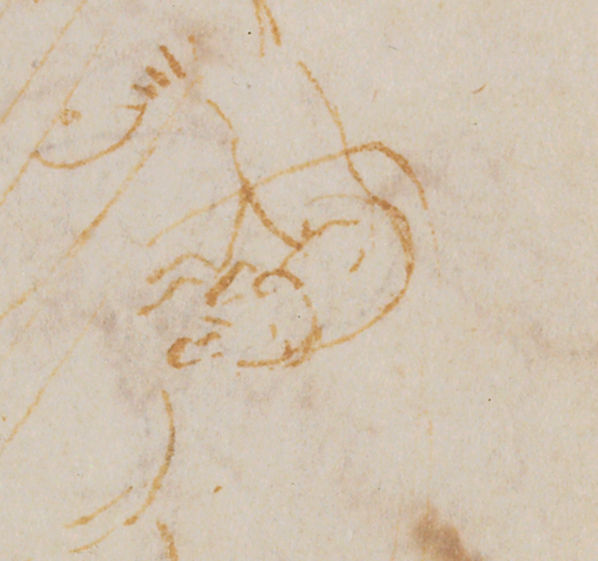
Wallraf-Richartz-Museum & Fondation Corboud, WRM, Z 02003, Leonardo da Vinci, Feder in Braun über Spuren von Silberstift, 22,2 x 18,4 cm
Above, Fig. 14: Leonardo, Study of figures for The Adoration of the Magi, detail of scribbled hand, Köln, Wallraf-Richartz Museum (see Fig. 13).
A last example of the usefulness for an art historian to be familiar with art practice seems necessary here although it is one about a cleaning tragedy. When the world-wide restoration controversy concerning the cleaned Michelangelo ceiling in the Sistine Chapel started in the late 1980s, I had doubts about the full pertinence of James Beck’s position: his objection was that the retrieved fresh and acid hues underlying the dirt and the glues laid in the course of time over the masterpiece’s surface were not what Buonarroti had wanted, and so, that he had toned them down and modelled the forms’ volume a secco with added layers of black bound in animal glue (Fig. 15A and B). Whether this was the case or not, the rather brownish and dark aspect of the frescoes before the intervention, which I had first seen as it stood in 1966, could be accepted as a likely hypothesis. Nevertheless, Michelangelo’s vivid palette’s range of colours was a well-known one, firstly because the Tondo Doni (Florence, Uffizi), cleaned c. 1993 – and so, gently – shows colours in full accordance with the Sistine Chapel ceiling, secondly, because, to some extent, they are close also to those of Domenico Ghirlandaio, Michelangelo’s master, a fact notably testified by Domenico’s fresco cycles in the Palazzo Vecchio (Sala dei Gigli) and in Santa Maria Novella (Tornabuoni Chapel) in Florence [Fig. 16 A and B]. Given that the debate was far too hot and complex I long stood off it, while strongly doubting the pro-cleaning camp’s theory whereby Michelangelo would never have made any a secco adjustments in the ceiling. For many reasons, that was indeed a bold and questionable argument in the light of art practice: no artist, even such an outstanding genius fresco painter like Michelangelo, could ever manage to cover a surface of 1200 square metres – the approximate size of the Sistine Chapel ceiling – with paintings without having to adjust part of his work here and there a posteriori. It definitely is an inconceivable material and human achievement and the impossibility of carrying out such a mythical feat is alone, of necessity, the strongest argument in favour of James Beck’s and Michael Daley’s position. Since the publication of both authors’ book, Art Restoration – The Culture, the Business and the Scandal, in 1993 and in 1996, and Prof. Beck’s death in 2007, Daley has step by step further developed his original reflections on the issue (as first published in The Independent on Sunday – “Michelangelo: Found or Lost?” – 25 March 1990, and the Independent – “A crime against the artist” – 22 November 1991), using visual demonstrations that leave no doubt about the unfortunate suppression of Michelangelo’s a secco retouching, whether it be, here, cast shadows, elsewhere, strengthening in the volumetric modelling of the biblical figure’s monumental anatomies and draperies (- see “Misreading visual evidence – No 2: Michelangelo’s Sistine Chapel Ceiling”). The fact that the restoration team “discovered” later on that Michelangelo has practiced a secco painting in the Last Judgement, and strangely not in the ceiling, although the same buon fresco technique and process was followed, makes it an open and shut case of the entire cleaning project’s technical misconception and miscarriage. [16]
Above, Fig. 15: A (left), Michelangelo, The Sistine Chapel ceiling before cleaning; B (right), Michelangelo, The Sistine Chapel ceiling after cleaning.
Above, Fig. 16: A (top), Michelangelo, The Holy Family (The Tondo Doni), c. 1504, Florence, Galleria degli Uffizi; B (above), Domenico Ghirlandaio, The Marriage of the Virgin, 1486, Florence, Santa Maria Novella, Cappella Maggiore.
Above, Fig. 17: A (top left), Michelangelo, detail of Jonah on the Sistine Chapel ceiling (before cleaning), B (top right), Michelangelo, detail of Jonah on the Sistine Chapel ceiling (after cleaning). The cast shadow of the Prophet’s left foot has been practically cleaned off during the restoration. The putti in trompe- l’oeil sculpture supporting the fictitious cornice have also lost much modeling and volume through that regrettable intervention. C (above), Giorgio Giulio Clovio (1498-1578), Copy of Michelangelo’s Prophet Jonah in the Sistine Chapel, Rugby Museum of Art, Rugby, England. This contemporary drawn record of Michelangelos frescoes, proves that the cast shadow attached to Jonah’s left foot had indeed been present from the beginning. It was also recorded in the subsequent copies of the Jonah that were made from the 16th century onwards [see The Sistine Chapel Restorations, Part III: Cutting Michelangelo Down to Size.
V – The still missing artistic-technical critical edition of Leonardo’s Trattato della Pittura
Leonardo had intended c. 1490 to write a treatise on painting which he sketched out in the Manuscript A kept in the Institut de France. This enormous book of various texts and themes of research, illustrated with original drawings, was never published in his lifetime, but his pupil and assistant Francesco Melzi (c.1491- c.1570), who had inherited all the master’s manuscripts and drawings in 1519, compiled the material c. 1530 from eighteen of the manuscripts in order to prepare the publication of Leonardo’s Trattato. This did not occur in Melzi’s lifetime either but the earliest compilation in existence, the Codex Vaticanus Urbinas Lat. 1270, also called the “Codex Urbinas” or “Libro di Pittura”, is kept in the Biblioteca Vaticana in Rome since c. 1640 [Fig. 18]. Its full text was first published in Rome by Guglielmo Manzani in 1817 while the first critical edition was published by Heinrich Ludwig in Vienna in 1882. Since then, many critical and facsimile editions have been issued, one still recent being the joint work of Carlo Pedretti and Carlo Vecce (Florence, 1995). As is the case for such specialized editions, the authors have focussed on the restitution of the full text through an effort of strict paleographic/ philological/ lexical accuracy, with the necessary reference to Leonardo’s original manuscripts from which these texts were compiled, and to critical editions such as Ludwig, 1882, the facsimile McMahon edition with English translation (1956), or Pedretti’ s “Leonardo’s Lost Book (Libro A)” of 1964 [17]. When I started consulting the Codex Urbinas for my research systematically, I soon realized that another type of critical apparatus was missing, the more so as the book is a treatise on painting, that of a technical commentary of all the specific matters dealt with by Leonardo in the Trattato. I do not mean just literary, theoretical and contextualized views on those matters but ones enriched with pragmatic observations tested out in practice and checked by experimented art teachers, chemists, opticians, etc. of our day. This was no unrealistic expectation on my part: not to speak of Pedretti’s critical comment of Leonardo’s sheets of Anatomy published jointly with a physician, Dr Kenneth Keele in 1978-1980, such a type of edition exists for Cennino Cennini’s Il libro dell’arte, more precisely the Neri Pozza one (Vicenza, 1971 and 1982), which is annotated by Franco Brunello, a chemist specialized in pigments and dyes [18].
Above, Fig. 18: The Codex Urbinas lat. 1270, Rome, Biblioteca apostolica vaticana.
The necessity for this technical edition of Leonardo’s Trattato had appeared to me when I came across a well-known – yet supposedly enigmatic – case of perspective analysed by Leonardo that has been debated over many years, roughly since 1927 up to 1978 and later, with the involvement of such specialists as Irwin Panofsky, Irma. A. Richter, John White, André Chastel, Carlo Pedretti and James S. Ackerman, in particular. The case in question implies the distance of the artist’s viewpoint from the represented object, a problem that the painter must settle with care because linear perspective generates lateral distortions (should the object’s shape be a long horizontal one, for instance) when the viewpoint is too close and exceeds a visual angle of 90°. [Fig. 19] As demonstrated by both Pedretti (1963) and Ackerman (1978), Leonardo was aware of it, specifies which viewing position is the ideal one, and, consequently, has never invented a mysterious – and convenient system (“curvilinear” perspective is evoked in the debate) – specially intended for solving the case. Yet the long lasting disputa over the issue could have been avoided thanks to some basic investigation into the drawing-from-life techniques still taught in fine art schools when the debate took place: like Leonardo before them, and so from a multi-secular tradition, all the art teachers of the period knew the rule to be respected in this connection.
Above, Fig. 19: [After Didier Bessot “Léonard de Vinci et les distorsions perspectives”, Léonard de Vinci entre France et Italie ‘miroir profond et sombre’, Caen, 1999, p. 37-54, Fig. 1, p. 41]. Piero della Francesca, De prospectiva pingendi, libro 1, proposition XXX. The problem of the viewing angle (LM > L- 21 = LK and LM, image of KL > 21-F, image of 21 – B) dealt with by Piero : in order to avoid lateral distorsions, the viewing angle in a perspective construction should not exceed 90°.
Another drawback, so to speak, is the fact that the various technical topics contained in the critical editions of Leonardo’s Trattato are thought to be utterly comprehensive, their artistic sense and function included, whereas what is clarified in this particular field is at best of literary order (etymological, etc.) and not their factual role within a given creative process, thus allowing a shift in meaning that will necessarily distort the historical veracity of the literary source and the correct understanding of the evoked techniques. That is the case with sfumato, meaning “smoky” or “misty” – more precisely a vaporous looking pictorial effect having no distinct boundaries. It is a nominalized past participle of the Italian verb sfumare (to smoke) which studio vocabulary has made become a noun through the centuries; sfumato is now commonly used to describe, not only Leonardo’s soft-focus effects as observed in the Mona Lisa and his late paintings, but the relating technique also. In my essay of 2014 about technical practice in Leonardo’s workshop, I have signalled that sfumare, utilized many times by Leonardo to describe this otherwise ageless technique (that of blending the tones to achieve impalpable, blurred, gradations between light and shade), was employed already in the late 14th century Italy, by Cennino Cennini [19]. Picking up the concerned passage in my above-mentioned peer checked essay, yet with no mention of my name although I had sent him a copy of the academic review in which it was published, Martin Kemp now attempts to demonstrate that sfumato is not a suitable term, historically, to evoke the various concepts underlying Leonardo’s blurred effects and the relating technique of execution [20]. I naturally disagree, because what prevails in such a case is usage – and particularly so when a very ancient one. In old master tradition and workshops the terms used referred to precise artistic-technical data (here a painting process), whose specific meaning is grasped correctly by artists alone, like a musical code or of any other sort, for it is a specialized lexis. Searching a ready-made academic sense within traditional workshop usages and terminology – as if for some catch-all mathematical formula – is therefore pointless and a mix of genres. In this arena, unspecialized parties, inevitably, cannot but misinterpret the highly technical data inherent of studio practice recorded in ancient literature, which, naturally, need instead the methodical examination/interpretation and eventual testing out in practice by truly experimented practitioners – which Kemp is not – to be explained properly (hence the scholar’s missing crucial information borne in the texts quoted either in his own essay on sfumato, or from Leonardo on technique, as we shall see below). Whatever the case, given its long existence, the ancient usage of sfumare and of its derived terms (including sfumato) in art is nothing to be rejected: we can well see that that verb’s technical sense, a generic one when it applies to the art of painting, is the same when it is used by Cennini, by Leonardo and by Filippo Baldinucci (c. 1624-1696) indifferently over a period of four centuries. And since Leonardo, writing about technique in the Trattato della Pittura, describes a method of melting the tones to make them look smoky, one can hardly imagine that the words employed do not mean both the rendered effect and its technical process, as is evident in this eloquent – and most famous – passage of the Codex Urbinas (Pedretti/Vecce edition, op. cit. supra note 17, § 514): “and when the flesh paint is wet, [using soft brushes] you will make the shadow smoky as you please (…) When your sfumato is made, let it dry” [21].
This well-known text clearly shows that we are faced here with a sfumato process which I call “the simple blending of tones” or “the simple fusion of colours” [22]. In effect, Melzi’s transcript of Leonardo’s recipe informs that the paint material to be made look fumoso (misty, blurred, etc.) is “wet” and that it is handled with “soft brushes”. It is precisely the state in which the paint material should be so that such a process can be performed while a soft brush will allow its adequate achievement. Called blaireautage in French, it is, as we now know, an ageless technique in which the paint film is gently “blended in” in the sections to be unified visually, in particular where the impalpable transitions between light and shade must be depicted [23]. The simple blending, however, is not by far Leonardo’s most subtle sfumato technique, because the specific technical gestures involved cannot produce microscopic transitions on very short distances, measurable in tenths of millimeters, like those seen in the Mona Lisa, for example [24]. In that particular case, the soft brushes used for the blaireautage (simple blending of tones) are far too large and inadequately shaped: painters necessarily employ brushes and paint strokes whose dimensions and shapes conform to the scale of the details to be reproduced. Consequently, the technical problem examined here is a clear-cut one: while soft, rather large and flat brushes are used to achieve the blaireautage (type 1 sfumato effect), very fine brushes with a sharp tip alone are required to achieve the “complex blending” (type 2 sfumato effect). In other words, neither of those distinctly sized and shaped brushes can replace the one meant for its specific technical purpose, whether it be for the sfumato effects type 1 or type 2. One can now understand why art historians strange to practice, unless properly informed, should not speculate on painting techniques as complex as that of Leonardo, given their deep ignorance of how artistic craftsmanship functions in the real. Except specialized artists, not many people can discern visually the important difference of refinement, hence of technique, regarding those micro-distances when examining the Leonardo works, notably the Mona Lisa, in which either type of sfumato process was followed: to some eyes, obviously untrained, all blurred effects seem to correspond to one and a same one, apparently.
Above, Fig. 20: Leonardo, The Lady with an Ermine, c. 1489- 1490, Cracow, National Museum.
Leonardo has practiced the simple blending in works like the Lady with an Ermine (Fig. 20) or the London Virgin of the Rocks, a process that X-radiographs reveal distinctly due to the amount of lead white (an X-ray proof pigment located very distinctly on them) needed for the lights in this technique (see Further Thoughts I, Fig. 27a and b). Despite this telling example, Kemp insists: “we should be aware that the term [sfumato] is an artefact of art history not a quotation from Leonardo [25]. Furthermore, quoting Baldinucci’s Vocabolario (1681) to make his point, he seemingly is unaware of the fact that this author contradicts it. In effect, Baldinucci’s text describes the standard sfumato technique, or blaireautage, used in his time, not the very complex and spectacular one handled by Leonardo in the Mona Lisa and the Sainte Anne (see Further Thoughts II), which, as we know, is an entirely different one in terms of making process. The 17th century Florentine biographer of artists actually says: “[sfumare, To unify colours] (…) after having put the colour in its place on the canvas or panel, in order to remove all crudeness of the touches, sweetly mingling the light tint with the middle tint or the middle tint with the dark, so that the passage from one to the other is made with such gradation that even from close the painting appears without brushstrokes” [26]. The choice of Baldinucci’s text is therefore of little pertinence here with regard to that of Leonardo’s extant ones on technique, or compiled by Melzi: it was published in the late 17th century, 162 years after Leonardo’s death and does not describe his technique as such in the least way, but, rather, the generic artistic gesture of sfumare as executed then (thus implying slight variations from the early 16th century practice of that technique) in order to unify visually the raw effect first obtained in the execution, and to smooth down the paint surface at the same time. Although Kemp asserts authoritatively that “Baldinucci sets the right tone” [27], his credibility is nonetheless at risk when hypothesizing without any evidence or reliable experience of practice that it was the technique used in the Mona Lisa. For Baldinucci’s description also informs that fresh paint is handled, which necessarily implies the practice of blaireautage or “simple blending”, in which the fresh paint strokes are mingled and smoothed down in a sort of delicate back and forth sweeping movement done with a soft brush. All of which is far too simple, technically, to explain anything as prodigiously complex as what is seen in the Louvre’s iconic picture: as now proven by X-ray fluorescence and visual observation (see Further Thoughts II), what is typical of Leonardo’s flesh technique in the Mona Lisa (the “complex blending of tones”) is that it needs a dry underpaint and not a wet one to be proceeded with: it is therefore, basically, a dual operation and not a single one. The visual abolition of the touches (hatches, strokes, etc.) is far more gradual in the complex blending: thin veils of liquid translucent paint are laid over each painting session when it is dry until the paint surface appears perfectly smooth and even. About twenty of such veils have been detected in the Mona Lisa thanks to X-ray fluorescence tests, thus revealing an extremely elaborate and subtle making that justifies my description of two distinct procedures in Leonardo’s sfumato technique (see Further Thoughts II). While the term sfumare is fully appropriate to the first one, the second one’s complexity results from the systematic superimposition of veils (whose nature and typology vary greatly): velare (to veil or glaze/soften the rawness of tones in Italian) has therefore all the reasons to be employed in that case instead of sfumare. A century before Baldinucci, or nearly so, it is presumably why Giovanni Paolo Lomazzo (1538-1592), who had met Francesco Melzi (Leonardo’s closest pupil) and gathered then precious information about Leonardo, described in 1590 the master’s sfumato technique as “veli sopra veli” (superimposed veils), a better designation than sfumare with regard to the overall line of making observed in the Mona Lisa [28]. Additionally, the complex blending observed in the Mona Lisa corresponds without contest to Vasari’s report on the portrait (who never saw it but its description was obviously borrowed from Melzi): “Leonardo undertook to execute, for Francesco del Giocondo, the portrait of Monna Lisa, his wife, and after toiling over it for four years, he left it unfinished (…) in it were counterfeited all the minutenesses that with subtlety are able to be painted” [29]. Should Leonardo have employed the blaireautage process, an easy and quick one, the end result would be far less subtle and, for that reason, the work would have been finished within four to six months at the very most: applied to the Mona Lisa, that technical interpretation has therefore, I am afraid, no historical likelihood.
Reverting to the arbitration of practice, which is the best means for checking the pertinence of theories in matter of painting techniques, the reader must know that no copy resembling the Mona Lisa very closely (which would be evidence of the appropriateness of the technique used), could ever be produced employing Baldinucci’s recipe, and, knowing the subject extremely well from decades of experimentation, I defy any skilled artist to perform such a challenge [30]. Finally, the fact that Leonardo’s sfumato lies on optical concepts more particularly than that of other artists is no evidence of the term’s historical inaccuracy with regard to the Master’s blurred effects and correlated technique. And unless the texts compiled in the Codex Urbinas were proven in future not to come from Leonardo – a very unlikely eventuality – it can reasonably be admitted that sfumato was indeed a term used by him and his studio, whether occasionally or not.
VI – Interdisciplinary work: a salutary concept
Given the transverse (multidisciplinary) character of old master expertise, nobody would expect that one and a same specialist be simultaneously familiar with archival research, well versed in academic art practice, in restoration techniques, and that the physics and chemistry of paints hold no secrets for him. Yet, the entire knowledge contained in those distinct disciplines is necessary to approach adequately the works’ full facets, whether historical, artistic or material. As explained in the first chapter of this essay, specialized artists, unless they are conservators, have no recognition as art experts, and, although it is unjustified, since illogical, aesthetic-technical matters are assessed nowadays by parties (art historians and scientists) who are no specific experts in this field. In the past, about eighty years ago, conservators were most of the time academic artists who could not make a living out of their activity and had taken up restoration to secure themselves an income. This was notably the case with Jean-Gabriel Goulinat (1883-1972), seriously trained in the Paris national Ecole des Beaux-Arts, and Jacques Maroger (1884-1962), who made careers in 1930-1960 at the Louvre (Maroger in part only): it was a blessed period during which, the then head curator of Paintings, René Huyghe (1906-1997), had, jointly with Cesare Brandi (1906-1988) – the world reputed Italian theorist of conservation – defined a highly tactful conservation policy for the restoration of France’s and Italy’s old master heritage [31]. At that time, the restorers were fully trained artists who were able to advise on the Louvre’s restoration committees and, eventually, point out to aesthetic-technical data that would contribute decisively towards the successful outcome of conservation projects. Significantly, the Louvre Leonardos had hardly been touched up, with the exception in the late forties-early fifties of the Sainte Anne, whose conservation report is very telling on the discreet cleanings undertaken in those days. Progressively, this way of proceeding was thought outdated and, worse, by the late seventies, in university and museum circles in France and elsewhere, it came to be considered that artistic advice on restorations was subjective, inadequate, and that scientific analysis and art historians alone could determine safely where the authenticity of paintings lies. In these times the work of art ceased to be the pre-eminent, intrinsic per se source of information on significant artistic and technical data about itself, in the way that musical scores were – and still are – regarded by musicians. Thus works of art became objects of unclear identity and quite divorced from the traditional artistic criteria that had remained in force from the Renaissance until our own times. In consequence, anarchic views prevail to date on the authentication and destiny of works of art.
In 1983, I was hired by a private conservation institute in Paris (Institut d’Art Conservation et Couleur) which was run by both the then leading Louvre conservator Sylvaine Brans and Prof. François Parra, an international State authority on Optics and the physics of colour [32]: the institute was training student restorers and my role was to instruct them on old master techniques because, while their technical capacity to preserve and repair paintings materially was satisfactory, practically none of them had ever learnt to draw and paint and, therefore, knew much, to say the least, about the aesthetic-technical side of art. In 1986, I pursued a similar teaching job to student restorers for fifteen years within another professional framework: many of them intended to access international schools of restoration (IRPA in Brussels, IFROA in Paris, ICR in Rome, etc.). From this experience I am ipso facto closely acquainted with the ins and outs of painting conservation (artistic aspects) and, more specially, with the fact that – bar exceptional cases – the majority of today’s restorers cannot face the complexities inherent of this discipline where properly speaking artistic matters bringing up any difficulty are concerned. Although I ignore whether it was and has been the case with leading museums in the world at all times, the Louvre was certainly aware of this problem in the mid-eighties when my research first got some marked support from René Huyghe, then still chairing the Museum’s national committee for restoration and from Alain Erlande-Brandenbourg, the then main assistant to the Head of the French museums (DMF).The team in charge of the Louvre’s conservation studio was a brilliant one in those years, notably under the heading of Gilberte Emile-Mâle and that of her successor, Curator Ségolène Bergeon, a disciple of Prof. Paul Philippot (1925-2016), who, himself, was a reputed theorist of conservation, a university professor in Brussels and the head of the Rome ICCROM. Both an art historian, a scientist and an IIC Fellow, Bergeon had long understood that painting restoration is a transverse discipline calling for a combined, qualified and joint expertise drawn from art history and academic artistry applied to conservation, and, of course, science, the ideal objective hereupon being to limit as much as possible the subjectivity of such an action in order to better preserve the work’s material and spiritual integrity. Hence Bergeon’s early commitment in favour of interdisciplinary (or crossdisciplinarity) work in conservation, an early 19th century concept revived by both Brandi and Philippot – and later theorized by Madeleine Grawitz definitively – [33], advocating that the “threefold” expertise (history + art + science) needed to restore a work of art be practiced as a constant and mutual collaboration between the different professional parties dealing with the work’s conservation treatment. And this, unlike pluridisciplinarity, in which the concerned experts advise the restoration project separately, thus risking eventual conflicts between each individual position, no profitable dialogue over the problems raised in the course of the intervention and, as a consequence, that less or no attention is given to what the work really needs [34] (Fig. 21). Such a practice as interdisciplinary collaboration is demanding in terms of self-discipline, for it implies a humble attitude and the eventual renunciation to one’s feeling of professional superiority towards a given essential partner in the team as well as a sincere open-minded disposition to exchange with others for the sake of the work’s preservation. Unfortunately, such a disinterested and humanistic conception of a group’s working program is far from being an ideal shared in the museum world broadly. I once attended a Bergeon lecture on interdisciplinary work in 2003 at the Association des Historiens de l’Art Italien (AHAI) in Paris and was sitting next to a specialist of scientific imaging in the Louvre’s laboratory (C2RMF), an otherwise urbane and pleasant person who has left this institution long ago. When Bergeon’s intervention ended, Mr. X whispered in my ear this irritated comment: “For sure it’s not a line we shall ever bother to follow in our lab!”
Above, Fig. 21: [After Ségolène Bergeon Langle and Georges Brunel, La restauration des oeuvres d’art, Vadem-mecum en quelques mots, Paris, p. 205, Interdisciplinarity and pluridisciplinarity].
Diagrams showing each discipline with a specific colour (1 blue = physics, 2 yellow = artistic/technical-craft, 3 red = human sciences). In the case of interdisciplinarity (in the context of a conservation project), the three disciplines are in constant mutual dialogue and the end result is a fully informed product. In the case of pluridisciplinarity, the juxtaposition of partial actions from distinct specialists (physics, artistic/technical-craft, human sciences) does not deliver a unique and fully integrated product.
VII – By way of conclusion
Although what precedes remains schematic and incomplete, it is obvious that the artist’s place and of everything that is intrinsic to the artistic, creative phenomenon, is not at the heart of art expertise and conservation any longer, a situation which has been lasting for several decades now to the point of having become a de facto tradition. The causes of this are many: one of them is the decline, if not outright abandonment, of teaching the multi-secular academic rules of drawing and painting in the European fine art schools as from the sixties onwards; another being the nonsensical, demagogic belief that has developed in parallel worldwide under the influence of the various trends of modern and contemporary art whereby anybody can be an artist – an idea open to discussion, perhaps, with regard to today’s creative concepts, but one which cannot sensibly be backdated so as to apply to classic art, whether historically, conceptually or technically. Such a global cultural development has necessarily lowered art’s spiritual level down to criteria that oppose its fundamental identity which cannot be dissociated from its traditional, long-prevalent art practices in an attempt to convert it into what it is not and has never been. In such a confused cultural context, the situation has, in the mind of some scholars, so evolved in the last twenty years as to dissolve any distinction between art history as a discipline, which is a branch of history, nothing else, and art practice itself. A number of art critics occasionally seem to believe (see Further Thoughts II ), that their own self-contained (i. e. divorced from artistic practice) visual appraisals of a painting visually are sufficient to understand it thoroughly – including the various processes of its making – as if they themselves had painted it. I have come across a number of such cases in the museum world recently, in three of whom the self-delusion, if not pathological, had reached such a paroxysm that no evidence of any sort, either visual or scientific, proving the inconsistency of their position, could bring them back to reality. They just could not accept it. The origin of this alarming emerging syndrome of “virtual” or “imaginary scholar-painters” lies in the dogmatic conviction that a given qualification in art history sanctioned by some power, either scholarly or curatorial, confers both infallibility and an automatic access to the full knowledge of art and to what its creative methods consist in. There is here an abusive appropriation of the authority traditionally and rightfully conferred to artists through their demonstrable mastery of the creative process, a field strange to both art history and science. In other words, to some extent and more than symbolically, art is not in the hands of art any more but in those of institutional parties having no direct experience of it, who cannot but transliterate it in a language of their own presented as the truth, whether rightfully or not according to circumstances (see § V above).
Sense and reason help to grasp the point in case clearly: the best way to know anything sound and factual about art is to draw, paint or sculpt. And the best way to penetrate into the aesthetic-technical creative intimacy of an old master painting is to make a faithful copy of it, and eventually one whose appearance is practically analogous to that of the original. In so doing it is possible that the making process will not be the very one followed by the creator himself, whether it be Rembrandt or Rubens, etc., but it might well be the case indeed, as I have succeeded to prove with Leonardo’s sfumato technique through decades of painstaking research and thanks to critical copy-work in particular (see Further Thoughts II). In addition, when a copy resembles the original closely, the copyist has at least demonstrated his (her) direct, tangible – and not imaginary – experience of the essential aesthetic-technical data constituting the original work’s appearance: nobody can in good faith deny that this is a priceless knowledge, a reality that no virtually informed speculation on technique will ever match or challenge. Because what decides between opinions here, i. e., one strictly conceptual and immaterial, and another one tangibly visual and material, is, in the latter case, evidence of art as opposed to theoretical verbiage about it [35].
Above, Fig. 22: A, left and right – Jacques Franck, critical reconstruction in four stages of the Mona Lisa’s left proper eye; B – Jacques Franck, free copy in oils after the St. Anne in the Burlington House Cartoon (London, National Gallery).
This very point explains why my research on Leonardo’s painting technique has been so reluctantly accepted, if at all, in those circles: notwithstanding the providential support from specialists of an unsurpassed competence such as René Huyghe, Carlo Pedretti, Federico Zeri, Ségolène Bergeon Langle or Jacques Roire (physicist and chemist), the issue of Leonardo, effectively, is considered their exclusive property, so to speak, and therefore one “forbidden” to an independent scholar’s artistic research like mine, regardless of the deployed skills and of the related visual demonstrations of scientifically proven pertinence (Fig. 22 A and B). By the same token are explained also the attacks that have suddenly flourished in my back from the very moment I opposed the attribution of questionable graphic compositions to Leonardo and the serial restorations of the Louvre Leonardos and, in particular, campaigned against the participation of the originally New York, then Russian, now Saudi Salvator Mundi in the Louvre Museum’s 2019 blockbuster exhibition as an authentic da Vinci painting [36] (Figs. 23 and 24).
To sum up, the Establishment’s disregarding of and opposition to any, properly-speaking, artistic and pragmatic means of research concerning the technical issues requiring elucidation in the art of painting is a clear sign of our society’s weakened understanding and loss of respect of the meaning of art, whether or not it is the remote consequence of Dada, “art brut”, relativist theories, art negativism, the postulate whereby anybody is a potential artist or, worse, of the sophist claim that “science can explain art”. Assessing the innumerable PhDs produced by the history of art scholarship each year, one can easily notice that, more often than not, it is becoming a strictly speaking literary activity in which the art work serves to support questionable theories, intellectual elaborations substituting their virtual reality for its own, factual one. Statistically, little archival research is made, which explains why so few documents about Leonardo have emerged in the past century. Concerning Leonardo studies, beside the “classics” (including Frank Zöllner’s catalogue raisonné), what remains and catches attention are of course the comprehensive publications on different topics from scholars like Carmen Bambach, Alessandro Ballarin, Carlo Vecce, Edoardo Villata, or more specialized ones, notably in matter of Leonardian bibliography (I cannot but mention the brilliant Silvia Fabrizio-Costa in this respect) [37], which are references constantly used for working on a subject like technique, an issue needing solid historical documentation. Yet, in some of those works, when the pictorial techniques are evoked, the painter’s viewpoint is skimmed over, while nobody, to my knowledge, manages to achieve any appropriate art critical distance from the end results of restorations like that of the disappointing Last Supper in Milan, for example. [38] (Figs. 25, 26 A, 26 B and 27). Naturally, given the hot nature of the polemics over questionable restorations, were they brought back to serene, scholarly debates and exchanges, these projects being mostly under State control, no museum curator or university official – or very seldom – will accept to speak out in the open to express objections. But then, who will want to save and rescue the Art Planet, if these powerful VIPs won’t point out to what they know should be contested in order to help salvage the world’s Heritage?
Many years ago James Beck and Michael Daley, in Art Restoration – The Culture, the Business and the Scandal (1993, 1996), denounced the progressive disintegration of the ethical standards and morals in the art world whereby the artistic treasures of the universal Heritage are commercially exploited against their basic spiritual and physical interests through vicious cycles of money making exhibitions and/or needlessly risky restoration projects that have become a self-perpetuating world-wide industry. Such attacks on the most essential icons of our civilization’s very soul run in strict parallel with and proceed from the same logic of the frames of mind that cause the attacks on Environment which, inexorably, are destroying the planet. More recently, Ben Lewis’s book The Last Leonardo, and two documentary films about the shattering saga of the Saudi Salvator Mundi have sadly proven that Beck’s and Daley’s voices of 1993 have been little heeded. Arguably, the toxicity of the art world has worsened in the last twenty years as an escalating abundance of unjustifiably upgraded works, whether paintings, drawings or sculptures, are presented as lost or misattributed Botticellis, Raphaels, Leonardos or Michelangelos, etc. when, in truth they are at best studio works or late school items – and sometimes outright fakes, as was the case with a notoriously freshly imitated “Frans Hals” lately [39]. The curatorial obsessions of museums regarding the “cleanness” of the privately loaned works exhibited in the international shows provoke severe – yet too rare – admonitions from museum figures who have retained an inflexible sense of ethics. In the documentary The Lost Leonardo, reporting on the London National Gallery’s role in the tangled story of how the (New York to Saudi) Salvator Mundi emerged from obscurity before being sold for $450m, Professor Bernd Lindmann, the then director of the Gemäldegalerie in Berlin, tells Andreas Koefoed (the co-film maker): “I was surprised to see the painting in the [2011 Leonardo] exhibition at the National Gallery. It is a problematic painting and I think it’s not the role of serious museums to present a painting which is so heavily discussed”.
Above, Fig. 23: [After Achademia Leonardi Vinci, Vol. X, 1997, p. 269]. Nomination of Jacques Franck as Consulting expert to the Armand Hammer Center for Leonardo Studies at UCLA by Carlo Pedretti (see note 36 below ).
Above, Fig. 24: Email from Carlo Pedretti of 16 January 2016 expressing his will that Jacques Franck be Permanent consultant of his newly established Foundation. A printed version of which (here) was confirmed again by Pedretti’s signed and annotated approval of 27 November 2017, six weeks before the great Leonardo scholar’s decease on 5 January 2018 (see note 36 below).
Above, Fig. 25: Leonardo, The Last Supper, 1497, Milan, Santa Maria delle Grazie.
Above, Fig. 26 A: Leonardo, The Last Supper, detail of St. Philip. All that remains of the original work are small scales of colour appearing the more saturated ones on this image of St. Philip – which is possibly the best preserved figure in the mural. Surrounding the surviving shards of paint, whether red, flesh pink, blue, brown, or black, the paler tones constitute the considerable retouching (called “inpainting”and compensating for the lacunae), that was necessary to make the composition both visually consistent and fit to be seen by the public of visitors. The missing original paint can therefore be assessed around 60 to 80% in Leonardo’s Last Supper.
Above, Fig. 26B: Leonardo, The Last Supper, detail of St. Philip. This close-up on the apostle’s head shows distinctly the huge areas where the original paint is missing. Compare with Fig. 27 below.
Above, Fig. 27: Giovanni Pietro Rizzoli, called Giampietrino, copy of The Last Supper, c. 1520, The Royal Academy of Arts, London.
It is in this context of the Art Planet, clouded by the constant emergence of disputable, opaque, interests, that I publish my recent investigation of the “no book” titled Léonard de Vinci. Le Salvator Mundi, published by the Louvre in December 2019, while withdrawn immediately from the Museum’s bookshop without any explanation, but of which photocopies have circulated in the Leonardo scholarly “microcosm” and in the international press earlier this year. An essay presenting the Saudi Salvator Mundi as a work fully painted by Leonardo based on scientific arguments which, in my opinion, are anything but acceptable; I therefore have thought it my duty for the truth’s sake to discuss them in-depth and openly below, so that the reader can understand why the French government has considered it essential not to publish them and, as a consequence, not to support the work’s attribution to Leonardo either.
Jacques Franck, November 2021.
ENDNOTES:
Note 1: Cf. Jacques Franck, “De la formation artistique en conservation-restauration des peintures anciennes: évoluer, pourquoi, comment”, Coré, n° 4, avril 1998, p. 53-59.
Note 2: Cf. Léonard de Vinci, le chef-d’œuvre redécouvert, documentary movie broadcast on the French/German TV channel Arte on 13 November 2019. The title of this movie is interesting inasmuch as the rediscovered “chef-d’œuvre” in question (“masterpiece” in English) is in fact the American version of The Madonna of the yarnwinder of c. 1501-1510 (New York, private collection), a well-known Leonardesque painting, here ambiguously upgraded as by Leonardo himself following its recent cleaning, yet still deserving the traditional attribution to a Milanese pupil since it doesn’t comply with the artistic standards usually encountered in original Leonardos.
Note 3: Stricto sensu glazes are perfectly transparent layers of tinted paint, mostly used to brighten or deepen the tone of the underlying layer or to modify it: a bright transparent blue glaze laid over a yellow underlayer will thus create a green visually. Given that the flesh tones cover a range of pale, opalescent pinks, some white and added touches of relatively opaque pigments must be employed instead of transparent ones – while much diluted – in the meticulous oil techniques encountered in the late 15th century Italian schools, the result of which is a translucent, thin veil-like paint film, hence the term of velatura (veil) in Italian. For the physics of glazes, see Ségolène Bergeon and Pierre Curie, Peinture & dessin, vocabulaire typologique et technique, 2 vols., Paris, 2009, vol. 2, p. 738.
Note 4: Cf., successively, my following articles addressing this particular issue: “The Unrestorable Sfumato“, Achademia Leonardi Vinci, vol. VI, 1993, p. 238-241; “L’analyse esthético-technique des peintures de chevalet anciennes”, Science et Technologie de la Conservation et de la restauration des oeuvres d’art et du patrimoine, n° 3, septembre 1993, p. 5-50, p. 33-41; “Vinci au Louvre. Restauration de la Sainte Anne: suspension du chantier”, Double Liaison, physique, chimie et économie des peintures et adhésifs, t. XLII, n° 467-468, 1995, p. 29-33; “The Mona Lisa: Should a Myth be Restored?”, Achademia Leonardi Vinci, vol. VIII, 1995, p. 232-236; “Pourquoi il ne faut pas restaurer La Joconde“, L’Estampille-L’Objet d’art, n° 328, octobre 1998, p. 26-33; “Why the Mona Lisa Might Not Survive Modern Day Conservation Treatment”, The Proceedings of the Art, Law and Crises of Connoisseurship Conference, held at the Society of Antiquaries of London, 1 December, 2015, ArtWatch UK Journal, n° 31, 2017, p. 18-31 (hereafter ArtWatch Conference, 2015).
Note 5: This is notably the case in the Louvre’s Virgin and Child with Saint Anne (the Saint Anne), in which St. Anne’s face, displaying subtle transitions between light and shade comparing the impalpable effects in the Mona Lisa, betrays the presence of Leonardo’s “complex blending”, thus explaining the very thin, flat and translucent paint layer in that section where very poor quantities of lead white were used (unless in very small quantity, the latter pigment is inappropriate to this type of technique). Conversely, the Child’s face contains lead white in the lights substantially, and so in accordance with the far less complex, traditional blending of tones (see below chapter V, the passage about Leonardo’s sfumato technique).
Note 6: Cf. respectively, Léonard de Vinci, Paris, musée du Louvre, 24 October 2019 – 24 February 2020, catalogue by Vincent Delieuvin and Louis Frank (hereafter Paris, 2019-2020); Jean-Pierre Mohen, Michel Menu, Bruno Mottin et al., Mona Lisa. Inside the painting, English. ed., Paris, 2006 (hereafter Paris, 2006).
Note 7: Cf. Paris, 2006, p. 88-89, figs. 146 and 148.
Note 8: Cf. Paris, 2006, p. 90.
Note 9: Cf. Paris, 2019-2020, p. 368.
Note 10: Cf. Mady Elias and Pascal Cotte, “Multispectral camera and radiative transfer equation used to depict Leonardo’s sfumato in Mona Lisa”, Applied Optics, vol. 47, n° 16, June 2008, p. 1-8. The conclusion of the essay states that “The diffuse reflectance spectra recorded by a multispectral camera after a virtual varnish removal prove that the sfumato of Mona Lisa is made of a single pigment with a small volume concentration, an umber, very common in Italy in the 16th century” (p. 8).
Note 11: Besides the note sent to the authors in June 2008, much dialogue occurred on the subject with Engineer Pascal Cotte when the latter was co-heading the French scientific laboratory Lumière Technology and, more recently, in emails exchanged with him on November 1st and December 1st, 2020.
Note 12: Cf. Michael Daley, “Art’s Toxic Assets and a Crisis of Connoisseurship”, ArtWatch online, 30 September 2014; Michael Daley, “Bertram Nicholls: Doing and Saying”, Jackdaw, March-April 2021, p. 16-19 (p. 18).
Note 13: Cf. Maria Teresa Fiorio, “Leonardo’s Portrait of a Musician and some reflections on his Milanese Workshop”, Leonardo da Vinci’s Technical Practice, Michel Menu editor, Paris, 2015, p. 153-161 (hereafter Menu et al., 2014).
Note 14: Cf. Ségolène Bergeon Langle, “L’appel à la science peut-il décevoir ?”/ “Can Science Deliver Its Promises To Art ?”, ArtWatch Conference, 2015, p. 38-47 (p. 42-43 and p. 46-47).
Note 15: Cf. Jacques Franck, “Léonard de Vinci. De la Sainte Anne de Londres à la Sainte Anne du Louvre: le véritable déroulement d’une création”, ArtItalies, revue de l’Association des Historiens de l’Art Italien, n° 25, 2019, p. 122-138, Introduction by Ségolène Bergeon Langle. Available on https:/www.academia.edu
Note 16: Cf. James Beck with Michael Daley, Art Restoration. The Culture, the Business, and the Scandal, 1st ed., London, 1993, 2nd ed. New York and London, 1996.
Note 17: Cf. Carlo Pedretti and Carlo Vecce, Leonardo da Vinci. Libro di Pittura. Codice Urbinate lat. 1270 nella Biblioteca Apostolica Vaticana, 2 vol., Florence, 1995; Carlo Pedretti, Leonardo da Vinci on Painting. A Lost Book (Libro A) reassembled from the Codex Vaticanus Urbinas 1270 and from the Codex Leicester, Berkeley and Los Angeles, 1964 (hereafter Pedretti and Vecce, 1995).
Note 18: Cf. Franco Brunello: Cennino Cennini, il libro dell’arte, annotato e commentato da Franco Brunello…, Vicenza, Neri Pozza publisher, 1971, reed., 1982.The problem raised here is a crucial one. Many essays dealing with Leonardo on painting (perspective as applied to art, colour theory, etc.) have been published in the course of years, a leading one being John Shearman’s “Leonardo’s colour and chiaroscuro” (Zeitschrift für Kunstgeschichte, 25, 1962, p. 13-47). While of great interest, these researches cannot but stand as strictly theoretical for want of methodical comparison with pragmatic data relating to traditional practice, to the secure interpretation of ancient texts on technique (see below the passage on Leonardo’s sfumato technique in the light of Baldinucci’s Vocabolario and Lomazzo’s Tempio), or to significant scientific – and indisputable – evidence.
Note 19: About sfumato, sfumare, fumosa, fummo ben sfumate, etc., see Jacques Franck, “La pratique du “micro-divisionnisme” dans l’atelier de Léonard de Vinci”, ArtItalies, revue de l’Association des Historiens de l’Art Italien, n° 20, 2014, p. 4-16, Introduction by Ségolène Bergeon Langle, p. 5-6, notes 6-8 included (hereafter Franck, 2014). Available on https:/www.academia.edu
Note 20: Cf. Martin Kemp, “Leonardo and Sfumare. More than Meets the Eye”, Paragone. Leonardo in Comparison, Johannes Gebbhardt/Frank Zöllner (Eds.), Petersberg (Germany), 2021, p. 155 -161(hereafter Kemp, 2021).
Note 21: “[Modo di colorire in tela] e dà l’incarnazioni con penelli di setole, e cosi fresche farai l’ombra sfumata a tuo modo (…) Sfumato che tu hai, lascia seccare”; C. U., fol. 161v, after a lost original c. 1490-1495; my translation.
Note 22: Cf. Jacques Franck, “The invention of ‘sfumato'” in exh. catalogue The Mind of Leonardo. The Universal Genius at work, ed. Paolo Galluzzi, Uffizi Gallery, Florence 2006-2007, p. 338-357 (p. 346 on “the simple fusion of colours”) (hereafter, Franck, 2006-2007); Franck, 2014, p. 6.
Note 23: cf. Franck, 2014, p. 5, note 8 included (blaireautage).
Note 24: cf. Franck, 2006-2007, p. 347 (“the complex fusion of colours”).
Note 25: Cf. Kemp, 2021, p. 161.
Note 26: Cf. Filippo Baldinucci, Vocabolario toscano dell’arte del disegno, nel quale si esplicano i propri termini e voci, non solo della Pittura, Scultura & Architettura; ma ancora di altre Arti a quelle subordinate, e che abbiano per fondamento il Disegno, Florence, 1681, p. 151 (facsimile ed. S.P.E.S., Florence, July 1985). For the English translation of Baldinucci’s full text on sfumare, see Kemp, 2021, p. 160.
Note 27: Cf. Kemp, 2021, p. 159.
Note 28: “Colorare di Lionardo] [dipingeva la forma umana] con una nobil furia di colorito (…) dandogli le ombre, & i lumi variatamente, con veli sopra veli” (“he painted [in the human form] the shades and lights in diverse ways with noble and impetuous colours, placing veils over veils”), my translation. Cf. Giovanni Paolo Lomazzo, Idea del Tempio della Pittura di Gio. Paolo Lomazzo pittore. Nella quale egli discorre dell’origine, e fondamento delle cose contenute nel suo trattato dell’arte della pittura, Milan, 1590, p. 49-50. Strangely enough, in the same essay (Kemp 2021) the author says (p. 160, note 24) that all the necessary analyses of Leonardo’s glazing (hence sfumato) techniques are presented in Leonardo da Vinci’s Technical Practice: Paintings, Drawings and Influence/ La pratique technique de Léonard de Vinci : Peintures, Dessins et Influence, ed. by Michel Menu, Paris, 2014, but despite excellent papers from serious specialists, among whom Elizabeth Walmsley (on the Portrait of Ginevra de’ Benci), Carmen Bambach (on scientific evidence in the study of Leonardo’s drawings), or Alan Donnithorne and Joanna Russel (on the “faded” metal point drawings in the Royal Collection), nowhere is found any such study in that publication.
Note 29: Cf. Giorgio Vasari, Lives of the Most Eminent Painters, Sculptors and Architects, Translated by Gaston Du C. de Vere, Introduction by Kenneth Clark, 3 vol., New York, 1979, vol. 2, p. 789.
Note 30: What precedes reveals the persistent conflict in art history between critical observation and, notably, the questionable belief that, in factual matters like technique, information from ancient treatises or documents can be deciphered effortlessly, theorized thanks to improvised rationales (i. e., strange to studio traditional practices) and then delivered to the academic world as sound, reliable truths without any experimental testing out – thus proving both whimsical and the obvious negation of methodical research.
Note 31: Cf. René Huyghe, “Le nettoyage des peintures”, Museum, vol. 3, 1950; René Huyghe, “le nettoyage et la restauration des peintures anciennes: position du problème”, Alumni, vol. XIX, 1950; René Huyghe, “Le problème du dévernissage des peintures anciennes et le Musée du Louvre”, Musées et Monuments, Unesco, Paris, tome II, 1951; Cesare Brandi, “Il Ristabilimento dell’ unità potenziale dell’ opera dell’ arte”, Bolletino dell ‘Istituto Centrale del Restauro, n° 2, 1950; Cesare Brandi, “Il restauro dell’opera d’arte secondo l’istanzia estetica o dell’ artisticità”, Bolletino dell’ Istituto Centrale di Restauro, 13, 1953; Cesare Brandi, Teoria del restauro, Edizioni di Storia e Letteratura, Rome, 1963.
Note 32: More specifically Prof. Parra specialized in the differential vision of colour.
Note 33: Cf. Madeleine Grawitz, Méthode des sciences sociales, Paris, 1975, 9th ed. 1993, p. 290-293.
Note 34: Cf. Ségolène Bergeon Langle et Georges Brunel, La restauration des oeuvres d’Art. Vade-mecum en quelques mots, Paris, 2014, p. 204-206 (Interdisciplinarité).
Note 35: On the matter of experience prevailing over whimsical theory, see Leonardo’s severe admonition to his contemporaries in the Codex Atlanticus, fol. 327 v (119 v-a), which roughly states that his works are “the issue of pure and simple experience, who is the one true mistress [whose rules] are sufficient to enable you to know the true from the false”, thus blaming “the authority of certain men held in the highest reverence by their inexperienced judgements”. Cf. Jean Paul Richter, The Literary works of Leonardo da Vinci. Compiled & Edited from the Original Manuscripts by Jean Paul Richter, 1st ed. London, 1883, revised ed. Oxford, 1939, paperback ed. New York, 1970, § 12.
Note 36: A noxious rumour circulated from 2012 onwards concerning my title and standing as a permanent consulting expert to the Armand Hammer Center for Leonardo Studies at UCLA (which title Carlo Pedretti conferred in 1997 and published in Achademia Leonardi Vinci, vol. X – see Fig. 23). The objections carried a baseless insinuation that I had purported to be a member of staff at the University of California, Los Angeles at a time when Pedretti still lived in California but had become a professor emeritus. In truth, the Armand Hammer Center’s postal address remained at UCLA until Pedretti moved back to Italy and our Center transferred to the University of Urbino, at which point, I received precise written guidance from him for the appropriate change and designation of my title. Although the Center had been associated to UCLA, neither Pedretti nor I ever contended that my expertise had been hired by the University itself when I was appointed in 1997. In early 2016, Carlo manifested his intention of granting me the same position in the then projected Pedretti Foundation, an intention which he confirmed in a signed document six weeks before his death on 5 January 2018 (Fig. 24). Regardless of offensive personal attacks, I will continue to denounce the artistically perverse attempted upgradings and disastrously damaging Leonardo restorations that noted interested parties boldly present as “miraculous recoveries of the original”.
Note 37: Note 37: Cf. Silvia Costa-Brizio, “Autour de G. Manzani, éditeur du Traité de la Peinture (1817)”, Léonard de Vinci entre France et Italie “miroir profond et sombre”, Actes du Colloque International de l’Université de Caen, 3-4 octobre 1996, Silvia Fabrizio-Costa and Jean-Pierre Le Goff eds., Caen 1999, p. 193-211.
Note 38: The outcome of the cleaning project of the Last Supper was to result unavoidably bad for one essential reason: the enormous portion of missing original material, possibly 60 to 80%. From close up photographs one can see the extent to which the mural was wrecked; in many places it amounts to several square meters, where just the blank wall is left. The lacunary areas being proportionally far more important than those of the retrieved original vestiges (some of them, nevertheless, are strikingly beautiful), planning the resurrection of the true image of Leonardo’s masterpiece made it a vain challenge right at the outset. The repainting, however tactful the way it has been processed, is now what mostly constitutes the mural’s image, which, of necessity, is nothing but a skilled, yet deceptive, modern reconstruction. The faithful representation of what the Last Supper once was lies in the best copies of the work executed by Leonardo’s disciples or followers, in particular those kept in the Royal Academy of Arts in London (by Giampietrino) and in Tongerlo Abbey in Belgium (by Solario?). Cf. Jacques Franck, “The Last Supper, 1497-1997: The Moment of Truth”, Achademia Leonardi Vinci, vol. X, p. 165-182; Pinin Brambilla Barcilon and Pietro C. Marani, Leonardo. The Last Supper, London, 2001.
Note 39: Cf. BBC News, Entertainment and Arts,” Sotheby’s declares ‘Frans Hals’ work a forgery, 6 October 2016. The painting had been sold for £ 8.5m in 2011 and had been classified “national treasure” by the French Ministry of Culture in 2008 following a favourable advice from the Louvre Museum in Paris (on the latter point, cf. Quentin Buvelot and Blaise Ducos, “A Rediscovered Portrait by Frans Hals”, The Burlington Magazine, February 2014, vol. 156, n° 1331 p. 102-103
Review: Peter Freeth RA – 40 Years of Aquatints
A remarkable show of haunting monochromatic prints is running at the Art Space Gallery (until 8 October). As can be seen in a short film made by the gallery’s director, Michael Richardson, Peter Freeth, who works without technical assistance or commercial collaboration, has devised a novel form of printing in which all parts of the plate are bitten simultaneously in the acid bath.
Each printed plate constitutes a richly allusive distillation of twinned reflections on some aspect of life and art. The catalogue includes two essays on Freeth’s method and production by fellow Royal Academician print-makers Anne Desmet and Michael Sandle. The latter notes that, precisely because of the non-participation of technical print-makers, Freeth’s etchings offer a view into the artist’s soul. The former discloses that despite his Slade painting school training, Freeth’s motifs derive not so much from life dutifully observed but from acts of “imagination, from notes and swift sketches, plays and poetry – Shakespeare and William Blake – and the Bible”.
For sure, the prints now hang before the viewer, immobile, as fixed and frozen at their precise moment of manufacture but, far from being pinned like butterflies to a board, the resulting images seep out of the paper and into our consciousness, drawing/commanding the viewer into engaged participation. A prone, injured man grips our attention not a jot less than it does that of the depicted passers-by and the Good Samaritan and his donkey (see Freeth’s Study for the Good Samaritan, Fig. 1, below) – we see the scene and by courtesy of an awesome artistic alchemy become players within its great drama. Is Freeth’s monumental The Big Black Bird Again – with beak as strong as a bolt-cropper (Fig. 2, below) – a sentinel or a menace to us? It is no pet.
Above, Fig, 1: Freeth’s Study for the Good Samaritan – 14 × 15 cm. Edition of 30
Above, Fig. 2: Top, The Big Black Bird Again – 80 x 42cm. Edition of 30; above, Horse – 48 × 60 cm. Edition of 30
There are no fewer than seventy-six such works of varying sizes but constant, unsettling power in this show (– we show five more below). Every single one is monumental regardless of size. All reward and merit full and intense contemplation.
Above, Fig. 3: Mr Parkinson Practices his Surrender – 26 × 23 cm. Edition of 45
Above, Fig. 4: Would You Adam’n Eve it? 11 × 17 cm. Edition of 30
Above, Fig. 5: A Glimpse of the Tempest – 42 × 60 cm. Edition of 30
Above, Fig. 6: Dreaming of Babylon – 42 × 33 cm. Edition of 18
Above, Fig. 7: Divided City with Broken Aqueduct – 43 × 64 cm. Edition of 30
Michael Daley, 28 September 21
An Appliance of Science in Art Historical Studies
A slim but eloquent and persuasive study of the assorted depictions of rock in Leonardo’s The Virgin and Child with St. Anne examines the pictorial means of the most perplexing figural invention in the artist’s oeuvre.
Above, Fig. 1: Left, Leonardo’s The Virgin and Child with St. Anne as seen before after its recent controversial cleaning at the Louvre; right, Ann Pizzorusso’s latest book – Cover design: Francesco Filippini.
This volume is slim because its material is handled with deft and engaging concision. Whether a bright child, a lay adult, or a professional art historian, the reader will enjoy and profit from this vivid journey through time and Italy – its geography; its mountains; its fauna, and, its most famous, multi-talented artist. As one Leonardo specialist puts it:
“The thrilling focus put by Ann Pizzorusso’s researches on the geology of Leonardo’s landscapes in works such as the Virgin of the Rocks and the Louvre’s The Virgin and Child with St. Anne is of foremost importance. Pizzorusso’s analyses and synthetic, clear explanations, help us better to understand Leonardo’s amazing attachment to a truthful, scientific-like, investigation into the world in which we live. Retrospectively, it also helps to see the Master at work concretely in his quest for perfection.” – Jacques Franck
(Ann Pizzorusso‘s work was cited extensively in the geology sections of Walter Isaacson’s biography of Leonardo, Leonardo da Vinci – see Fig. 5, below.)
Above, Figs. 2, 3 and 4: A section of Pizzorusso’s focussed geological and botanical illustrations that run from the general to the very particular.
In current Leonardo art scholarship there are two practitioners who lay claim to direct scientific expertise. The first, Professor Martin Kemp, studied natural science at Downing College, Cambridge, with the aim of becoming a biologist but then, as he put it in his 2018 memoir Living with Leonardo, “steadily lost impetus in my studies of science” and “was drawn” into film, the visual arts and music. The second, Ann C. Pizzorusso, trained all the way through to qualifying and practicing as a geologist – but then, in the mid-1990s, “After many years of doing virtually everything in the world of geology – drilling for oil, hunting for gems, cleaning up pollution in soil and groundwater…” turned her skills towards Leonardo. Her debut article, “Leonardo’s Geology: The Authenticity of the Virgin of the Rocks” (Leonardo Magazine, Vol. 29, No, 1996, pp. 197-200 – Leonardo is a peer-reviewed academic journal published by the MIT Press) was a bomb that still reverberates.
THE TWO VIRGIN OF THE ROCKS PAINTINGS
Pizzorusso’s game-changing contention that shortcomings of scientific understanding evident in the geological and botanical descriptions in the National Gallery version of the Virgin of the Rocks were disqualifying, was well summarized and illustrated in the Guardian in 2014 (“The daffodil code: doubts revived over Leonardo’s Virgin of the Rocks in London”).
In her essay, Pizzorusso said of the National Gallery version:
“An observer with some knowledge of geology would find that the rock formations…do not correspond to nature; most of Leonardo’s drawings and paintings do. It seems unlikely that Leonardo would have violated his knowledge of geology in favour of abstract representation, considering that he executed an even more geologically complex picture – the “Virgin and St. Anne” (1510) – after he had completed the National Gallery painting.”
In so claiming, Pizzorusso lent belated technical support to Kenneth Clark, whose aesthetically appraised views on the authorship of the National Gallery’s second and later version of the Virgin of the Rocks had been carried in the 1938 book One Hundred details of Pictures in the National Gallery when Clark was the gallery’s director. His views on the picture’s (contested) authenticity were expressed as follows:
“There is no longer any doubt that the National Gallery’s Virgin of the Rocks is a second version of the subject undertaken by Leonardo some twenty years after the picture in the Louvre… It is uncertain how much of this replica he executed with his own hand, and this head of the Virgin is the most difficult part of the problem. It is too heavy and lifeless for Leonardo and the actual type is un-Leonardoesque [see Fig. 6 below, top left]; yet it seems to be painted in exactly the same technique as the angel’s head in the same picture [Fig. 6 bottom, centre]; and that is so perfect that surely Leonardo must have had a hand in it. Both show curious marks of palm and thumb (they are visible in this detail on the bridge of the Virgin’s nose) made when the paint was wet and no doubt covered by glazes long since removed [by restorers]. This perhaps is a clue to the problem. A pupil did the main work of drawing and modelling, and before his paint was dry Leonardo put in the finishing touches. Most of these have been removed from the Virgin’s face but remain in the angel’s, where perhaps they were always more numerous”
In 1990 the National Gallery republished Clark’s book with new photographs. The then director, Neil MacGregor, made two memorable comments in his foreword. The first concerned the testimony of photographs. Clark, MacGregor acknowledged, had been “fearful of what might be found if the golden veils of dirt and varnish were ever to be removed. In the years since, many have been…The reader who can compare the earlier edition with this one will decide how much is gain, how much loss.” (Emphasis added – that was the last time National Gallery staff admitted the indispensable value of photo-testimony in appraisals of restorations.) In a 1990 edition footnote, it was further conceded on the differences Clark had described between the Virgin’s and the angel’s head that: “As a result of the cleaning of the altarpiece in 1949 the differences between the heads are perhaps less apparent.” That tacit confession that such work as had recently testified to Leonardo’s partial/minimal involvement in the picture had perished in the restoration, did nothing to dissuade the gallery from further restoring the painting just eighteen years later.
Clark had seen no evidence whatsoever of Leonardo’s hand in the handling of the rocks and the plants, and Pizzorusso’s (above) charge highlights the fact that the handling of those subjects in this painting was markedly sloppier than in both Leonardo’s earlier and later outputs, as seen, respectively, in the Paris Virgin of the Rocks and the Paris Virgin and Child with St. Anne. For its part, the National Gallery perseveres with a conviction that its second (2008-9) restoration in barely more than half a century had dug sufficiently deep to uncover an entirely autograph Leonardo painting.
Above, Fig. 6: Top, the Virgin in the London Virgin of the Rocks as seen (left) in 1938 and (right) in 1990; above, left, the angel in Leonardo’s Virgin of the Rocks in the Louvre; centre and right, the angel in the National Gallery’s version, as seen in 1938 (centre) and (right) in 1990 and after its 1949 restoration.
MAPPING THE WORLD
In her Leonardo da Vinci cartographer and Inventor of the Google Map, Pizzorusso holds that:
“We can access any location on Earth with a simple click on our computer or cell phone. This wasn’t always the case, but it was always a desire, for man has continually sought to understand the extent of the Earth and his place on it. While this is not a treatise on the history of cartography, it will serve to show the vital importance of maps and the little known, but extraordinary accomplishments of Leonardo da Vinci as a Renaissance cartographer. Since many examples of his maps survive today, (with an extensive collection in the Royal Collection Library at Windsor Castle), we can appreciate not only his skill, but the instruments he invented to achieve nearly perfect accuracy in his measurements. He melded his knowledge of geology, engineering, surveying, hydrology, and of course art to revolutionize cartography. We can see his innovations on every map we use today and can even name him the inventor of the Google Map.”
A NOTORIOUSLY PRECARIOUS GROUPING
Above, Fig. 7: Left, Leonardo’s The Virgin and Child with St Anne drawing (the Burlington House Cartoon); centre, Leonardo’s (Venice – Gallerie dell’Accademia) study for The Virgin and Child with St Anne,;right, the Louvre’s Virgin and Child with St Anne before its recent restoration – see Pizzorusso’s 12 June 2012 “Could the Louvre’s ‘Virgin and St. Anne’ provide the proof that the (London) National Gallery’s ‘Virgin of the Rocks’ is not by Leonardo da Vinci?
In her latest book, Leonardo da Vinci – Geologic Representations in The Virgin and Child with St. Anne, Pizzorusso presses an appreciation of Leonardo’s understanding of geology and botany into an examination of the vexing figural complexities of Leonardo’s Virgin and St. Anne:
“In discussing the figure of the Virgin, Carlo Pedretti states that ‘Critics have often wondered why Leonardo should have abandoned the most satisfactory Classical sense of balance achieved in the London Burlington House Cartoon in favour of a pose that has always been taken as conveying a sense of uneasiness’. Bernard Berenson summarized his dismay with Leonardo’s treatment of St Anne as follows; ‘Seated on no visible or inferable support, she (St. Anne) in turn on her left knee sustained the restless weight of a daughter as heavy as herself.’”
And the resolution of the conundrum? It begins: “Had Berenson known his geology, he would have seen that…” The that is for the reader to discover.
The book is available worldwide, both in Kindle ebook form and in Paperback at Amazon UK and Amazon US Pizzorusso’s website is: Ann Pizzorusso – annpizzorusso.com .
Michael Daley, 12 May 2021
Further thoughts about the ex-Cook Collection Salvator Mundi*
The Leonardo Salvator Mundi controversy turns on which artist’s hand is – or which artists’ hands are – present on the painting. Many scholars agree that more than one hand is present. Here, it is demonstrated that while two hands are present, neither belongs to Leonardo. [M.D.]
Jacques Franck, an art historian and a painter trained in Old Master techniques, was a curator/exhibitor in the Uffizi Gallery’s exhibition “La Mente di Leonardo” (2006) and served on the International scientific committee advising the restoration of Leonardo’s St Anne in the Louvre (2010-2012), where he also advised the restoration of Leonardo’s Belle Ferronnière (2014-2015) and that of Leonardo’s St John- the- Baptist (2016). A regular contributor to scientific journals, he is completing a research thesis on Leonardo’s sfumato technique at the Ecole Pratique des Hautes Etudes in Paris.
It is commonly believed in the art market that the more you argue and produce literature to defend a work’s authenticity, the less authentic it probably is. The Mona Lisa does not need any support to impose its genuineness as a heavenly Leonardo masterpiece and as such nobody has ever doubted it through the centuries, for it would appear nonsensical to any reasonable art historian. This is far from being the case with the Cook/New York version of the Leonardesque Salvator Mundi (Fig. 1, below) about which doubts have arisen all over the planet shortly after its first appearance as a newly-born Leonardo in London in 2011 at the National Gallery. Suspicion has reached such a point recently, that the work’s earliest supporters, Martin Kemp, Margaret Dalivalle and Robert Simon considered it necessary to publish in late 2019 a substantial three-part essay in defence of the painting – Leonardo’s Salvator Mundi & The Collecting of Leonardo in the Stuart Courts – that had originally been promised 2011. The following lines are by no means an attempt to discuss any of the latter authors’ positions, but are just an afterthought about what struck me most in the controversial panel when I first saw it several years ago. Given the existence of two drapery studies in Leonardo’s hand, kept at the Royal Library in Windsor Castle (Figs. 2 and 3, below) and close to the Leonardesque sequence of Salvator Mundi, no critic, among those less convinced of the master’s effective contribution to the actual making of the ex-Cook/New York Salvator Mundi has gone as far as doubting it completely. This must however be envisaged on serious material grounds and it would mean, as we shall see, a step forward in understanding studio practice in the master’s bottega. Besides the firm attribution to Leonardo himself by Kemp and others, three authors’ names have been suggested until now: those of Luini, by Matthew Landrus; Boltraffio, by Carmen Bambach; and Salai by Franck. Yet, except myself – on further thinking – none of the latter experts exclude, even as a minor share, the presence of Leonardo’s brushwork in various details of the composition. Consideration of these very different views, although seemingly paradoxical, might in part help solve the enigma concerning the organisation and mode of functioning of Leonardo’s studio.
Above, Fig. 1: Workshop of Leonardo da Vinci (Salai with the assistance of G. A. Boltraffio or B. Luini?), Christ as Salvator Mundi, c. 1506/8-1513, oil on wood panel, 65. 5 x 45.1 cm (private collection).
Above, Fig. 2: Leonardo da Vinci, Drapery study, c. 1506/8-1510, red chalk on prepared paper, 22 x 13.9 cm, Windsor Castle, Royal Library n° 12524.
Fig. 3: Leonardo da Vinci, Drapery studies, c. 1506/8-1510, red chalk on paper, 16.4 x 15.8 cm, Windsor Castle, Royal Library n° 12525.
Above, Fig. 4: Pietro da Novellara, Letter of 3rd April 1501 to Isabella d’Este, marchioness of Mantua, Mantua, Archivio di Stato.
Above, Fig. 5: Pietro da Novellara, Letter of 14th April 1501 to Isabella d’Este, marchioness of Mantua, New York, private collection.
Above, Fig. 6: Leonardo da Vinci, Portrait of Isabella d’Este, 1500, black chalk, red chalk and ochre chalk on paper, 61.1 x 46.5 cm, Paris, Musée du Louvre.
The situation can be summed up as follows: we know from two letters (Figs. 4 and 5, above) sent on 3 and 14 April 1501 by Pietro da Novellara, Isabella d’Este’s emissary in Florence, that Leonardo was overworked in those days, being involved in many projects while committed to the French King and his Court. Nevertheless, now and again the master – as is customary in art studios at all times – would retouch his assistant’s copies (or variants) after his works. Also, Salai, then twenty-one, appears to have become someone essential, holding a position of trust in the studio’s organisation (he was, for instance, instrumental in Novellara’s meeting with Leonardo). At this stage, he might well have taken over some commissions from Leonardo who, as we know, could not cope with the lesser ones not from the leading political powers – no painted portrait of Isabella or pictures meant for sacred purposes (i. e. any specific commission for an altarpiece) followed Leonardo’s drawn portrait of her (Fig. 6, above). Whatever the case, when comparing the infrared reflectograms of the New York Salvator Mundi and of Salai’s Head of Christ in the Ambrosiana (two works that bear numerous distinct material and aesthetic similarities that are strange to Leonardo’s own style and technique), evidence that Salai’s contribution to the New York panel was crucial cannot be discarded: the latter picture’s preliminary sketching out technique is without any doubt close to Salai’s own very recognizable practice, as observed in infrared light in his Head of Christ and other attributed works. The rarity of such a resemblance cannot be considered coincidental with paintings produced by one and the same studio (Figs. 7, 8, 9, 10, 11, 12, 13, 14 and 15, below).
Above, Fig. 7: Salai, Head of Christ, 1511, oil on wood panel, 55 x 37. 5 cm, Milan, Pinacoteca Ambrosiana. Salai’s Head of Christ (obviously deriving from a workshop Salvator Mundi prototype) testifies to what Christ’s face in the Cook/New York version of Salvator Mundi, now greatly damaged, including the eyes, probably looked like at the outset. The staring eyes with a ‘metaphysical’ expression were necessarily quite different when the now missing dark brown pigments forming the iris were still unimpaired.
Above, Fig. 8: Infrared scan of Salai’s Head of Christ. The infrared image of the panel reveals the underlying heavy, systematic and unmodelled dark contours outlining the shape of the head down to the shoulders and that of the face and neck.
Above, Fig. 9: Infrared scan of the New York Salvator Mundi (a document of September 2007 that was not released on Dianne Modestini’s website, salvatormundirevisited.com, before 14 August 2020 (10 days after the present post’s release): the only IR scan reproduced there until then, still shown to date, was a later one made of the picture during the restoration process when the background was already repainted, hence the dark, blocked image in that section). Better preserved than the other zones of the composition, the oversimplified, thick and sharp outlining of the head (see upper right and top) compares well what is observed in Fig. 8, above: the sketching out work seems in the same hand. See also Fig. 11, below.
Above, Fig. 10: Infrared scan of the New York Salvator Mundi (detail of head).
Above, Fig. 11: Photograph in visible light of the New York Salvator Mundi before restoration (2006). Despite the heavy damage and paint losses, the thick outlining of the head, face and neck is still visible here on the right hand-side of the panel. Also, the intense sfumato effect in the face and neck now seen in the restored panel doesn’t show in the 2006 photograph. The recent conservation treatment seems to have introduced an inappropriate evanescence resembling Leonardo’s style of his late years. As revealed by the 2006 photograph, this section’s modelling was in fact firmer and the shapes better defined, thus much more consistent with the Ganay version (Fig. 24, below).
Above, Fig. 12: Infrared reflectogram of Leonardo’s Saint Anne in the Louvre (detail). No heavy outlining appears in the underdrawing of the head of Leonardo’s Saint Anne in the Louvre. The contours and undermodelling are light and subtle.
Above, Fig. 13: Infrared reflectogram of Leonardo’s Saint John-the-Baptist in the Louvre. Strong dark shadowing defines here the shape of the face and that of the neck. Yet, its treatment is not systematic, just softly blended and evanescent, contrary to the sharpness seen in most parts of Figs. 8, 9, 10 and 11, above.
Above, Fig. 14: Attributed to Salai, Saint John-the-Baptist in a landscape, c. 1508-1515 (?), oil on wood panel, 73 x 50. 9 cm, Milan, Pinacoteca Ambrosiana.
Above, Fig. 15: Infrared reflectogram of Salai’s Saint John-the-Baptist in a landscape in the Ambrosiana. Another work after Leonardo traditionally attributed to Salai. Compare Figs. 8, 9 and 10, above: Salai’s heavy and very dark sketching out does not match Leonardo’s grace and subtlety perceivable even in the preliminary graphic stages of his own works (Figs. 12 and 13, above). No thick dark contour outlines the top of the Saint’s head because the background is a very luminous one here.
However, taking into account Novellara’s testimony regarding Leonardo’s occasional retouchings of his assistant’s copies, and, at the same time the existence of original red chalk drapery studies in close relation with the Salvator Mundi workshop sequence it has been assumed, yet without further development, that Leonardo acted in the making of the best parts of the 2017 New York sale picture – specifically, in Christ’s face and blessing hand. Within a standard scholarly rationale, such a scenario might well be considered acceptable, but it cannot be so considered from an experimentally and artistically informed perspective. Effectively, when addressing the pragmatic aspects of painting that are necessarily implied when assessing which part of a given work is attributable to one hand or another, historical research cannot sensibly proceed without investigating, as much as possible, the practical context of Renaissance art studios, in which sphere scholars often underestimate the highly informative potentials of artistic technical issues. In this regard, enough technical evidence of practice is displayed in the New York Salvator Mundi visually to help us grasp some basic information. Firstly, taking Leonardo’s original productions (both paintings and drawings) as a means of comparison, nowhere can be seen in his oeuvre as many inconsistencies as displayed here. Among them, the oddly long and thin nose, the simplified mouth, the over shadowy neck (with hardly any correctly defined anatomical detail in this large dark section), the stiff blue drapery, the mechanical hair ringlets, the childishly conceived left hand, the flat orb, and, above all, despite their neat finish, the wrongly raised fingers in the blessing hand, a quite inconceivable depiction from a brilliant artist like Leonardo. Secondly, what matters most is not this amount of clumsily painted details, because, while clumsy, they are still globally right, and thus plausible with regard to real life.
Much more preoccupying are the raised fingers, one of which rotates clockwise, displaying to the onlooker a full view of its nail, a detail that would be practically out of sight here should the rules of perspective be dealt with properly (Fig. 16a and 16b, below). Any academic art student well knows no teacher worthy of the name will accept anatomical inconsistency: it represents vis-à-vis classic art practice a fundamental transgression, much like false notes or rhythmical inaccuracy in classical music and must be deleted. Good art teachers always want that their students’ faulty anatomical forms be redrawn correctly. With Leonardo, a leading teacher and one of the greatest anatomists ever, there is little chance that he might have painted the faulty fingers, and hardly any possibility, either, that this anomalous detail be validated in one of his studio’s productions without a good reason. If anyone were to doubt this, it must be reminded that the Florentine artist had studied the movement of the hand and fingers extensively as appears notably in the Codex Atlanticus (fol. 124 verso (45 v-a) and fol. 273 a recto (99 v-a); J. P. Richter’s anthology, §§ 353-354). In addition, it should be noted that in various Christ Blessing painted by the Leonardesques in the same period (except for the studio Salvator Mundi copies in which the blessing hand is faithful to that in the Cook version – see Fig. 17, below -, following the master’s exemplary lesson (Fig. 16b, below), the finger movement of the blessing hand is perfectly correct (Figs. 18 and 19, below). Therefore, it is far from proven that the master, contrary to his own well-established concepts and practice, could have suddenly changed his mind about the orthodox representation of a human hand in a single picture and nowhere else in his other paintings.
Above, Fig. 16: [a] The New York Salvator Mundi (detail of blessing hand); [b] Leonardo da Vinci, the Annunciation, Florence, Uffizi Gallery, detail of the Virgin’s proper left hand (mirrored image showing the young Leonardo’s perfect treatment of a hand gesture close to the New York Salvator Mundi’s blessing hand).
Above, Fig. 17: A sequence of 16th century variations after a Salvator Mundi prototype produced by Leonardo da Vinci’s main assistants c. 1506/8-1513. Compare the blessing hand in Figs. 1 and 16a, above.
Above, Fig. 18: Marco d’Oggiono, Young Christ Blessing, early 16th century, oil on wood panel, 35 x 26 cm, Rome, Borghese Gallery.
But if Leonardo had little to do with the New York Salvator Mundi beyond the Windsor sheets, who else might have improved the blessing hand to the point where its disputable anatomy and movement went unnoticed by many respectable scholars? The response lies explicitly in the fact that long before leaving Milan for several years in late 1499, Leonardo was in charge of an important studio and had to run it so as to have enough availability to face his very many and demanding activities as a military engineer, architect, cartographer, hydrologist, etc., and, at the same time, to honour various other commitments (in particular regarding the huge Sforza cavallo), or to organise festive Court celebrations inherent to Duke Ludovico Sforza’s service. It is therefore clear that his studio was assisted by excellent painters like Boltraffio, Marco d’Oggiono, Ambrogio De’ Predis and possibly other skilled, yet unrecorded artists, well before his return to Florence in 1500 after Ludovico’s fall. It must also be considered that, because he had the human and artistic means to perform such a challenge, in other words a well-trained team, Leonardo in person not only accepted but actually encouraged his best assistants to imitate his art to such a degree that no unspecialized onlooker would detect a difference. This was necessarily the case when the Cook version of the Salvator Mundi was painted (c. 1506/8-1513?), especially between 1506-1508 when, in Milan again, Leonardo was legally obliged to complete the Virgin of the Rocks, probably by then the London version (Fig. 20, below). In effect, rather than discern distinctly, one can guess in the altarpiece the presence of Boltraffio’s brush among other ones: the homogenous result of these intermingled contributions produces visually a global ‘Leonardo effect’ most difficult to dissect into recognizable individual styles. This aspect is particularly well illustrated with the Madonna Litta, to which Leonardo and Boltraffio had so tightly collaborated many years before, around 1490, that it is almost impossible to know who did what and where in the panel (Fig. 21, below). Later on, c. 1507/8-1513, another assistant and fully trained maestro, Bernardino Luini, whose presence in Leonardo’s bottega is not formally documented, just probable, would demonstrate his great ability to assimilate Leonardo’s style and technique. Many of his works betray this outstanding mimetic facility, in particular the handsome Christ Inv. 80 kept in the Ambrosiana in Milan (Fig. 22, below), whose blessing hand is strangely close to that seen in the Cook version of the Salvator Mundi, although Luini’s Christ’s correctly drawn limb doesn’t display the perspective and anatomical inconsistencies observable in the New York sale picture.
Above, Fig. 19: Giampietrino, Salvator Mundi, c. 1530 (?), tempera on wood panel, 50 x 39 cm, Moscow, Pushkin Museum.
Above, Fig. 20: Leonardo da Vinci and workshop, the Virgin of the Rocks, c. 1493/95-1508, oil on wood panel, 189.5 x 120 cm, London, National Gallery.
Above, Fig. 21: Giovanni Antonio Boltraffio under Leonardo’s supervision, the Madonna Litta, c. 1491-1495, tempera on wood panel transferred to canvas, 42 x 33 cm, St Petersburg, The State Hermitage. This small devotional painting has long been thought a genuine Leonardo until two preparatory studies in Boltraffio’s hand, completing Leonardo’s own project but paid little attention before 1990, were properly linked to the panel by D. A. Brown and M. T. Fiorio, thus proving that Boltraffio’s contribution was extensive. The particularly meticulous execution of the smooth and waxy sfumato in the flesh zones is very close here to the modelling encountered in the Salvator Mundi’s blessing hand (Cook/New York version, Fig. 16a, above).
Above, Fig. 22: Bernardino Luini, Christ Blessing, c. 1525 (?), tempera and oil on wood panel, 43 x 37cm, Milan, Pinacoteca Ambrosiana.
Salai had of course never reached that level of accomplishment although by 1500-1510 he was probably in charge of the lesser commissions which Leonardo could not execute for want of time (some of the copies after the Louvre Saint Anne might testify to his specific involvement in the studio’s activity (Fig. 23, below). In my eyes it is doubtless that right at the outset Salai’s share in the New York Salvator Mundi prevailed and that Leonardo had practically none, because nothing that is absolutely typical of his own manner of making appears in the work. For example, on close examination it is obvious that the swirling folds in the sleeve of Christ’s blessing hand, a detail in which some specialists recognize Leonardo’s own hand, is in fact a very simplified motif taken from the far more complex Windsor drapery studies: any skilled collaborator could execute this passage with brio (Figs. 1, 2 and 3, above). However, given that the typology of the underlying layers in the New York panel so greatly resembles that encountered in Salai’s Head of Christ of 1511 in the Ambrosiana and – as noticed by me while completing this essay – in the Ganay version also (one, moreover, in which the design of the Saviour’s face strangely resembles Salai’s own Christ (Figs. 7, above, and 24, below), the debate can only waver over who handled the improvements and ‘finishings’ in the painting in attempt to make it as close to Leonardo as was the case with the Madonna Litta (albeit with Boltraffio’s involvement being far more important in the latter picture). Also, according to when the Cook version of the Salvator Mundi might be considered to have been painted, the name of Salai’s collaborator will emerge more conspicuously: Boltraffio is a likely candidate by, say, 1508, at the time he was perhaps helping Leonardo terminate the London Virgin of the Rocks, and Luini before Leonardo’s voyage to Rome in 1513. I would personally favour Boltraffio’s contribution because his assimilation of Leonardo’s style was perhaps even deeper than that of Luini – besides, he had known Salai for a long time and, for that reason, might have accepted to improve the blessing hand as a friendly move towards Leonardo’s protégé, hence the pentimento in the thumb. Boltraffio, for sure, was a great artist and no anatomical mistakes like that in the Salvator Mundi’s blessing hand are seen in his paintings. While the making process of the New York Salvator Mundi’s blessing hand and those in the Mona Lisa (Figs. 25 and 26, below) look roughly similar, the likeness is superficial and deceptive for a clear distinction exists both in terms of their technical executions and their visual effects. While the technique used in the Mona Lisa is much more evanescent and allusive to the tiniest detail, thus producing an impressive feeling of both real life and mystery, the careful, waxy modelling of the Salvator Mundi‘s blessing hand appears schoolish by comparison, with a touch of prettiness that is uncharacteristic of Leonardo’s usual vigour. Worthy of note, in the same zone, is the marked use of lead white as seen in the London Virgin of the Rocks, in which Boltraffio’s contribution can hardly be doubted (Fig. 27, below). The X-radiographs of both the New York Salvator Mundi and the Mona Lisa are most revealing about the different ways each artist followed to create the hands (Fig. 28 a and b, below).
Above, Fig. 23: Workshop of Leonardo da Vinci (Salai?), the Virgin and Child with Saint Anne and a lamb, c. 1508-1515 ?, oil on wood panel, 104.8 x 75.5 cm, Florence, Uffizi Gallery.
Above, Fig. 24: The Ganay Salvator Mundi (Leonardo’s workshop), unrestored, viewed in daylight (detail of head). Compare the thickish dark uneven curved outlining of the head (not to confuse with the perfect arc traced just above) as seen in infrared light in the New York Salvator Mundi (Figs. 9 and 10, above) and in Salai’s Head of Christ in infrared light also (Fig. 8, above). The similarity of the facial features in Salai’s Head of Christ and in the Ganay Salvator Mundi (especially the noses with a same shape and curvature) is striking. The obvious artistic/technical interrelation of both pictures with the Cook version of the Salvator Mundi tends to prove that Salai, beyond his own Christ, had a crucial part in the two other works probably jointly with a different artist each time. A very likely scenario since, in addition, the X-radiographs of both Salai’s Head of Christ and that of the Ganay version display global similarities, thus increasing the presumption of the three paintings’ mutual relation.
Above, Fig. 25: The New York Salvator Mundi (detail of blessing hand as in Fig. 16a, above). The sfumato effect here is very analogous to that in the Madonna Litta (Fig. 21, above), in the London version of the Virgin of the Rocks (Figs. 27a and b, below), in which Boltraffio’s noteworthy contribution is presumed, and also, to some extent, in Luini’s Christ blessing (Fig. 22, above). The sweet chalky flesh tones are due to the substantial use of lead white, a pigment producing a white image in X-radiographs.
Above, Fig. 26: Leonardo da Vinci, the Mona Lisa, c. 1501- 1510/15, oil on poplar, 77 x 53 cm, Paris, Musée du Louvre (detail of hands).
Above, Fig. 27: Leonardo da Vinci and workshop, the Virgin of the Rocks, c. 1493/95-1508; detail of St John: [a] = In direct light, [b] = X-radiograph). [b] shows a white image in the sections containing a substantial quantity of lead white.
Above, Fig. 28: [a] = X-radiograph of the New York Salvator Mundi (detail of blessing hand), [b] = X-radiograph of the Mona Lisa (detail of hands section located by a white oval outlining). It is now an established fact that Leonardo uses less and less lead white in the flesh paint of his fully autograph paintings as his technique develops in subtlety, in particular from 1500 onwards. The X-ray characteristic densely white image revealing the use of lead white in paintings does not appear in the hands of the Mona Lisa, whose forms are not discernible here; conversely, the technique used in the blessing hand of the New York Salvator Mundi is proven very different by X-ray imaging, where the limb’s shape is distinguished clearly. While the latter work is contemporary with the Louvre masterpiece, its execution compares well that of the London version of the Virgin of the Rocks, from the same period also, a studio altarpiece in which Boltraffio’s contribution was very probable and the substantial use of lead white evident (Figs. 20, 27a and 27b, above).
Incidentally, it has sometimes been hypothesized that Leonardo painted Christ’s face on the Salvator Mundi in an “out-of-focus” fashion, thus misty and blurred, in order to mark the spatial distance separating the face and the blessing hand and, thanks to this stylistic trick, suggest visually that the more distinctly shaped limb comes forward like in a real life 3-D effect. Yet, despite the ruined state of the picture when observed without any repaint, either old or recent, no such presumed artistic device can be seen in the otherwise unlike-Leonardo, heavy modelling of what subsists of the face: the overall treatment and definition of the values of light, shade and tone is exactly the same in both Christ’s face and blessing hand (Figs. 1 and 11, above). Whatever the case, a very interesting document appears to support the final supervision of the Cook version of the Salvator Mundi by Boltraffio: the impressive Study for the heads of the Madonna and Child in metal point kept in Chatsworth (Fig. 29, below) shows the extent to which Giovanni Antonio mimics Leonardo’s style (with slight departures that make a big difference) while displaying an unspontaneous, yet brilliant treatment of the Virgin’s hair in a graphic ‘hard-edge’ spirit close to Christ’s somehow systematic curls falling on His proper left shoulder (Figs. 30 and 31, below). A feature that is strikingly at variance with Leonardo’s usual treatment of curled hairs in his late years – as clearly appears in the Angel’s more evanescent and fluffy curls in the London version of the Virgin of the Rocks (the latter figure’s autograph status has always been accepted contrary to the rest of the Holy group) (Fig. 32, below). In fact, cork-screwing curled hairlocks are frequently seen in compositions not by Leonardo like, for instance, the Prado Mona Lisa, and the two studio productions of the Madonna of the Yarnwinder, one belonging to the Duke of Buccleuch, another kept in a private collection in New York (Figs. 33, 34a and b, 35a and b, below). More might be said on the inconsistencies in the New York Salvator Mundi panel, notably Christ’s proper left hand holding the crystal orb where the fingers are arranged in a strictly regular and unnatural sequence that somehow evokes the ribs of a small upturned umbrella (Fig. 36 a and b, below). Needless to say, such a solecism cannot denote Leonardo’s presence in that section – whereas, an additional pointer finally reveals that, if not Boltraffio in Leonardo’s studio, some other talented artist could have coped with the blessing hand without problem so as to make it closer to the master’s spirit: the remarkable Study of a hand in the Ambrosiana, sometimes attributed to Ambrogio De’Predis or to Marco d’Oggiono, is more eloquent than any words in this connection (Fig. 37, below).
Before ending, another oddity of the blessing hand should be mentioned, given its prime importance. Thanks to their precision, some remarkable visual documents reveal that the pentimento in the thumb increases the suspicion that Leonardo had little to do, if anything at all, in the making of the New York Salvator Mundi (Figs. 38a and 38b, below) . Interestingly, the Modestini cleaning has let emerge the initial form of the thumb, which, in fact, was shapeless and ill-defined at the outset, with two thumbs instead of one. Apparently, both were executed during the same painting session and not successively as is often thought. It might be considered that, following Leonardo’s well-known theory of componimento inculto (shapeless rough), the artist had sketched out two thumbs with a view to ultimately select the one best suiting his intentions. But this scenario is hardly acceptable: none of the initially elaborated thumbs is right in terms of anatomy and perspective. Both fingers have in fact been executed on the warm underpaint that served to make the brighter flesh tones, over which layer some basic modelling was painted with darker hues, yet, in each case the thumb was wrong. The more elaborate one, finally shaped as is seen today thanks to Boltraffio’s retouching (or whoever else did it save Leonardo), was seemingly meant to show the thumb’s first phalanx bent and not raised – while nearly in profile, a difficult angle to depict accurately even by a skilled artist. This was not really consistent with the position of the hand – already rather awkward – and this is why the wiser and easer solution was to show the inside of the thumb in front view, now raised and not bent anymore (but still wrong because not defined clearly, thus departing from the orthodox anatomy and movement of any human hand). The abandoned thumb was far too detached from the metacarpal bone to express what characterizes a natural hand gesture (a rough black outline along the right hand-side of that thumb could be an attempt to correct its faulty axis). Should any doubt subsist about Salai’s main authorship in the ex-Cook Collection Salvator Mundi, a further pointer would seem to contradict it doggedly: the confrontation of the unrestored blessing hand ( Fig. 38b, below) with the reversed infrared image of the Ambrosiana’s St John-the-Baptist (attributed to Salai, Figs. 14 and 15 above) reveals the strange similarity of the thumbs in each painting, including the hesitant positioning of the finger, a singular feature seen in both equally (Figs. 39a and b, below ). Under such circumstances, it is difficult to imagine that Leonardo contributed in this project materially, except for advocating the sensible, yet unsatisfactory, solution retained ultimately.
Above, Fig. 29: Giovanni Antonio Boltraffio, Study for the heads of the Madonna and Child, c. 1498-1500, silverpoint on paper, 29.7 x 22 cm, Chatsworth, Duke of Devonshire and Trustees of the Chatsworth Settlement.
Above, Fig. 30: The New York Salvator Mundi (detail of Christ’s ringlets).
Above, Fig. 31: Giovanni Antonio Boltraffio, Study for the heads of the Madonna and Child (detail of the Virgin’s hair).
Above, Fig. 32: Leonardo da Vinci and workshop, the Virgin of the Rocks (detail of Angel’s hair).
Above, Fig. 33: Workshop of Leonardo da Vinci (Salai?), the Mona Lisa, c. 1501-1515, oil on wood panel, 76. 3 x 53 cm, Madrid, Prado Museum.
Above, Fig. 34: [a] = Detail of curls in Leonardo’s Mona Lisa in the Louvre, [b] = Detail of curls in the Prado Mona Lisa. [a] displays Leonardo’s extremely natural depiction of the sitter’s hair curls in the legendary portrait while [b] reveals the studio’s mechanical treatment of the same detail.
Above, Fig. 35: 35) [a] = Workshop of Leonardo da Vinci, the Madonna of the Yarnwinder, c. 1501 (?), oil on wood panel transferred to canvas, 50.2 x 36.4 cm, New York, Private Collection, [b] = Detail of Madonna’s hair.
Above, Fig. 36: [a] = The New York Salvator Mundi (detail of Christ’s proper left hand), [b] = Umbrella pattern comparing the New York Salvator Mundi’s proper left hand.
Above, Fig. 37: Workshop of Leonardo da Vinci (Ambrogio De’Predis or Marco d’Oggiono?), c. 1495 (?), Study of hand, metal point and white highlights on light blue paper, 13 x 12.9 cm, Milan, Biblioteca Ambrosiana.
Above, Fig. 38: [a] The New York Salvator Mundi (detail of blessing hand, restored stage); [b] The New York Salvator Mundi (detail of blessing hand rid of old repaints – see Fig. 11, above). As appears in [b], the dual, hesitant construction of the thumb reveals that its author was not very familiar with human anatomy. Quite obviously, Leonardo’s rigorous precepts to the painter in this field did not apply in any making stage of what stands here as a ‘theoretical hand’ and not one faithful to nature.
Above, Fig. 39: [a] The New York Salvator Mundi (detail of blessing hand rid of old repaints, like in Fig. 38b, above); [b] detail pasted from the reversed infrared image of Salai’s attributed St John-the-Baptist in the Ambrosiana (Figs. 14 and 15, above). A worthwhile comparison insofar as it helps to better situate Salai as an artist and his particular role in Leonardo’s bottega.
Above, Fig. 40: Extract from Salai’s posthumous inventory of the estate of 21st April 1525 (typed transcription).
Given the preceding, and contrary to the generally accepted idea, no determining fact or document proves that the studio productions deriving from Leonardo’s original compositions, whether painted or just sketched out graphically, were inevitably supervised and retouched in all cases by the master in person. And even if it were so, how much of Leonardo’s own work could be quantified in the New York panel as it stood before the recent conservation treatment? On visual examination of the relating technical image (Fig. 11, above), no essential detail suggests that Boltraffio would not have executed it jointly with Salai, especially as what has survived of the original paint layer, notably in Christ’s face and blessing hand, brings enough information to see that Leonardo’s faultless and easily recognizable brushwork must have vanished if the master ever contributed to the work’s execution significantly, because it is indistinguishable, thus missing entirely in the composition as it appears without the Modestini restoration, and so to the point that no claim of its hypothetical former existence can be sustained on sensible, scientific grounds. Against this absence of evidence of Leonardo’s hand on the Cook version of the Leonardesque Salvator Mundi, much solid material exists to propose another attribution that is entirely consistent with what the work really looks like – namely, Salai, jointly with Boltraffio. Such a conclusion, I believe, offers a better understanding of the studio works, which were produced by various permutations of collaboration, in which the master is close spiritually, yet not quite there. It should be noted, additionally, that beyond the above-mentioned artistic and technical flaws, doubts about Leonardo’s authorship are the more justified as a Salvator Mundi painting is recorded and priced 25 scudi in Salai’s posthumous inventory of the estate established on 21 April 1525: “Uno Christo in modo de uno Dio padre”, which was the then designation of such a visual representation of Christ (Fig. 40). Therefore, despite that concise – yet very clear – mention, no objective element opposes the identification of the ex-Cook Collection Salvator Mundi with the recorded Christo since, 1) the New York sale’s IR imaging displays technical features consistent with Salai’s sketching out practice, 2) no documented eventual provenance of this kind has been connected to Leonardo himself by far until now.** (A and B.)
Finally, because Leonardo stands among the greatest artists that ever existed, it is always tempting to increase his very restricted pictorial corpus with works that fall short doing it full justice. Yet, art at this level of accomplishment cannot be speculated about without the necessary critical approach and minimum knowledge of how Renaissance painters used to proceed in their creation, – mostly founded on perfect drawing – especially as in Leonardo’s case, his Treatise on Painting delivers crystal clear data to the researcher regarding its authors’ supremely elevated standards. We must therefore face the truth: this latest case of an upgraded studio item does no justice to Leonardo’s genius; it does not correspond to the highest standards encountered in his original autograph works and theoretical writings on painting. As such, its attribution to Leonardo himself must be rejected and given now, more appropriately, to his close circle of collaborators working on their own while still depending from the master’s occasional suggestions, whether drawn or verbal***.
* I wish to thank Michael Daley warmly for welcoming the present contribution of mine on the ArtWatch UK website and for having adjusted its presentation with the utmost care and kindness.
**A: On this point see in particular, G. Bora, D. A. Brown, M. Carminati, M. T. Fiorio, P. C. Marani, J. Shell, The Legacy of Leonardo. Painters in Lombardy 1490-1530, Skira Editore, Milan, 1998.
**B: See J. Shell and G. Sironi, “Salai and Leonardo’s Legacy”, in The Burlington Magazine,, CXXXIII, no. 1055, pp. 95-108.On Salai’s own pictorial production listed on the 1525 posthumous inventory and the original Leonardo paintings (including the Mona Lisa) which he sold to king Francis I in 1517-1518, see B. Jestaz, “François 1er, Salaï et les tableaux de Léonard”, Revue de l’Art, no. 126, 1999-4, p. 68-72.” On a specific agreement between Leonardo and Ambrogio de’ Predis about the master’s moral rights over the copy of the Virgin of the Rocks, see Grazioso Sironi, Nuovi documenti riguardanti la ‘Vergine delle rocce’ di Leonardo da Vinci, Giunti Barberà, Florence, 1981, p. 23-25 (document VII of 18 August 1508).
*** The recent cleaning of the Louvre’s Bacchus (initially painted as St John in the Wilderness) has revealed that this workshop composition of a higher artistic status than that of the Cook Salvator Mundi did not include the master’s material contribution although he had drawn an elaborate preparatory red chalk study for it (whereabouts unknown since 1973).
Jacques Franck, 3 (& 24) August 2020.
The Saviour and a Stealth-Attribution
Martin Kemp and a dozen (largely mute) art historians bet the professional farm on a “from-nowhere” Salvator Mundi being an autograph Leonardo painting. On fetching $450m in 2017 it disappeared. No-one will say where it is. We now hear from a previously reliable source that it never left New York.
In February’s The Art Newspaper (“Doubly lost: Salvator Mundi fails to show up at the Louvre”) Professor Martin Kemp brings no news on the disappeared picture that he, more than any scholar, has championed. Instead, he bemoans the Salvator’s latest humiliating no-show at the Louvre’s Leonardo blockbuster exhibition (and demotion within the catalogue to the “Cook Collection” work) for having given fresh impetus to “personalised” tweets accusing him of “intimidating academics who disagreed”, and to what he deems fake news stories by journalists who confess to him that “what they are reporting does not stand up to scrutiny”. What never withstood scrutiny is the disappeared Salvator Mundi’s Leonardo ascription. The “qualitative” case for the Robert Simon and Co. picture being a Leonardo always rested on a self-defeating stylistic argument: that some of its parts were exceptionally well painted. We predicted the approaching Louvre no-show and Kemp denied it. Now, bereft of a credible espousal of a disappeared painting’s disappeared Leonardo ascription, Kemp swishes the robe of scholarly piety and tilts at the world’s unfairness:
“It has become hard to look fairly at the evidence in the complex, interlocked and cumulative way that Leonardo’s paintings require. In recognising a work as by Leonardo we have the inestimable advantage that we can adduce multivalent factors from his art, theory and science. The disadvantage of this complexity is that if one factor can be picked off (convincingly or not), it can be used to taint the overall argument.” (Emphasis added.) In supposed illustration of such tainting usages Kemp contends: “A good example is the silly dispute about the optics of the sphere that Christ holds in the palm of his hand.” It was not at all a good example to cite: as discussed below, Kemp has successively held two not properly acknowledged conflicted positions on the globe’s optics.
THE SALVATOR MUNDI GLOBE’S DISTORTING OPTICS
Above, Fig. 1: Bottom row, the missing Salvator Mundi, as exhibited at the National Gallery in 2011-12, left, and as offered for sale at Christie’s, New York, after further (covert) restoration at New York University in 2017; top row, left, the “de Ganay” Salvator Mundi which was proposed in 1982 (unsuccessfully) as the original Leonardo prototype painting; the Wenceslaus Hollar 1650 etched copy of a painting then believed to be Leonardo’s Salvator Mundi. Both candidate paintings were said to have been the subject of Hollar’s copy.
A CONFIDENTIAL INVITATION TO A SELECT COMPANY OF SCHOLARS
In March 2008 Martin Kemp was invited by the then new director of the National Gallery, Nicholas Penny, to join a small and select group of scholars to examine the Salvator Mundi painting – “We are only inviting two or three scholars”. The invitation was accompanied by the disclosure that scholars at the National Gallery and the Metropolitan Museum of Art, New York, were already “convinced that it is Leonardo’s original version”. Kemp responded immediately to the picture’s “vibration” and the extent to which “Signs of Leonardo’s magic asserted themselves.” He warmed to the New York art dealer, Robert Simon, “the custodian of the picture (whom I later discovered was its co-owner)…All I knew at this stage was that it was being represented by Robert Simon. He told me it was in the hands of a ‘good owner’ who intended to do the right thing by it, and I did not inquire further…” Kemp decided to research “every aspect of the Salvator Mundi” which had “seemed at first sight to resonate deeply with key aspects of Leonardo’s science of art and his views of the cosmos.” In 2019 Simon said of that National Gallery meeting: “Attribution seemed not to be an issue. There was no debate.” He further discloses that even as Penny was sending his invitations to the non-debating examination (- which occasion Ben Lewis has fleshed out admirably in his 2019 The Last Leonardo), he had dispatched Luke Syson, the National Gallery curator of its forthcoming Leonardo show, to New York, to view the Simon-fronted Salvator. Kemp reports that shortly before the 15 November 2017 sale of the Salvator Mundi at Christie’s, New York, “I was approached by the auctioneers to confirm my research and agreed to record a video interview to combat the misinformation appearing in the press – providing I was not drawn into the actual sale process.”
THE DISCOVERED OPTICS OF TRANSPARENT GLOBES
It is better practice for scholars to report what artists did do than to pronounce on what they would not have done. In his 2018 Living with Leonardo account, Kemp implies that he swiftly shifted position on the orb’s refractions during his theoretical journey on optics. In truth he had abandoned one position and adopted its antithesis. He recalls his early 2008 flush of excitement: “The most satisfying facet of my own research concerned my hunch that the globe was made of rock crystal…I had toyed with the idea that the double image of the heel of Christ’s right hand visible through the sphere might be the result of a double refraction characteristic of rock crystal; but the optics would not work. The apparent doubling is almost certainly another pentimento.” In 2018 (and therefore when speaking from his later adjusted position) Kemp advised:
“We should remember that Leonardo was drawing on his knowledge of rock crystal to devise a large sphere for Christ to hold – he was not making a ‘portrait’ of an actual sphere, nor was he following all its optical consequences to their logical conclusions. I have been asked on more than one occasion why the drapery behind the sphere is so little affected by what is, in effect, a large magnifying lens. The answer, in a word, is decorum; that is to say, pictorial good manners…Leonardo’s paintings remake nature – not only in accordance with natural law, but also in obedience to the rules that govern functioning images. He would not have disrupted the efficacy of the painting as a devotional image.”
His enthusiastic researches grew fast: “By early November 2008 I had a substantial essay of more than 8,000 words in draft, albeit with more research to conduct. The draft expanded as months went by. At one point it was entitled ‘New Wine in an Old Bottle’, to acknowledge that Leonardo had endowed a very traditional format with radically new features.”
THE NOVEMBER 2011 NATURE MAGAZINE (- “Art history: Sight and salvation”)
Those researches had been earmarked for a book of essays to be published by Yale University Press and sold at the National Gallery’s 2011-12 blockbuster exhibition, “Leonardo da Vinci: Painter at the Court of Milan”. When that book failed to materialise Kemp, ever media-savvy, “turned to outlets that would deliver in time for the opening of the exhibition – not for the full research, but to get across some key points. The outlet over which I had most control was the regular column I was then writing in the science magazine Nature. There was enough science in the topic to justify the inclusion: not only the fruits of the scientific examination, but also Leonardo’s optical ingenuities and the cosmology of the crystalline sphere. The essay appeared on 10 November [2011], one day after the opening of the show.”
At that date Kemp was still holding to his initially gratifying hypothesis of materially refracted images petrified within the depicted crystal orb. In the November 2011 Nature, he specifically noted: “It seems that he [the artist] observed the double refraction produced by calcite. The heel of Christ’s hand exhibits two distinct contours, not in this case due to a change of mind.” Thus, three years on, Kemp was still “toying” with the idea that the orb depicted naturally generated refractions at the moment when the National Gallery exhibition opened and after the publication of its catalogue. What would induce an abandonment of that position? For that matter, why did the hand, as seen through the globe, change between 2011-12, when at the National Gallery, and 2017, when about to be sold by Christie’s, New York? (See Fig. 5, below).
THE BIG FLIP AND A PROVENANCE DAISY-CHAIN
Two days after publication of Kemp’s article the Times published our first intervention in which we noted that in 1650 Wenceslaus Hollar had copied refractions in the drapery seen through the orb in a painting believed at the time to be by Leonardo (see above, left, Fig. 2). Neither Kemp nor the National Gallery responded to the letter even though this optical discrepancy carried lethal provenance implications for the National Gallery’s (mysteriously owned) then-attributed Leonardo Salvator Mundi: if that painting showed no such deflected drapery, it could not have been the version copied by Hollar, as was claimed in the exhibition catalogue entry by its National Gallery curator, Luke Syson, (albeit on the borrowed researches of Robert Simon, who in turn had drawn on the not always substantiated researches of Joanne Snow-Smith who, in 1982, had proposed another Leonardo school variant – the “de Ganay” picture, top left, Fig. 1 above – as the original prototype painting). If the Simon-fronted Salvator had not been copied by Hollar then there could be no claims of English or French royal connections and, in consequence, there would be no record of the painting before 1900, when it entered the Cook Collection in England – from which collection it would be sold in 1958 for £45…to be picked up by Simon and Co. in the USA for $1,175 in 2005. In short, the Gallery had no historical support for its claim that this was a “lost” original autograph prototype painting for the very many and various Salvator Mundi paintings generated within Leonardo’s school.
Above, Fig. 3: Left, a detail of Wenceslaus Hollar’s copy showing refractions of drapery seen through the orb; right, a detail of the Salvator Mundi painting showing no refractions of drapery. This image shows the painting not as when exhibited at the National Gallery in 2011-12 but as when offered for sale in 2017 after further (covert) restoration carried out at New York University. Note here the radically different depictions of the hands holding the orb and the way light had accumulated around the circumference in Hollar’s orb.
Although our letter elicited no response, in the next issue of Nature, Kemp’s comments on the orb’s optical properties came under explicit technical challenge. On 21 December 2011, five weeks into the exhibition, Nature published an exchange between Professor Kemp and a Dutch scientist, André J. Noest, who rejected Kemp’s claim that the double contour of the heel of the hand was the product of a double refraction within a calcite orb and did so precisely on the grounds that: “The painting shows no optical distortions in the folds of the clothes, for example, as would be expected from refraction by an orb of calcite, quartz or glass, or even a water-filled glass vessel.” Moreover, “The double contour of the hand continues slightly outside the orb, hence it could be due to a previous stage of the painting, or pentimento. The absence of refraction or reflection effects suggests that the orb depicts an idealised celestial sphere, with the painted specks on its surface representing heavenly bodies.”
Kemp immediately caved: “As far as we can tell, given the damage to the Salvator Mundi, the garments behind the sphere are indeed undistorted”. While so-saying he again made no reference to the contrary testimony of Hollar’s copy, even though, on 10 November 2011, he had written:
“The second variety of ‘scientific’ evidence is particular to Leonardo. He insisted that painting is a science — it relies on a systematic body of knowledge based on a deep scrutiny of cause and effect in nature. He saw painting as ‘the sole imitator of all the manifest works of nature … which with philosophical and subtle speculation considers all manner of forms … all of which are enveloped in ‘light and shade’. For any painting to be recognized as a Leonardo, it has to bear witness to such mighty ambitions. The Salvator Mundi, he held, “does so on two main optical counts…” One count was:
“The other optical effect is unique to this painting, both in Leonardo’s work and in the Renaissance more generally. The orb is not the standard globe of the world. It is translucent and glistens internally with little points of light. These are not the spherical bubbles found in glass, but are the kind of cavity inclusions (small gaps) that appear in some specimens of rock crystal and calcite. Leonardo, we know, was considered an expert in such semi-precious materials. It seems that he observed the double refraction produced by calcite. The heel of Christ’s hand exhibits two distinct contours, not in this case due to a change of mind. (Emphasis added.)
KEMP’S DISCUSSION OF THE ORB’S OPTICAL PROPERTIES
In 2018 in his memoir Living with Leonardo, Kemp reproduced just two images of orbs, as above, Fig. 4, top and centre, and wrote: “I had toyed with the idea that the double image of the heel of Christ’s right hand visible through the sphere might be a double refraction characteristic of rock crystal but the optics would not work. The apparent doubling is almost certainly another pentimento.” Again, he made no acknowledgement of Hollar’s testimony. Nor did he address the striking similarities of the Tradescant orb, as he photographed it, with that copied by Hollar and that encountered in the Worsey picture (Fig. 4, above, bottom right). Similarly, he later declined to address the differences evident in the orb between 2012 when it left the National Gallery and 2017 when offered at Christies – see Fig. 5 below:
BODIES OF COMPARATIVE VISUAL EVIDENCE
None of the many Leonardo school Salvators shows the hand in the massive and double-edged manner of the now-disappeared version (as above at Fig. 5). Just as the illumination seen in Hollar’s orb, Fig. 6, below, left and top, is strikingly similar to that seen in the lost Worsey picture’s orb, so too in both images the hand holding the orb is shown distorted and compressed towards the orb’s circumference.
While Kemp seems proud to have been the first to suggest a rock crystal orb, an orb’s material composition is of little artistic consequence in terms of its capacity to distort. Our small solid glass orb shown below at Fig. 7, demonstrates in the lower image how, when an orb straddles a parallel gap between two pictures, that gap is shown (inverted) at the top of the globe as two curved, not straight lines.
EARLY AND CONTEMPORARY ORBS
Kemp’s claim that sensationalising critics make it difficult to conduct a duly “sober and systematic analysis of primary sources” seems rich. So far as we know, he has never addressed Ludwig Heydenreich’s groundbreaking 1964 study of the many Salvator Mundi pictures produced by Leonardo’s school and followers. (We published all of Heydenreich’s illustrations – including that of the lost “Worsey Collection” picture – the day before Christie’s sold the disappeared Salvator Mundi for $450 million – see “Problems with the New York Leonardo Salvator Mundi Part I: Provenance and Presentation”.)
Kemp praises Robert Simon’s researches: “He assembled a large bank of research images, including a growing number of copies or variants which testified to the hold that Leonardo’s inventions exercised on other artists and patrons.” In the long-promised Margaret Dalivalle, Martin Kemp and Robert B. Simon book Leonardo’s Salvator Mundi, Simon acknowledges Heydenreich’s work as “The most significant publication on the subject” and “an excellent introduction to the subject”. Further he acknowledges that Heydenreich had concluded, on the very great variations present in the works, that no autograph Leonardo painting had been produced. At the same time Simon describes the Salvator Mundi, as “One of three lost paintings by Leonardo known from copies”. What had changed since Heydenreich? Simon’s researches had identified “several more painted versions and variants”, but none was considered to have approached “the quality of our painting”. In that case, the logical/stylistic problem strengthened: where bona fide Leonardo paintings exist, all copies, however variously talented their authors, can be seen to sing from a single design sheet. In this case, the more anarchically various works emerge, the less plausible they become as supposed copies of a single autograph work.
No case – and even less any visually-comparative case – has been compiled to show the Simon and Co. painting had served as a prototype for all versions. Simon tacitly concedes this methodological lapse when saying: “this image of Christ was more of a curiosity, since relatively few versions of the Salvator Mundi composition were known and, unlike copies of the Mona Lisa, there was little consistency in the details among them; each seemed almost an interpretation of the subject rather than a faithful reproduction of a common original.” That central problem persists at macro and micro levels: if Leonardo had painted a large hand with a horizontal thumb, the tip of which was cropped by a pre-fixed frame, why did no other painting echo or follow his example? In his catalogue entry, Luke Syson says of this hand that-no-one-copied, that although it is seen through a crystal orb, “Christ’s hand seems miraculously undistorted” and that “Leonardo has therefore created an object which would be understood as a piece of divine craftsmenship, but still be his own invention.”
Kemp had checked in the photographic library of the Warburg Institute to see what other artists had made of the orb in Salvator images: “There was quite a variety. Brass globes were common, sometimes with a cross on top. Some took the form of terrestrial globes with indications of land and seas. Others were made of glass, and a few contained little landscape vistas. In two Venetian examples Christ placed his hand on an ample glass orb – appropriately enough, given Venice’s pre-eminence in glass manufacture. But none seemed to show a crystal sphere.”
Much as Kemp hugs the especial qualities of crystal, with regard to the supposed prohibition against artists indicating refractions within transparent orbs (on grounds of propriety and decorum) the nature of the material – glass, crystal or quartz – is immaterial: if an orb gives rise to spherically-determined distortions it gives rise to spherically-determined distortions. (The mention of Venetian glass-making skills might be considered germane to this subject.) This attribution was made on a manifestly incomplete programme of studies: every time Kemp explains absences of refraction on the Simon Salvator by invoking “decorum” and “pictorial good manners” he ignores the testimony of Hollar who had copied defractions on a painting then judged to by Leonardo in 1650. Those deflections on that carefully dated 1650 etching are both material and historic facts. Where is that painting? Had Liz James’ splendid and technically illuminating 2017 book Mosaics in the Medieval World been published earlier, Kemp might have appreciated that even devout Byzantine mosaic-makers had no qualms about depicting refractions within Celestial Globes.
TRANSPARENT ORBS FROM BYZANTIUM TO DURER
Above, Fig. 8: Left, The Archangel Gabriel, Hagia Sophia, Istanbul, ninth century; top, an apse mosaic depicting the Mother of God and her Child and the archangels Michael (left) and Gabriel at the sixth century Church of the Panagia Angeloktistos, Kiti, Cyprus.
Above, Fig. 9: the orb held by the Archangel Gabriel at Hagia Sophia.
Concerning decorum, how would Kemp account for the above Byzantine mosaic image of a transparent orb held by the archangel Gabriel in which the thumb and part of the supporting hand are visible through the orb; in which a deflected image of the gold sleeve is present; and in which the straight-edged, vertical feathers of Gabriel’s wing have been rotated horizontally and given wavy form when viewed within the orb? In the two sixth century orbs below at Fig. 10, as held respectively by the archangels Michael and Gabriel, four fingers are shown through the orb in the one and the thumb and part of the hand in the other. Has consideration been made of the longevity of depictions of transparent orbs in sacred Christian images?
In Fig. 11, above, we see part of Durer’s (unfinished) Salvator Mundi in the Metropolitan Museum of Art. Have Simon and Kemp – not to mention the Met’s own declared curatorial and conservation supporters of the attribution – not considered the possible relationships between the two great contemporary artists, Leonardo and Durer?
In Fig. 12, we see that Durer showed defractions of drapery within his transparent orb. Was he aware before 1505 of such a usage in Leonardo? Was Leonardo aware of Durer’s depiction? Was this (then-in-progress work) one of the panels Durer is known to have taken to Venice in 1505? Could Leonardo have known of this incomplete, in effect, part-coloured drawing of a Salvator Mundi with a large refractions-generating transparent orb?
Regarding Fig. 13, above, how should we consider the coincidences between Durer’s Salvator Mundi of 1505 and Hollar’s 1650 copy made in Antwerp after a Salvator Mundi then said to be by Leonardo?
Above, Fig. 14: The compilation of three hands above highlights the paucity of scholarship that accompanied the sustained and effectively covert drive to have the Simon and Co. Salvator Mundi accepted in the 2011 National Gallery exhibition as an autograph Leonardo. Ben Lewis has established that the hand on the right is found on a Salvator Mundi painting now given to Giampietrino. It lives in the Pushkin Museum, Moscow, and is incontrovertibly the Salvator Mundi that was once in Charles I’s collection, where it was given to Leonardo. Simon, Kemp and others have held that “their” Salvator Mundi was that recorded Charles I painting and that it had been copied by Hollar almost a century and a half later. Self-evidently the Pushkin Salvator cannot have been copied by Hollar because it is an entirely different – and more obviously Leonardo-like – compositional type. Without anticipating Jacques Franck’s forthcoming comments on the mis-drawn hand in the centre above, we can surely see here that in 1505 Durer and, perhaps a little later, Leonardo’s student Giampietrino had both made a better fist of drawing a Blessing Hand than had the Master of the Simon/Kemp and others’ Salvator Mundi?
Michael Daley, Director, 5 February 2020
UPDATE – 11 February 2020:
Collective Failures of Due Scholarly Diligence and Visual Acuity
Following publication of the above post some contend that the former Cook Collection Salvator Mundi painting failed to leave New York after the 15 November 2017 sale because the successful bidder declined to pay in full; and, two further Byzantine orbs showing refracted draperies have emerged, as shown and discussed below. While the monumental mystery of this painting’s whereabouts constitutes a globally shared preoccupation, it is not the essential professional concern in this affair. Before auctioneers entered the scene, a seemingly self-selecting group of international scholars by-passed all means of open appraisal, contention and debate – and then disparaged all subsequent critics. In our view, the magnitude of this particular visual misreading by a group of leading art historical figures rivals that encountered forty years ago on the restoration of Michelangelo’s Sistine Chapel ceiling frescoes.
Above, Fig. 15: The historical sequence of previously un-noted transparent orbs showing refracted drapery grows. A correspondent suggests that the orb encountered on the 14th Century icon of the Archangel Michael in the Byzantine & Christian Museum in Athens (as above, top centre, and below at Fig. 16) might have been known to Leonardo. If that seems unlikely – the Athens museum links the icon to a mural cycle of 1315-1320 in a Constantinople monastery – certainly, its existence might not have been expected to elude scholars today who enjoy full access to university libraries and the internet. An earlier German picture, the Athenaeum’s 1514 Coronation of the Virgin by Hans Süss von Kulmbach (above) not only contains an orb showing refracted drapery but one that appears to float and cast a shadow on God the Father’s lap – here the hand seems to be holding the orb in place rather than supporting it. In his 1998 book On Reflection Jonathan Miller noted the anomalous reflections of a window on the orb and toyed with the thought that they might have carried an allegorical function by symbolising the idea that the universe itself is a church, but he added, “they do look like the windows in the artist’s studio”. Indeed, and the upper reflection appears even to show a safety catch. It might be thought inconceivable that Durer would not have known of this orb and its treatment: von Kulmbach being the former Durer apprentice who took over the production of his master’s altarpieces in 1510. Durer, who likely had designed this orb, could not have been indebted to Leonardo and his school on transparent orbs – which underlines the unaddressed question: were they apprised of the great German master’s earlier engagement with such orbs?
Above, Fig. 17: Of course, any scholar might overlook a particular historic work. The real professional lapse here lies in a group-failure to recognise the import of manifestly un-like images. For example (and as mentioned above) it was crucial to the recent campaign to upgrade the Cook Salvator Mundi that it be accepted as the one-time subject of Hollar’s 1650 etched copy of a Salvator Mundi painting then thought to have been painted by Leonardo. If we allow for the fact that even so good a copyist as Hollar might not be expected to reproduce faithfully every detail of a relatively large painting in small etching; and, even, if we make allowances for what are nowadays euphemistically described as paintings’ “conservation histories”, no visually alert expert professional should have believed that Hollar might have copied his orb/hand, as above left, from that found on the former-Cook Collection Salvator Mundi, as shown above, right. Given the scale on which Hollar worked, the challenge of perfectly reproducing the elaborate geometric knot-pattern decorations on the stole might seem like an invitation to fudge or dissemble but, in truth, we see that Hollar contrived, in-miniature, a complex geometric pattern that is remarkably close in spirit and appearance to that encountered on the Cook Leonardo school Salvator Mundi painting. Given that close correspondence, it is simply inconceivable that Hollar derived his image from the orb/hand present on the (now-disappeared) painting, as seen above right.
A CATALOGUE OF ERRORS AND MISSTEPS
Even when the originally claimed derivation was being announced by Luke Syson in the catalogue entry to the 2011-2012 National Gallery Leonardo blockbuster exhibition, certain reservations were declared. In this regard Syson’s entry itself constitutes a catalogue of art historical missteps. First, he holds that it had “always seemed likely” that Leonardo had painted such picture. In a footnote supporting his claim, Syson states that he was writing on the authority of a then-pending and more detailed publication of this picture by Robert Simon and others:
“I am grateful to Robert Simon for making available his research and that of Dianne Dwyer Modestini, Nica Gutman Rieppi and (for the picture’s provenance) Margaret Dalivalle, all to be published in a forthcoming book.” That book notoriously did not materialise until 2019. It is titled Leonardo’s Salvator Mundi & The Collecting of Leonardo in the Stuart Courts. In his introduction, Simon claims it to be “the first to treat the painting monographically.” Some monograph: Modestini’s contribution was dropped – as was that of Gutman. Thus, there is no horse’s-mouth account of the picture’s long and various campaigns of restoration and no technical reports are carried. As also mentioned above, Simon acknowledges that, on the historically most thorough examination of the available evidence, Professor Heydenreich had concluded that Leonardo had not painted a Salvator Mundi.
Ill-logic has stalked this Leonardo ascription. When discussing an earlier claim that Hollar’s etching had been made after a different Leonardo painting then being advocated as a Leonardo original, Syson sensibly notes that “Hollar might very well have been copying a copy.” He further admits that the combined facts of the Hollar copy and the many workshop painted copies do “not constitute proof that Leonardo painted a Salvator Mundi.” Syson even nods towards Heydenreich’s thesis: “it has sometimes been argued that [certain…] drawings might have formed the basis for one or more finished designs – perhaps cartoons – that he [Leonardo] made expressly to be copied by pupils but with no primary version by the master himself.” But then against that, and in emulation of Simon, Syson takes the stripped-down and re-painted former Cook Collection Salvator Mundi picture to constitute proof in itself that Leonardo had painted his own prototype for all other copies after all, and that this version comprises the now-supposed and claimed “lost” Leonardo: “The re-emergence of this picture cleaned and restored to reveal [sic] an autograph work by Leonardo, therefore comes as an extraordinary surprise.”
In part, the surprise to Syson stems from the fact that a correspondence between the Cook picture and the Hollar copy is not complete: “Though Hollar’s Christ is very slightly stouter and broader, the two images coincide almost exactly” even though “The draperies are just a little simplified and there is no glow of light around Christ’s head.” Among the listed similarities, “the knot-pattern ornament on Christ’s crossed stole and the border of his vestment are very similar indeed, a particularly important consideration given that this ornament is the aspect most susceptible to change in the different surviving versions.” Now, if the perceived similarities between the Hollar copy and the Cook picture count in the latter’s favour, does it not follow that their dissimilarities should be counted in the latter’s disfavour? It seems that this $64,000 (-in fact $450 million) question may never have been asked by those who formed an orderly queue to ascribe the much remodelled former Cook painting to Leonardo himself. In our view that apparent omission is the gravest and least explicable of all: in the visual arts generally and in the making of ascriptions particularly, differences, no less than similarities, are of the essence. We have itemised the many dissimilarities previously. In Fig. 18, below, we pare the question down to a single comparison of the Hollar and Cook globes so as to pose the simple question: if this comparative image below constituted a newspaper “Spot the differences” quiz, how many differences would you be able to identify? To make the question easier, we have outlined some of the more massive and glaring discrepancies in white chalk.
Hollow Gods and Dangerous Beauty
With museum and gallery visits becoming ever-more crowded noisy expensive and denuded of works loaned, in needless restorations, or stored as directors play developers as well as impresarios, the appeal of small venues grows. Bury Street in St James’s is buzzing with two (free) exhibitions, one light on drawings, one rich.
A principal delight of the non-museum/gallery sector is un-trailed and unanticipated cross-fertilisation. Until 13 December, Hazlitt Holland-Hibbert is showing Eduardo Paolozzi (Hollow Gods – Sculpture and Collage from 1946-1960) and, hard after its “From Michelangelo to Matisse: Five Centuries of Drawing”, Colnaghi is running (until 24 January) a big and various show, “Dangerous Beauty” – dangerous because themed on “the seductive beauty of the female form” at a time when “women around the world are claiming back the right to be represented without male filters”.
Above, Fig. 1: Left, Paolozzi’s 1947 Fragment einer Grabstele aus Lokris, detail; right, Colnaghi’s Karl Parsons 1933 pencil drawn Patricia.
Where the Paolozzi show is, as its title indicates, light on drawings, the Beauty Show is especially rich and the Parsons drawing itself constitutes a dangerous revelation in one rumbling art political context discussed below.
It was something of a shock to realise just how historic – and overdue – this (nicely catalogued) Paolozzi survey is. For nearly two decades after the Second World War the sculptor was quintessentially modish and acclaimed as an intellectually and formally invigorating force. Rich in friendships with rising modernist critics and architects, Paolozzi was unusually cosmopolitan being of Italian parents in Scotland, spending time in Paris imbibing Picasso, Klee, Giacometti, Dubuffet and admiring Francis Bacon, Willem de Kooning, Leon Golub, Germaine Richier, Richard Stankeiwicz and Alberto Burri. In due course he, like many British sculptors, became an art fashion casualty of the all-conquering hard-line “concrete” formalist vocabularies forged by the St Martins School which grouping was held for a while to comprise Britain’s Greatest Sculptors since the Middle Ages. The self-impoverishment of that school’s stance – effectively, that material bears its own message – left space for Paolozzi, like Henry Moore before him, to become the leading producer of Grand Civic Sculpture and, even, to uphold the figurative banner. The Hazlitt Holland-Hibbert show demonstrates how much was lost when Paolozzi abandoned his fugitive evocatively battered but upstanding early figurative explorations for more decorative printed graphics (- sometimes veering on the psychedelic), design and large-scale architectural productions.
Strictly-speaking, Paolozzi was neither a traditional draughtsman nor a traditional sculptor. He did not carve, model or even fabricate. Rather, he scavenged, appropriated and re-assembled. From childhood he had been an avid, omnivorous reader and collector of illustrated books, comics, advertisements, sports, health and technical manuals. Amidst the world’s plethora of reproduced images and mechanical objects he showed a distinct nose and sympathy for the paradigmatic force of classical sculpture’s now-fragmentary figures, busts, bases, pedestals and so forth. It is possible that he was alerted to classical art – as well as to badges, uniforms and aeroplanes – when sent by his father to summer in fascist youth camps in Italy.
Above, Fig. 2: Left, A Group of Gauls, collage, pencil and wash, 1947; right, the Discobolus of the Castel Porziano, collage and ink wash, 1946.
Above, Fig. 3: Left, top, Untitled, collage, 1946; above left, Small Monument, 1956, unique bronze, H 13 inches (33 cm); second left, Figure with Raised Arm, 1955, bronze, H 18 inches (46.5 cm); third left, Robot, bronze, H 19 inches (48.5 cm); right, Figure, 1957, bronze, H 48 inches (123 cm).
CUTTING AND ASSEMBLING
Above, Fig. 4: Left, Untitled, 1948, collage, 37 x 24 cm; right, The Return, 1954, collage, pencil and gouache, 13 x 10 inches.
Paolozzi’s witty mini-essay on monuments at Fig. 3 caught the eye of Henry Moore, who bought it. The collaged Untitled image above left might easily be taken today as a trenchant visual synopsis for the “Mad Men” TV series but in the UK’s impoverished food-rationed and punitively-taxed post-war years American affluence had yet to become a source of self-loathing shame and Paolozzi’s collaged image might better be seen as an innocent celebratory act of awe and wonderment. His affection for the United States famously (and influentially) extended to its popular culture and especially to its movies which he saw not as sources of harvestable imagery but as “direct experience” to be lived. Boris Karloff, The Mummy’s Hand and Frankenstein were, however, acknowledged to have “supplied a thread in his beat-up human image.”
As late as 1957, Paolozzi saw the United States as offering more to an artist than the Mediterranean. However, with The Return, above right (and other such graphic collages) a darker colder side emerges. Slicing up images – particularly images of faces – and reconfiguring them to misaligned satirical intent is not cuddly. Much later, in the 1980s, Paolozzi would carry the cutting and reconfiguring into grander more conventionally realised sculptures whose forms were clearly delineated by an otherwise continuous surface skin. Those late dismembering exercises seemed free of sadistic intent and to be deployed more to impart a formal dynamism than any expressive or symbolic purpose. Nonetheless, slicing up and recomposing images or effigies of human faces and heads is inherently unsettling and question-raising. Does the enlarged, flattish circular head of Paolozzi’s St Sebastian at Fig. 7 below allude to a sun/halo or an archer’s target board?
Above, Fig. 5: Left, top, a Paolozzi self-portrait made as an eleven-year old schoolchild; left, above, Paolozzi’s 1953 ink drawing Self-portrait; second left, a 1961 drawing for the sculpture Tyrannical Tower Crowned with Thorns of Violence – and as realised at the National Galleries of Scotland, above, far right; third left a photo-collage of 1946.
AUTHENTICITY IN AN ERA OF UNIVERSALLY HARVESTABLE AND REPLICABLE IMAGES
Above, Fig. 6: Above, top, Paolozzi’s 1947 photo-collage Fragment einer Grabstele aus Lokris shows the artist at full throttle. The limited means – just three “lifted” images – is classically restrained: a cheesecake pin-up of the kind that had recently graced millions of soldiers war-time lockers and kit bags; an eloquent fragment of antique carving speaking of lost civilisations; and, as representative of the future and increasing well-being, an item of machinery that perfectly mimics Western modernist artists self-consciously cultish appreciation of African masks. Today, we make what we may be permitted of this nicely triangulated homage but sparks still fly and engage with other art – as with the above famous 1926 Paris Vogue Man Ray portrait of Kiki de Montparnasse.
The Man Ray photograph had found echoes before Paolozzi, as above in the 1942 promotional/glamour photograph of Lana Turner by Eric Carpenter (which is preceded by Ingres’ pencil copy of Leonardo’s painted portrait known as La belle ferronnière ). In the 2000 Hollywood Portraits book by Roger Hicks and Christopher Nisperos, the authors raise questions of authenticity in photography-as-art. While Carpenter’s “chiaroscuro is striking”, they seem to complain, “there is much retouching in this picture. Most of what we see between the actress and the statue looks like airbrushing, particularly the shadow next to her cheek, but the keyline on the chin is genuine and beautifully executed – a reflection from the background…the profile is masterful, and the canting of the camera – a popular device at the time – is all but essential: it places the main subject’s face at a more attractive angle and greatly reduces the apparent mass of the statue, which otherwise might dominate the composition. The principal tricks in re-creating this picture are, first, the very careful control of the chiaroscuro; second, the angled camera; and third, diligent and extensive retouching…” (For Hicks and Nispero’s further views on the role and means of retouching, see “Coming to Life: Frankenweenie – A Black and White Michelangelo for Our Times” .)
With the many technical and professional advances in photography and cinema – not least digitalisation – and the widely indulged licence to tamper -the boundaries between art (where images are made) and photography (where images are taken) are clearly weakening. Practical problems follow: can steps be taken to prevent or even identify the illicit manufacture of perfectly deceiving facsimiles of bona fide works? As Dalya Alberge discloses, Man Ray’s iconic Kiki de Montparnasse image exists in more versions than should be the case – “Fake Man Ray prints are hanging on museum and collectors’ walls, leading specialist warns”.
CLASSICAL TENACITY
Above, Fig. 7: In this fast moving and problematic technical world, the simultaneous appearance within a hundred yards of Paolozzi’s 1957 bronze St Sebastian IV and Karl Parsons’ 1933 pencil drawn Patricia came as a jolt. We all well know of Paolozzi’s art but how many knew of Parsons’ society portrait drawings? The two works above left and centre might seem worlds and eons apart but where Paolozzi was thirty-three years old when he made his St Sebastian at a time when traditional art school practices were crumbling, he was nine years old when the forty-nine year old Parsons drew Patricia (in what would be the last year of his life). Parsons had attended some classes at the Central School of Arts & Crafts in London but essentially learned his craft in the doing – that is, in the time-honoured role of apprentice to a successful working master, in his case, to the leading Arts and Crafts Movement stained glass maker, Christopher Whall. Parsons went on to carry out major commissions for the windows of Canterbury, Gloucester, Cape Town and Johannesburg cathedrals. Beyond that rigorous training and high-level artistic practice, Parsons all the while had at his back centuries of tradition – it is not fanciful to see a direct line from Michelangelo’s monumental painted profile from the Sistine Chapel ceiling’s Erythraean Sibyl (here mirrored, above right) to Parson’s modest (15 by nearly 12 inches) monogrammed profile portrait in pencil on paper.
Above, Fig. 8: Colnaghi’s larger, mixed show happens to contain a mini-exhibition of modern (traditional) female profile portraits drawn on paper. First, above left, is Augustus John’s 1907 portrayal in black chalk of his mistress/muse/mother figure, Dorelia McNeill, who at sixteen had edited a magazine called The Idler. Second left, is Gerard Leslie Brockhurst’s pencil on paper portrayal, Anais. The Parsons drawing’s sitter is considered most likely to be Patricia Frances, Lady Strauss. A vintage National Portrait Gallery photograph of her (by Bert Sachsel), from the late 1930s or early 1940s, as above right, displays striking facial similarities, as well as the same hairstyle. Patricia, an author and politician who stood unsuccessfully for the Labour Party in Kensington South at the 1945 General Election, married George Strauss, MP, in 1932, and became Lady Strauss in 1979. A significant patron of both the performing and the visual arts, she led a campaign to persuade the government to use half a percent of the cost of all new buildings for works of art and pioneered the first international sculpture exhibition in Battersea Park. (In the 1963 Battersea sculpture show Paolozzi exhibited along with Henry Moore, Kenneth Armitage, Reg Butler, Lynn Chadwick, Geoffrey Clarke, Bernard Meadows, William Turnbull and others.)
Above, Fig. 9: Top, two stained glass heads by Karl Parsons; above, left, Paolozzi’s 1953 self-portrait, and, above, right, one of his 1980s ink on tracing paper studies of the architect Richard, now Lord, Rogers. More than half a century and the Second World War stands between the above two pairs of images. The chasm of artistry and draughtsmanship between Parsons and Paolozzi in these works might seem painful to contemplate. Looking at these images today, who eclipsed whom artistically? The principal charge against Arts and Crafts depictions was of a perceived saccharine sweetness and sentimentality. Was the suppression of such traits best or necessarily made by evocations of psychic derangement and a drawn proposal for a combined scalping and splitting of an identifiable person’s effigy bust? Are we still forbidden to admire the remarkable artistry and sheer force of expression in Parsons public works?
Above, Fig. 10: Left, “La Bella Principessa”, a mixed media drawing attributed to Leonardo; right, Karl Parson’s Patricia.
In the pairing above, we see either Parsons pitted against a newly discovered (that is, a claimed) Leonardo drawing of a princess, or – as we believe – two possibly near-contemporaneous twentieth century works. The emergence of Parson’s pencil-drawn Patricia (above right) coincides with a near decade-long campaign of advocacy on behalf of the (unsold) supposed-Leonardo portrait of a short-lived Milanese princess, Bianca Sforza (above left), that Professor Martin Kemp dubbed “La Bella Principessa”. The drawing was so attributed in knowledge that this profile portrait type has been assailed by modern forgeries: “Complications for the historian lie both in the fact that the subjects of most female portraits are no longer identifiable and that, because of their exceptional decorative and historical appeal, such portraits were highly sought after by later nineteenth- and early twentieth-century collectors, encouraging a market for copies, fakes and over-ambitious attributions” – Alison Wright, The Pollaiuolo Brothers, Yale University Press, 2005.
Above, Fig. 11: Left, the (mirrored) obverse of a bronze medal of c. 1486 attributed to Niccolo Fiorentino; right, four 15th century paintings judged most likely by the Polliauolo brothers, Antonio (figures 1 and 4) and Piero (figures 2 and 3). We mentioned a link between Parsons and Michelangelo. In truth, Parsons’ Patricia may intentionally have referenced the earlier (15th century) archaising profile portrait tradition with paintings made in emulation of classical relief portraits found on antique coins.
Since its first appearance as a prospective Leonardo drawing, we have suspected “La Bella Principessa” to be a work of the 20th century. The fakes-generating popularity of the profile-lady type of which Alison Wright spoke is attested in Fig. 12 above, where we see that in the early years of the 20th century, Antonio del Pollaiuolo’s Profile of a Woman seems to have enjoyed position as an exemplar of the 15th century profile portrait type wherein, as Ingres noted, “Never is a woman’s neck too long”.
TRUE TO TYPE?
Above, Fig. 13: We take all three works in the top tier to be modern productions and all four works in the bottom row to be not only bona fide 15th century paintings but, in the case of Antonio Polliauolo’s Profile of a Woman in the Museo Poldi Pezzoli, Milan (as in the fourth and fifth images) the most popular version of a most popular type. For those wishing to make modern versions, Polliauolo’s Milan profile seems to have been taken almost as a template because of its great attractiveness and because its rather truncated composition greatly minimises the work needed properly to depict a richly and elaborately costumed torso (– as seen below at Fig. 14). The authors of all three versions in the top tier have taken short cuts and depicted implausible costumes.
The picture on the left was bought in 1936. The picture in the centre first appeared in 1998 – 502 years after its presently-claimed execution. The figure on the right was last seen in a book published in the 1940s. It then disappeared and its whereabouts are now unknown.
The first picture was bought by the Detroit Institute of Arts as by Andrea del Verrocchio or Leonardo da Vinci. It was recently exposed as an outright fake: it contains modern pigments and it was painted on top of a photograph – see “Art’s Toxic Assets and a Crisis of Connoisseurship ~ Part II: Paper (sometimes photographic) Fakes and the Demise of the Educated Eye”
The “La Bella Principessa” drawing emerged without provenance and anonymously as the property of a lady in 1998 at Christie’s, New York, where it was sold as a 19th century German work for $22, 850 to a dealer who sold it on in 2007 for $19,000 to its present owner. Its advocates have said of tests on the vellum: “This dating confirms that the portrait could well have been made in Leonardo’s lifetime, supporting Martin Kemp’s proposed date in the mid-1490s and virtually eliminating the possibility that it is a 19th century pastiche.” “Confirming” a “could well have been” is double-speak which itself rests on only a loose and wide overall estimation of probabilities. It was not acknowledged that within the overall figure, the probabilities had been greatly more precisely quantified. While the report states that there was a 68.2% probability that the sheet was made between 1470 and 1650, within that period there was only a 27.2% probability that the drawing was made between 1470 and 1530 – whereas there was an appreciably greater probability (41.0%) that the sheet was made some time between 1550 and 1650. Had the vellum been made at any point after 1496, when the work is claimed to have been executed by Leonardo, the attribution would sink. Moreover, even if the sheet had existed before 1496 that would not establish the date of the drawing’s execution: in The Art Forger’s Handbook Eric Hebborn explained that a prime source of old materials is obtained from blank end papers in books.
Above, Fig. 14: Left, Pollaiuolo’s Profile of a Woman; second left, “La Bella Principessa”; third left, Portrait of Bianca Maria Sforza, c. 1493, by Ambrogio de Predis, The National Gallery of Art, Washington; right, Domenico Ghirlandaio, Portrait of Giovanna Tornabuoni, (1488) Museo Thyssen-Bornemisza, Madrid.
It is striking in this comparison with three secure paintings how dull and underpowered the work is and how (relatively) impoverished is the appearance now-claimed subject, Bianca Sforza, the short-lived illegitimate daughter of Il Moro, the Duke of Milan. The subject third left is said to be Bianca Maria Sforza, Bianca Sforza’s cousin. In the catalogue to the (London) National Gallery’s 2011-12 Leonardo exhibition Arturo Galansino said of Bianca Maria’s portrait that the artist’s focus on the sumptuous clothes testified to the luxury of “the most opulent court in Italy”. How credible can it be that the strikingly impoverished, jewellery-free image of Bianca had been commissioned in celebration of the wedding of the Duke’s own daughter to a powerful ally? Martin Kemp has hedged against this implausibility with a suggestion that the portrait might, instead, have been a memorial record made after her death: “It may be that the restraint of her costume and the lack of jewellery indicate that the portrait was destined for a memorial rather than a matrimonial volume”.
Above, Fig. 15: Top, a detail of Leonardo’s portrait La belle ferronnière, the Louvre; above, a detail of “La Bella Principessa”.
DRAWN FROM LIFE OR MADE AFTER DEATH?
Above, Fig. 16: Left, Pollaiuolo’s Profile of a Woman; centre, “La Bella Principessa”; right, Leonardo’s Portrait of Isabella d’Este, of c. 1500 in the Louvre Museum (- here mirrored).
Forgers and pasticheurs alike are obliged to make their works resemble secure works of a given artist and period. On the hypothesis that “Bianca/La Bella Principessa” was likeliest a work of the late 19th, early 20th century, how might the present image have been generated? Making one that resembled Antonio del Pollaiuolo’s, Profile of a Woman in the Museo Poldi Pezzoli, Milan, as above left, would be sure to strike a reassuring stylistic and period chord. If the aim was to make a work of that archaising type that looked as if made by Leonardo, then a forger could also make use of one or other of the few female strict profile drawings that Leonardo made. If we place the face of “La Bella Principessa” between those of Pollaiuolo and Leonardo’s drawing of Isabella d’Este, as above, then a most striking hybrid emerges: feature by feature, “La Bella Principessa” hovers between the Pollaiuolo painting and the Leonardo drawing – as with, for example, a more upturned nose and pronounced “over-bite” projection at the upper lip than is seen in the Leonardo. A single feature only – the eye – does not conform to this two-way accommodation: “La Bella Principessa’s” eye is unlike either of those present in the other two works.
THE EYE IN THE OINTMENT
Above, Fig. 17: Left, a detail of “La Bella Principessa”; centre, a detail of the Karl Parsons Patricia; right, a drawing made by Michael Daley for the Independent newspaper (in illustration of the creation of a new rose).
In this comparison it can be seen clearly how “La Bella Principessa’s” eye breaks with the convention of classical profile portraits in which the eye is always shown looking straight ahead and never looking downwards or sideways. It should not be possible within the perspective conventions of the strictly profile face for the viewer to see the thickness of the lower eyelid. In the Daley rose drawing, the lower eyelid is also clearly visible but that is because a) the face is not seen in strict profile (both edges of the nasal channel are visible) and, b) the head is tipped downwards. As will be seen, the anomalous treatment of “La Bella Principessa’s” eye constitutes a disqualification.
Above, Fig. 18. When Karl Parsons’ eye of Patricia is placed as above top left, we see distinct similarities of curvature and the same forward looking gaze with the eye drawn by Leonardo shown in the top right. Once again, in the company of Parsons and Leonardo, “La Bella’s” eye (top centre) is a glaring odd-one-out with its straight-edged, planar manner of drawing. That very manner was commonly inculcated among art students at the end of the 19th and beginning of the 20th century – as in the instructive published diagram seen above, centre right. Such an angular manner of drawing is nowhere to be found in Leonardo or his contemporaries, whereas, one can see distinct traces of that manner in the drawing of the male eyes above where features that would be drawn with curves by Leonardo are broken-down into short straight linked lines.
THE MARCHIGS
Above, Fig. 19: Left, a self-portrait drawn by Giannino Marchig in c. 1920 that was published in a journalist’s recent book on the “La Bella Principessa” drawing ( – see “Books on No-Hope Art Attributions”); right, an etching (mirrored) by Giannino Marchig of a lady, possibly his wife, Jeanne Marchig. Again, we see in the etching a draughtsman’s habitual favouring of angular, straight-edged and planar features. Additionally, we again encounter a profile portrait eye that is shown not convincingly set into the forms of the face.
As mentioned, the “La Bella Principessa” was sold anonymously at Christie’s, New York, in 1998. Twelve years later, Jeanne Marchig, the then widow of Giannino Marchig (who had worked as a restorer for Bernard Berenson and had restored a Leonardo painting), identified herself as the vendor in order to claim damages from Christie’s after sensational (but unfounded) reports that fingerprint evidence had proved the drawing to be by Leonardo and therefore to have been worth $100/150 million when sold in 1998.
However, and as we have reported, aside from the widow’s hearsay claims concerning the ownership of the drawing by the painter/restorer, the drawing possesses not a shred of recorded history in its supposed five centuries – and this is so despite prolonged searches made over the last nine years by specialist scholars and journalists. Giannino Marchig, initially a successful artist had hit hard times, became a restorer and an assistant to Bernard Berenson, had grown rich and acquired a collection of valuable historic works, but would not disclose – even to his wife – from whom, where or when he had acquired the drawing. Strenuous attempts by supporters of the Leonardo attribution to show that the drawing had been commissioned by the Duke of Milan for inclusion in a de luxe vellum book in 1496 have failed to find a single record of such a commission.
An early scholarly supporter of the drawing, Cristina Geddo, revealed that research made by penetrating imaging had disclosed that the back of this drawing (which cannot be seen by eye because the vellum sheet is glued onto an oak panel) carries “superimposed numbers…a written inscription…[and a] little winged dragon – at least that is what it seems.” No one has published those features; no one has offered a more detailed account of them or explained why they might have been present on what the drawing’s supporters claim (on no evidence) would have been a blank page in a luxury late 15th century commemorative book.
Above, Fig. 20: Top left, “La Bella Principessa’s” eye; top right, an eye from Leonardo’s painting La belle ferronnière, as seen, top, in an infra-red image that discloses the preparatory drawing for the curving, thin lower eyelid, and below it, the finished eye as painted by Leonardo. To a draughtsman, these eyes are as unlike as chalk and cheese and that of “La Bella Principessa” has nothing in common with any eye seen in Leonardo. It has greater affinities of style and means with the treatment of the eyes in the Juan Gris’ Cubist drawing, bottom left. Ingres’ pencil copy of La belle ferronnière shows how vividly dramatic and alive Leonardo’s eyes can be.
Scholars need not be draughtsmen but none would be harmed by practising drawing – and all would benefit by making copies of the works they address. An eye properly alert to stylistic traits is one capable of performing what we hold to be “forensic looking” (– see “Art forgers face new challenge from hi-tech authenticators”). Colnaghi has performed a service by unearthing Parsons’ Patricia. Unfashionable Arts and Crafts or no, Parsons merits attention, as his arresting portrayal of St. George at Fig. 21 below surely testifies?
Michael Daley, Director, 9 December 2019
Books on No-Hope Art Attributions
The latest addition to the fast-growing but least-estimable art book publishing genre – The Book of Art Attribution Advocacy – has finally arrived. It comes eight years late and on the second anniversary of Christie’s, New York, 15 November 2017 sale of the formerly attributed-Leonardo, Salvator Mundi picture – which disappeared the following day.
Fig. 1: The above book,Leonardo’s Salvator Mundi & the Collecting of Leonardo in the Stuart Courts, constitutes the first official published account in support of the Salvator Mundi painting that was exhibited as an autograph Leonardo painting at the National Gallery in the 2011-12 exhibition, “Leonardo da Vinci: Painter at the Court of Milan” (see Fig. 10) and that was sold at Christie’s two years ago for $450 million. The authors are: Margaret Dalivalle, a provenance specialist; Martin Kemp, Professor Emeritus and Leonardo specialist; and, Robert Simon, a New York art dealer and one of the two original buyers of the Salvator Mundi in 2005. The book contains no contributions by those who examined the painting technically and worked on its successive restorations. In their introduction and in defence of these startling omissions, the authors liken their book to a three-act opera: “However it is not intended to be an exhaustive treatment of the subject. As with an opera having a grand and intricate plot, this book will consider three facets of the story, each in depth, while necessarily bypassing many ancillary issues.”
There is no mention of the catcalls it has elicited. A glance at the illustrations shows the book to carry a new mystery: there would now seem to have been an undisclosed restoration.
Above, Fig. 2: In this photo-spread, the first image shows the painting as illustrated by the auctioneers in 2005. The second image is said to show the picture as acquired by Robert Simon (and one other) at the auction. The restorer chosen by the new owners was Dianne Dwyer Modestini who worked on the painting in a number of restorations between 2005 and 2017. She has recalled (see Fig. 4) that when the painting was taken to her home in 2005 its surface was still sticky. The painting would thus seem to have been restored at some point after the sale catalogue was prepared and before it was taken to Modestini.
Above, Fig. 3: Simon Hewitt’s long-promised and compendious 2019 book (pp.352), Leonardo da Vinci and the Book of Doom, is written in support of the attributing to Leonardo of a mixed media drawing that was dubbed “La Bella Principessa” by Martin Kemp – and which remains unsold in a Swiss freeport. Now said by Hewitt to have been drawn by Leonardo in 1496 from Bianca Sforza, the illegitimate daughter of “Il Moro”, the 7th Duke of Milan, this book demonstrates – but does not expressly acknowledge – that no record of such a drawing exists before its sale at Christie’s, New York, in 1998 when it was sold as early 19th century German for $22,850 to a New York dealer who sold it on to Peter Silverman in 2007 for $19,000. In 2008 Silverman introduced himself to Hewitt by jumping into his cab saying: “May have a story for you one day! I’ll let you know.” In 2009 Silverman summoned Hewitt to Paris and a facsimile of “La Bella Principessa”. Having taken it at first sight to be early 19th century German, Hewitt produced an article for the Antiques Trade Gazette headed “Is this the greatest art market discovery of the century”.
Above, Fig. 4: Although Dianne Dwyer Modestini’s 2018 memoir, Masterpieces, is not strictly-speaking a book of art attribution advocacy, it contains as an epilogue, a chapter on the Salvator Mundi. In it, Modestini reproduces the photograph of the Salvator Mundi as shown in Fig. 2 above, right, and she describes it as being “as I first saw it in 2005”. We report in the ArtWatch UK Journal No. 32 (p. 47) how Modestini further commented on the picture in Masterpieces:
“When the Salvator Mundi returned to New York in July 2017 ahead of Christie’s November 2017 sale…having been instructed ‘not to inform anyone’ when the painting was ‘delivered to the Conservation Center [of the Institute of Fine Arts, New York University, where Modestini works as Senior Research Fellow and Conservator of the Kress program in Paintings Conservation] under guard and in great secrecy.’ Modestini writes approvingly of the fact that a deal brokered by Christie’s ahead of the sale whereby the vendor would receive at least $100million ‘was successfully kept under wraps’.”
For that late-stage re-restoration work in 2017, see Dalya Alberge, Mailonline, 22 December 2017, (“Auctioneers Christie’s admit Leonardo da Vinci painting which became the world’s most expensive artwork when it sold for £340m has been retouched in the last five years.”)
Above, Fig. 5: Although Martin Kemp’s 2018 Living with Leonardo is a professional lifetime memoir, he too includes chapters in support of the two Leonardo attributions he has championed – those of the Salvator Mundi and the mixed media drawing he dubbed “La Bella Principessa” that is owned by Peter Silverman – as seen above right. Kemp, like Hewitt, devotes much of his advocacy to attacking critics of the two attributions – including ArtWatch UK’s officers and associates.
Above, Fig.6: Kemp’s publishers, Thames and Hudson, asked to reproduce a four-part graphic (top) which we had published on 3 May 2016 (“Problems with “La Bella Principessa” – Part II: Authentication Crisis”) precisely to demonstrate why, on stylistic grounds, the eye of “La Bella Principessa” could not possibly have been drawn by Leonardo. A crucial part of our cross-linked visual comparisons was an eye from a 19th century sheet of demonstrations to art students on how best to sketch eyes with short, straight lines. When Kemp’s book was published it carried a three-part diagram as shown above and as if it were the four-part one we had published. In Kemp’s reduced graphic, the embarrassing testimony of the guide to students had been omitted.
Above, Figs. 7 and 8: In the top image we show the sheet that had carried the eye which Kemp dropped. In the second image above we show (top) instructions in one of the “How to draw…” books, a guide to students on the relative merits of drawing ducks with curving lines or straight lines. Below it we show an eye drawn by Leonardo, with curving lines, and the eye of “La Bella Principessa”, drawn with straight lines. (As it happens, the eye that Kemp declined to publish is used as the logo for a drawing school – Sight-Size.)
Above, Fig. 9: This book of 2012 is something of a rarity within the genre of advocacy books in that it is written not by a professional art historian or art critic but by the work’s owner. It makes a fascinating and instructive read. We learn from the horse’s mouth, exactly who approached whom and when in the attempted formation of a sufficiency of experts to constitute an art-market “consensus of support”. We learn how Silverman planned his own media campaign to introduce both the work and its assembled supporters to the world. Such inside disclosures and resulting cross-linked accounts of the campaigning, can become sources of friction. In his 2018 memoir Kemp takes Silverman to task in a number of respects. Firstly (p.152), in terms of how the championing of the attribution should best have been managed:
“I had already written an extended report for Peter Silverman – longer than a standard academic article, shorter than a book. What I had seen and what I was gleaning from my continuing research persuaded me to write a book with Pascal [Cotte of Lumière Technology – see Fig. 11]…We also decided to include a short chapter by fingerprint specialist Paul Biro, who compared the inky fingertip with likely Leonardo prints. Ideally, nothing more should have appeared before our book [Kemp and Cotte’s, at Fig. 11] was launched. I was very concerned that the piecemeal, erratic and sensationalized release of incomplete stories was proving prejudicial. Early in 2009 I circulated a strategy to Peter and his supporters proposing that the drawing should be ‘exposed to a wholly non-commercial venue at the same time as all the research data had been released in full.’ I emphasized that all the material in the planned book should be embargoed before its publication. This placed considerable demands on Peter’s uneven reserves of discretion and patience…”
With so much cross-linking of players mishaps can arise. Members of tightly-knit groups of advocates can come collectively to see all opposition not as differing viewpoints but as quasi-pathological manifestations of “hostility” from rival “gangs”. For example, Hewitt reports:
“On July 1 Peter Paul Biro alerted Kemp and Cotte that the next edition of the New Yorker would be running a ‘potentially prejudiced and cherry-picked article about me, my work and the drawing.’ The New Yorker, he pointed out, was ‘owned by Condé Nast, which in turn is owned by Si Newhouse – a major client of Christie’s.’ ‘Christie’s and their friends are getting as much as they can in the public domain rubbishing the portrait and those who have worked on it’ replied Kemp – who had assured the New Yorker that Biro’s work on the [“La Bella”] portrait was exemplary.’ David Grann’s 16,000 word article on July 12th implied Biro was sleazy and incompetent. When Biro [unsuccessfully] sued the New Yorker for libel, a Federal judge paid implicit tribute to Grann’s verbal craftiness – declaring that his article did not make express accusations against Biro, or suggest concrete conclusions about whether or not he is a fraud.” Kemp, too, discusses Biro in his memoir:
“The strategy I had outlined fell apart when the fingerprint became the explosive subject of international attention before our book was published. Paul Biro, working from his studio in Montreal, compared Pascal’s amplified image of the fingerprint with prints in Leonardo’s unfinished St Jerome in the Vatican. Paul identified a print in the St Jerome which he saw as showing eight points of resemblance with that on the vellum. The most characteristic part of a fingerprint is the complex whorl at the centre of each fleshy pad. This was not apparent [– was not present?] in the print on the portrait which was made by the very tip of a finger. Paul’s ‘eight characteristics’ would not have been enough to secure a criminal conviction, but they were suggestive [of what?] and supportive. I could more or less see what he was seeing, if I tried hard, and I was happy to accept that he possessed a more expert eye for such things. [And besides:] The fingerprint evidence was a small part of the total fabric of evidence I was building up. But a ‘Leonardo fingerprint’ is news; it has a ‘cops and robbers’ dimension. The story was broken in the Antiques Trade Gazette by Simon Hewitt, a journalist with whom Peter had developed a trusting relationship. On 12 October 2009 the Gazette announced:
“‘ATG correspondent SIMON HEWITT gains exclusive access to the evidence used to unveil what the world’s leading scholars say is the first major Leonardo da Vinci find for 100 years…ATG have had exclusive access to that scientific evidence and can reveal that it literally reveals the hand – and fingerprint –of the artist in the work. The fingerprint is ‘highly comparable’ with one in the Vatican’.”
Kemp went on to say: “David Grann threw a lot of unpleasant mud at Paul Biro.” He then threw some of his own: “The source of much of the mud was Theresa Franks, founder of the Fine Art Registry, who had developed a reputation as an effective and litigious polemicist about the vagaries of the art world…The New Yorker piece was hugely damaging for Paul – and for the portrait, because our limited use of his evidence was used to taint the whole of the case we were making.”
Kemp’s remarks on Hewitt’s journalistic prowess might have disappointed the journalist/author whose book begins:
“INTRODUCTION
‘Is this the greatest art discovery of the century?’
“That was the front-page headline [he reproduces the front-page] in Antiques Trade Gazette on 17 October 2009, placed above my story about the portrait…It was one of the biggest stories of my career and, in terms of internet hits, the biggest story ever covered by the respected, if slightly fusty, art market weekly I had served on as Paris correspondent since 1985…”
Another attribution, another “gang” of opponents… Hewitt adds: “What Kemp dubbed ‘the New York gang’ were ‘almost bound to be hostile in an act of closing ranks, since they all missed it.’” Yet another is the “Polish gang”. Under a heading “POLES APART” Hewitt writes:
“Soon after Leonardo’s portrait of Bianca Sforza had gone on show in Monza, Katarzyna Pisarek [books editor of the AWUK Journal] published a 17,000-word article in Artibus & Historiae – a twice yearly journal edited by her Polish compatriot Józef Grabski, whose advisory committee included the Metropolitan Museum’s Everett Fahy (cited by Richard Dorment as a ‘vehement opponent of the Leonardo attribution’)…Pisarek was aping her Communist-era compatriot Bogdan Horodski, a former director of the Polish National Library…Pisarek harped on about Peter Paul Biro’s ‘dubious’ fingerprint evidence, omitting to mention that this had been removed as inconclusive from the second edition of the Kemp Cotte book…”
Hewitt seemed not to grasp the full import of the fact that an entire chapter of the Kemp/Cotte book had been excised. He pursued his Polish Conspiracy slur: “ ‘Why was Pisarek ‘suddenly so concerned to address this portrait when she had no record as a Leonardo scholar?’ wondered Martin Kemp. He presumed it ‘resulted from a kind of Polish solidarity’…On November 29 Waldemar Januszczak [Sunday Times art critic and TV broadcaster] – born in England to Polish parents…” and so on. Kemp/Cotte had had very good professional reasons to disassociate themselves from Biro. Kemp puts it with some delicacy in his memoir but the urgency is clear: “It transpired that Paul had previously achieved some notoriety in the detection of a purported Jackson Pollock discovered by a truck driver in a thrift shop. This discovery had been chronicled in a 2006 TV documentary, Who the #$&% is Jackson Pollock? Grann went on to tell a complex tale of Biro’s engagements with other Pollock authentications, in which the artist’s fingerprints appeared on paintings that were subsequently rejected by important Pollock scholars. It was alleged that Biro forged the Pollock fingerprints.”
In the first edition of the Kemp/Cotte book, the authors described the partial fingerprint as a full fingerprint in their introduction: “Following Lumière Technology’s discovery of a fingerprint and a handprint on the portrait, the authors turned to Peter Paul Biro, Director of Forensic Studies, Art and Access & Research, Montreal, to analyse this evidence in the context of what was known of Leonardo’s work…” And Kemp wrote (in his concluding chapter headed: “What constitutes proof?”): “…We have been able to detect extensive left-handed execution, not least in the layers below those we can see with our naked eye. Finger- and hand-prints have come to light in the way we have come to recognize as characteristic of Leonardo’s working methods. Indeed the isolated fingerprint near the left margin has strong if not conclusive evidential value that Leonardo himself touched the vellum.”
Above, Fig. 10: The catalogue to the National Gallery’s 2011-12 exhibition “Leonardo da Vinci: Painter at the Court of Milan”. Normally such a scholarly publication would not become ensnared in attribution controversies because public galleries do not, on principle, include privately owned, unpublished and un-attributed works without provenances that are on the market, but it did so with the Salvator Mundi – even though the identity of the picture’s by-then three owners (one of whom had bought-in with a $10 million stake) was undisclosed. Also undisclosed was: the venue at which the picture had been bought; the price at which it had been purchased; the identities of the leading scholars who were supposed to have endorsed the Leonardo attribution. Crucially, the supporters included the National Gallery’s director, one of its trustees and the curator and organiser of the Leonardo exhibition. The catalogue entry described the work as an autograph Leonardo painted prototype for the many similar Leonardo school Salvators that exist. Its author, Luke Syson, wrote: “This discussion anticipates the more detailed publication of this picture by Robert Simon and others. I am grateful to Robert Simon for making available his research and that of Dianne Dwyer Modestini, Nica Gutman Rieppi and (for the picture’s provenance) Margaret Dalivalle, all to be presented in a forthcoming book.”
As mentioned above, that book has finally been published over eight years after the opening of the National Gallery exhibition and we now see that there are only three authors of Leonardo’s Salvator Mundi & the Collecting of Leonardo in the Stuart Courts: Margaret Dalivalle, Martin Kemp and Robert Simon. Modestini and Gutman-Rieppi have been dropped. In Living with Leonardo, Martin Kemp discusses the failure of Peter Silverman to get “La Bella Principessa” included in the National Gallery exhibition – on the organisation of which he (Kemp) had, at one point, been under consideration as co-curator:
“Looking back over the different fortunes of the attribution of the Salvator Mundi and the portrait of Bianca Sforza, there are some clear lessons to be drawn. The first concerns how a work of art enters the scholarly and public domains. Robert quietly introduced the Salvator Mundi to a judicious selection of experts, who – remarkably, given the usual leakiness of the art world kept their counsel for three years. By the time the painting emerged in public, there was a critical mass of influential voices who would speak in the painting’s favour. By contrast a series of incontinent leaks to the press, as happened with the Bianca prejudices a work in the eyes of specialist commentators. I regret that I did not have more influence on when and how La Bella Principessa emerged…
“Ownership also plays its role. The owners of the Salvator played their hand cleverly, fostering the idea that they wanted to do right by Leonardo’s masterpiece and were interested in it entering a public collection. Peter Silverman, on the other hand, has become a conspicuous presence in the art world…he has what is conventionally called ‘a good eye’. I believe that his intuition about the portrait of Bianca Sforza will be vindicated in the longer term, but unfortunately his variable declarations about its ownership, even if well-intentioned, did not induce trust and made him vulnerable to media criticism.”
This was in pointed contrast to Kemp’s view of Robert Simon:
“…Robert Simon, the custodian of the picture (whom I later learnt learned was its co-owner), outlined something of its history and restoration. He seemed sincere, straightforward and judiciously restrained, as proved to be the case in all our subsequent contacts…All of the witnesses in the [National] gallery’s conservation studio were sworn to confidentiality, and the painting travelled back to New York with Robert. It was becoming ‘a Leonardo’.”
Above, Fig. 11: The 2010 edition of Leonardo da Vinci, “La Bella Principessa” The Profile Portrait of a Milanese Woman. Since 2014 we have reviewed this work in the following posts:
“Problems with ‘La Bella Principessa’ – Part I: The Look”
“Problems with ‘La Bella Principessa’ – Part II: Authentication Crisis”
“Problems with ‘La Bella Principessa’ – Part III: Dr. Pisarek responds to Prof. Kemp”
“Fake or Fortune: Hypotheses, Claims and Immutable Facts”
The day before the subsequently disappeared Salvator Mundi painting was sold at Christie’s, New York, we published a post explaining why the attribution was unsound and the provenance implausible:
“Problems with the New York Leonardo Salvator Mundi Part I: Provenance and Presentation”
Weeks before the sale and before criticisms of the Salvator Mundi erupted in New York, we had spoken against the attribution in a Guardian interview – “Mystery over Christ’s orb in $100m Leonardo da Vinci painting”
Michael Daley, Director, 15 November 2019
Forthcoming events: The Ben Lewis Salvator Mundi Lecture and the new ArtWatch UK Journal
ArtWatch UK Notices: On October 1st, AWUK holds the tenth Annual James Beck Lecture (Speaker: Ben Lewis, author of The Last Leonardo) in London and publishes its thirty-second members’ Journal “From Sistina to Salvator”
For details of the Beck Memorial Lecture and for AWUK membership details, please contact artwatch.uk@gmail.com
New members will receive the new Journal 32 and Journal 31, The Proceedings of the 2015 LSE Law/ArtWatch UK/ Centre for Art Law conference “Art, Law and Crises of Connoisseurship”.
Michael Daley 20 September 2019
SALVATOR GRUMPI – UPDATED
The July/August issue of the Art Newspaper carries three fascinating items on the standing of the disappeared Salvator Mundi painting which may or may not be included in the forthcoming Leonardo exhibition at the Louvre.
It was sharp of the Art Newspaper to spot the inconsistency (above, left) at the Queen’s Gallery exhibition “Leonardo da Vinci: A Life in Drawing”. Two months ago, the Guardian reported that Martin Clayton, head of prints and drawings at the Royal Collection Trust, had said that while some experts still doubt its authenticity: “For what it’s worth, I believe it is [a Leonardo].” He then made this extraordinary claim:
“My opinion is not a controversial one among Leonardo scholars … the more somebody knows about Leonardo the more likely they are to accept the painting and the people who have been saying ‘no, Leonardo would never paint anything like that’ tend to be people who, to be frank, aren’t great Leonardo scholars.”
This seemed both ill-informed and rash. Does Clayton take himself to be a better judge of Leonardo matters than say – just to name two prominent Salvator Mundi dissenters – Carmen Bambach, curator of Drawings and Prints at the Metropolitan Museum of Art and author of the recently published four-volume study Leonardo da Vinci Rediscovered, or, Frank Zöllner, author of the Leonardo catalogue raisonné? Contrary to claims made by the National Gallery and Christie’s, the author Ben Lewis has disclosed in his book The Last Leonardo that when the Salvator Mundi was examined at the National Gallery in 2008 – in one of its earlier restoration incarnations – only two out of five leading Leonardo scholars endorsed the then proposed Leonardo attribution.
Tonight Martin Clayton chairs a discussion at the Queen’s Gallery with the experts, Adam Rutherford, Maya Corry and Matthew Landrus, on the ways Leonardo understood observation and drawing while combining art and science in every aspect of his work. The event is a sell-out and, unfortunately, the Gallery declined to admit ArtWatch to cover the event for our forth-coming Journal on the theme “From Sistina to Salvator”.
Michael Daley, 4 July 2019
Update, 10 July 2019 – ATTRIBUTING UP AND ATTRIBUTING DOWN
Two ArtWatchers’ present at the (£15) Leonardo observation/drawing/science discussion, report that in the “Leonardo da Vinci – a Life in Drawing” exhibition catalogue, Martin Clayton takes the c. 1475 drawing, A Lily, from Leonardo and attributes it to the artist’s master, Andrea del Verrocchio, on the grounds that the drawing bears “close comparison to several of the few known drawings” attributed to Verrocchio (Fig. 1 below). The claim goes unsupported visually. Clayton has reportedly acknowledged that:
“The Royal Collection has one less Leonardo drawing, but we have one more Verrocchio, which is even more exciting. This is our only Verrocchio. We don’t have any other drawings by [him]” and “Whereas his sculpture and architecture is very well known, very few of his drawings survive. We have something like 1,000 artistic drawings by Leonardo, whereas we have about 10 – if that – by Verrocchio [worldwide]. So, in a sense the subtraction of one drawing from Leonardo’s oeuvre matters hardly at all, whereas the addition of one drawing of Verrocchio’s is a big deal. That’s why I find it exciting… It is one of the most beautiful of his few drawings.”
For those who care about works of art as art – and not as quasi-philatelic holdings – it matters a very great deal. Consider the logic: if we re-attribute a (fabulous) Leonardo plant study and place it among Verrocchio’s very few drawings it becomes…one of the latter’s most beautiful drawings. That is an alarm bell – it should look at home in the oeuvre. In answer to the question how comfortably or plausibly the Lily sits among Verrocchio’s few drawings, Clayton’s case is twofold. First, “Leonardo’s earliest drawings do not feature the bold, confident line seen here”; then, an acknowledgement/assertion that although there is “no direct parallel in the few known drawings by Verrocchio, this penwork is close to that in his Head of an Angel and the double-sided Study of Putti”. And, for that reason: “An attribution to Verrocchio of this accomplished drawing thus seems preferable.”
“Preferable” is an odd word in this context and is not the same thing as “more secure”. Moreover, if we juxtapose the details of the Leonardo Lily and the Verrocchio angel (as above at Fig. 2) we do not find a common bold line or a common anything. The drawing of the hair has none of the fluency of design or eloquent plasticity of the Lily. I first encountered the Lily at sixteen in a regional art school library Phaidon book, (probably Goldscheider’s Leonardo da Vinci). Then, I found it and Leonardo’s drapery studies breath-taking in their acuity and realisation of form-on-a-flat-surface. I still do. In Verrocchio’s oeuvre, the Lily is both atypical and most beautiful. This should not surprise: above grace and elegance, in this particular drawn stalk of flowers Leonardo had summoned a force of nature in an image that pulsates with life as it unfurls before us (Fig. 3).
Clayton’s principal justification for making his dramatic demotion is that the Lily constitutes a unicum within Leonardo’s surviving drawings oeuvre. It does but, then, it constitutes a more pronounced one in Verrochio’s tiny oeuvre. In making this switch Clayton discounts earlier scholarship on the drawing’s special status. Ann Pizzorusso kindly points out that while acknowledging the drawing’s distinctive nature, the late Carlo Pedretti had seen no disqualification. In Leonardo da Vinci Nature Studies from the Royal Library at Windsor Castle Pedretti noted that in nearly every one of his early paintings, Leonardo addressed landscape and “in particular” vegetation – where “Plants and flowers are consistently represented with scientific accuracy…” Moreover, “Evidence of Leonardo’s extensive study of plants and flowers in his youth is provided by Leonardo himself as he records ‘molto fiori ritratti di naturale’ in the list of works that in about 1482 he was taking to Milan or leaving in Florence…”
Whatever administrative benefits this effective de-attribution may bring, it neither rests on visual demonstration nor makes artistic sense. In our view, Clayton has thus committed a double Leonardo attribution error: he takes the now disappeared, much-restored and re-restored $450 million Salvator Mundi as a fully autograph Leonardo prototype painting and, he gives away one of Leonardo’s most brilliant studies. In both exercises methodological shortcomings are evident: neither the re-attribution nor the attribution upgrade followed a due presentation of evidence and invitation to debate. With the Salvator Mundi it is claimed that the (surviving) hair constitutes proof of Leonardo’s hand. It does nothing of the sort. Martin Kemp, the painting’s most vocal advocate, places the Salvator Mundi between the Mona Lisa and the St. John – in other words, at the very peak of Leonardo’s painterly accomplishment. In the comparison below (Fig. 4) we show details of the hair of the St. John, left, and the Salvator Mundi, right. By comparison with the secure St. John, the hair of the Salvator Mundi can be seen to be less sumptuously formed, more linear, sharper and metallic – like lathe turnings. The differences of painterly sophistication in these two works greatly outweigh any similarities of design.
Where the Lily seems to have been downgraded by a single scholar’s proclamation, with the Salvator Mundi, as Ben Lewis* has chronicled in his book, The Last Leonardo – The secret Lives of the World’s Most Expensive Painting, the attribution was made through a cumulative series of covert manoeuvres between 2005 and 2011, at which late date the painting was sprung on the world with the full authority of a National Gallery director, curator and trustee, as an entirely autograph Leonardo painted prototype in the Gallery’s major Leonardo Painter at the Court of Milan blockbuster exhibition. To Lewis, Luke Syson, the exhibition curator, admits erring in his catalogue entry on the painting (which was indebted to the then – and still – unpublished papers of one of the owners). Specifically, Syson confesses: “I catalogued it more firmly in the exhibition as a Leonardo because my feeling was that I was making a proposal and I could make it cautiously or with some degree of scholarly oomph”. Nothing indicated to the reader or the exhibition visitor that a proposal was being made. As Syson put it in his entry: “The re-emergence of this picture, cleaned and restored to reveal an autograph work by Leonardo, therefore comes as an extraordinary surprise.” No “ifs”, no “buts”, this was a long-lost Leonardo. On which claimed certainty, see our review of Lewis’s book in “Selling a Leonardo with ‘oomph’” in the July/August 2019 issue of the Jackdaw.
A CURATE’S EGG OF AN ATTRIBUTION
In March 2008 five Leonardo scholars were invited to examine the Salvator Mundi in its then state of restoration. Martin Kemp has reproduced the emailed invitation he received from the Gallery’s then director, Nicholas Penny:
“I would like to invite you to examine a damaged old painting of Christ as Salvator Mundi which is in private hands in New York. Now it has been cleaned, Luke Syson and I, together with our colleagues in both paintings and drawings at the Met, are convinced that it is Leonardo’s original version, although some of us consider that there may be [parts?] which are by the workshop. We hope to have the painting in the National Gallery sometime in March or in April so that it can be examined next to our version of the Virgin of the Rocks. The best-preserved passages in the Salvator Mundi panel are very similar to parts of the latter painting. Would you be free to come to London at any time in this period? We are only inviting two or three scholars.”
In the event, five scholars were invited, and, Ben Lewis has established, of those, two accepted the attribution, one rejected it and two declined to offer a judgement. Kemp did accept it and he has further disclosed that: “All of the witnesses in the conservation studio were sworn to confidentiality, and the painting travelled back to New York with Robert [Simon, one of the consortium of owners who had bought the painting for $1,175 in 2005]. It was becoming ‘a Leonardo’.” And so it was. Having done so and having twice been sold as such for a total of over half a billion dollars, it disappeared. Its whereabouts remain unknown.
*Ben Lewis will deliver the tenth ArtWatch International James Beck Memorial Lecture (“Fingers Crossed: Wishful Thinking, White Lies, Benedictions and the Attribution of the Salvator Mundi”) in London, on Tuesday October 1st. Details to be announced shortly.
HMS Caroline: The Ship’s the thing
After the Cutty Sark debacle, some good cheer. Another ship in another place has been turned into museum without being burnt to a frazzle, hoist out of water and travestied by being unceremoniously dropped into a modish glass and steel architectural hooped skirt (see below).
Moreover, it has just been announced that the ship in question, HMS Caroline, Belfast, is one of five final candidates for the Art Fund Museum of the Year Award. Plans to scrap this sole surviving British light cruiser and last surviving ship of the great Battle of Jutland in the First World War were thwarted by a £20 million restoration that was completed in 2018 after an intervention by the National Museum of the Royal Navy in 2011. That is the unalloyed good news: warships invariably are phenomenally eloquent historically and aesthetically purposive vessels.
The less good news is that the price of survival has been induction into the museum sector’s notoriously “woke” and “inclusive” protocols. The Artfund description is itself ominous: “HMS Caroline offers an extraordinary insight into naval history, maritime warfare and the story of the Irish sailor [and] now offers an inclusive and accessible space for everyone to enjoy.” Why must every museum be required to appeal to everyone? Surely, anyone can think of any number of museums that, while worthy, would hold little or no personal interest – just as no one could reasonably be expected to be equally interested in the contents of every library?
The Artfund continues, “An innovative learning programme and an immersive introductory exhibition in the newly renovated pump house surrounding the ship brings HMS Caroline’s long history and 90-year presence in Belfast alive.” If ArtWatch had a cultural pistol the term “immersive” might have us reaching for it. The value of art and museums lies in the thoughts and reflections they prompt and nourish in individuals. The experience is – or should be – the antithesis of a communal sheep dip. There are stories and there are stories. Not all are to everyone’s taste. All individuals should not be expected to think alike, to feel alike and to draw the same single and irresistible conclusion. One story that might or might not be being told today could be how, by fighting in the Battle of Jutland – in which the British fleet suffered heavier losses yet obliged the German fleet to retreat – the Irish sailors (many of whom were volunteers) helped frustrate Germany’s present European economic pre-eminence by more than half a century. But, regardless of surrounding narratives, by courtesy of the largest Heritage Lottery Fund grant ever – £11.5m in 2014 – the ship has survived for all to see. And what a splendid-looking vessel she is:
Above: Jamie Wilson, General Manager of HMS Caroline at the announcement in Belfast. Photos by Kelvin Boyes/Press Eye.
And how crushing a reproach to the Cutty Sark project the outcome of the HMS Caroline restoration is:
It took a disastrous fire and Lord knows how many millions of pounds to produce the Greenwich Oxymoron above – a ship that has become, on the inside, a half-in, half-out museum exhibit wrested aloft and away from any supporting body of water like a stuffed whale in a natural history museum, and, from the outside, berthed like a sausage in a roll.
Except, that is, this particular landlocked, airborne ex-vessel, now doubles as themed stage-prop décor for a tatty café by day and a flexible serve-any-function “Venue-hire facility” by night. What a demeaning end for a ship that served so well, for so long with such grace and courage.
A PERSONAL NOTE AND ANOTHER STORY ALTOGETHER
HMS Caroline, even when tethered in repose, still cuts a finely honed seaworthy figure – naval architects, for sure, are all metaphysical aestheticians.
In any event, it so happens that this draughtsman, captivated by ships since childhood, has designed many a maritime homage, as above right.
A second, later passion was for the sculpture and architecture of the nautically accomplished peoples of ancient Greece. The Greeks permanently transformed world culture by, among countless achievements, making stone smile and flutter in the wind. The Louvre, blessed with the incomparable “Victory of Samothrace” has done everything in the power of its curators and “conservators” to strip that sculpture of any hint of a pre-existent state so as to produce the present sorry raw bruised stone surface that so shocked and dismayed Euphrosyne Doxiadis – see Barbarism at the Louvre
Michael Daley, 26 April 2019
Exhibition: Sargy Mann, Late Paintings
A most remarkable exhibition is running until March 10th at the Royal Drawing School (19–22 Charlotte Road, London EC2A 3SG).
Can a blind man paint? We would not ask if a blind man could think or feel. Sargy Mann saw, felt and thought when sighted. In a sighted painter, thinking and feeling are intensified by habit, by professional engagement and by sheer practice. By the concentrated act of painting, thoughts and feelings are imprinted, stored and collated in the mind and thereby provide templates and springboards for further artistic skirmishes. Mann showed through failing and eventual complete loss of sight that art is driven by minds; that powers honed through a lifetime’s practice are primarily imaginative, conceptual and, by no means, exclusively sight-dependent; that even a catastrophic loss of visual powers cannot thwart artistic will; that an artist’s mind is supreme.
Sargy Mann (1937-2015) continued painting for the last ten years of his life after becoming completely blind. We know that an artist can draw with his eyes shut; can draw unseen objects from memory; can draw non-existent imagined objects. Rodin made drawings without taking his eyes off moving figures so as to fix their transient, momentary essentials by a felt but, at the moment of execution, unobserved drawing. A newspaper illustrator once had to make drawings of actors in character during opening-night performances. Because being seen drawing would have constituted an offensive distraction, he carried a short pencil and a small sketchbook in a jacket pocket and drew, hand-in-pocket, as he looked, recording and fixing features in his mind’s eye. Afterwards, he was able to produce finished caricatures for publication from his un-seen but physically recorded observations and notations. We know, of course, that composers can write music when deaf. We have long known that artists have adapted variously to declining levels of sightedness. As Degas lost sight he turned from the depiction of figures to plastic realisations of them – but, then, he had also once claimed that he would have preferred to make his fabulous dancer drawings in monochrome and had only added pastel colours to encourage their sales.
This exhibition of a blind man’s late paintings testifies to a remarkable artist and artistic intelligence no less than to a tenacious and courageous spirit. Mann’s works, writings and lectures can be seen in an excellent dedicated archive but, if at all possible, this handsome sensitively arranged exhibition should not be missed. In it, the viewer can stand before the often large canvases and in, as it were, the very space which Mann had occupied when painting his spatially and pictorially arranged figures as if seen from nature when in fact deduced from tactile/spatial awareness and recollected experiences. It must have been the case that Mann was proceeding in many respects as before when sighted – certainly, there had always been a strong “mapping” organising and orchestrating imperative in Mann’s painting as well as his highly attuned receptivity to light-generated colours and surfaces, as can be seen in figs. 2 and 3 below.
One might have imagined that with the complete loss of sight, engagement with the transient, perpetually shifting consequences and effects of light would, of necessity, have atrophied. Not so. With Mann, in a most unprecedented and unexpected development, as the figures became more classically affirmative, self-contained and monumental, so too, the colour chords intensified to a remarkable vibrancy and forcefulness as seen below at Figs. 4 and 5. This is not an exhibition to miss but it does close on the tenth of this month.
CODA
Sargy Mann (above) was an early and long-supportive member of ArtWatch. His exceptionally acute art critical intelligence and conceptual adroitness was well in evidence when, in 2000 with already failing sight, he produced the cautionary essay below on the shoals and perils of restoring drawings:
Michael Daley, Director, 7 March 2019
The Louvre Museum’s bizarre charge of “fake information” on the $450 million Salvator Mundi
The Louvre Museum in Paris has attacked one of its own named Leonardo restoration consultants – Jacques Franck – with professional disparagement and an allegation of having conveyed “fake information”.
Above, Fig. 1: Left, the Louvre Abu Dhabi Salvator Mundi as when taken in 2005 (still sticky from a recent treatment) to the New York studio of the restorer Dianne Dwyer Modestini; right, as when taken in 2008 by one of the consortium of owners, Robert Simon, to the National Gallery in London for a covert viewing by a small group of Leonardo specialists.
Above, Fig 2: Left, the Louvre Abu Dhabi Salvator Mundi as exhibited in the National Gallery’s 2011-12 exhibition Leonardo da Vinci – Painter at the Court of Milan; right, as seen at the end of Modestini’s restoration programmes in 2017 at Christie’s, New York.
Whenever vicious personal attacks are made by institutions on experts, two things should always be considered: what, precisely, is being said; and, what has been left unsaid. The Louvre’s Trumpian “Fake information” slur on Franck was made by its press officers in response to a report by Dalya Alberge in the Sunday Telegraph (“Paris Louvre ‘will not show’ world’s most expensive painting amid doubts over authenticity”) that the Leonardo painting technique specialist, Jacques Franck, has been told by high level politicians that the Louvre Abu Dhabi Salvator Mundi will not be included in the Paris Louvre’s forthcoming Leonardo exhibition and that Louvre staff “know that the Salvator Mundi is not a Leonardo”.
Jacques Franck’s role as advisor to the Louvre’s Leonardo restorations
In attempts to defuse and refute Franck’s (honest) testimony, the museum’s press officers have also scattered red herrings and sown misinformation. To the Mailonline (“Is the world’s most expensive painting a FAKE?”) they claimed that:
“M. Franck was part of the scholars who have been consulted 7 or 8 years ago for the restoration of the Saint Ann.
“He is not currently working on the Leonardo da Vinci exhibition and has never been curator for the Louvre.
“His opinion is his personal opinion, not the one of the Louvre.”
It should go without saying that when called by the Louvre to give technical advice, Franck’s expert views are his own and not those of the museum – why else would he be being called in? No one had claimed that Franck is a Louvre curator. No one had claimed he is working on the Louvre’s forthcoming Leonardo exhibition. So, contrary to appearances, nothing was being refuted. However, on the extent and frequency of his contributions, it would seem that the Louvre’s officials have misinformed the museum’s spokeswomen who have in consequence scattered seriously misleading accounts around the press.
Contrary to their claims to the press, Franck’s association with the Louvre had not ended in 2011-12 after the controversial restoration of Leonardo’s the “Virgin and Child with St Anne” – see Endnote 2 and Figs. 8, 9 and 10. In 2014 his advice was sought by the Louvre when it planned to restore Leonardo’s portrait of the Belle Ferronnière (see Figs. 3 and 4 below). Vincent Pomarède was the Head of Paintings at the time, he had launched the project but before the restoration began he was appointed principal Assistant to the Louvre Museum’s Chairman. He was replaced by Sébastien Allard as Head of Paintings, who became ipso facto, as is the usual custom in the Louvre, the Chair of the scientific advisory committee, while Pomarède retained a prominent role in that committee, partly on account of having promoted the project when Head of Paintings, and also on account of being close to the Louvre’s own Chairman. At this stage he decided that Franck’s contribution was officially that of his special “private adviser” during “all the time that restoration would last”.
Two years later, in 2016, when the cleaning of Leonardo’s Saint John-the-Baptist started, Franck was asked jointly with Ségolène Bergeon Langle, the former head of Conservation in the Louvre (and a legendary figure of the French museums’ restoration), to supply “all remarks and advice” to the then new head of Paintings, Sébastien Allard, on joint visits to see the painting with him in the conservation studio.
The Paris Louvre’s inscrutable position on the Abu Dhabi Salvator Mundi
The case against Franck, as offered by the Louvre press office on 18 February to the Art Newspaper (“’We want Salvator Mundi’ for Leonardo blockbuster, Louvre says”) rested on two claimed statements of fact: that “the Musée du Louvre has asked for the loan of the Salvator Mundi for its October exhibition and truly wishes to exhibit the artwork”; and, that “the owner has not given his answer yet.”
Those claims are utterly perplexing. As the Art Newspaper noted, the Louvre’s statement suggests that the painting is not, after all, owned by the Louvre Abu Dhabi museum, but by a single individual, widely believed to be Mohammed bin Salman, the Crown Prince of Saudi Arabia. Can that really be the case? If so, when did the Paris Louvre make a direct request to him to borrow his painting for its big celebratory 2019 Leonardo exhibition? The terse but vague Louvre phrase “has asked” gives no indication of the timing of the request but the Louvre was understood, like the Royal Academy, to have requested such a loan in the immediate aftermath of the Salvator Mundi’s triumphant $450 million sale in November 2017. Was that earlier request renewed, or is it the sole and original request to which the Paris Louvre press office now refers? Either way, the question arises: What grounds has the Crown Prince given to the Paris Louvre museum for withholding his permission to borrow the Salvator Mundi?
Curatorial Dogs that have not barked
Could it be that the Paris Louvre does still wish to include the Abu Dhabi Salvator Mundi (it would be immensely politically embarrassing for it to exclude the Abu Dhabi Louvre Museum painting from this year’s long-planned Leonardo extravaganza) but is no longer prepared to describe the painting in its own catalogue and literature as it was described first in the National Gallery exhibition of 2011-12 and later by Christie’s at its 2017 sale – namely, as a Salvator Mundi that “was painted by Leonardo da Vinci [and that] is the single original painting from which the many copies and student versions depend”? If, however, as today’s press officers imply but do not expressly state, the curators and the director of the Louvre really do presently consider the Abu Dhabi painting to be precisely as described in Christie’s’ sale literature, why was no one with curatorial authority at the museum prepared to make that claim publicly and within the official response to Franck’s cited contrary testimony? For that matter, has any Paris Louvre curator ever supported the Salvator Mundi’s Leonardo ascription in written scholarly form?
At the same time, is it not also possible that the Salvator Mundi’s individual owner or the Louvre Abu Dhabi museum – whichever presently pertains – will not accede to a loan request on anything less than an assurance from the Paris Louvre that, if included in the major Leonardo anniversary exhibition, it will be categorised as an entirely and unquestionably secure autograph Leonardo prototype painting? If such possibilities are not the case, what exactly has been the cause of the fifteen month-long stand-off between Paris and Abu Dhabi and the cause of the latter’s failure to exhibit the painting – or, even, to disclose its whereabouts? As for the present ownership, after the work was auctioned in November 2017, Abu Dhabi’s Department of Culture and Tourism released a statement saying it had acquired the work for the new Louvre Abu Dhabi museum.
The Louvre Abu Dhabi Salvator Mundi’s undisclosed whereabouts
The Abu Dhabi museum was scheduled to launch the Salvator Mundi last September but it cancelled its own event with no explanation. It had been widely expected that the Louvre Abu Dhabi would announce plans to exhibit its Salvator Mundi on the 10 February 2018 official visit of the French Prime Minister, Edouard Philippe, who toured the Louvre Abu Dhabi Museum on Saadiy island in the Emirati capital, specifically to launch the French-Emirati “Year of Cultural Dialogue” in the company of Shiekh Hamed bin Zayed Al Nahyan, CEO of Abu Dhabi Investment Authority. But once again, the world’s most expensive painting made a no-show on a no-explanation: the Minister and the CEO both declined to answer any questions about the unexplained decision not to exhibit the painting in Abu Dhabi. (See “A day in the life of the new Louvre Abu Dhabi Annexe’s pricey new Leonardo Salvator Mundi ” and Fig. 5 below.)
Above, Fig. 5: The French Prime Minister, Edouard Philippe (centre) poses with Shiekh Hamed bin Zayed Al Nahyan (right), CEO of Abu Dhabi Investment Authority, during inauguration of BNP paribas Abu Dhabi Global market Branch on February 10, 2018, as photographed by Karim Sahib for AFP and featured in Art Daily’s “The Best Photos of the Day” on February 11, 2018.
Whatever the problem was on those two earlier occasions, it is clear on the Paris Louvre’s press office’s latest statements that that blockage remains in place – just as the whereabouts of the painting itself remain undisclosed fifteen months after the painting was sold for a world record price. The essential question therefore remains outstanding: Why will the Abu Dhabi Louvre museum neither exhibit its own Salvator Mundi painting nor agree to lend it to the Paris Mother-Museum? In truth, the issue here is not one of fake information by critics of the attribution, but of a bizarre combined refusal by two museums and/or a prince to explain their own repeatedly aborted-actions and prolonged failures to reach an agreement or disclose information.
If Franck’s sources are correct in claiming that the Paris Louvre Museum has lost confidence in the Salvator Mundi as an autograph Leonardo, then an explanation for the present perplexing state of affairs offers itself: there exists today a perfect state of mutual paralysis as the Louvre wishes to avoid an international, inter-governmental embarrassment by including the Abu Dhabi Salvator Mundi painting but not as an accredited autograph work; while the owner(s) will gladly lend it but not as an attributed work of Leonardo’s studio.
The present manifest disinclination of the Louvre’s own officers and curators to make any personal declaration of confidence in this Salvator Mundi’s Leonardo attribution is encountered also among almost all of the painting’s original dozen or so Christie’s-cited supporters. If, as the Paris Louvre’s press officers claim, the Abu Dhabi painting really does retain the confidence of both the museum’s own curatorial staff and the dozen or so scholars identified as supporters by Christie’s ahead of the sale, as an autograph work of Leonardo, they would all seem to share a funny way of not-showing it. As things stand, and as we were reported as saying in the 17 February Sunday Telegraph, “What we now have is effectively an un-dead painting – no one believes in it; no one will say where it is; no one can lay it to rest.”
Endnote 1:
Experience shows that on matters of art restoration Louvre press office claims are sometimes best taken with a pinch of salt. In 2010 we carried a report of a covert second repainting at the Louvre of a face in a Veronese painting – see “A spectacular restoration own-goal: undoing, re-doing and (on the quiet) re-re-doing a Veronese masterpiece at the Louvre Museum.”
Above, Figs. 6 and 7: However good their intentions, however avowedly “ethical” their professional codes, restorers, like forgers (who are often themselves restorers or ex-restorers), cannot avoid leaving personal imprints and those of their cultural milieus in their repainting. The more ambitious the aspirant, the more deficiencies of artistic reading and anatomical understanding can be imposed on mute works of art. The Louvre Veronese restorer above seemed in thrall to the pneumatic forms and miniaturised features of Botero. That such eccentric aesthetic predilections should ever have been institutionally authorised would augur badly for the Mona Lisa herself in a Louvre Museum today where the curators are bingeing on radical restorations as they play catch-up with the technological adventurism long-encountered in British and American museums.
In June 2010 when the arts journalist Dalya Alberge asked for explanations of this second covert and unrecorded repainting of the Veronese face, the Louvre press officer stated that the restoration had consisted of the painting being merely “scrubbed up” (“bichonnée” – a term normally used for very light interventions such as dusting or retouching a minor scratch unnoticed in the museum etc). That the museum’s official description bore little connection with the pictorial truth of the situation can be seen at glance above at Figs. 6 and 7 and here:
“Louvre masterpiece by Veronese ‘mutilated’ by botched nose jobs”.
Endnote 2:
On the Paris Louvre’s controversial restoration of Leonardo’s the “Virgin and Child with St Anne”, see:
“The Louvre Leonardo Restoration Committee Resignations”;
“What Price a Smile? The Louvre Leonardo Mouths that are Now at Risk”;
“Another Restored Leonardo, Another Sponsored Celebration – Ferragamo at the Louvre…”;
“Rocking the Louvre: the Bergeon Langle Disclosures on a Leonardo da Vinci restoration”.
Above, Figs. 8, 9 and 10: Top and centre, a detail of the Louvre’s “Virgin and Child with St Anne”, before restoration, left; after restoration, right. Above a detail of the Abu Dhabi Salvator Mundi, as exhibited at the National Gallery in 2011, left, as sold at Christie’s in 2017.
In the above three sequences we can see the principal twin consequences of “restoration” procedures: with a bona fide Leonardo masterpiece (top and centre) values are diminished and degraded. With a not-Leonardo, above, we see attempts to move a painting further towards a modern conception of what bona fide Leonardos look like. The outcomes – degradation or falsification – can occur on the same work. There are more restorers than ever before in history and they are ceaselessly working and re-working a finite pool of old master paintings which resemble themselves less and less. Pontormos and Giorgiones alike increasing resemble coloured drawings.
Michael Daley, Director, 22 February 2019
Two troubled Leonardos
Two supposed Leonardos are now in difficulties. The Salvator Mundi, sold for half a billion dollars just over a year ago, hasn’t been seen since. In France, the Saint Sebastian drawing saved for the nation was not bought and has now been put back on the international market.
In the Guardian today (“An £18m saint…but is Sebastian drawing really by Leonardo?”) Dalya Alberge reports that the Leonardo scholar Martin Landrus believes the recently discovered and attributed ink drawing of a Saint Sebastian that is being offered by the Tajan auction house is not entirely – or, rather, is mostly not by Leonardo. Dr. Landrus was struck by poor ink drawing “nervously traced” over “much lighter lines that may have been autograph”. Possibly so, but ink lines studiously executed over faint guidelines made in erasable materials like chalk, charcoal or pencil in what would appear to be a quickly executed inventive study (as opposed to a drawing made from an already posed life model) are also encountered in pastiche inventions made by third parties.
The possibility should also be considered that this newly-emerged Saint Sebastian (above right) is a “portmanteau” drawing composed from elements borrowed or adapted from bona fide Leonardo drawings such as the Saint Sebastian ink study (above left) in the Hamburger Kuntshalle. In questions of attribution, differences or inconsistencies weigh more heavily than similarities and correspondances. Both drawings above are made of ink over fainter drawing. Both are of Saint Sebastian tied to a tree. However, notwithstanding the subject’s extreme plight, the Hamburg figure is a clear adaptation of a classical figure: the raised shoulder is placed above a stretched torso contour, while the lower shoulder is placed above a raised hip with the inescapable consequence that the torso’s contour is compressed and bunched (see the comparison with a real figure below). Throughout the Hamburg drawing the lines are spare, elegant and sometimes almost notational – see the way the centre line that begins under the rib cage shifts into alignment with the plane of the abdomen which is set in opposition to that of the chest. There is no such clarity and figural acuity in the newly-emerged drawing even though it contains considerably more drawn marks. Where the Hamburg drawing has three differently placed heads (two inked and one in chalk or pencil) all are individually compatible with the body, while in the Tajan auction house drawing the single head is snapped and twisted back in almost broken fashion and there are two radically conflicting poses in the torso below it. In one of these both arms are tied behind the tree in a manner that leaves the true left shoulder dropped below that of the right. In the alternative version the situation is reversed: the true left arm has been pulled up as if tied to a higher branch but this dramatic change of design and anatomical orientation carries no consequences for the rest of the figure: the abdomen remains untidily anatomically bunched. The true left breast remains dropped below that of the right, even though the true left shoulder has been rotated both upwards and backwards. It is hard to believe that so great a draughtsman as Leonardo could have confined such a radical shift of positioning to a single discrete part of a figure. As well as anyone Leonardo understood the manner in which bodies combine “architectural” structures with fluidity, mobility and grace. By contrast, it is easy to imagine how someone wishing simply to compose a study in the manner and style of a Leonardo sketch/design might commit such solecisms.
(For discussion of the rising tide of discovered works by great old masters, see our 15 December 2016 post “Leonardo and the Growing Sleeper Crisis”.)
Michael Daley, 17 November 2018
Lest we forget
Frances Moreton, Director of the War Memorials Trust, writes: “Our war memorials remind us not just of those who lost their lives but the consequences of conflict and the importance of preserving these memorials to ensure that future generations learn from the experiences and sacrifices of those we remember.”
6 November 2018
Hyping museum-restoration wrecks
Today museums seem as likely as not to be closed for “re-development”. Even small “time-capsule” artists or collectors home/museums, like Leighton’s, are fair game. Closures present loan opportunities and the National Gallery has snaffled some Courtauld Gallery Impressionist plums.
The hyped plum-of-plums in the National Gallery’s four star (- the Guardian gives five) Courtauld Impressionists from Manet to Cezanne blockbuster is the Courtauld Gallery’s Renoir, La Loge (as above). Today, bigging-up such restoration-damaged masterpieces seems to constitute museum world chic, as we discussed in March 2014 in “From Veronese to Turner, Celebrating Restoration-Wrecked Pictures”. At that date the most blatant hype was bestowed on a borrowed Turner seascape in which one of the picture’s two steamboats had been scrubbed away in the restoration wash, as seen below:
The above detailed comparison of Turner’s Rockets and Blue Lights (Close at Hand) to Warn Steamboats of Shoal Water shows (top) a 19th century photograph – by courtesy of Christie’s – and the painting (above) as flaunted in the National Maritime Museum’s 2013-14 Turner and the Sea exhibition. Sinking a boat and turning its belching black coal smoke into a waterspout might be thought as clinching a demonstration of restoration injury as could ever be encountered. However, that early photograph had been preceded by a large chromolithographic copy (see below) that had even better recorded Turner’s original second boat and distressed crew, and therefore gives a truer indication of the magnitude of artistic injury.
Some art critics alert to words might have noticed that the picture was described by Turner to contain “steamboats” – not a single boat – but, if so, none paid heed. Seemingly taking their collective lead from a Tate press release to an earlier Turner exhibition that had proclaimed this wreck-of-wrecks to be “One of the stars of the show”, it having “recently undergone major conservation”, the critics gushed in unison with their four and five-star reviews and the Maritime Museum was able to flood the world with posters and reviews (as below) celebrating this most-wrecked Turner seascape:
“…this show contains some of the most extraordinary passages of painting ever applied to canvas. Its centrepiece, the recently restored Rockets and Blue Lights… is an unbelievable vision of swirling blue, orange and white light thrusting through fog” [Daily Telegraph]; “Easily the most stunning picture in the show is Rockets and Blue Lights…The canvas has been given a restorative makeover…Turner’s brushwork is revealed in all its glory” [the Independent]; “Most splendid…is the dramatic and recently restored Rockets and Blue Lights, a picture so spectacular, that like the shadowy group of figures on the foreshore, you can only stare and wonder” [the Times].
We sometimes wonder.
That was then. Today the much hyped wreck-of-the-moment in the National Gallery/Courtauld Impressionist bonanza is none other than the latter’s own “iconic” Renoir, La Loge – as below:
We had examined this specimen in an August 2012 post: “Reviews: Taking Renoir, Sterling and Francine Clark to the Cleaners”.
In the comparison above we showed a detail (left) of the painting as seen as seen in 1921 in Georges Rivière’s Renoir et Ses Amis next to the painting (right) as in the Courtauld catalogue of 2008 at Fig. 5. The two reproductions were of very unequal quality but, even so, the permitted comparisons were alarming: both ears are now fully exposed, where before only one had been; the background had been darker; the eyebrows had been less symmetrical; the flower at the bosom had been more distinct, and so on…
In the comparison above, the reproductions were better matched. That on the left came from a plate in Anthea Callen’s 1978 book Renoir; that on the right from the Courtauld’s 2008 catalogue. Here, in the earlier state, we see firmer modelling in the jaw; stronger drawing and modelling in the mouth; a stronger flower and bow below; and, again, a more subdued background. What might account for these differences? Our money would be on a “restoration” ahead of the 2008 exhibition – perhaps one of those restorations that are presented as discovery-yielding technical research… In any event, we can presumably all see that something happened in the thirty years between 1978 and 2008 to cause the paint on the chin to start to cracking – as can better be seen in the comparison below:
In our 2012 post we had shown a similar outbreak of cracking that attended the National Gallery’s restoration of Renoir’s “The Umbrellas”, as shown in details below. We observed that if the heavily cracked appearance of Renoir’s “La Loge” might be thought a poor advertisement for the Courtauld Institute’s own conservation training programme, what confidence should the emergence of massive cracking in the cleaned face of a principal figure in a major Renoir give in the National Gallery ’s cleaning policies?
With the National Gallery restoration there can be no casting of doubt on the photographic records: these images – above and below – are taken directly from the gallery’s own excellent photo-records of the painting that were made immediately before and immediately after the restoration in question – as photo-testimony, this is as good as it gets.
What conclusion can be drawn? We see above, as below, sudden outbreaks of cracking in two different and previously well-preserved Renoir portraits held in two prestigious London galleries. If these injuries are not consequences of restoration or conservation “treatments”, how might they have arisen? As things stand, the evidence of our eyes can only tell us that pictures are not safe in London museums. Must we further conclude that the museum staffs themselves simply fail to notice injuries and are therefore not up to the job? Or, that they feel so institutionally-protected as to be under no obligation to give account for injuries to the works they hold in trust for the nation? There has to be some explanation – and it is now, perhaps, time for it to be given?
Michael Daley, 31 October 2018
Christie’s recent sale of a stolen painting
In our 11 October post (“Two developments in the no-show Louvre Abu Dhabi Leonardo Salvator Mundi saga”) we suggested that new-style confidential legal conflict-resolution procedures might favour the big guys over the little guys – who “necessarily will forfeit their strongest card: the capacity to raise institutionally embarrassing press coverage”.
Just two days after that post, Mailonline carried a report that demonstrated the hard cash value that press coverage of grievances can unlock: “Painting stolen a week after being valued at £20,000 on Antiques Roadshow 30 years ago turns up at auction by Christie’s – who sell it to the astonishment of the disgruntled original owners”.
The Mailonline reports that the 1874 painting in question, Portrait of Mary Emma Jones, by Emma Sandys, had been stolen a week after the BBC show – in which its experts had valued it at £20,000 – was broadcast in January 1988. Christie’s, who sold the painting for £62,500 in July this year is now said by Mailonline to be involved in tense negotiations with the former owner’s daughter and to be “allegedly trying to buy the silence of the family from whom it was stolen by making an offer of £10,000 in exchange for them surrendering their claim and signing a confidentiality agreement.”
The family have rejected the offer as too low, according to the Times and Christies say that they won’t release it until a settlement can be reached.
Christie’s gushing catalogue entry said no more on the provenance than that the picture had been “recently rediscovered” and was “the property of a private collector”. This was the pre-sale lot essay in full:
“Emma Sandys was the sister of Frederick Sandys (1829-1904), whose luscious portraits in the Rossettian mould served as inspiration to his younger sibling. Although Emma’s work is similar in style and in the strength of its design, she established herself on her own professional terms, exhibiting at the Royal Academy, The Society of Lady Artists, and various Norwich galleries, thereby attracting patrons from amongst the local aristocracy. While images of women predominate in Pre-Raphaelite paintings, the wider artistic circle included many talented female artists, such as Emma, Elizabeth Siddal, Marie Stillman and Evelyn de Morgan, each of whom sustained successful artistic careers.
“Recently rediscovered, the present lot depicts Mary Emma Jones, Emma’s sister-in-law, who modelled for many of Frederick’s works including Perdita (Lloyd Webber Collection) and Proud Maisie (Victoria & Albert Museum). The oil painting appears to be based on a chalk drawing by Frederick from circa 1873, now in the Birmingham City Art Museum (see B. Elzea, Frederick Sandys (1829-1904), p. 249, no. 3.48) One of the characteristics of the oeuvre of the Sandys siblings was the sharing and repetition of models, studio props and costumes, as well as a similarity in technique which has often led to confusion over attribution between the siblings. Portrait of Mary Emma Jones bears all the hallmarks of Emma’s mature style, and shows the level of sophistication the genre achieved during the 1860s and 1870s.
“We are grateful to Betty Elzea, author of the monograph on Frederick Sandys, for confirming the attribution of the present lot.”
Under “Other information” and “Pre-Lot Text” was found the description “THE PROPERTY OF A PRIVATE COLLECTOR”. That was all. So, no names, no dates, no theft, no nothing.
Once again, we can only repeat our 2014 contention that “As things stand, it can be safer to buy a second-hand car than an old master painting” (“Art crime”, Letter, the Times, 13 August 2014) and renew the call we made in that letter for governments to make it a statutory requirement that vendors should “disclose all that is known and recorded about the provenance and the restoration treatments of works of art”. How else might auctioneers be persuaded to supply a proper log book with their goods?
Michael Daley – 14 October 2018
“Leonardo scholar challenges attribution of $450m painting”
Dalya Alberge reports in the Guardian that a Leonardo scholar, Matthew Landrus, believes most of the upgraded Salvator Mundi was painted by a Leonardo assistant, Bernardino Luini.
THE LUINI CONNECTION
In her Guardian article, “Leonardo scholar challenges attribution of $450m painting”, Dalya Alberge further reports that the upgraded version of the Salvator Mundi that Matthew Landrus has de-attributed to Leonardo’s assistant, Bernardino Luini, is the very painting that was attributed to Luini in 1900, when acquired by Sir Charles Robinson for the Cook collection.
Above, Fig. 1: Left, the Salvator Mundi that was bought for $450m as a Leonardo for the Louvre Abu Dhabi in November 2017 as it was seen in 2007 when only part-repainted and about to be taken to the National Gallery, London, for a viewing by a small group of Leonardo scholars who are said to have been sworn to secrecy. (For the many subsequent changes to the painting see our “The $450m New York Leonardo Salvator Mundi Part II: It Restores, It Sells, therefore It Is” and Figs. 4 to 6 below.) Above, right: A detail of the National Gallery’s Luini Christ among the Doctors.
BIG CLAIMS ON INCOMPLETE EVIDENCE
Even after being sold twice (in 2013 and 2017) for a total of more than half a billion dollars, the painting’s 118 year long journey from a Luini to a Leonardo and now back to Luini again, remains a mystery: no one has disclosed when, from whom and where the painting is said to have been bought in 2005. Professor Martin Kemp recently disclosed that the work was bought for the original consortium of owners “by proxy”. Long-promised technical reports and accounts of the provenance have yet to appear and keep receding into the future. These lacunae notwithstanding, the painting is scheduled to be launched at the Louvre Abu Dhabi in September, and also to be included in a major Leonardo exhibition at the Paris Louvre in 2019.
THE ROLE OF LEONARDO’S ASSISTANTS IN THE LOUVRE ABU DHABI SALVATOR MUNDI
As Dalya Alberge reports, a number of Leonardo scholars have contested the present Leonardo attribution and held the work to be largely a studio production that was only part-painted by Leonardo himself. Frank Zöllner, a German art historian at the University of Leipzig and author of the catalogue raisonné Leonardo da Vinci – the Complete Paintings and Drawings, believes it to be either the work of a later Leonardo follower or a “high-quality product of Leonardo’s workshop”. Carmen Bambach, of the Metropolitan Museum of Art, holds it to have been largely the work of Leonardo’s assistant Giovanni Antonio Boltraffio. One scholar, Jacques Franck, suggested in a 29 November 2011 interview in the Journal des Arts that an attribution to either Luini or Leonardo’s late assistant (and effective ‘office manager’) Gian Giacomo Caprotti, called Salai or Salaino seemed plausible and persuasive. More recently, in January 2018, he tipped to Salai as the author because of strong similarities revealed by penetrating technical imaging examinations – see Figs. 2 and 3 below and “Salvator Mundi LES DESSOUS DE LA VENTE DU SIECLE”.
Above, Fig. 2: Left, an infra-red reflectogram of the Louvre Abu Dhabi Salvator Mundi; above, right, an infra-red reflectogram of Salai’s Head of Christ, signed and dated 1511, Pinacoteca Ambrosiana (Milan).
Above, Fig. 3: An infra-red reflectogram detail of the Louvre Abu Dhabi Salvator Mundi. Jacques Franck writes: “This close-up view of the Fig. 2, left, document, reveals in the Saviour’s face, neck and head, the same typical underlying sketching-out technique using very thick dark lines to define the preliminary contours and modelling that are seen in Fig. 2, right. None of this underlying graphic/roughing out process is ever encountered in original Leonardo painting where the graphic/painterly stages are more subtle.”
CHANGING FACES: FOUR STAGES OF DEVELOPMENT IN THE LOUVRE ABU DHABI SALVATOR MUNDI
ABOVE, FIG.4: From the left, Face 1 – The former Cook collection Salvator Mundi when presented in 2005 (– when still “sticky” from a recent restoration) to the New York restorer, Dianne Dwyer Modestini.
Face 2: The former Cook collection painting after the panel had been repaired and the painting had been stripped down.
Face 3: The former Cook collection Salvator Mundi after several stages of repainting and as exhibited as a Leonardo at the National Gallery’s 2011-2012 Leonardo da Vinci, Painter at the Court of Milan exhibition.
Face 4: The face after yet further (- and initially undisclosed) repainting by Dianne Dwyer Modestini at Christie’s, New York, ahead of the 2017 sale – as was first published by Dalya Alberge in her Mail Online revelation: “Auctioneers Christie’s admit Leonardo Da Vinci painting which became world’s most expensive artwork when it sold for £340m has been retouched in last five years”.
Above, Fig. 5: Left, the former Cook collection painting’s face as in 2005; right, the face, as transformed over twelve years by Modestini, when presented for sale at Christie’s, New York, in November 2017.
Alberge’s current Guardian article, “Leonardo scholar challenges attribution of $450m painting” has gone viral – see for example: CNN’s “Leonardo’s $450M painting may not be all Leonardo’s, says scholar”, and the ABC (Spain) “Crecen las dudas sobre la autoría del «Salvator Mundi» de Leonardo”.
In the CNN report, it is said that:
“Others are in less doubt. Curator of Italian Paintings at London’s National Gallery, Martin Kemp, sent the following statement to CNN Style by email: ‘The book I am publishing in 2019 with Robert Simon and Margaret Dalivalle (…) will present a conclusive body of evidence that the Salvator Mundi is a masterpiece by Leonardo. In the meantime I am not addressing ill-founded assertions that would attract no attention were it not for the sale price.’”
We make the following observations. Although Professor Martin Kemp is not a curator at the National Gallery he does seem to have been considered at one point as a possible co-curator of the National Gallery’s 2011-2012 Leonardo exhibition, which, in the event, was curated solely by the Gallery’s own then curator, Luke Syson, who is now at the Metropolitan Museum of Art. Syson drew heavily for his 2011 catalogue entry on the painting on the researches of one of the owners of the Salvator Mundi, the New York art dealer, Robert Simon: “This discussion anticipates the more detailed publication of this picture by Robert Simon and others. I am grateful to Robert Simon for making available his research and that of Dianne Dwyer Modestini, Nica Gutman Rieppi and (for the picture’s provenance) Margaret Dalivalle, all to be presented in a forthcoming book.” That book has now been coming for some time. First promised by the National Gallery in 2011, it was more recently promised for 2017, and then for this year, and now, for next year – and possibly in time for inclusion in the catalogue of the Paris Louvre’s planned major 2019 Leonardo exhibition?
Professor Kemp also promised a conclusive body of evidence for his attribution to Leonardo of the drawing he dubbed “La Bella Principessa”. In his 2012 book Leonardo’s Lost Princess, Peter Silverman, the owner of “La Bella Principessa”, wrote: “Martin believed that the fingerprints [compiled by the now discredited fingerprints expert Peter Paul Biro], though not conclusive on their own, added an important piece to the puzzle. He wrote to me, ‘This is yet one more component in what is as consistent a body of evidence as I have ever seen. I will be happy to emphasize that we have something as close to an open and shut case as is ever likely with an attribution of a previously unknown work to a major master. As you know, I was hugely skeptical at first, as one needs to be in the Leonardo jungle, but now I have not the slightest flicker of doubt that we are a dealing with a work of great beauty and originality that contributes something special to Leonardo’s oeuvre. It deserves to be in the public domain.’” In the event, the “La Bella Principessa” drawing did not enter the public domain. Unlike the Salvator Mundi, which sold for $450m, it was not included in the National Gallery’s 2011-2012 Leonardo exhibition and it presently remains, so far as we know, unsold, in a Swiss free port.
Kemp’s present lofty disinclination to address “ill-founded assertions that would attract no attention were it not for the sale price” marks a change of policy. Last year, immediately ahead of the sale that produced the astronomical price of the Salvator Mundi, Kemp was happy to engage polemically with those who rejected the Salvator Mundi’s Leonardo attribution. As he has recently disclosed: “I was approached by the auctioneers to confirm my research and agreed to record a video interview to combat the misinformation appearing in the press – providing I was not drawn into the actual sale process.”
SCHOLARS’ NEED FOR FULL AND DETAILED REPORTS AND FOR OPEN DEBATES
Above, Fig. 6: Left, the small-scale published (infra-red) technical image of the Salvator Mundi; centre, the painting as exhibited in 2011-2012 as a Leonardo at the National Gallery; right, the painting as presented for sale at Christie’s, New York, in 2017.
Much remains to be examined with this restoration-transformed but still, effectively, unpublished work where the promised reports on technical examinations and provenance seem perpetually trapped in the post like Billy Bunter’s postal order. Note in Fig. 6 above, for example, the radical changes made to the true left shoulder draperies; to the orb and the sole of the hand that holds it; and, above all, to the face. We must hope that the painting’s new owners will encourage the old 2005 consortium of owners to publish their privately commissioned researches as soon as possible. In general terms, it would be a much better thing if new and elevating attributions were once more published by single scholars, taking full responsibility in a scholarly publication, so that the case for a work’s re-attribution might be examined widely and discussed openly on a fully informative account and presentation of technical evidence and history of provenance. The recent tendency for owners to hold and selectively part-release researches during promotional campaigns of advocacy is not conducive to best scholarly practice.
Michael Daley, Director, 9 August 2018
Coming next:
Professor Martin Kemp and ArtWatch – Part 1: Twenty-four years of abuse on photo-testimony
In Memoriam: Tom Wolfe (1930 – 2018)
The journalist and writer Tom Wolfe died on 14 May aged 88. He is survived by his wife Sheila (Berger) Wolfe, a graphic designer and former art director of Harper’s Magazine, and their two children, Alexandra Wolfe, a reporter for The Wall Street Journal, and Tommy Wolfe, a sculptor and furniture designer.
The New York Times reports Tom Wolfe’s least-forgiven and most-wounding foray. In 1970 he mocked what he termed New York’s “radical-chic”. This had been prompted by a fund-raising party given for the Black Panthers by Leonard Bernstein, the conductor of the New York Philharmonic, and his wife, the Chilean actress Felicia Montealegre, in their 13-room Park Avenue penthouse. The guests were the Bernstein’s rich liberal and mostly famous friends. How very remarkably on-target that attack was – and how infectiously well and fast that chic travelled. At that period, across the pond in London, well-meaning pre-eminent thespians like Vanessa Redgrave rattled the revolutionists’ tin under the noses of artists like R. B. Kitaj. As the designer of UK New Left publications – first The Black Dwarf and then Idiot International – we, along with Jean Genet and a Parisian Leftist called Castro, attended a dinner given in the marble-floored, art-rich (Mondrians, Bellmers…) Paris apartment of the novelist, polemicist and publisher of L’Idiot International, Jean-Edern Hallier and his Italian heiress wife, Anna. The guests of honour were a group of visiting Black Panthers, lead by (the beautiful) Connie Matthews, who would later be killed in a police shoot-out in the United States. The books in the Halliers apartment had been rebound in white leather, with gold-tooled lettering and they were displayed on shelves made of polished black lignum vitae, the hardest, densest wood that makes the best truncheons, the most wind-resistant cricket balls and that is used as bearings for ships propeller shafts. This apartment, with its live-in servants was not, however, where “the real” Jean-Edern Hallier lived. He once told me that his true self was to be found in a small, occasionally used bed-sit furnished only with a single bed and a Che poster.
Above, Tom Wolfe as photographed in New York in 1968 by Sam Falk for The New York Times
Best known for his first novel, The Bonfire of the Vanities, Wolfe blew the whistle on pretentious ideas-led, art critics-sanctioned contemporary art in The Painted Word which was excerpted in Harpers Magazine. Incensed art world players responded with scurrilous/puerile abuse. One victim accused Wolfe of having written his devolution – i. e. reverse-evolution – of modern art (“In the beginning we got rid of nineteenth-century storybook realism. Then we got rid of representational objects. Then we got rid of the third dimension altogether and got really flat – Abstract Expressionism. Then we got rid of airiness, brushstrokes, most of the paint, and the last viruses of drawing and complicated designs”…) without ever “getting away from his typewriter and into the thick of his subject”. Not many people know this, but Tom Wolfe took classes at the Art Students League in New York with the painter, Frank Mason, the scourge of art-destroying picture restorers (and a founder member of ArtWatch International) who had blown the whistle in New York on the restoration of Michelangelo’s Sistine Chapel ceiling. At a memorial service on 18 October 2009, Wolfe delivered this tribute to Frank Mason who had died aged 88 on 16 June 2009:
“I’m not sure how many people here have seen Tom Stoppard’s wonderful play, Artist Descending the Staircase. Well, in that play one of the characters turns to the audience and says, ‘Imagination plus lack of skill, gives us no-hands art.’ Andy Warhol showing photographs of commercial products to his elves, and ping-pong shots from amusement arcades of famous people. Or, Jeff Koons, who sends photographs of himself slogging at it with an Italian prostitute of some fame, and sends these photographs off to elves in Switzerland who then convert the photographs into three-dimensional ceramic objects. Or, Richard Serra, who orders ten-foot high raw core tin steel walls from the foundry and has unionized elves to transport them to open spaces and prop them up. Or, Richard Prince, a self-elf who takes photographs of photographs and sells them for stunning sums to culturally anxious hedge fund managers.
“Now I have to confess that those examples were supplied by me. But, what Tom Stoppard has his character actually say is, ‘Imagination plus lack of skill, gives us modern art.’ So there has to be a corollary to that, and I think the corollary would be: imagination plus real skill gives us Michelangelo, Bernini, Tissot and Titian. And, Frank was known in his youth as the rebirth of Titian, the comparison was made consummate of Frank Mason and Titian. And both Titian and Tissot loved the deepest perspective a painting could possibly effect and one of my favorite Frank Mason paintings is of – I think it might be the Italian restaurant below his apartment on Broome Street – and it is of a group of people, many, many people, and no person in the background is neglected at all. Every head that appears in a Frank Mason painting is developed and is an individual who is distinct from every other. But, what particularly surprised me was that in the vast, vast deep Titianesque, Tissot-like perspective of that painting is the carving on wood work at the very back of the room. These are details that the naked eye can probably not see beyond six feet. In this painting they are about sixty feet away. What he did with them was absolutely marvelous, I can’t think of another painter who could do it better, perhaps not even Tissot or Titian.
“There’s also . . . his skill went across every possible category – still life, which, in a way, is the opposite of Titianesque painting of deep perspective. Earlier, before the [memorial] programme started on the screen here was Frank’s Silver Pitcher. A still life with the silver pitcher in the middle of it – and that silver pitcher is so much more real than an actual silver pitcher you just want to grab it and drink some of that New York tap water. You know, New York tap water is some of the best water in the country. It’s better than anything that comes in a bottle, I assure you. Now Frank was much more than a great artist. And to say that somebody is much more than a great artist (particularly John Varriano brought it out) is saying a great deal. Frank is what I think of as a life force. You know, Darwin once appeared before a class of students at a university in England, and you know the young will ask questions that the old do not dare ask. And he would explain how life had begun out of a cell and all that is before us came from that tiny origin. So one of the students says, ‘Well, where was it?’ And Darwin says, ‘Where was what?’ ‘The cell? Where was it?’ And he said, ‘Well I don’t know. It was probably in a warm pool of water somewhere’. And then another student said, ‘Yes, so then how did it get there?’ And he said, ‘Well, I don’t know where, and I don’t know if it’s terribly important.’ And then another student said, ‘Why does it want to divide? Why does it want to reproduce? Why?’ At this point Darwin reflected and said, ‘To tell the truth, no one knows where the life force comes from and perhaps no one will ever know. If they do it will be hundreds of years from now before we learn where the life force comes from. Isn’t it enough that I brought you all these plants and all these animals? How much do you want from me?’
“But, this life force – it is not a metaphor, it’s a concept. I always thought when I first came to New York my ambition as a youngster was to work in a newspaper in New York. It took me many years to get here but I finally did it. Unfortunately, my image of New York City had gone from books written in the 1920s and 1930s about people like Ben Hecht. So I was waiting to see Mark Twain walking up Broadway in a white linen suit. I was waiting to see Walter Winchell who at that time was on the radio saying, ‘Good evening Mr. and Mrs. America and all the ships at sea. Let’s go to press.’ To me that voice of Walter Winchill, that was that excitement, that earnestness, that was New York. Or, Henry Luce the great creator of Time magazine threatening to throw Harold Ross out the window of his apartment because Ross had run a profile of Luce in the form of a parody of the famous Time magazine style, particularly its inverted rhetoric. And the piece ended, ‘where it will all end knows not.’
“All of this to me was, this excitement, this was New York. So, when I arrived all I saw was men in stingy rim hats with the rims about this wide, crowns right down on top of their heads. And they had their chins hooked in their collarbones, scuffling down the street and they were muttering, ‘Aw Hell’. That’s what was actually here. But then, well incidentally at least they had hats.
“125-30 years ago, men – in the English-speaking world anyway – wore tall stiff hats known as toppers. That began to change, by 1900 they began to shrink a bit and get dents down the middle or in the sides. By the time I came to New York it was the stingy brim hats. But, at least they had them. Back in the 19th century women had these little pieces of cloth with lace around them called kerchiefs. Today, the men wear the kerchiefs – they’re known as baseball caps – while the women have all the testosterone. Look at the great party hats you see everywhere in fashion today. But I did find a flip side. People here, Clay Felker, who was my editor at New York magazine, Roger Straus – an indomitable publisher – and I finally began to realize that every age is the same, every age has had the mass equivalent of the guy shuffling along the sidewalk in the stingy brim hat. What has made New York exciting, what has given it the reputation of excitement, what makes it exciting today is really a relative handful of people who are motors. They’re motors in a ship that goes hurtling at an unbelievable speed, making reckless turns and we’re all invited to jump on board for the ride. And that’s what living in New York means, either they enjoy the ride or they just get out. And Frank Mason was one of those motors, extraordinary.
“But, I happened to have the privilege of seeing Frank work – I saw him giving instruction at the Art Students League. I can’t describe it quite as well as John [Varriano] did or as Peace [Sullivan] did, but I saw it and I saw this congestion of not only human beings, but easels – when you see easel fights and they go ‘- there’s room!’ Everyone trying to get into that room and to get into a position to see the model, which was in deep perspective way over there. It’s an astonishing spectacle.
“I also had the privilege of participating in some of those Tuesday night sessions on Broome Street. You know Frank and Anne moved to Broome Street I think 20 years before you had all these, ‘You have to live down there, you have to live below Houston Street or you weren’t real.’ These sessions were held in that great studio and apartment. And Frank was very indulgent with me because the only thing I cared about was getting the hands right. To this day that’s the first thing I look at in a painting – the hands, all the rest is not as – is secondary. Frank could do, absolutely, hands that you wanted to shake and you want to look up into those eyes. This sort of spirit is so rare, so precious – and everyone [speaking] today has described it accurately – the booming voice, the laughter. I never saw Frank in anything but a mood of enthusiasm and love of life. So, I made a rather rash prediction in 1976 that by the year 2020 what Frank Mason prophesized would have come true.
“Frank at one point said that modernism is dying a slow death. Not far away from that we will climb the mountain once again, because you cannot kill genius. And, today it’s almost 2010. I don’t see the art world, as we call the little village that controls prestige, I don’t see it calming down very much. I think it’s really more frantic than ever – ‘No-Hands’ Art sweeps the art village.
“Tenure art sweeps the art village. ‘Tenure Art’ is conceptual art that is happening which cannot possibly be bought or collected. But, one thing for the artist is to be hired by the faculty of a university, hang on for ten years and you’ve got tenure. You’ve got a salary until the end of your days and then a great pension plan. ‘No-Hands Art’ and ‘Tenure Art’. So, we’ve only got ten years, folks. But, I think now is the time to do it. Frank Mason was the beginning of a neo-Renaissance. A Renaissance – is a rebirth. A neo-Renaissance is a rebirth of what should not have died the first time. So I leave here with the sense that I – I’m paying homage to Frank Mason. And that I also feel that some-how, all of us – me with my hands and you with the rest of the things that you do – can bring Frank’s prediction alive. I leave here with tremendous hope.”
Today, there are only two years left for that predicted expiration of modernism and, on the face of it, all the signs are that means have been found to buoy its markets indefinitely. But, then, there are jitters that might yet prove portents: culturally anxious chump oligarchs now queue in such numbers to buy Koons’ balloons on the never-never that even that artist’s legion of elves cannot keep pace with the orders. A restorer who part-painted a half-billion dollars Salvator Mundi recently donated the brushes she had used to Columbia Museum of Art to help the museum’s mission to celebrate outstanding artistic creativity. Roll up! Roll-up! “Own a piece of art history!” the museum urged, “These seven paint brushes were used to restore Leonardo’s Salvator Mundi, which set a new record for the price of a work of art when it sold for $450 million in 2017.” The brushes found no taker – no one met the Ebay reserve of $1,000. At Columbia university, as Artnet reports, disgruntled students in the visual arts MFA program are demanding a refund for the current school year’s ($63,961) tuition fees, in part because the buildings are disintegrating; in part because too many tenured professors have gone on sabbaticals at the same time; in part because the students have not been able to work with—or even meet—some of the notable artists whose reputations drew them to the school in the first place. (See “Columbia University MFAs Share Stories of Dysfunctional Studios and Overworked Faculty”.) In the UK, a superannuated Lecturer in Fine Art at the University of Lincoln dismissed the teaching of life drawing as “a deeply conservative and reactionary position” in the November/December 2017 Jackdaw magazine. A “Curator of Interpretation” at the Tate has explained that anything dragged into a gallery can be considered to be fine art providing only that the dragger-in is an art school-accredited person. Anything can be art except art. Such cultural lunacy must end sometime.
Above, the brushes that helped paint the $450m Salvator Mundi, as presented and offered for sale on Ebay. Below, a corner of Frank Mason’s Broome Street studio and a detail of his hurtling life-celebrating painting “Before the Storm, Nova Scotia”.
Above: Frank Mason in his studio; some of the plaster casts he had saved from destruction in a New York art school; and, his “Little Italy” mural, to which Tom Wolfe referred.
Anne Mason writes of Tom Wolfe’s death: “I hadn’t heard. Lovely person. We ran into Tom and Shiela on 5th Ave one night. Frank said, ‘What are you doing tonight?’ Tom answered, ‘Looking for you.’ A gentleman through and through. He was in Frank’s class at the ASL for a short while. Frank was so pleased to have him there. Don’t know if you knew that Frank painted Shiela’s portrait? It was a Christmas surprise for Tom. Nice memory. She carried it off. He had no idea. Thanks for telling me.”
Our thanks to Anne, and Frank and Tom Wolfe.
Michael Daley, 16 May 2018
Rodin and ancient Greek art – a personal view of a magnificent show
Last night we were bidden, as Sir Roy Strong might have put it, to the opening and reception of the joint British Museum and Rodin Museum exhibition “Rodin and the art of Greece”.
It proved an extraordinary and privileging occasion that was close to our heart in very many respects. Guests were ushered into a corner of the Great Court for drinks and canapés. In that dwarfing space the buzz of expectation among the small standing groups resembled a Royal Opera House opening of Verdi’s Un ballo in maschera. The company was illustrious. Among the many VIPs, journalistic aristocracy was present in Sir Simon Jenkins of the Guardian and Lord Gnome of Private Eye. The Two Greatest Living British Sculptors were represented by Sir Anthony Gormley R. A. (who sported some Palestinian headwear around his neck). The British Museum’s new director, Hartwig Fischer, opened the speeches well and graciously. The man from the generous sponsors, Bank of America, Merrill Lynch, followed and the French Ambassador opened the exhibition itself with certain ironical asides about the virtues of European cooperation. And we then poured into the exhibition.
As others have already indicated, this show, the combined product of a great dedicated artists’ museum and a great “universal” encyclopaedic museum, is simply stupendous. On entry, the shock of the space and its fabulous contents was also operatic: a beautifully lit elegantly constructed chip-board “set” snakes down the centre of the otherwise soul-less and dispiriting Lord Rogers’ black box, which, thankfully on this occasion, has been opened to disclose a courtyard. The continuous low plinth carries the larger, show-stopping sculptures and creates subsidiary spaces that house drawings and smaller works. Sparks fly between the works on display. The labels are good and the catalogue is exemplary. If the essential message of this engagement of a giant of modernism (Rodin) with a legendary classical artist (Phidias) – that to advance we must look back – seems subversively reactionary in today’s art world, so much the worse for us. But for this artist, the timing feels optimal: Modernism is a spent and disintegrating force. Its void is filling with assorted non-artistic activisms and relativisms.
The show is welcome in other respects. It springs from the strengths of museum curators working to their departmental briefs, in this case that of Ian Jenkins, a very fine classical scholar, who himself, as it happens, has carved stone. Even before the show opened Jenkins was creating sparks of his own. He had noticed a distinct echo in Rodin’s “Thinker” of a convention for mourning figures in Greek classical art. Yesterday (24 April), a sculptor took issue with this suggestion in a letter to the Times (see below) claiming a likelier source to be present in Michelangelo’s sculpture and paintings.
Certainly, Rodin’s awareness of and indebtedness to Michelangelo (who once said that he was never less alone than when alone with his own thoughts) was immense and, as David Breuer-Weil points out, there are strong figural resemblances. Nonetheless, Jenkins’ point was phrased with precision and he had elaborated it with striking eloquence on yesterday’s Radio 4 Today programme – this itself being a most welcome development: we have rather forgotten in recent years that museums are their curators. In the two cited Michelangelos the Lorenzo de’ Medici figure is thoughtful but imperious and unperturbed. His back is straight and his shoulders are held high. A forefinger touches his nose and lips but it has no structural function. In the painted prophet Jeremiah from the Sistine Chapel ceiling, while the figure slumps the lower legs are decorously crossed and bear little weight. It so happens, this is a figure with which we have engaged in the past and it is carried on the back of the current ArtWatch UK members’ Journal:
As seen in the Jeremiah detail we had adapted for a newspaper illustration (above), the head rests heavily on the hand which grips the lower face and entirely conceals the mouth – perhaps this near-universal indicator of thought stems from the source of speech being taken out of commission? There is a vital difference between the Thinker and the Jeremiah. In the former, the head rests heavily on the hand but the forearm/hand serves only as a prop or buttress. Indeed, the entire figure is a dynamic portrayal of weight, as we noted in graphic shorthand last night in the diagram below right. Even the legs are involved in buttressing the entire slumping figure who grips the very earth with his toes (photo. by promentary.net.au). Crucially, the hand does not engage directly or expressively with the face other than insofar as the upward buttressing force of the knuckles distorts the upper lip.
The face itself (above) is not simply thoughtful or absorbed but mournful, desolate. This head is as heavy as the heart within the figure. Jenkins seems vindicated on his observation. For artists and, particularly for sculptors, this show is, more than an invitation, a command to stop, look and draw. The British Museum has sensed as much and will be making drawing materials available to visitors. For our part, we would urge them not to be bashful and to seize the opportunity to draw unselfconsciously and purposively. Drawings are best seen not as a species of self-expression but as straightforward explanations. Draw to explain that which seems interesting significant or distinctive in a particular figure. There are no right answers here, just nice observations worthy of being made. Drawing regularly disciplines thinking and sharpens looking. (Degas once told a woman she had a beautifully drawn head. Draughtsmen know exactly what he meant.) Last night we snatched some drawings of the backs of figures, as below with Iris from the Parthenon whose flowing animalistic energy directly inspired Rodin to make an even more dynamically eroticised bronze.
RODIN’S METHOD ENCAPSULATED
We would especially urge all visitors to take careful note of a little showcase at the far end of the gallery (next to a demonstration of plaster piece/mould casting). In it are two small modelled figures that constitute a summation of Rodin’s sculptural insights. The models were made to explain/demonstrate the differences between classical sculpture and Michelangelo’s figures. We wrote of Rodin’s understanding of differing figural conventions four years ago in the Jackdaw magazine.
The quoted Rodin comments in the article above came from the 1912 English version of Paul Gsell’s Art by Auguste Rodin. We supplement them here with a fuller account from the horse’s mouth:
“One Saturday evening Rodin said to me ‘Come and see me tomorrow morning at Meudon. We will talk of Phidias and of Michael Angelo and I will model statuettes for you on the principles of both. In that way you will quickly grasp the essential differences of the two inspirations, or, to express it better, the opposed characteristics which divide them’…Rolling balls of clay on the table, he began rapidly to model a figure talking at the same time. ‘This first figure will be founded on the conception of Phidias. When I pronounce that name I am really thinking of all Greek sculpture, which found its highest expression in Phidias.’
“The clay figure was taking shape. Rodin’s hands came and went, adding bits of clay; gathering it with in his large palms, with swift accurate movements; then the thumb and the fingers took part, turning a leg with a single pressure, rounding a hip, sloping a shoulder, turning the head, and all with incredible swiftness, almost as if he were performing a conjuring trick. Occasionally the master stopped a moment to consider his work, reflected, decided, and then rapidly executed his idea…Rodin’s statuette grew into life. It was full of rhythm, one hand on the hip, the other arm falling gracefully at her side and the head bent. ‘I am not [f]atuous enough believe that this quick sketch is as beautiful as an antique,’ the master said, laughing, ‘but don’t you find it gives you a dim idea of it? […]Well, then, let us examine and see from what this resemblance arises. My statuette offers, from head to feet, four planes which are alternatively opposed. The plane of the shoulders and chest leads to the left shoulder – the plane of the lower half of the body leads towards the right side – the plane of the knees leads again towards the left knee, for the knee of the right leg, which is bent, comes ahead of the other – and finally, the foot of this same right leg is back of the left foot. So, I repeat, you can note four directions in my figure which produce a very gentle undulation through the whole body.
‘This impression of tranquil charm is equally given by the balance of the figure. A plumb-line through the middle of the neck would fall on the inner ankle bone of the left foot, which bears all the weight of the body. The other leg, on the contrary, is free – only its toes touch the ground and so furnish a supplementary support; it could be lifted without disturbing the equilibrium. The pose is full of abandon and of grace.
‘There is another thing to notice. The upper part of the torso leans to the side of the leg which supports the body. The left shoulder is, thus, at a lower level than the other. But, as opposed to it, the left hip, which supports the whole pose, is raised and salient. So, on this side of the body, the shoulder is nearer the hip, while on the other side the right shoulder, which is raised, is separated from the right hip, which is lowered. This recalls the movement of an accordion which, closes on one side and opens on the other…Now look at my statuette in profile. It is bent backwards; the back is hollowed and the chest is slightly expanded. In a word, the figure is convex and has the form of a letter C. This form helps it to catch the light, which is distributed softly over the torso and the limbs and so adds to the general charm…Now translate this technical system into spiritual terms; you will then recognise that antique art signifies contentment, calm, grace, balance and reason…And now, by the way, an important truth. When the planes of a figure are well placed, with decision and intelligence, all is done, so to speak; the whole effect is obtained; the refinements which come after might please the spectator but they are almost superfluous. This science of the planes is common to all great epochs; it is almost ignored today.’”
And then, Gsell noted, Rodin turned to Michelangelo: “‘Now! Follow my explanation. Here, instead of four planes, you have only two; one for the upper half of the statuette and the other, opposed, for the lower half. This gives at once a sense of violence and constraint – and the result is a striking contrast to the calm of the antiques. Both legs are bent, and consequently the weight of the body is divided between the two instead of being borne exclusively by one. So there is no repose here, but work for both lower limbs…Nor is the torso less animated. Instead of resting quietly, as in the antique, on the most prominent hip, it, on the contrary, raises the shoulder on the same side so as to continue the movement of the hip. Now, note that the concentration of effort places the two limbs one against the other, and the two arms, one against the body and the other against the head. In this way there is no space left between the limbs and the body. You see none of those openings which, resulting from the freedom with which the arms and legs were placed, gave lightness to Greek sculpture. The art of Michelangelo created statues all of a size in a block. He said himself that only those statues were good which could be rolled from the top of a mountain without breaking; and in his opinion all that was broken off in such a fall was superfluous
‘His figures surely seem to be carved to meet this test; but it is certain not a single antique could have stood it; the greatest works of Phidias, of Praxiteles, of Polycletes, of Scopas and of Lysippus would have reached the foot of the hill in pieces. And this proves how a formula which may be profoundly true for one artistic school may be false for another.
‘A last important characteristic of my statuette is that it is in the form of a console; the knees constitute the lower protuberance; the retreating chest represents the concavity, the bent head the upper jutment of the console. The torso is thus arched forward instead of backward as in antique art. It is that which produces here such deep shadows in the hollow chest and beneath the legs. To sum it up, the greatest genius of modern times has celebrated the epic of shadow, while the ancients celebrated that of light. And if we now seek the spiritual significance of the technique of Michael Angelo, as we did that of the Greeks, we shall find that his sculpture expressed restless energy, the will to act without hope of success – in fine, the martyrdom of the creature tormented by unrealisable aspirations…To tell the truth, Michael Angelo does not, as is often contended, hold a unique place in art. He is the culmination of all Gothic thought…He is manifestly the descendant of the thirteenth and fourteenth centuries. You constantly find in the sculpture of the Middle Ages this form of the console to which I drew your attention. There you find this same restriction of the chest, these limbs glued to the body, and this attitude of effort. There you find above all a melancholy which regards life as a transitory thing to which you must not cling.’”
Clearly, Rodin would have no shortage of ideas if invited to deliver the Reith Lectures. We think we understand what political point Gormley wishes to make with his neckwear. The point of his sculptures is less apparent, as we complained in a letter to the Daily Telegraph (12 March 2008):
This Rodin/Phidias show has not been cost-free in terms of disruption and the further cleaning of the Parthenon sculptures but, leaving such aside, it is the most sculpturally engaging and instructive we have seen since the great 1972 Royal Academy and Victoria and Albert Museum exhibition “The Age of Neo-Classicism”.
ArtWatch has no politics and, as mentioned, this is an entirely personal response to an exhibition but, nonetheless, we would respectfully point out to the French Ambassador that that earlier wonderful internationally cooperative Neo-classicism show – the fourteenth exhibition of the Council of Europe – was mounted two years before Britain voted to join what was presented to its electorate as a common market in goods. Culturally-speaking we were all Europeans then and we will remain so after Britain has exited the grand project (some believe great folly) that is the European Union. In or out of that organisation, Britain and France will continue to play roles in pan-European culture, just as did the two sculptors below, one being French, one British, whose work was included in the 1972 exhibition. The Briton, Flaxman, had earlier echoed the ancient convention of mourning that Ian Jenkins has so well spotted in Rodin. Art is a universal and welcoming, all-inclusive language. We should keep politics out of it at all costs.
Michael Daley, 25 April 2018
In Celebration: Paul Anthony Harford, Draughtsman
Recent sickening art world tendencies seem to be crescendoing and calling for some antidote; for some demonstration and reminder of how artistic scruple diligence dedication and humanity might trump the mightiest, most meretriciously hyped, art market-buoyed artefacts and no-talent productions that are currently feted in venerable museums and country piles.
A stunning distinctive show is currently running (until 22 April) at the Focal Point Gallery in Southend-on-Sea. It is accompanied by a modest thoughtful catalogue that celebrates a monumental achievement. An elegant, matter-of-fact foreword by the gallery’s director, Joe Hill, announces an utterly autograph voice and a most haunting corpus of pencil-drawn works (- some examples or details of which are shown below):
“‘Other Voices, Other Rooms’ is an exhibition publication dedicated to the work of Paul Anthony Harford.
“Harford lived and made drawings in Southend-on-Sea and Weymouth, before passing away at the age of 73 in Leigh-on-Sea in 2016. Harford produced hundreds of meticulous, large-scale drawings throughout his lifetime. His remarkable work delicately interrogates the everyday and the commonplace against the background of the faded British seaside.
“Harford attended Byam Shaw School of Art in London as mature student, following this he moved his young family to Southend-on-Sea after a chance advertisement for a seafront flat caught his attention. He secured a job cleaning windows in Southend’s High Street before eventually earning a new position, riding the electric cream and green pier trains to clean the arcades at the end of the pier where he witnessed the devastating fire of 1976.
“His drawings are rooted in his lived experience and shed light on his unique viewpoint of the British seaside town. Often putting himself at the centre of the work, Harford’s drawings disclose some of the underlying truths prevalent in these places. Later in life Harford depicts the seaside as a complex refuge, a site where addictive behaviours are acted out and the typically unseen realities of aspiration and decline are laid bare.
Harford had no real in interest in gaining recognition for his work and so never sought opportunities to exhibit. His emotional connection to the drawings made him unable to contemplate parting with or showing them. They were all kept, stacked several layers deep around the walls of his attic studio.
Unfortunately, I never had the pleasure of meeting Paul before he passed away. I came to know about the work through his family. Since this moment, I have tried to know this character through the illustrated world he had created. The series identifies a seaside life removed from the conventional picture of the bustling Victorian seafront. The draw of these towns as a place of refuge and solace is an all too familiar tale to all us seaside dwellers.
“I would especially like to thank Elsa Harford for her vision, enthusiasm and support throughout this project and her two sons Paul and Stefan Harford for lending the work for the exhibition.”
Michael Daley, 2 April 2018
Startling disclosures on the re-re-restored Leonardo Salvator Mundi
One of the many mysteries surrounding the sale of the Modestini Leonardo Salvator Mundi that fetched $450m at Christie’s on 17 November 2017 was the identity of the under-bidder who staked $370m. The Daily Mail would seem to have the answer:
“EXCLUSIVE: The world’s most expensive painting cost $450 MILLION because two Arab princes bid against each other by mistake and wouldn’t back down (but settled by swapping it for a yacht)
• Leonardo Da Vinci’s ‘Salvator Mundi’ sold at an auction last November for a record-breaking $405.3million
• It was later revealed the painting’s buyer was Saudi Prince Bader bin Abdullah
• Palace insiders said the purchase was on behalf of the country’s crown prince Mohammed Bin Salman, whose regime was criticized for the purchase
• De-facto United Arab Emirates ruler Mohammed Bin Zayed also sent a representative to bid on the painting at the Christie’s New York auction
• Neither knew the other was bidding, instead they both feared losing the auction to reps from the Qatari ruling family – fierce rivals of UAE and Saudi Arabia
• Qatar’s ruling family was offered the painting just a year earlier for $80 million
• Salman’s $450 million purchase was condemned by critics of his regime
• After facing criticism, he struck a deal with his Emirati counterpart to swap the painting for a superyacht also worth $450 million”
The Mail’s remarkable account rather makes monkeys out of those cheer-leading art market commentators who took the record price achieved by Christie’s as if a confirmation of the (untenable) attribution. See the whole account here:
The Royal Academy, having unsuccessfully requested the Dianne Dwyer Modestini Mark III Version of the painting for its (magnificent) Charles I Collection exhibition the day after the sale, may have had a close escape. Curators at the Louvre, who bagged the painting for their planned big Leonardo anniversary exhibition next year, might now be given pause for thought. The Mail article shows the $450m Salvator Mundi not as it was sold in 2017 but as it was exhibited in 2011 at the National Gallery in its Modestini Mark II version. Professor Martin Kemp necessarily reproduced the Modestini Mark II version in the 2011 edition of his book Leonardo but he continues to reproduce that now obliterated version in his new memoir Living with Leonardo – Fifty Years of Sanity and Insanity in the Art World and Beyond which goes on sale tomorrow.
To see the Mark II state of the painting, as in 2011, click on our: The Reception of the First Version of the Leonardo Salvator Mundi . To see the Modestini Marks II and III versions together, click on: The $450m New York Leonardo Salvator Mundi Part II: It Restores, It Sells, therefore It Is. To see the extent of the changes between 2011 and 2017, click on The “Salvator Mundi” attributed to Leonardo da Vinci, from the authentication in 2011/12 to the sale in 2017, on which site Dr Martin Pracher (- who first spotted the post-2011 re-restoration) shows a number of details in gif formats that will enable even the most aesthetically disadvantaged viewer to appreciate the scale of the transformation this attributed Leonardo had undergone without any acknowledgement by Christie’s before its now-legendary – if not notorious – 17 November 2017 sale.
Michael Daley, 29 March 2018

